This is a list of artificial intelligence (AI) design tools, statistics and trends of their usage, current standing and growth updated through 2023.
In the rapidly evolving world of design, artificial intelligence is making a profound impact.
From Midjourney to Mar, AI design tools are empowering creative professionals to streamline workflows, boost productivity, and create cutting-edge designs with unprecedented ease.
We’ll explore these data-driven insights and how these tools are revolutionizing the way we conceptualize, iterate, and execute design projects. While this list is by no means exhaustive, it is rather comprehensive to give you a good idea of some leading Design tools that are utilizing AI to their advantage and the advantage of their users.
Contents
The Rising Demand for AI Design Tools
Interest in AI design by State in the United States
The Impact on Design Efficiency
Enhanced Personalization and User Experience
The Power of AI in Creativity
AI Design Companies, Trends, and Statistics
- Figma
- Adobe Firefly, XD & Illustrator
- Sketch
- Axure RP
- Marq
- Framer
- InVision
- Proto.io
- Midjourney
- Canva
- Dream Studio
- CorelDRAW
- TopazLabs
- Uizard
- Autodraw
Growth in AI-Integrated Design Platforms
Data Security and Privacy Concerns
Bridging the Gap Between Designers and Developers
Conclusion
The image below comes from explodingtopics.com showcasing some of the high level statistics of the AI industry as a whole including all types of generative AI including but not limited to design.
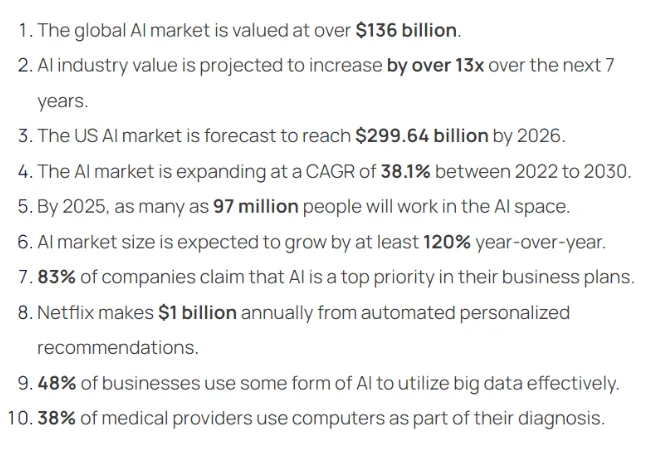
The Rising Demand for AI Design Tools
The demand for AI design tools has witnessed an unprecedented surge in 2023. According to Google trends, the search volume for AI design related tools and software has increased 1700% from 2022 to 2023 alone.

Interest in AI design by State in the United States
The interest in AI design when broken down into sub topics and related queries spans from ai image generation to Ai design tools that allow teams to take components of AI and marry them to their own brand and designs speeding up and making more efficient their own design teams and processes.
The interest in AI design across the United States is ubiquitous. The regions/states in the top 5 positions of high interest are; 1. District of Columbia 2. California 3. Washington 4. Hawaii and 5. Utah

The Impact on Design Efficiency
AI design tools have proven instrumental in streamlining design workflows. By automating repetitive tasks and offering real-time suggestions, these tools save designers valuable time and effort. Surveys indicate that a significant percentage of design professionals believe that AI has significantly improved their design efficiency, allowing them to focus on more creative and strategic aspects of their work.
IDC suggests that generative design, even more broadly generative AI, finds value in creating something for humans to react to. With AI’s initial start and its recommendations overseen by humans creates increased velocity and efficiency in creating on-brand design.
Enhanced Personalization and User Experience
In the age of personalized experiences, AI design tools are helping designers cater to individual user preferences more effectively. By analyzing user data and behavioral patterns, AI-powered tools provide valuable insights into user preferences and expectations. This data-driven approach enables designers to craft highly tailored and user-centric designs, resulting in enhanced user experiences.
Per Gartner, “A good experience designer brings user insights from research as well as knowledge of human psychology – and blends them with the organization’s product vision”. They continue, “Advances in AI will mean that designers spend less time building . . and more time focusing on solving real problems for users”.
The Power of AI in Creativity
Contrary to the misconception that AI stifles creativity, statistics reveal that AI design tools foster innovation and creativity. With AI-generated design suggestions and intelligent pattern recognition, designers are inspired to explore novel ideas and experiment with new concepts that they may not have considered otherwise. This synthesis of human creativity and AI assistance leads to groundbreaking and aesthetically captivating designs.
AI Design Companies, Trends, and Statistics
As mentioned above, the interest in AI design is wide because the use case of artificial intelligence in design is also quite wide. While AI image generation alone has made massive strides in 2023, for many companies looking to streamline their own design teams and processes, the AI images alone don’t fit the bill. Which is why there are design tools now that offer AI as a part of the complete design tool. *Data provided by Crunchbase, SEMrush, and Google Trends.
1. Figma:
Figma is a collaborative design tool that allows teams to work together on UI/UX design, prototyping, and user testing. It has plugins and integrations that support AI design-related functionalities.
Figma has witnessed a significant rise in popularity among designers, with over 4 million users as of September 2021. Its collaborative features and cloud-based nature have contributed to its widespread adoption.
See Figma’s cumulative fundraising over time and note the 150% increase year over year Q2 of 2020 to Q2 of 2021.
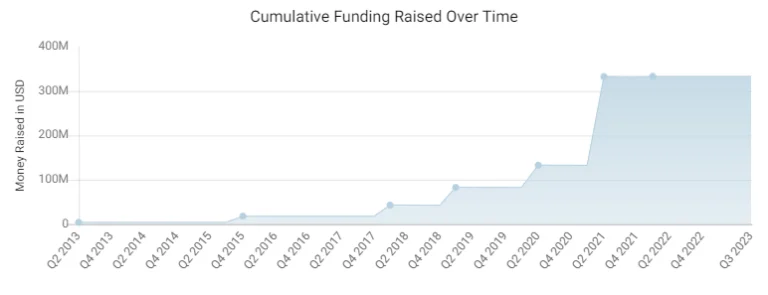
Also note the considerable increase in organic presence up 115% year over year (June 2022 to June 2023, website traffic coming from organic search results in search engines due to content and features put out meeting their audience needs.

Below you can see the increase in brand awareness by the search volume trend in Google for the keyword “Figma”. While relative to its own position, from June 2021 to June of 2023, Figma has seen a 355% increase in awareness and demand.

2. Adobe Firefly, XD & Illustrator:
We would be remiss to not include the vast world of adobe when talking about design tools. And Adobe has certainly not missed the AI train. With several products fulfilling different needs and niches, Adobe has cast a wide net helping many different audiences. The catch, you’ll pay quite the penny to get all the features from all the products. Adobe Firefly is an AI design tool that can generate images from text. It is still in beta, which means you may have to get on a wait list and be a subscriber to other Adobe tools to get a chance to test it out.
Adobe XD is a vector-based design tool that supports designing and prototyping experiences for websites, mobile apps, and more. It integrates with Adobe’s Sensei AI technology to assist designers with content-aware layout suggestions and other AI-powered features.
Adobe XD has gained prominence as part of the Adobe Creative Cloud suite, and by September 2021, it had over 3 million users. Adobe’s reputation and continuous updates have attracted designers to use XD as their go-to design and prototyping tool.
Adobe Illustrator is a vector graphics editor that is widely used in various design fields. Although it’s not an AI-specific tool, Adobe has been incorporating AI features into its Creative Cloud suite, which includes Illustrator.
Check out the increased organic performance for Adobe over the last 7 years with the amount of organic search keywords they’ve captured. They’ve seen a 32% YoY increase with an 80% increase in 2 years and a whopping 886% increase 7 years.

Interestingly enough, despite the increased performance with their site, the volume of people searching adobe in general has tapered in recent years as seen by the trendline below representing users searching for “adobe” in Google. This could be due to the generic parent brand vs each individual product that they offer which was not taken into consideration.

3. Sketch:
Sketch is a macOS-based design tool popular among UI/UX designers. While it doesn’t have native AI capabilities, it can be enhanced with various plugins that incorporate AI functionalities.
As of September 2021, Sketch had a strong presence in the macOS-based design tool market, with over 1.5 million active users. It remains one of the top choices for UI/UX designers who value its performance and ease of use.
See the organic performance trend of the last 5 years below. Sketch has seen a 7% growth in organic presence year over year and a 49% increase in 2 years.

Despite its popularity, Sketch has seen a rather consistent decline in trend for overall volume of searches for its primary branded keyword “sketch” (segmented by the company name vs the word itself).

4. Axure RP
Axure RP is a prototyping and wireframing tool that allows designers to create interactive prototypes for websites and applications. It may not have native AI features, but it can be integrated with external AI tools.
Below you can see Axure RP has seen some volatility over the last 5 years performing quite a bit lower in the organic search results of Google than it has. While it is currently trending positively, it has some ground to make up for. Axure saw a 3% drop year over year and a 29% drop from 2 years prior.

The trend of search volume tells a similar story with the primary branded keyword “axure rp” seeing a negative trend through the last couple years.

5. Marq:
Marq is an innovative design tool that has been gaining significant traction in the design industry. Leveraging cutting-edge artificial intelligence capabilities, Marq aims to revolutionize the way designers conceptualize, create, and iterate on their projects. In this section, we explore some key statistics and emerging trends that highlight the impact of Marq in the design landscape.
Marq has seen a remarkable surge in user adoption. Within just six months, Marq’s user base has grown to over one million active users, making it one of the fastest-growing AI design tools on the market. Designers from diverse backgrounds, including UI/UX designers, graphic artists, and marketers, have embraced Marq for its intuitive AI-driven features.
While Marq has undergone a relatively recent rebrand to an entirely new domain, they’ve retained much of their previous organic performance, and have since increased their brand presence in the market as seen by the short period of time available in the trendline below.
While it’s not an apples to apples comparison as there’s a bit of a ramp up period to anticipate with a new brand going live, Marq boasts a 6062% increase YoY. Let’s factor in the ramp up taking a full month’s worth of data and comparing it to the next closest month this year, Marq still shows a 73% increase year over year.

It’s clear from the volume of their branded keyword “marq” in Google trends, that Marq still has opportunity to grow, but is certainly trending positively in the last several years despite the rapidly changing industry, AI, and the market pitfalls with the worldwide pandemic and other recent anomalies.
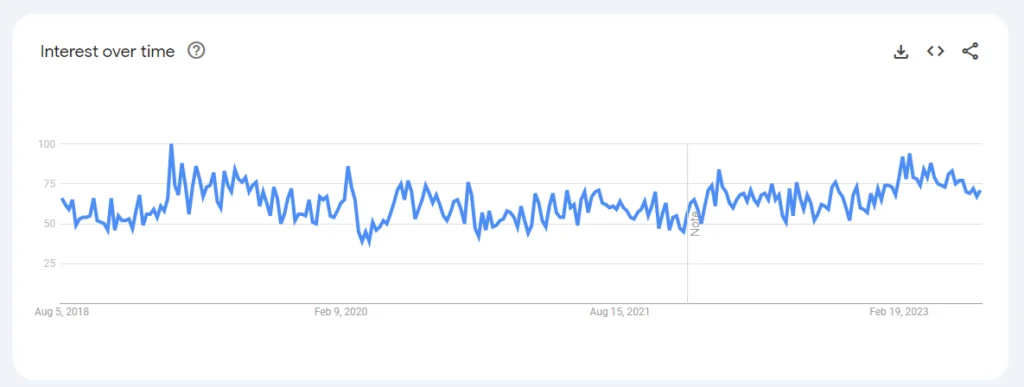
6. Framer:
Framer is a design tool that enables designers to create interactive and animated prototypes. It also offers integrations with AI-powered tools to enhance the design process.
Framer, known for its powerful prototyping capabilities, had gained traction among designers and had over a million users by September 2021.
Note the cumulative funding raised over the last 5 years, with 267% increase from 2017 to 2018 and an additional growth of 81% from Q1 to Q3 of 2023.
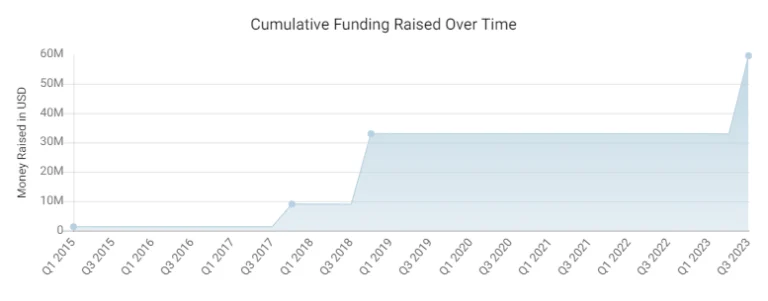
Below you can see that despite a considerable setback of website performance, Framer has regained and continues to thrive in the acquisition of new awareness through the keywords obtained for organic search. From their low point to their current high (1 year of time) they’re up 621%. Looking at the year prior before the set back, Framer is seeing a 98% increase from 2 years ago.

7. InVision:
InVision is a digital product design platform that allows teams to collaborate on design, prototyping, and user testing. It integrates with various AI plugins and external AI tools to facilitate the design process.
InVision has been a dominant player in the digital product design platform market, boasting over 7 million users as of September 2021. See the growth and anticipated growth manifest in the cumulative funding that they’ve raised over the last 10 years. Certainly a consistently healthy and robust measured effort trending positively. According to crunchbase their fundraising was up 48% year over year from 2017 to 2018 and has sustained through the years.
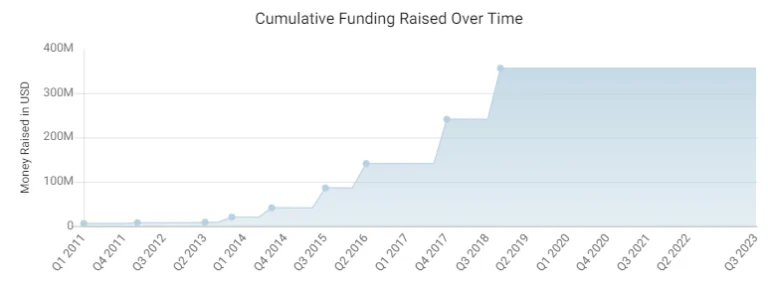
InVision’s website, however, can’t say the same. While organic presence in Google is not a primary indication of a business’ health, it can be an indicator of spending money in the right place, being aware of important aspects like digital presence, and potentially other factors like overall industry interest. Year over year, InVision has seen a 26% drop in organic presence, and 52% down from 2 years prior.

The volume trend in Google trends corroborates the trend of site performance. While the site’s ability to rank and put out the right content to meet its audience appropriately is one side of the coin, the other is the awareness and demand for a brand which can be seen through the volume of searches. InVision (company segment) has seen a consistent decrease over the last 5 years.

8. Proto.io:
Proto.io is a prototyping tool used for creating interactive prototypes for web and mobile applications. While it doesn’t have built-in AI capabilities, it can be combined with external AI tools.
Proto.io joins the group of companies and AI design tools that did not fare well through the storms of the pandemic. They are down 15% year over year for 2023, 49% from 2 years prior and even more from the year before.

The google trend graph below is one typically seen by companies or keywords with considerably low volume. The volatility and difficult to see trend line is due to the low volume of total searches for the brand. Unfortunately for Proto.io, with the little volume that is there, the trend is clearly negative.

9. Midjourney:
Midjourney has certainly found popularity among many online groups utilizing the platform discord to interact with it. It has acquired quite the reputation for being the leader in the image generation space with considerable enhancements in its abilities in a short amount of time. However, the tool can be difficult to reign in identifying the right prompt and ultimately getting an image out of it that is more than just fun to see.
Midjourney is a nonprofit organization that has clearly come out of nowhere and not only entered the scene but is leading it when it comes to AI image generation. There isn’t yet a full year of data to compare to, and any month compared to the prior is a considerable increase.

It’s clear from Google trends that while Midjourney saw some quick wins in the AI design space, it’s experiencing some trouble with the frustrations to use their product for anything meaningful. This illustrates a primary separation between design tools using AI to enhance an already valuable product to individuals and businesses and those that are banking on a potentially quick and fleeting model that will require far more iteration before becoming valuable on their own.

10. Canva:
Canva is a user-friendly graphic design tool that offers AI-powered features like automatic design resizing and layout suggestions.
Canva had over 60 million active users globally by September 2021, indicating its widespread appeal among non-professional designers and small businesses.
Canva has clearly seen success in the past few years despite the hard times that other tools and companies have seen. Check out the fundraising trend below. It illustrates not only consistent growth and progress, but a considerable jump to double the funding from Q1 to Q2 of 2021. This not only illustrates Canva’s growth but their anticipation to continue to grow.

Canva’s site performance is another voice in the positive story of the path that they’re on. As seen in the image below, the site’s organic performance reiterates not only consistent growth, but an increase in pace over the last 2 years. Good signs of product meeting users where they are, understanding their needs and fulfilling them. Also a positive indication of spending money in the right places to fuel their momentum. Canva is up 65% in organic presence year over year, and up 106% from 2 years prior.

Google trends show some ups and downs consistent with releasing new features and possibly other PR efforts. Despite some fluctuations in volume the trend is overwhelmingly positive and adds its voice to the strength of their growth and progress.

11. DreamStudio:
DreamStudio is another prompt based, text-to-image AI image generation tool focussed on minimizing the energy required to generate their images. While the output may not initially seem as robust as some of it’s competitors, DreamStudio boasts an iterable version of images making it easy to edit and upscale.
DreamStudio is rather new to the seen as made apparent to their trended organic presence below. It would appear that while they saw considerable initial success, they’ve hit massive headwinds that could be indicative of getting some items out of priority.

The volume of searches around their brand was a little difficult as it appears that Google hasn’t yet identified a segment for their brand name that is separate from the generic search term. However, looking at the shape of the volume over the last year, it appears to correlate with the initial release and the drop in interest.

12. CoreIDRAW:
CorelDRAW is another vector graphics editor that focusses on illustration, layout, photo editing, and typography tools. They offers various design that including some AI-assisted functionalities.
While CoreIDRAW has been around for a while, they’ve managed to continue to grow their online presence and continue to provide content and features that meet the needs for a select user base which is apparent from their ranking and keyword acquisition of their website. CoreIDRAW shows a 6% increase year over year in organic presence, and 3% drop from 2 years prior.

While not explicitly negative, it’s clear that the volume trend indicating awareness and demand has seen a negative trend through 2021 and then some increased volume that has slowly trended negatively since. Despite this, it would seem that CoreIDRAW continues to thrive in the AI design tool space.

13. TopazLabs:
TopazLabs is a design tool that uses AI for image editing. Primarily to enhance the quality of images and videos with some pretty impressive results.
TopazLabs has seen some ups and down over the years, but is currently thriving and positively trending with their audiences providing the right kinds of content to be promoted in the search engine results pages and driving valuable traffic to their site. They grew 87% in organic presence year over year.

Google trends shows a very positive trend corroborating the story of their site’s positive performance. It’s clear that the volume of those aware and searching for the brand has bee on a steady increase.

14. Uizard:
Uizard is an AI design tool that can be used to create some pretty robust products like web applications, mobile apps, as well as desktop software with a pretty easy-to-use editor.
It’s clear from Uizard’s funding raised over the last 5 years, that they’re continuing to grow and anticipate further growth. They’re showing a massive 417% increase from quarter to quarter in 2021.
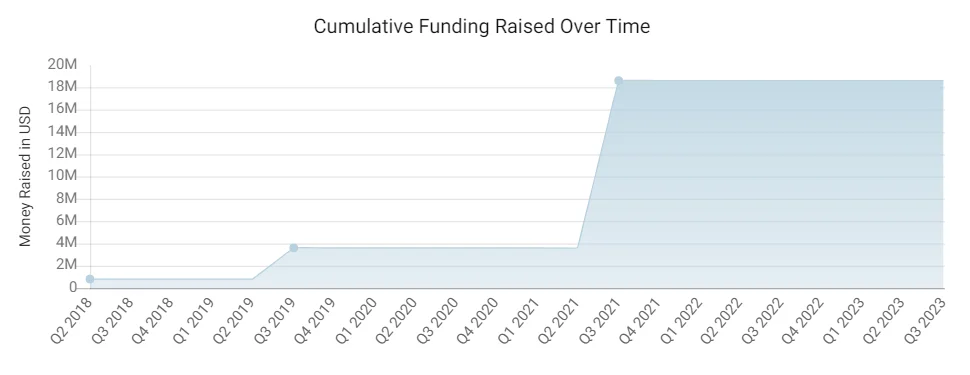
It appears that Uizard has been around for a few years, and while progressing, it hasn’t really taken off until 2023 where it’s seen considerable growth. Uizard is up 327% year over year in organic presence!

Google trends corroborates the story with minimal search volume seen since 2018, and then in 2023 it appears consistently and trending positively. Whether this is due to some good marketing and well spent PR funds, increased functionality and features or some combination of both, it’s clear that Uizard is making its way into the space and generating some pretty big waves.

15. Autodraw:
Autodraw is the last product we’ll include in today’s list of AI Design Tools trends and statistics. While small, Autodraw has been around for a handful of years and is one of the few to start before the AI boom. Providing value early on, AutoDrawl allows users to illustrate to their heart’s content, and the tool will use machine learning to take a guess at the illustration and then provide a closely related professional version to be used.
From the graph below, it’s clear that Autodraw has been through some ups and downs since its inception. While Autodraw shows a 28% decrease in organic presence year over year, it’s able to boast a 140% increase from 2 years prior which is still a positive trend for the lifespan of the company.
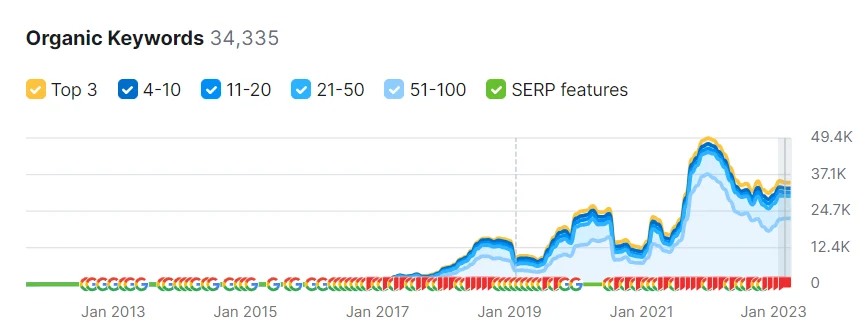
The volume illustrated in Google trends reflects roughly the same story, with a recent drop in interest through the last couple of months.

Growth in AI-Integrated Design Platforms
Major design software companies have recognized the potential of AI in design and are rapidly integrating AI capabilities into their platforms. The inclusion of AI-powered plugins, features, and modules has transformed traditional design software into intelligent ecosystems that support designers in their quest for excellence. Notable players in the industry report a considerable increase in user adoption of AI-integrated tools.
Data Security and Privacy Concerns
As AI design tools rely on vast amounts of data for analysis and decision-making, data security and privacy concerns arise. Designers and organizations need to address these issues diligently, ensuring compliance with data protection regulations and safeguarding sensitive design assets. An informed approach to data handling is crucial to ensure trust and confidence in AI design tools.
Bridging the Gap Between Designers and Developers
AI design tools are bridging the gap between designers and developers, fostering better collaboration and communication between the two disciplines. AI-powered design platforms facilitate smoother handoffs by generating design specifications and assets that developers can readily work with. This alignment leads to more efficient development cycles and reduces friction in the design-to-development process.
Conclusion
The advent of AI design tools has ushered in a new era of creativity and efficiency in the design industry. As AI technology continues to advance, designers can expect even more sophisticated tools that amplify their capabilities and enhance the overall design process. By embracing data-driven insights and combining them with their creative vision, designers can harness the full potential of AI design tools to shape the future of visual communication and user experiences. As we move forward, the harmonious collaboration between human ingenuity and artificial intelligence will continue to redefine the boundaries of design innovation.
AI Design Tool Statistics FAQs
AI design tools refer to a new generation of design software that incorporates artificial intelligence and machine learning capabilities. Unlike traditional design software, AI design tools can automate repetitive tasks, offer intelligent design suggestions, and analyze user data to enhance the user experience. These tools empower designers with data-driven insights, enabling them to create more personalized and efficient designs.
AI design tools improve design efficiency and productivity by automating time-consuming tasks, such as generating design variants, creating layout suggestions, and automating design handoffs to developers. By leveraging AI-powered features, designers can focus on the creative aspects of their work, leading to faster design iterations and better overall productivity.
According to market research, the global AI in design tools market has witnessed significant growth in recent years. Several leading AI design tools have amassed millions of users, indicating their popularity and widespread adoption in the design community. Surveys also reveal that a substantial percentage of design professionals report increased design efficiency and improved user experiences through AI-powered design solutions.
AI enables designers to create more personalized user experiences by analyzing user data and behavioral patterns. Designers can use AI-driven insights to understand user preferences, optimize content layouts, and offer personalized recommendations. By tailoring designs to individual users, designers can deliver more engaging and relevant experiences, ultimately leading to higher user satisfaction and loyalty.
In most organizations, the disconnect between brand and the rest of the organization is real.
On the one hand, brand and creative teams are constantly bombarded with requests, trying to fulfill as many as possible with limited time and resources. Most requests come with unrealistic turnaround times, leaving creative teams in a tough place to deliver.
And on the other hand, creative teams sometimes evolve into the “brand police,” which can make a brand feel “off limits” to other orgs. Doing so limits cross-functional creativity, introduces creative bottlenecks, and creates a negative dynamic between brand and other teams.
The result? Creative teams feel like short-order cooks feeding the never-ending content beast, and customer-facing teams start creating rogue content when marketing can’t fulfill their one-off requests.
That’s why modern organizations need a brand enablement solution that puts the power of your brand in the hands of your employees without sacrificing the most critical elements of your brand.
What Is Brand Enablement?
Brand enablement is the strategic process of equipping teams across your organization with the content, guidelines, and tools they need to promote your brand effectively.
It’s much more than a brand guide; it’s the process of empowering your people to promote your brand across the channels they’re in every day.
Modern brand enablement solutions help your people promote your brand by:
- Connecting employees to the most up-to-date content pieces
- Allowing employees to personalize content when they need it most
- Giving visibility into the content teams are creating
- Speeding up the approval process for quicker turnaround times
- Getting more personalized content into the hands of your customers
Organizations with Brand Enablement vs. Without
To compete in today’s fast-moving market, teams need a way to produce highly-personalized content for their customers at any given moment. For most businesses, content is the key to convincing potential buyers that you’re the right business for the job.
But without a brand enablement solution, it can be easy to overload creative teams with an endless queue of content requests.
Let’s look at how brand enablement can unleash your brand’s potential while saving your organization time and money.
 Brand Enablement Drives Business Growth
Brand Enablement Drives Business Growth
By equipping your teams with proven brand enablement tools, you’re making it easy for every existing and potential customer to have a meaningful interaction with your brand.
With easy access to lockable brand templates, your teams can deliver personalized content to potential customers faster than ever. This unique approach takes the burden of small content requests off of design teams and gives customer-facing teams the tools they need to win business.
 Brand Enablement Speeds Up Content Creation
Brand Enablement Speeds Up Content Creation
When potential customers come to you, they want to know instantly how your product or services can solve their problems.
They don’t want generic content; they want content that’s tailored to their needs.
With a brand enablement solution, team members can choose an approved template, customize it, and send it to a customer. This process shortens turnaround times, guarantees brand consistency, and removes tedious requests from the creative backlog.
 Brand Enablement Improves Brand Reputation
Brand Enablement Improves Brand Reputation
Opening up content creation to everyone doesn’t mean content chaos. It means you’re empowering your people to promote your brand the right way.
With lockable templates, team members can personalize and deliver fresh content that’s always compliant with your brand standards.
Creative teams have complete visibility into the content being created, and customer-facing teams feel empowered with a way to create on-brand content.
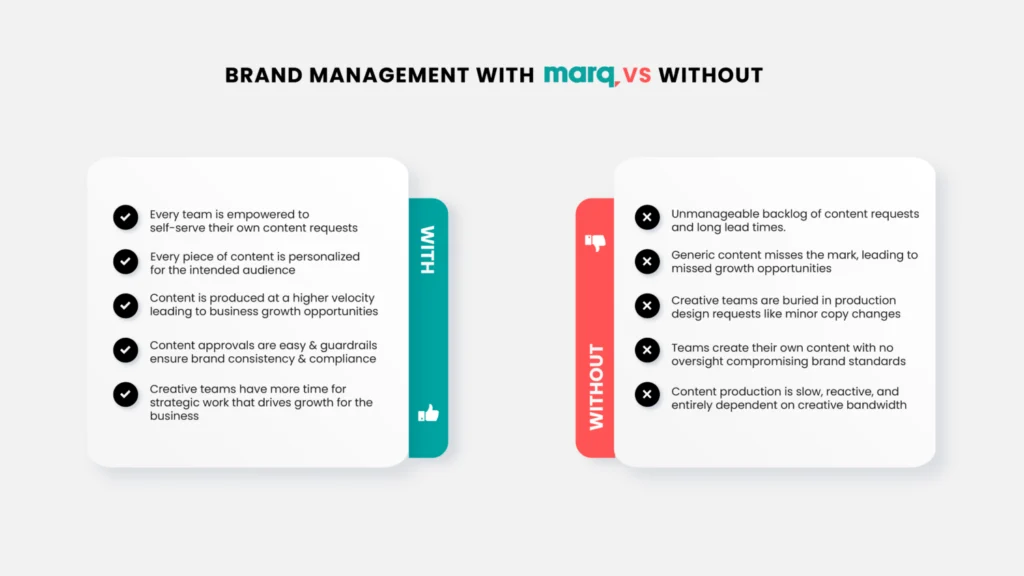
How to Implement Brand Enablement
Whether implementing brand enablement from the ground up or refining a system already in place, you’ll want to take inventory of your current brand assets and creative processes. Doing so will help you identify gaps to build a more holistic brand enablement plan.
Here are six steps we recommend you take when getting started with brand enablement:
Step 1: Create a culture of alignment
How well do your brand and creative teams collaborate with other departments?
Without a solid brand enablement process in place, your answer might be: “Not that well.” And that’s okay.
Your first goal is to build cross-functional relationships across the company to ensure everyone is aligned with your brand enablement vision.
Step 2: Determine the content goals of other departments
For brand enablement to work, you need to equip your teams with the content types they need to be successful. Take the time to identify cross-functional partners’ content needs and goals and build them into your content production plans.
Step 3: Establish clear brand guidelines
When it comes to branding, consistency is everything. Whether you have a brand style guide or a brand enablement platform like Marq, make sure you have a source of truth that outlines everything that matters to your brand, from typography and color to logos and imagery.
Step 4: Choose the right technology to facilitate content creation
Multiple file types across hundreds of programs create a mess of content only usable by the original content creator. You need shared technology that won’t break the bank, ensures brand consistency, enables users to self-serve their content needs, and empowers everyone to personalize and share content easily.
Step 5: Implement a process for approvals and check-ins
Brand control doesn’t stop with brand enablement. Instead, it should be easier to get content out the door, and content approvals should work for you, not against you. Align on a process that works for your cross-functional teams and brand protectors.
Step 6: Establish performance metrics and implement feedback loops
Your content is only effective if it drives results. Decide what metrics you will use universally to measure performance and create feedback loops so your team is always looking at the data to drive better content decisions.
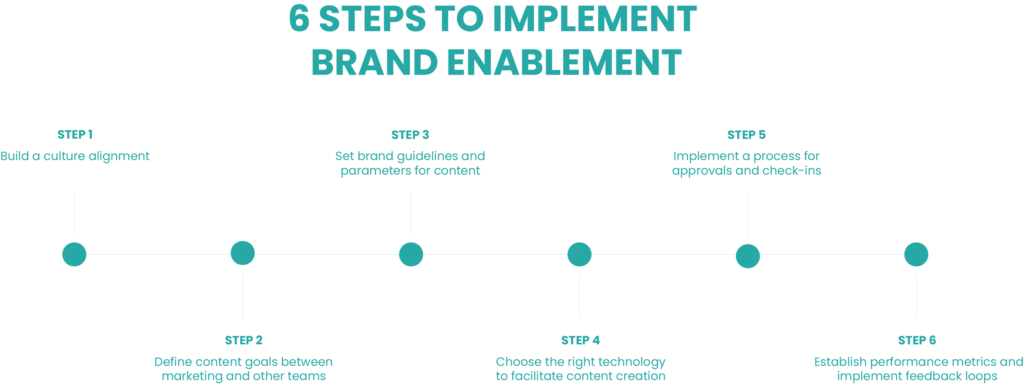
How Marq Makes Brand Enablement Easy
Not all brand enablement tools are built the same, but the best, most comprehensive brand enablement platforms will empower your teams to create stellar on-brand content that drives growth for your business.
With Marq’s ability to convert all of your designs into reusable branded templates, everyone in your org can create and share on-brand content.
Here’s how Marq works:
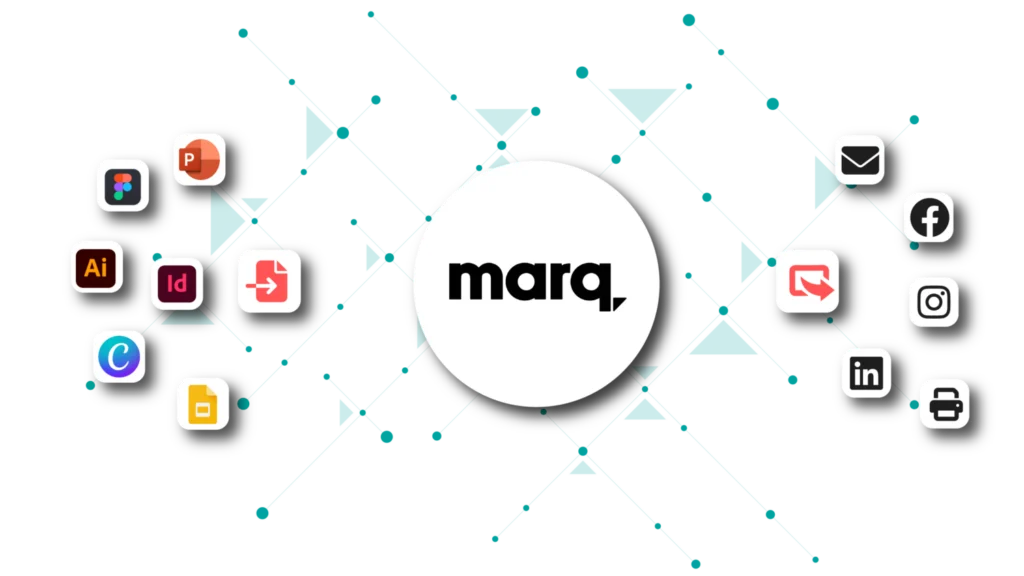
01 Design Anywhere
Creative teams can import existing design files from any platform or create designs locally in the Marq editor.
Why organizations love this
- Creative teams can build designs on the platforms they’re most comfortable with
02 Templatize Anything
With Marq, you can turn any design into a template by locking critical brand elements like fonts, logos, and colors.
Why organizations love this
- Creative teams create one version of a lockable brand template instead of updating the same design file hundreds of times.
- Other teams can access approved templates for pitch decks, social posts, one-pagers, and more.
03 Personalize Everything
Share brand templates across your organization so teams can customize content for their unique audiences.
Why organizations love this
- Creative teams save time by allowing teams to fulfill their own content requests.
- Other teams can quickly personalize approved templates without submitting a creative request.
04 Share Everywhere
Teams can immediately publish content without having to leave the Marq platform. Quickly post any project to social media, send it to print, or embed it in an email.
Why organizations love this
- Creative teams feel confident that every piece of content that’s shipped meets brand standards.
- Other teams win more deals by getting content into the hands of customers faster.
Imagine the content output and level of personalization when you put brand enablement to work for your organization.
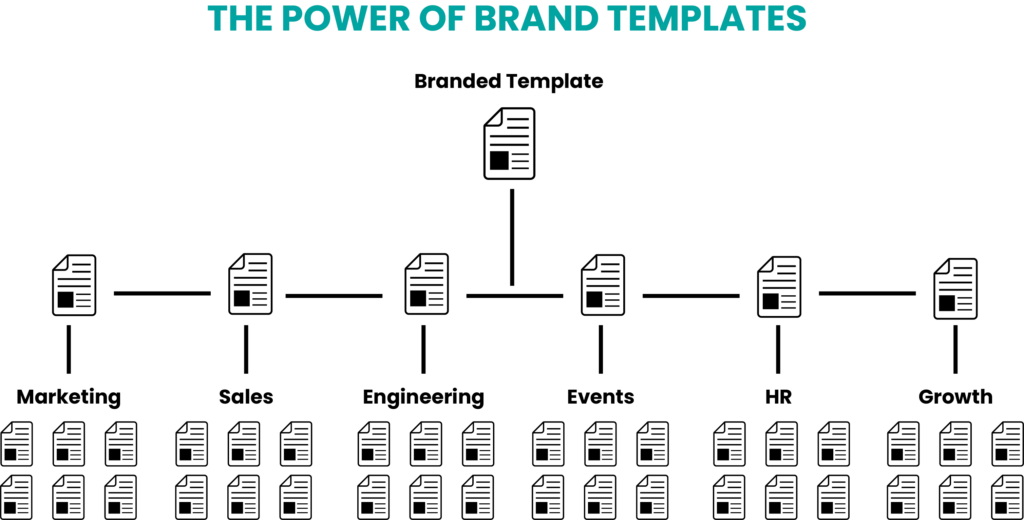
Upgrade your brand management strategy to a brand enablement strategy today. You can schedule a demo here.
Brand Enablement FAQs
Brand Enablement is a strategic approach that goes beyond traditional branding. While branding focuses on creating a brand identity and recognition, Brand Enablement takes it a step further by empowering brands to thrive in the modern marketplace. It involves providing brands with the necessary tools, technologies, and resources to enhance their presence, engage their target audience, and adapt to evolving market trends. Essentially, Brand Enablement enables businesses to translate their brand vision into tangible, sustainable success.
Brand Enablement offers numerous benefits for businesses seeking to establish a strong market position. By investing in Brand Enablement, your business can:
Drive Customer Engagement: It helps you create compelling brand experiences that resonate with your target audience, increasing customer loyalty and advocacy.
Competitive Advantage: Brand Enablement allows you to differentiate your brand, making it more memorable and recognizable in a crowded marketplace.
Adaptability and Innovation: With the right tools and technologies, Brand Enablement empowers your brand to adapt quickly to changing market conditions and embrace innovative strategies.
Brand Consistency: It ensures consistency across all brand touchpoints, including online and offline channels, fostering trust and credibility among customers.
Employee Alignment: Brand Enablement aligns your employees with the brand vision, fostering a sense of purpose and enhancing overall productivity.
In this episode of Group Therapy, Katie Krongard, Associate Creative Director at Marq, sits down with Brett Barlow, CEO of Everee and former Chief Brand Officer at Pluralsight. They discuss why creatives need to build stronger partnerships with cross-functional teams by investing time into sharing brand initiatives internally while learning how to support their entire organization better.
They also talk about how to build strong brand and marketing teams focusing on start-ups and the characteristics that make brands stand-out against the competition.
This is the fifth installment of Group Therapy, a content series hosted by Marq- the brand enablement platform empowers everyone within an organization to build and deliver branded content to their audience.
Have you heard of the ‘lone genius’ myth? It’s the idea that the world’s greatest creatives – think Michelangelo, Einstein, or Steve Jobs – accomplished their artistic and technological feats by themselves. It can be an attractive myth, especially for creative and artistic types, but it doesn’t tell the full story behind these world-changing ideas. Collaboration has been and always will be a vital part of the creative process – even if it might not seem as glamorous. And while your creative team might not be trying to reinvent the wheel with your brand projects, collaboration can be the key that unlocks a new level of depth and potential impact within your work. But don’t just take our word for it. In this blog, we’ll answer the question, “How does collaboration expand the creative process”?
We’ll outline the four stages of the creative process and illuminate how working together can take creative ideas from good to great.
Why is collaboration important in creativity?
These days, especially if you’re working with highly distributed teams, it can feel like collaboration is more of a roadblock to creativity than an aid. But it’s all about shifting this mindset.
Imagine you’re working on a new infographic for your sales team. You’re not entirely sure how to visually represent some of the information you’re working with, but you charge on anyway with your best ideas. You now have a decent piece of sales content, but it doesn’t perform as well as you might’ve hoped.
Now imagine that instead of working alone, you collaborated from the start with one of your senior graphic designers. Working together, you found innovative ways to showcase your content, resulting in an end product that outperformed your expectations.
Time and time again in history, the best ideas are brought to life when people who bring different skills and experiences work together. The more minds you can bring together under a common goal, the more productive and efficient your creative process can become as well. A well-organized creative team can create better content faster.
So what can creative collaboration look like in your organization?
- Internal collaboration: Working together with your own team members or teams from other departments within your company.
- External collaboration: Working with external partners like freelancers and clients.
- Vertical collaboration: Collaborating with teams and stakeholders at all levels of your organization.
- Horizontal collaboration: Collaborating with the same level of employees within your organization or department.
Collaboration at any of these levels can supercharge your ability to meet deadlines, stay agile, and produce content with the biggest impact.
How does collaboration expand the creative process?
We can break the typical creative process down into four stages:
- Preparation: The preparation stage is all about deciding what shape your project will take. Are you making a video or a blog, an infographic, or script? In this stage, you’ll gather inspiration and resources, and think about any potential problems or challenges you might face in the creative process.
- Incubation: This is the stage where connections start to happen. Your mind is turning your ideas over and over, analyzing them from every angle.
- Illumination: Here’s where that famous ‘aha!’ moment comes into play. You’ve now got a fully formed idea and roadmap on how to get there.
- Verification: In this stage, your idea enters the process of becoming reality. You continue to refine and reshape, until you get a fully-formed end product. Then, it’s time to evaluate. If you still find flaws or opportunities to strengthen your idea, you move back to the drawing board and begin the iterative process.
And while a person can move between these four stages of the creative process on their own, collaboration can make the journey from point A to point B much easier.
How collaboration enhances creativity at the preparation stage
When you’re in the preparation stage, you’re gathering as much information as possible about the type, size, and scope of your project. This process is incredibly important because it sets the foundation and direction of your creative work. The most successful projects start with a clear understanding of what you and your organization want to achieve, what kind of resources you have at your disposal, and what constraints or issues you may have to watch out for.
Tackling this stage of the creative process with others can help you uncover more ideas, explore different strategies, and flag even more potential challenges and opportunities.
Tips for collaboration at this stage:
- Start with a lot of conversation, preferably face-to-face.
- Set up a clear set of team goals for the project.
- If you have a physical workspace, make sure it’s conducive to creativity (think quiet, open spaces with plenty of tools)
- Look for people who have similar skills – you might end up grouping them together for certain tasks.
Why collaboration propels the incubation stage
The incubation stage can oftentimes be one of the longest and hardest parts of the creative process. You’re allowing your mind to process the information you gathered in the first stage while you work on other things. Sometimes this can lead to a quick “Aha!” moment, but it can also lead to mental blocks.
Undergoing this process with a team ensures multiple people are actively engaging and thinking about the project. Bouncing around ideas together can help you make new connections and uncover new insights and potential solutions that you might not have been able to see otherwise.
Tips for collaborating at this stage:
- Empower people to actively share ideas and potential solutions, without having to get the approval or input of someone higher up.
- Allow enough time for people’s thoughts to fully marinate before deciding on a course of action.
- Hold short meetings to gauge progress and share thoughts.
How collaboration refines the illumination stage
Breakthroughs happen at the illumination stage. Whether you finally found a solution to a problem or made a connection that will take your project to the next level, this is the stage where your end product starts to take shape.
At this stage, you may have various possible ideas and solutions competing for attention in your mind. Collaborating with your team members can make it easier to sort through these ideas, refining the best ones before deciding to move forward.
Tips for collaborating at this stage:
- Make sure everyone has a voice. Give people an open floor to discuss their ideas and share thoughts/critiques
- If you’re working with a lot of ideas, hold a vote to narrow down the top choices.
Implementing collaboration at the verification stage
You’ve got a great idea – what now? At this stage in the creative process, your goal is to test if your idea holds up in reality. You’re also communicating the value behind your idea to make sure it meets the goals it set out to achieve.
If there are any cracks in your idea, this is where they’ll start to show. But you might not know them if you’re not collaborating with others. By working through this stage as a team, you can share and discuss real-time feedback, which will ultimately help you test and refine your idea until it’s perfect.
Tips for collaborating at the verification stage
- Create a standardized feedback process that everyone working on the project can participate in.
- Curb your enthusiasm. Even if you love your idea, it might not suit the project’s goals. Encourage openness and collective ownership over ideas to avoid resentment popping up.
After plenty of discussion, feedback, and refining as needed, you and your team can present your fully-formed creative project to the rest of your organization. And it will be all the stronger because you worked together.
There’s no scaling up creativity without collaboration. And at Marq, we believe in breaking down barriers to creative collaboration. With our brand templating platform, anyone in your organization can take action on their ideas and maintain brand consistency. Schedule a demo today and see how we can help streamline your team’s creative process.
In this chat with Adam Gunn, SVP of Brand at Pluralsight, and Cole Parker, Senior Product Marketing Manager at Marq, they discuss the dreaded “C” word… change. Adam shares his thoughts about how brand teams can stay ahead of the curve when businesses are always changing their strategy along with some other nuggets on brand consistency and collaborating with cross-functional teams.
This is the third episode in the Group Therapy series hosted by Marq. Conversations with creative and marketing leaders about all things brand.
Creativity is a necessary component of any successful branding effort, but it is too often regarded as an elusive and intangible quality that is difficult to quantify and manage. But you don’t have to buy into the myth of the solitary genius working in mysterious ways. You can map and analyze creative processes to identify areas for improvement and optimize them for increased efficiency, productivity, and consistency.
This article will explore the benefits of creative process mapping and provide you with the key steps for efficiently leveraging this technique. You will learn:
- What creative process mapping is
- How to gain greater control over your creative processes
- How to use creative process mapping to enhance creativity and productivity
Whether you are a seasoned creative professional or just starting out, creative process mapping can help you work smarter and faster. So, let’s dive in and discover how it can help you unleash your full potential.
What Is Creative Process Mapping?
Creative process mapping involves identifying, documenting and analyzing the steps that enable professionals to produce successful outcomes. It means looking at every part of the workflow, figuring out the deliverables for each aspect, and documenting the findings in detail so that anyone can use them as a successful guide.
The creative process can be complicated and often includes many different steps, such as brainstorming, research, prototyping, and testing. By making a map of these processes, you can find bottlenecks or inefficiencies and make changes to improve the process as a whole.
Additionally, creative process mapping can help you identify areas where creative automation can be applied, allowing you to streamline workflows and reduce the time and effort required to complete tasks.
Why Map Your Creative Processes
As a professional, you’re always looking for ways to improve your skills, streamline your work, and get more done. Mapping your creative processes can help you achieve these goals.
Increased Creative Productivity
Creative process mapping can increase creative productivity in several ways:
- By documenting and analyzing your creative processes, you can identify redundancies, inefficiencies and other barriers to optimal productivity.
- Mapping your creative processes can help you prioritize tasks and focus on what’s most important.
- It can help you identify opportunities to enhance your skills and develop new techniques.
Creative Automation
Creative automation is the automating of repetitive and time-consuming tasks in the creative process, such as image editing, video rendering, data analysis, and content creation and distribution.
By making a map of the entire creative process, you can learn more about your workflows and figure out which tasks can be done automatically. Automation can help you get more done in less time and with less effort, so you can focus on the important and creative tasks.
Brand Consistency
Creative process mapping helps identify key elements of a brand, such as tone, style, and messaging. Once these are documented, brands can establish clear and consistent process guidelines, which will help eliminate inconsistencies in branding and ensure that everyone is working towards the same goal.
Faster Employee Onboarding
Mapping your creative process is a powerful way to help employees and contractors get up to speed faster. Documented processes provide clarity, which empowers new hires. Having a detailed guide increases their transition into a new role while helping them gain familiarity with creative systems and processes more quickly than if they were left to their own devices.
The 5 Steps of Creative Process Mapping
Now that you’ve learned why to map creative processes, let’s look at how to implement it for your business, your creative team, or yourself.
1. Identify Processes and Workflows
The first step is to identify the central processes and workflows that contribute to your creative team’s outputs. What do you and your team members do to achieve the successful delivery of these outputs? One effective method is to start at the end and work your way backwards.
For example, your team is working on a marketing campaign for a new product launch. The outputs include creative copy, a website landing page, product images, social media posts, and so on. What are all the major steps that the team does as it works towards achieving these deliverables?
At this stage, you want to identify processes and workflows, not every little task that adds up to a workflow. It’s better to avoid zooming in too closely, too quickly—you’re looking for the main paths through the forest, not every twist and turn you take along the way.
2. Delineate Activities and Outcomes
Once you’ve found the processes and workflows, break them down into smaller workflows, tasks, and activities. Think about the specific tasks that need to be done at each stage of the workflow in order to move the project forward.
As you break processes down into these small sections, consider each task’s input, dependencies, activities, and outputs. Dependencies are particularly important here: What needs to be done before this task can be completed? Dependencies connect tasks into workflows, and if a dependency isn’t met, it can cause delays and reduce productivity.
You may also want to catalog the tools used and the expected timeframe for each task.
3. Document Processes
Documentation is key to making sure that everyone on the creative team knows what is expected of them and is working toward the same goal. There are many ways to document processes: text documents, Gantt charts, flow charts, or timelines.
Whichever method you use to create process maps, make sure they are complete, detailed, and correct. These documents are the basis for future optimization, so you want them to be as thorough as possible.
4. Identify Creative Automation Opportunities
Creative teams can access a vast array of automation tools, should they choose to use them. These range from user-friendly platforms like Zapier and Marq’s brand template and creative automation solutions to complex AI-powered content generation tools like ChatGPT or Jasper.
5. Analyze & Optimize Creative Processes
You now have all the information you need to optimize tasks and processes. Process optimization is an art and a science, and the details differ between teams and organizations. But you should always:
- Scrutinize your processes for bottlenecks and their causes
- Identify areas where task dependencies aren’t being delivered in a timely fashion
- Look for tasks that are unnecessary or redundant
- Identify opportunities for new tools and software
- Consider if reordering or reassigning tasks might improve productivity
- Assess how information flows from one stage in the process to another (might there be better ways to share information and assets?)
Creative Process Mapping for Happier, More Productive Teams
Creative process mapping is a powerful tool for anyone looking to enhance their creative routine. By documenting and analyzing the steps involved in the creative process, individuals and organizations can gain a better understanding of their workflows, identify areas for improvement, and optimize their processes for increased efficiency, productivity, and consistency.
Marq’s innovative brand templating platform can help your team optimize creative processes and build consistent brand experiences at scale. To find out more, request a free demo with a brand templating expert.
As a creative marketing professional, you know how complicated and time-consuming creating and managing dozens of pieces of marketing content can be—especially when each one has custom details, brand design, and language standards, and often compliance requirements that must be implemented correctly. Making mistakes can hurt your client’s brand, not to mention your career.
Templates are your compass in a sea of chaos. Templating helps creative professionals maintain brand consistency and adhere to brand guidelines while reducing the time it takes to produce high-quality marketing content. Even better, smart templates empower you to automate parts of the creative process.
In this article, we’ll explore how templates can save you time and the role they play in creative automation. You’ll learn how to:
- Use templates to speed up common creative processes.
- Deploy creative automation to simplify complex workflows.
- Use smart template fields with your data.
What Is Creative Automation?
Content automation uses data and software to automate the creation, management, and distribution of marketing materials. This allows you to save time and resources while creating high-quality, professional-looking content that engages your audience.
Templates play a key role in creative automation. They allow you to create a document’s structure and design in advance before swapping in data, text, and design elements appropriate to each client, campaign, or location. For example, creative automation with templates makes it easy to create flyers customized for different locations or custom proposals with consistent branding.
Content automation with templates is a game changer for creatives looking to streamline workflows. Benefits include:
- Efficiency: Free your time and resources to focus on other important tasks.
- Consistency: Ensure that your content has consistent branding, messaging, and style.
- Accuracy: Minimize the risk of human error, ensuring that content is accurate and error-free.
- Collaboration: Make it easier for teams to work together, improving collaboration and communication.
- Flexibility: Quickly and easily make changes to your content, increasing flexibility and responsiveness.
Whether you’re working on brochures, presentations, or any other marketing materials, content automation is a powerful tool that can help you create effective content in less time.
Creative Automation With Templates
Let’s look at six ways templating and creative automation can increase your efficiency and productivity.
1. Branding and Content Design
Let’s say you’ve been asked to design a set of posters to promote a series of conferences. The design has to adhere to brand guidelines, but the brief asks you to create a unique graphic for each location with images of local landmarks.
Tackling the poster designs one at a time would be time-consuming, but with templates, you can easily mock up the base design using the brand’s colors, fonts, text styles, logo, and so on. Then, you can focus on designing the local graphics for each poster, creating posters based on the template, and dropping the unique element into each one.
Marq’s content design solution and templating system make this process straightforward. You can import existing InDesign files, images, and other brand assets. Then you can create a project, design the poster, and leave placeholders for custom images and text. From there, it’s straightforward to make and edit the posters for each location.
2. Collaborative Content Creation
Suppose you’ve also been asked to design a brochure to advertise the conferences. As with the posters, each brochure should include images and copy tailored to individual cities. You can’t design all the brochures and write all the copy yourself, so you decide to ask the designers and copywriters on your team for help.
However, the basic design has to comply with brand guidelines, and it has to be consistent—you can’t let your colleagues move logos around or modify the page layout.
Templates make collaboration within guidelines much easier. You make the design template with individual page templates and the client’s layouts, colors, and fonts. If you want, you can also lock these elements so they can’t be changed. Your colleagues are then free to get creative within the constraints you’ve provided.
3. Updating Multiple Documents
As often happens, the client might like the brochures, but have notes, such as: They’d like to include updated venue capacities in each one. That could be a real headache for you. However, if you set up your templates with custom smart fields, you can import the new data and have it automatically applied to all the brochures based on that template.
4. Content Standardization and Compliance
Creative professionals often find themselves working on projects with strict content guidelines and sometimes legal constraints. For example, certain types of content are legally required to include warnings and mandatory customer information.
Templates offer confidence that your team is working within the rules. Simply include the necessary content in your template, create a content-level lock, and no one working on the project can make unauthorized changes.
5. Data Automation
Let’s say your client asked you to create posters for their conferences and they sent a Google Sheets spreadsheet with a preliminary list of venues. Then the venue list changed during the planning process, so now you have to update a bunch of poster designs with new addresses. Anyone who has worked as a marketing designer is familiar with the laborious process of copying information from spreadsheets and pasting it into marketing content, and then doing it yet again when the information changes.
Data automation—a subset of creative automation—makes the process almost effortless. Instead of hardcoding conference venue addresses into each poster, a modern templating platform like Marq allows you to connect a data source, like your Google Sheet, and then autofill smart fields in your project from the sheet. The clever part is that when the information in the data source changes, the data in the smart fields updates automatically. No more copy and paste.
6. Calculation Automation
Smart fields are great, but we’ve yet to mention one of the best template features: formulas and functions. In addition to importing data sources, you can include spreadsheet-like formulas within text boxes, shapes, and table cells.
Formulas are incredibly flexible creative automation tools, but, to take a simple example, you could use them to automatically calculate the price of conference tickets in the brochures. Let’s say the base ticket prices for each location are listed in a Google Sheet, but attendees can pay extra for training sessions, VIP networking events, concierge services, and so on.
With the clever use of formulas, you could create a price matrix that automatically calculates conference package prices from the data the client supplies.
How Do I Make Brand Templates?
As you can see, creative automation with templates is exceptionally powerful. It has the potential to save you and your team a huge amount of time. All the features we’ve mentioned here, and many more, are available now on the Marq brand template platform. If you’d like to put Marq through its paces and see what we can do for you, schedule a demo with a templating expert today.
Collaboration is key for marketers and creative professionals. Whether it’s your internal team, contractors, or outside influencers you’re engaging with, a shared understanding of your brand ensures that everyone is on the same page. That’s why creating comprehensive branding guidelines with a clear brand style guide is so important for effective collaboration.
Brand guidelines are documents that define how your company should communicate with customers and partners. They hold significant value because they give members of your team—whether permanent employees or freelancers—a clear framework for designing content that reflects your brand values and aesthetic.
In this article, we’ll explore how brand guidelines enhance collaboration and productivity, and give you tips for creating successful guidelines. You’ll learn:
- How brand guidelines help businesses achieve brand consistency
- The role brand guidelines play in onboarding new creatives
- How to use brand guidelines to set boundaries for creatives
- Why brand guidelines should always be comprehensive and up to date
- How brand templates and creative automation work with your guidelines to increase productivity and reduce cost
What Is a Brand Guideline?
A brand guideline is a set of standards and rules used to maintain consistency across all elements of a company’s branding. It specifies the usage of colors, fonts, logo design, tone, voice, imagery styles, and other creative aspects that are associated with a brand. Having these guidelines in place ensures that the company maintains an image that is cohesive and recognizable within its industry.
A brand style guide act as a framework for creativity by providing boundaries for how the company should be represented. This allows teams to work within those parameters while still being able to express their own ideas effectively. Having clearly defined rules makes it easier for creative team members to understand what they can and can’t do when creating marketing materials.
Having well-defined brand style guide is essential for any organization looking to make an impact in today’s competitive market. It helps standardize messaging, visuals, and design, allowing creatives to express company values in a meaningful way without compromising consistency or clarity.
How Brand Guidelines Support Collaboration
When it comes to fostering collaboration, brand guidelines can be an invaluable aid in setting the creative parameters essential for cooperative and efficient teamwork.
Achieve Brand Consistency with a Diverse Creative Team
Guidelines provide clear language, rules, and imagery that all team members can easily reference when creating visuals and content. With everyone working in harmony, your brand benefits from greater efficiencies in communication and quicker production times on projects requiring input from multiple parties.
Quickly Onboard New Marketing Creative Hires
Comprehensive rules in your brand style guide ensure that new hires immediately understand what is expected of them. When developing brand-related campaigns or artwork, they can look to established style choices and techniques for guidance. Brand guidelines help experienced creatives hit the ground running, empowering team leaders to quickly and confidently scale their teams to meet workload demands.
Communicate Your Brand’s Unique Style to Freelancers
Clear guidelines foster clear communication between internal teams and external freelance creatives. They eliminate guesswork and provide creative freedom within the scope of what defines the company’s look and feel. Not only does that mean everyone involved with creating materials is aligned, but it also helps build trust between freelancers, internal teams, and clients.
Make Sure Your Team Isn’t Reinventing the Wheel
This guidance is meant to provide a framework on which creative teams can base their work. In doing so, they don’t have to start from scratch every time they launch a new project or campaign because the foundations are already in place. Instead of recreating established rules, brand guidelines allow your team to devote more time to creating unique content.
Set Boundaries for Influencer Marketing and Brand Collaboration
Modern marketing teams collaborate with organizations and individuals outside of the traditional employee or contractor relationship, including independent creators, influencers, affiliates, and other brand partners. These partnerships can help you achieve your branding and marketing objectives, but they need clear boundaries to guard against harmful misuse of brand assets and messaging. Brand guidelines communicate your brand’s requirements and boundaries, setting expectations that shape relationships with external collaborators.
The Digital Marketing Institute outlines an essential guide to influencer marketing that can help provide even more context. Identifying the types of influencers, you would work with, if any, can help clarify marketing activities moving forward.
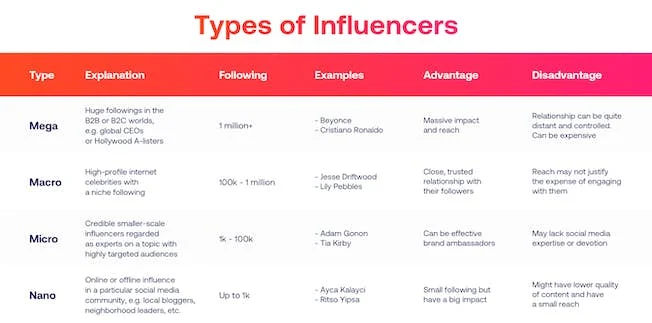
Building Brand Guidelines for Effective Collaboration
We’ve talked about why you should use a brand guide to cultivate collaboration, but not all are created equal. Poor-quality guidelines confuse, undermine, and mislead creative professionals. Plus, bad guidelines almost always result in expensive rework.
To learn more about what goes into creating effective brand guidelines, check out 12 examples of great brand guidelines and how to create a corporate identity design. To conclude this article, we’ll look at three tips to help you create brand guidelines that maximize your team’s productive potential.
Create Comprehensive Guidelines
If creative team members can’t find the information they need, they may not be able to proceed. Or they’ll devise a solution that may not conform to the brand’s identity, values, and standards. Either way, productivity takes a hit.
Creatives should ideally be able to refer to a brand’s guidelines whenever they have a question about brand values, visual styles, colors, logo use, and so on. Try to anticipate and include information to answer any questions that designers and marketers may have.
Keep Brand Guidelines Up to Date
It is essential to ensure that your brand style guide is up to date. Outdated guidelines can lead to a loss of unity and coherence among the many elements of a brand’s identity, from design language and visuals to messaging. Without an effective set of current brand guidelines in place, it can be difficult for teams to stay on message and create content with consistency across multiple channels.
Take Advantage of Brand Templates and Creative Automation Tools
Although brand guidelines are useful documents for creative teams and marketers, they do have limitations:
- They are static.
- The information they contain is not easily integrated into a diverse range of branded content.
- There is no straightforward way to automate content creation from brand guidelines.
Brand templates are significantly more powerful. With Marq’s brand templates, you can upload brand assets, including typography, color schemes, images, and logos, embedding brand standards into the content creation process. You can then design and create marketing assets from pre-made or custom templates.
Even better, brand templates allow you to automate content creation and include custom data in your content, whether it’s a sales proposal, spec sheet, presentation, brochure, e-book, flier, poster, or any other branded publication.
To learn more about how Marq brand templates can help your creative team collaborate on consistently branded marketing and sales content, schedule a 1:1 with our team.
In this dynamite episode of our new content series, Group Therapy, Trenton Romph, Head of Marketing at Clozd shares some of the key things companies are missing when they don’t take the time to talk to their buyers. In the world of win loss analysis, Trenton has some incredible pieces of advice to understand marketing effectiveness, content effectiveness, and who/what to look to as the real source of truth on all of it.
This is the second episode in the Group Therapy series hosted by Marq. Conversations with creative and marketing leaders about all things brand.
Jeremy Wold, Head of Marketing at Awardco, and Katie Krongard, Senior Content Marketing Manager at Marq, discuss brand strategy shifts during and post-pandemic, work culture, and how to achieve cross-functional collaboration from marketing strategy to execution.
Jeremy shares that you should never sacrifice strategy for speed.
Marketing collaboration starts with communication and empathy. Great collaboration also brings data to the conversation to ensure cross-functional alignment on what is working, what isn’t, and builds trust with partners across your organization.
This is the first episode in the Group Therapy series hosted by Marq. Conversations with creative and marketing leaders about all things brand.
When you’re taking the first steps to build your brand, it can feel like a whole world of possibilities is at your fingertips. At the same time, trying to carve out a unique identity and space for your company can feel overwhelming. Trying to maintain consistency within your brand identity, stylistic choices, and big-picture vision is a tough ask – especially when you’re working with a variety of different (and often siloed) departments.
This is where a brand style guide can help take the burden off weary CMOs and their teams. Once you know how to build a brand style guide, scaling up your content strategy becomes so much easier.
In this article, we’ll answer these questions and more:
- How do I make my own brand guidelines?
- What should a brand style guide include?
- What are the 7 essential elements of a brand style guide?
The sooner you learn how to build a brand style guide that fits your unique vision and voice, the sooner you can empower your teams to create great content – so let’s dive in!
What is a brand style guide?
Every brand style guide looks different, but they all have the same purpose: to help keep your branding consistent. It’s a master document that includes everything that makes your brand unique, from your visual and stylistic identity, to your company vision and mission statement.
Elements you can expect to find in one include your logo, font types, color palette, tone of voice, photography, and much more. What you choose to include in your brand style guide ultimately comes down to what kind of product or service you offer, and what kind of content you want to put out there.
Having a clear and easy-to-reference guide makes your brand more accessible, which means anyone in your company can create on-brand content. And the more consistent your branding is, the more recognizable you become to your audience, no matter where they might find you.
One question you might be wondering: What is the difference between a brand book and a style guide? We’re so glad you asked!
- The purpose of a brand book is to help people in your company stay aligned with your brand’s overall purpose. It’s all about drawing inspiration from the larger meaning behind your brand.
- A style guide, on the other hand, is more about maintaining a consistent visual and stylistic identity. It helps folks both inside and outside of your brand use your assets consistently and correctly.
These aren’t meant to be strict guidelines though – feel free to incorporate any elements into your brand style guide that feel right.
4 benefits of having a brand style guide
While it’s certainly possible to go about building a brand without a set style guide, we don’t recommend it. Why? Because without a style guide, you’re effectively putting a blindfold on your creative team. Without set standards and rules, you lose consistency and accountability.
Here are just a few key benefits a clear style guide can offer your team:
- Internal Consistency: A style guide keeps your brand identity consistent both internally and externally. No matter what team you’re working with, they’ll know your company’s look, feel, and language. A great style guide helps people learn the ins and outs of your brand quickly so every piece of content created fits together under one voice.
- Clarity: More clarity on content standards means less confusion on how decisions should be made. The clearer the instructions, the less time spent communicating back-and-forth, and more time creating content that stays true to your brand values.
- Customer Trust: People crave consistency in all aspects of their lives, and expect it from their favorite brands too. When you provide a consistent brand experience, you build trust, and that trust can lead to increased revenue. In fact, the State of Brand Consistency report by Marq found that consistent branding across all channels can increase revenue by 10% to 20%.
- Better content, faster: When teams know how to correctly size logos, what color palettes to use, and where to source assets, content can be published swiftly and smoothly. You can also go one step further by including customizable content templates (think social posts, photo assets, etc) within your style guide that can quickly be leveraged across your channels.
How to build a brand style guide
If that all sounds good, then it’s time to start crafting your very own brand style guide! To help you get started, we’ll go over 7 of the most essential elements you’ll want to include. While every style guide is different, these are elements every brand needs to successfully grow and scale content.
Establish your brand identity
The first thing you’ll want to include in your style guide is an overview of your brand identity. This is the glue that binds your brand and content together.
A great place to start is your brand’s mission and vision statements. These not only establish the ‘why’ behind your brand but can be a great asset to reference when it comes to design decisions.
Your brand identity also includes your logo. While creating a strong logo is another topic altogether, many successful logos have one thing in common: a unique color palette. Colors matter – they influence our subconscious and evoke emotion. Choosing the right hues for your logo can help people recognize it easily on any platform.
Define your brand’s voice and tone
If your brand was a person, how would they communicate? Would they lean heavy on the emojis and humor, or would they be more refined and elegant? Finding a clear tone of voice for your company ensures that everything your audience encounters – from customer service emails to social media posts – are consistently on-brand.
It’s important to make sure this voice is aligned with the type of relationship you want to have with your audience. For example, what age range are you trying to appeal to? Thinking about your target audience demographic can help you find a good fit. Brands with successful voices not only effectively communicate their purpose, but also help customers feel seen and heard.
Your brand style guide should not only include high-level recommendations on tone but should outline specific standards for proper spelling and grammar. Guidelines should answer questions like, “is slang acceptable?”, or “can contractions be used?”
Create guidelines for your logo
Great logos are adaptable. No matter the color, size, or medium, customers should still be able to recognize it. The key here is consistency in usage. We recommend including guidelines on how people should use your logo. For example, include rules on appropriate sizing and specs for different platforms like email and social media. What color palettes are appropriate? What are the guidelines for black-and-white usage? Ensuring questions like these are answered helps teams uphold the integrity of your brand’s logo, no matter where or how it’s used.
Build a unique color palette
Like we mentioned earlier, colors matter. Some colors may evoke peacefulness, while others may make you feel excited. Think about the kind of feelings you want your brand to spark, and choose colors that complement that. A successful color scheme helps convey your brand’s identity and messaging, and should be the bridge that connects all of your branding elements together.
When choosing colors, it’s also important to think about how they’ll work with other design elements like font and imagery. To make it easier to maintain consistency, try to pick hues from each color family. This will help your designers seamlessly reproduce logos and other branding assets across print and digital. Plus, varying your color combos gives design teams more flexibility without having to compromise on brand recognition.
Pick your typography
Typography is an often overlooked aspect of great brand design, and should always be included in a brand style guide. When you’re picking fonts, think about how your choice could influence user experience and consistency. You want your typography to be legible across various sizes and mediums (think digital screen vs print). Fonts should also blend harmoniously with other design elements. Just like logo and color choice, typography conveys subconscious messages about your brand.
Outlining rules on font usage within your brand style guidelines makes it easy for those messages to resonate loud and clear.
Outline imagery guidelines
They say a picture is worth a thousand words, and that’s especially true in branding. Great imagery and graphics help grab people’s attention and tell your brand story. Whether you’re using photography, illustrations, or other visual elements, maintaining consistency in style, theme, and color makes it easy for people to recognize your brand based on imagery alone.
Depending on the type of imagery you use, you might want to set sizing and usage parameters for different platforms or media types. That way, teams can tailor imagery to fit specific mediums while still maintaining consistency.
Set standards for online content
No matter where people encounter your brand, you want them to have a similar experience when they find you. Setting guidelines for online content gives your teams the opportunity to craft consistent, unified experiences across all channels.
For example, perhaps you’ve set standards on customer service responses, or templates you work off of for blog posts. Wherever you have a digital presence, consider creating guidelines for how your brand should appear and interact with customers.
At the end of the day, a brand style guide equips everyone in your organization with the tools they need to create content that hits the mark. And at Marq, we help you scale your brand by maximizing your content output. Schedule a demo with us today to see how we can help you create better content, and save time.
“Art for art’s sake” was once a popular motto in the art and literature worlds. Creators wanted to make beautiful and meaningful work; whether anyone saw or appreciated it was a secondary concern.
In the marketing world, we’re also driven to create, but we have to be aware of our work’s cost and impact and our team’s productivity. Creative key performance indicators (KPIs) help us understand our performance, recognize our successes, and use our resources as effectively as possible.
In this article, you’ll learn:
- How to measure the performance of your creative team
- What creative KPIs are
- Ten creative KPIs every creative team leader should know about
How Do You Measure Creative Performance?
Measuring creative performance is all about comparing costs to achievements and finding the information we need to optimize this relationship. Does creative work resolve the problems it sets out to solve? Does it help a brand attain its marketing goals? Just as important, do the results justify the cost? Even if a creative team performs well, could it do better with different incentives, goals and processes?
To answer these questions, we need data and hard numbers. We need to zoom in on specific aspects of the creative team’s performance, make the measurements that matter and see how they respond over time to initiatives and novel creative work. That’s the role of creative KPIs.
In this article, we’re focusing on creative team KPIs. To learn more about brand marketing metrics and KPIs, read 10 Brand Metrics to Evaluate Your Brand Marketing Strategy.
What Are Creative KPIs?
Creative team leaders are awash with data, but raw data isn’t helpful. You can slice and dice it a million different ways, but most of it is irrelevant to your team’s performance. KPIs are the metrics and calculations that do matter, the ones that help you to figure out how your creative team is performing, the value of their contributions and the health of creative projects.
10 Creative KPIs You Should Be Focused On
Every creative team is unique, and every creative team leader has particular priorities. However, we’ll look at ten KPIs a creative team leader should focus on to understand the team’s performance.
1. Project Cost
How much do you spend per project? This is perhaps the most important metric because it provides context for other KPIs. For example, you may have excellent client satisfaction rates, but your business won’t last long if you overspend to achieve positive outcomes. Additionally, measuring project costs over time helps creative leaders understand the impact of process changes on productivity and efficiency.
To measure project cost, consider all spending associated with a project, including:
- Personnel costs
- Material costs
- Software costs
- The cost of outside contractors and vendors
It’s often helpful to quantify your team’s time into hourly increments and then measure how many hours each team member spends per project per month.
2. Project Profit
Put simply, how much are you bringing in relative to how much you spend on each project? It goes without saying that you cannot sustain a situation in which costs outstrip revenues over the long term. If your team spends more than it makes, you may want to reconsider processes, tools, staffing and the promises you make to clients.
3. Time Spent on Rework
How much time does your team spend redoing work, either because clients are unhappy or because you don’t have processes to prevent duplication? Rework is part and parcel of creative work—client feedback often means you’ll have to make tweaks and modifications. But if your team spends too much time on rework, efficiency hits the floor, costs increase and you fail to make the most of your resources.
Common causes of rework include:
- Poor communication with clients and between team members
- Inadequate use of software resources such as brand design templates and creative automation tools
- Failure to adhere to brand standards and design guidelines
- Undertrained team members
4. Project Time Estimate Accuracy
How accurate are your project time estimates? The popular cliché says you should figure out how long a project will take and then double it. In reality, team leaders are often under pressure to deliver with short lead times. However, if you consistently underestimate and overpromise, the result will be dissatisfied clients, burned-out team members and poor performance.
To determine the accuracy of your project time estimates, look at how long you say a project will take versus how long it actually takes. Once you understand the relationship between these metrics, you can focus on providing more accurate estimates and improving the team’s efficiency.
5. Work vs. Capacity
Is your team achieving its expected capacity? This KPI compares what you expect your team to achieve with its actual achievements. One way to measure this is to track the number of hours the team logs compared to their available time. This KPI is useful for several reasons:
- It helps team leaders deploy their resources efficiently. Ideally, your team should achieve 80% or more of its available capacity.
- It informs planning and lead-time calculations.
- It can help you understand why project time estimates are inaccurate.
- It may indicate that your team needs more or fewer resources.
6. Lead Time per Project
Lead time measures how long your team takes to deliver on a project. Creative team leaders should measure how many hours or days their team takes to complete a wide variety of content and design projects. Use that information to inform capacity and project time estimates.
Lead times measurements are also helpful for tracking the impact of efficiency measures; increased efficiency should result in reduced lead times (or higher capacities).
7. Client Satisfaction
Are your clients happy with your team’s work and lead times? It doesn’t matter how efficient and productive you are if the work fails to meet client expectations. Client satisfaction is an overarching KPI that can give you insight into a potential problem with your team and is typically measured post-project with surveys.
However, it doesn’t tell you what is wrong (or right) and why. It’s most valuable when used alongside the other KPIs we’ve discussed, which will help you diagnose issues revealed by client satisfaction metrics.
8. Software Utilization Rates
For our final three, we’ll look at creative KPIs that highlight the impact of thoughtfully designed software on creative team efficiency and productivity.
Is your creative team using the software tools available to them? Creative software for designers and writers can streamline workflows and increase productivity, including content management systems, content design templates, web and print distribution systems, creative automation platforms, and creative team management software. But they can only achieve their potential if your team takes full advantage of their features.
If creative team leaders don’t measure software utilization rates, they may not see the full efficiency and productivity gains that software can provide. Once you understand utilization rates, you can begin to assess the reason for low utilization. Perhaps your teams aren’t aware of the software’s benefits. Or perhaps they are insufficiently trained.
Improving the software onboarding and training process can also move the needle on other KPIs you care about, including project cost, time spent on rework and project lead times.
9. Content Freshness
Content freshness is one of the biggest challenges faced by creative marketing teams. As brands evolve, their content requirements change, and older content can quickly become outdated. Content freshness plays a vital role in brand consistency, but monitoring content freshness and resolving freshness issues is often difficult, particularly for large branding projects.
Alongside its many other features, Marq Analytics helps creative teams to discover content that needs to be refreshed.
10. Template Adoption
Design templates can be a huge timesaver, helping teams quickly deploy consistent content that meets brand design standards. Sophisticated smart templates can automate content creation workflows and substantially reduce brand asset lead times.
However, creative team leaders should monitor template adoption usage and ensure that their team makes the most of templating features.
Use Creative KPIs to Track and Improve Creative Team Performance
We’ve explored ten creative KPIs that empower creative team leaders to measure their team’s performance, discover optimization opportunities and track productivity improvements over time. As management consultant Peter Drucker once said, “You can’t improve what you don’t measure,” so your next step is implementing KPI tracking for your creative team.
Marq is here to help. Our new Marq Analytics tools can help track the creative KPIs you care about most, including template adoption, content freshness, content approval statuses and much more. Marq Analytics works alongside a comprehensive range of design templates, creative automation and content design features that empower creative teams to streamline and automate creative workflows.
Schedule a 1:1 with our team to learn how Marq will positively impact the creative KPIs that matter most to your business.
Sometimes, getting back to the basics can re-energize your team and help your organization find alignment across every initiative. As foundational as it may seem, even the savviest of businesses re-visit their brand marketing strategy often to ensure it is serving their products, customers, and long-term goals. In this article, you will learn the basics and then some.
- What is a brand strategy?
- Why do you need it?
- How to build an effective brand strategy, step-by-step
Whether you are an established business or just starting, your brand strategy is crucial to your growth, product positioning, and messaging.
Without further ado, let’s get into it.
What is a brand marketing strategy?
A brand marketing strategy is a comprehensive plan to achieve long-term goals that will make your brand identifiable and the preferred choice by your customers. At a foundational level, your brand strategy is the core of why you do what you do and who you do it for.
What is your product/service? Who is it for? What are its benefits? Why YOU over XYZ competitor?
A well-thought-through brand strategy should involve teams across your organization to contribute and bring ideas forward from brand equity ideas to product positioning. 1
The brand strategy process requires many intangible elements, making it difficult to measure success. That’s why it’s important to establish a strategy that outlines the steps needed for successful branding (short and long-term), product positioning, and outlined metrics to quantify progress.
Your brand strategy, from content to product development, should aim for attainable growth over time and, when done right, helps everyone in your organization understand the roadmap for the company.
Why do you need it?
Building a brand marketing strategy is essential for any business that wants to be successful. A strong brand strategy allows companies to differentiate themselves from their competitors and create an identity that resonates with their target audience. It also helps them establish customer trust and loyalty, increasing sales and profits.
A well-crafted brand strategy should include elements such as a mission statement, core values, target market, positioning statement, and key messaging. These components will help guide the company’s marketing efforts and ensure that all communications are consistent across all channels. Additionally, having a clear brand strategy in place will make it easier for the company to measure its success and adjust its approach if needed. Ultimately, a solid brand strategy is essential for any business that wants to stand out from the competition and achieve long-term success.
Without a brand strategy…
Without a brand strategy, and clarity on your purpose, vision, mission, and values, you can end up making marketing and business decisions that don’t align with your product or customer’s needs.
Without a unified approach to marketing, you risk losing time and money. Your team may also be divided on the best path forward, which can impact overall morale and energy for initiatives. Your content suffers and can appear to be scattered and sometimes even contradictory. Without a consistent message in your content, it can be hard to attract customers.
We could rattle off the negative outcomes, but the core message here is without a clear brand strategy, you’re likely to fail, even if you have an amazing product/service and team to support it.
So, let’s talk about what you need to drive growth. It is never too late to strip back your marketing efforts, re-establish your core message, and develop a foolproof strategy to help you push forward.
A comprehensive approach
We’ve established that building a brand strategy is important. You need one, plain and simple. But where do you start? First and foremost, developing a solid brand strategy requires collaboration between teams across the company to ensure that all aspects of the brand are considered. 1
To get started, assess where your brand currently stands. This includes looking at customer feedback, market trends, and competitor analysis. Once you understand where your brand is now, you can begin to make plans for the future. This includes deciding which channels to use to promote your brand, what kind of content you create, and how you measure success.
Long-term goals should also be established when creating a brand strategy. These goals should be ambitious but achievable. They should focus on increasing customer loyalty and engagement with your brand over time. Investing in research and analytics can help identify areas for improvement and provide valuable insights into how customers interact with your brand online.
By building a comprehensive brand strategy, businesses can ensure that their brands remain relevant and competitive marketplace. If you have a brand strategy in place already, conduct a brand audit to identify areas where your strategy can improve to better serve your customers and your brand.
Let’s break it down, step-by-step.
Step-by-step guide
1. Identify your target clients/customers.
Dive deep into who your target audience is and what problems you are trying to help them solve. By identifying these unique sets of customers, you’ll be better able to market to them moving forward.
2. Research your target market.
The process does not stop by simply identifying your target market. You should research your target audience and learn about them in detail. What are their job titles? How do they talk about the solution your product solves? These personalization details will vary by industry, and in this step, you will want to get as specific as possible so you can better tailor your marketing to each group.
3. Research the competitive landscape.
You must know who your competitors are and identify the areas you need to compete in while identifying how you win against them. This should be ongoing but vitally important to understand before establishing your brand messaging strategy.
4. Develop your brand positioning.
What value does your product/solution bring to your target audience? Your value and the ways in which you benefit your target audience is a crucial element of your brand strategy. It is important to consider the benefits to your customers in the short and long term, clearly identify these, and craft messaging to communicate these effectively.
5. Develop your messaging strategy.
A messaging strategy is the way you will communicate your product/solution to reach your audience. Your messaging strategy should be crafted to shape your audiences’ perception of your brand, product, or service while also building trust and loyalty.
A key element of a successful messaging strategy is for your core messages to be consistent and repeatable across all platforms and channels. Consistency in telling your brand story and consistency in communicating your product/solution to your target audience is vitally important in building brand equity over time.
You want sales, marketing, customer success, and beyond to be unified in the messages they share with your end customer. To do this, you need to think through your core message and develop clear language that can be easily understood and answers the key questions your audience will have about you.
What is it? Why should they care about it? How does it benefit them?
6. Build your pricing and sales strategy.
How will you structure your pricing, and how will you approach selling? Collaborate with your team. You can make a bigger impact when you align your approach, and you will see results sooner. Ground your strategy with research so you can engage in sales conversations confidently, knowing you are priced competitively and fairly.
6. Plan how you will share your brand story.
A brand marketing strategy should include the foundational elements of your product/solution and how you plan to share it. At this point in your strategy development, you should clearly understand who you are communicating with and what messages you plan to share with them. Identifying not just the how in telling your story but who can also set your team up to move with momentum. Who creates your content and can everyone be a brand contributor?
7. Identify your key performance indicators.
Your strategy should include performance markers that you can return to often. These measurements for success will help you adjust your strategy where needed and influence the marketing activities you do to support your brand. These KPIs should include specific measurements that you can follow over time, like organic website traffic, conversions, revenue, etc. Your brand strategy should drive growth for your business, and your performance indicators will help you ensure that you are on the right path.
Ready to create content and creative assets to support your brand strategy? Learn more about the must-have templates to enable your team to self-serve their content requests.
The landscape for marketing and brands is constantly evolving, with market shifts that require your teams to operate with agility. The ecosystem for design and creative requests has stayed relatively consistent, resulting in more work for design teams in desperate need of a straightforward way to scale easily. The term “brand template” has been kicked around a bit; we discuss it a lot. We know it isn’t standard terminology. It’s relatively new, and we are often asked, what is a template?
This article answers the big question: What is a Brand Template?
You will also learn
- What are the benefits of Brand Templates?
- See examples of brand templates.
- Discover if brand templating is right for your business.
It’s time to modernize, and your brand (and organization) will be thanking you for introducing the next best thing since _________. We were going to say sliced bread, but we’ve since developed things like electric vehicles and knives made to cut avocados in perfect slices, so we’ll let you fill in the blanks as you see fit.
Let’s dive in!
What is a Brand Template?
A brand template is a design file created to brand standards by designers for cross-functional partners to customize for their intended use. Powerpoint and Keynote templates were among the first, allowing organizations to create brand-consistent presentations without importing the design elements and taking liberties with animations or word-art title slides. Jokes aside, the ability to create an audience-ready presentation that represented your brand well was magic.
The expansion of brand template use across organizations is growing. The social media coordinators no longer need to design their own posts but instead can leverage a pre-designed template from their design team to ensure brand consistency.
The success of brand template use and the ability for teams to build their own content from a template increases the potential for more template creation. If templates work well when the use case is considered in the design, cross-functional teams can iterate more quickly on projects and initiatives, reducing design time significantly.
With the use of templates, copy changes are easily made by non-designers, rather than submitting design requests to personalize messages or adjust changes in data on a form.
What are the benefits of Brand Templates?
Time-saving is certainly one of the more obvious benefits of brand templates for designers and those who typically rely on creative requests to fulfill their project needs. But, beyond time savings, there are so many larger benefits to the organization as a whole.
A list of key benefits of brand templates:
- Ensure brand consistency
- Automation
- Easy to find and use when localized
- Compliance
- Allows for reallocation of time towards strategic initiatives
Let’s discuss each of these benefits in a bit more detail.
Brand templates ensure brand consistency.
A brand template is a completed design that leaves certain areas of the document to be customized. This means the brand colors, logo placement, character sizing, and length are all input into the brand template. When brand template users customize the template for their intended use, all brand guidelines are already implemented. This leads to brand consistency no matter who is distributing the content and eliminates concerns about whether the brand guidelines are easily interpreted by individuals who are not trained in design.
Brand templates allow you to automate design creation.
There are varying levels of automation, but when most of the design work is completed aside from copy or data customization, the process of creating content is expedited. Some brand template solutions have even more sophisticated automation tools allowing you to input the data rather than manually entering it into the document. Automation with brand templates is a clear benefit and immediately saves your team precious hours on content creation.
Brand templates can be localized with speed.
Brand templates made available for your team means speed and ease of use. Teams already have what they need when you rely on templates to support them, and they can quickly personalize for their intended audience. This means you can scale content production easily because everyone builds content, not just designers.
Brand templates support compliance standards.
When you can include compliance-related requirements in your brand templates, you immediately reduce risk for your organization. Legal language or required logos and disclaimers can be built into the brand template, ensuring that the end-user doesn’t make a mistake or forget to include this crucial information in their document.
Brand templates allow for the reallocation of time toward strategic initiatives.
Time savings also means time can be spent on other projects when you use brand templates. Designers will have more time to focus on strategic work because they are not required to make small copy changes or personalize assets for their team. Template users can move on to their initiatives more quickly with the help of templates, giving them time back for strategic work as well. No one is waiting on anyone, and overall, time is treated more valuably when brand templates are leveraged to help meet objectives.
Examples of Brand Templates
So much of the content and collateral that you use daily can be templatized for your organization. Flyers, brochures, social posts, one-sheets, proposals, business cards, etc. The list is endless. The added benefit of brand templates is you can provide multiple options for each content piece to give your team the power of choice. While all of them would be designed to brand standards, you can provide various layouts and design options, which ensures better template adoption within your organization.
Below are just a few examples of brand templates so you can think about which assets your business should consider templatizing.
Social media template

Employee Report Template

Flyer Template

Template Library

Is Brand Templating Right For Your Brand?
If your organization creates content of any kind, brand templates are likely a great way for you to save your team time and produce quality content more efficiently. The benefits of brand templates are clear and often hang up on implementation is, typically due to resistance to a change in process or concern that no one will use them. We have partnered with hundreds of customers, helping them implement brand template use across their organizations. Our customers are better able to build content quickly and find that their design teams operate more effectively when production design work is offloaded with the help of brand template use.
If you want to learn how Marq can help you implement a brand template solution at your organization, you can schedule a 1:1 with one of our brand templating experts today.
Become a creative enabler and powerhouse cross-functional partner that empowers your organization to run quickly, efficiently, and creatively. From foundational brand assets to creative templates everyone can use, we broke down the most common creative assets you should build for your organization.
It’s important to focus on brand strategy templates, assets, and resources your organization can use and capitalize on. With the right toolbox of creative assets, your organization can elevate its visibility and help establish itself as an industry leader.
It’s vital for any business to have reliable, creative assets available to stay competitive in fast-changing markets.
In this article, you will learn:
- The foundational creative assets you need to support your brand
- The must-haves for your brand style guide
- Most common creative assets you should build
- Templates you should create for your brand template library
- How to keep your library of assets fresh and updated
Build Creative Assets Before They Are Requested
Pre-planning for future creative needs can sometimes feel like a moving target. It can be difficult to predict a future state, and oftentimes, the creative request process becomes the default trigger in planning. While a creative request process has its place and purpose in everyday workflows, marketing, and design teams can equip their organizations with the assets they need to encourage fewer requests and greater ability for cross-functional roles to do it themselves. Organizations should build the most common creative assets before they are requested to ensure they have content ready to go when needed. This can be in the form of a design template and ensuring that foundational design elements like logos are centralized for everyone to access.
This helps provide a more efficient workflow, as having content already in place will save time and effort while providing a blueprint for future projects. A library of assets may enable organizations to leverage ideas or start a project more quickly, which can make your organization more competitive and operate with more agility.
Often, it can be hard to know where to start. A brand audit can get you well underway, but if you are starting from the ground level, running through the foundational creative assets and then proactively creating the most common creative assets may be a great place to start.
Foundational Creative Assets to Support Your Brand
Organizations need to create foundational creative assets that serve as a guide for all other content produced. Brand identity guidelines, established by an organization, promote an understanding of how different design elements work together to tell the overarching story of your brand. Those required pieces include logos, fonts, and colors. These foundational assets each play a vital role in telling your brand’s story.
The best place to start is to ensure you have a brand style guide outlining how your brand lives and plays in the world. A style guide is a document created by a company to define its branding strategy and communicate how it is to be applied. It includes details of the brand’s logo, fonts, colors, language style, layout, and other visual guidelines for applying the brand across all media types. A good rule of thumb is to ensure a non-designer can implement your brand’s style guide.
Elements of a style guide
- Logos and proper usage.
Logos are key visual marks that symbolize the company’s name and identity; they come in both static and animated formats. A professionally designed logo will transcend color modulation and still be recognizable at any size or background.
- Brand-approved fonts.
Fonts evoke various user feelings and can bring together different goals: building recognition, elevating UX/UI experience, or encouraging user action.
- Brand-approved colors.
Colors do more than make your website stand out – they inspire emotion, attract attention across all communication channels, and, when done right, can help differentiate your brand in the digital space. It is important for organizations to choose a set of core colors for branding purposes that encompass the full range of uses – online banner ads, product packaging, etc.
- Brand voice guide and examples.
If anyone outside your marketing team will be writing copy that represents your brand or company, you want to include language to support how your brand communicates. Brand voice is a key element of your brand, and consistency in voice helps build brand equity over time.
- Approved photography, iconography, and other imagery.
Typically, it can be helpful to include examples of the kind of photography that your brand uses, icons, or other imagery so there is a comprehensive “how-to” manual for your brand. If you only use black and white photography or if you treat photography with a specific overlay, these kinds of rules should be included in your style guide.
Whether your business is large or small, revisiting these foundational creative assets and ensuring they are serving your brand well and are easily accessible will enable your teams to act on brand initiatives with confidence.
How to Build Your Template Library
Once your core brand elements are created, reviewed, and shared, you’ll want to look for opportunities to extend your brand assets to facilitate brand enablement across your organization.
Template libraries are an essential part of success for any organization and a crucial step to ensure brand enablement across your organization. From crafting a clear brand messaging strategy to implementing your brand colors on everyday content and collateral, templates help streamline operations to ensure everyone is on the same page. Most organizations create templates around four primary organizational pillars: Sales, Marketing, and People Operations.
Consider this perspective as a departmental segmentation of your brand enablement strategy; each function requires different branded materials to execute its role. Your brand template library should include assets for every person and purpose.
Sales templates can include lead qualification criteria or product sheets; marketing templates might inform team members how to create and send client emails; people operations could include onboarding checklists.
Once you’ve considered each of these primary roles and functions, it can be helpful to take a deeper look into your creative request queue. Can you employ a template-thinking mindset when processing creative requests? If you did, you could actively build upon your brand template library and further enable your cross-functional partners.
Consider these questions as you receive creative requests:
- Is this content/collateral that can be iterated on?
- Can this creative asset be turned into a scalable/dynamic asset versus a one-time-use creative document?
No matter what size business you have, a library of creative templates on file for anyone in your cross-functional team can use is a modern approach to brand management that benefits everyone. Your team saves time, and everyone feels empowered to use your brand. Templates also put your brand guidelines into actual content and collateral. Your creative and marketing teams can get them 80% of the way there, and they can finish the final 20%. A template system and brand enablement strategy like this can streamline processes and offer everyone in your organization a consistent look and feel when developing branded collateral.
Most common creative templates that should be part of your central marketing hub:
- Social Posts: Create branded images for multiple purposes that your team can easily customize. Include several looks and develop content for all of your channels. Instagram, Twitter, TikTok, etc.
- Slide Decks: Create presentation templates that your team can utilize for internal and external use. Consider including several options and styles that are all brand-approved.
- Business Cards: This tedious task every time a new employee starts, or your sales team needs a reorder can save tons of time if you provide a template so anyone can order their own cards. Bonus: they can also verify their own information, so you don’t have problems with typos in the phone number.
- Paid Ad Template: Create templates for sponsored campaigns with the approved imagery and fill in copy points as needed. You can also provide batches of headlines and sub-copy so they can switch out messaging themselves and easily run tests on the best conversion copy.
- One Sheets: An info sheet with product descriptions, new product features and upgrades, and even personalized product messaging by vertical can help key amplify sales opportunities and save your marketing and design teams time.
- Event collateral: So often, your events team has requests for flyers or brochures for events. It can be helpful to provide templates for repeat pieces of collateral that they can easily customize themselves for each event.
Key takeaways
Creative templates are like a bridge. They can help unite different departments to connect and share information quickly and effectively. They also translate the sometimes ambiguous brand standards that designers create for their non-designer, cross-functional partners.
While templates can provide beneficial structure and guidelines, they should also offer autonomy. Effective templates should promote creativity by giving some customizability to ensure each team incorporates elements of the brand into their design. Done correctly, this serves both flexibility and consistency in brand identity across all documents and digital content.
Want to learn more about how Marq can help you lock down your brand, build a template library, and provide an easy-to-use editor for customization all in one centralized location? Schedule a 1:1, or click here to get started.
A brand is a funny thing. It’s not something you can hold in your hand, yet a brand is the bread and butter of an organization. Without a stable, consistent brand, your company growth will be severely stunted. Not so sure? Well, we’ve gathered some facts and statistics for you to check out. Prepare to be convinced.
Related: The impact of brand consistency [free webinar]
Let’s start by building a foundation—what is a brand, how does it relate to your consumer, and why you simply cannot ignore building a strong brand.
Brand basics
A brand is a personality that identifies a product, service or company, including a name, term, sign, symbol or design. A brand also represents the relationships between customers, staff, partners, investors, and so forth.
Boundless
A brand does not exist within a company or organization. A brand exists in the minds of your customers. A brand is the sum total of impressions a customer has, based on every interaction they have had with you, your company, and your products.
Lucidpress
Inconsistent branding doesn’t just impact your customers — it hurts employee morale too.
Lucidpress
Build brand loyalty on shared values with your consumers. It is not the number of interactions a buyer has with your brand, but the quality and relatability of the interaction.
Harvard Business Review
Successful branding yields benefits such as increased customer loyalty, an improved image, and a relatable identity.
TSL Marketing
45% of customers expect great design across marketing and sales collateral.
Lucidpress
The main benefit of branding tools, and reason to employ them, is to boost profits.
Forbes
The greatest negative impact of inconsistent brand usage is the creation of confusion in the market.
Lucidpress
Surprised yet? If not, just wait until you see what’s going on for B2B brands. In a B2B market, branding is especially crucial. If you are in the B2B realm, here are a few things you should keep in mind.
B2B branding statistics
B2B brands fare better with customers when they use emotive rather than rational marketing messages.
MarketingWeek
B2B marketers have consistently cited brand awareness as their top goal over the last five years.
CMI and MarketingProfs
89% of B2B marketers say brand awareness is the most important goal, followed by sales and lead generation.
Content Marketing Institution
The rise in content generation is inextricably linked to the shift in customer expectations.
Lucidpress
Building an audience is more valuable than direct sales for over 70% of brand managers.
OnBrand
B2B companies with brands that are perceived as strong generate a higher EBIT margin than others.
Forbes
77% of B2B marketing leaders say branding is critical to growth.
Adience
75% of B2B buyers want branded content that helps them research business ideas, but 93% of brands focus their content on marketing their own products and services.
MarketingCharts
91% of B2B marketers use content marketing to promote brand awareness.
Content Marketing Institute
69% of companies report that brand guidelines aren’t widely adopted or don’t exist at all.
Lucidpress
Surprising, right? Regardless of whether you’re a B2B or B2C brand, a small or large business, an emerging competitor or a long-standing organization, you must maintain your audience. Here are a few stats that show how to keep their attention.
Maintaining your audience statistics
On average, 5 to 7 brand impressions are necessary before someone will remember your brand.
Pam Moore
70% of survey constituents reported that consistent branding is crucial when communicating with existing customers.
Lucidpress
Brands that are consistently presented are 3 to 4 times more likely to experience brand visibility.
Lucidpress
The average revenue increase attributed to personalized content is 48%.
Lucidpress
Color increases brand recognition by up to 80%.
University of Loyola
64% of consumers cite shared values as the primary reason they have a relationship with a brand.
Harvard Business Review
50% of people follow 1 to 4 brands on social media, 26% follow 5 to 9 brands, 22% follow 10 or more brands, and 3% follow no brands.
BuzzStream
52% of consumers expect brands to know when the right moments are to communicate.
Cube
89% of business readers say that the brand a piece of content comes from is important, and 85% of marketers say the primary reason for creating content is to build the brand and positive perceptions of the company.
The Economist Group
72% of marketers think branded content is more effective than advertising in a magazine; 62% say it is more effective than advertising on TV; 69% say it is superior to both direct mail and public relations.
The Content Council
45% of consumers will unfollow a brand on social media if their platform is dominated by self-promotion.
BuzzStream
48% of consumers expect brands to know them and help them discover new products or services that fit their needs.
Cube
Mind-blowing? We hope so. Now you’ve got a few more reasons to boost your brand and start thinking seriously about brand asset management. With your newfound knowledge, you’re prepared to wow your customers more than ever. Good luck!
What about these words makes them unique: Coca-Cola, Apple, McDonald’s, Gucci, and Ikea? There’s nothing particularly striking about the words themselves. What makes them special is the associations they evoke and how we feel about them. We see a brand name and instantly associate it with colors, logos, flavors, products, reputations, memories, positive (or negative) feelings, and more. That’s the power of branding.
These brands invested time and money to build a unique set of associations in the minds of their market. That investment pays off over a few seconds when a consumer decides to buy a brand’s product instead of a competitor’s. At least, that’s what marketers hope will happen.
But hope isn’t enough. You need concrete brand metrics to understand how effective your marketing strategies are. Without data, there’s no way of knowing how well a strategy works in the real world.
In this article, you will learn:
- What are brand metrics?
- The difference between brand metrics and KPIs.
- The benefits of tracking and analyzing brand metrics.
- The ten brand metrics you should measure for brand strategy success.
What are Brand Metrics and KPIs?
Brand metrics are quantifiable indicators of a brand’s performance and the effectiveness of brand marketing strategies. Brand metrics are useful because they allow you to evaluate past performance and use that information to course correct or plan future campaigns. You can also use metrics to see how your brand compares to competitors.
Other uses of brand metrics include:
- Demonstrating the effectiveness of a strategy to business leaders
- Identifying underserved market segments
- Reaching out to the right audience in the most effective way
Metrics start with data. You collect data from various sources and analyze it to extract useful information. It’s worth emphasizing the word “useful” here. Metrics are only useful if they help you to make impactful decisions. It’s easy to become sidetracked by worthless metrics. If that happens, you’ll waste marketing dollars moving a needle that has no impact on brand performance or business revenue. In this article, we’re laser-focused on metrics that most businesses will find useful.
Metrics vs. KPIs
You might wonder whether brand metrics and branding KPIs (key performance indicators) are the same. The terms are often used interchangeably, but they aren’t identical. A brand metric is a measurement of brand health. A brand KPI is a metric or combination of metrics used to gauge progress toward critical branding objectives and goals. Whether a metric counts as a KPI depends on what your business is trying to achieve.
For example, imagine your business wants to increase conversion rates on a landing page by 30%. Lots of numbers bear on that goal, including page visitor numbers, bounce rates, time spent on the page, number of conversions, and so on.
None of these are KPIs because they don’t give you enough information to decide whether you achieved the objective. In fact, you might end up focusing on the wrong thing. You could invest in boosting the page traffic metric, but it doesn’t follow that conversion rates will increase too. In fact, they are just as likely to go down! The KPI in this scenario is the conversion rate calculated from visitor numbers and conversion numbers—that’s the number you want to see increasing.
Let’s explore ten brand health metrics that brands frequently use to determine the effectiveness of their brand marketing strategies.
1. Brand Awareness
You likely recognize Gucci and the other brands we mentioned at the beginning of this article. Most people worldwide recognize them—that’s why they’re worth billions of dollars. Brand awareness is a measure of the degree to which consumers recognize a brand and the products associated with it. Gucci has certainly set the bar and gained it’s own catchphrase in the process.
Consumers tend to trust familiar brands more, so brand awareness strongly correlates with sales. People buy from familiar brands, provided there are no overriding negative associations.
A brand that enjoys high brand awareness also has a degree of protection from new competitors. Building brand awareness takes time and money, and that gives established brands a momentum that market entrants may struggle to overcome.
You can measure brand awareness with:
- Surveys of the target consumer groups
- Social listening tools
- Search volume for brand keywords
- Earned media metrics
2. Brand Engagement
Brand engagement measures direct contact between consumers and your brand’s touchpoints, including websites, eCommerce stores, physical locations, social media, advertising, sales teams, customer support teams, and so on. The greater the number of interactions, the higher the engagement.
Brand engagement is a sign of a healthy relationship between your brand and its customers. Businesses work to increase brand engagement because engaged customers buy more products more often, show greater brand loyalty, and develop enhanced brand awareness.
Brand engagement also strengthens your brand relative to less engaging competitors. Brand engagement is particularly important when you launch new products and enter new markets.
Brand engagement is derived from metrics that include:
- Website traffic
- Social media engagement
- Web backlinks
- Visits to physical locations
- Purchases and subscriptions
- Content and advertising reach
3. Brand Sentiment
Brand sentiment measures how consumers feel about your brand and products. The metrics we’ve looked at so far measure awareness and engagement. Brand sentiment analysis helps to put those metrics in context, helping businesses to discern whether attitudes lean positive or negative.
You can measure sentiment at varying specificities. At a high level, a brand might be interested in the feelings people have for the brand itself. But you can also zoom in to assess sentiment for products, marketing strategies, and events.
Sentiment can turn on a dime if a brand acts in ways loyal and engaged consumers dislike, so it’s vital to monitor sentiment and respond proactively to shifting attitudes.
You can measure brand sentiment with:
- Customer reviews
- Focus groups
- Social media sentiment analysis
- Willingness to recommend surveys
- Brand sentiment analysis tools such as Repustate, Critical Mention, and Brandwatch
4. Top-of-Mind Awareness
Top-of-mind awareness (TOMA) measures whether your brand is first to come to a consumer’s mind when asked about a product category or industry. For example, which brands pop into your head in response to the words “flatpack furniture store” or “smartphone manufacturer?” It might not be Ikea and Apple or Samsung, but there’s a good chance it is because these brands are top-of-mind for many American consumers.
TOMA is the flipside of brand awareness. Brand awareness measures consumers’ awareness of your products and services when prompted with your brand. Top-of-mind measures their likelihood to identify your brand when prompted with a product or service. TOMA is important because consumers are more likely to buy from brands they recall easily when faced with a purchase decision.
TOMA is usually measured with market surveys. Marketers prompt consumers from a given market segment with a product category and calculate a percentage from the number who respond with the relevant brand.
5. Brand Association
Brand associations are consumers’ connections between your brand and concepts, emotions, events, and activities. For example, Phillipe Patek may evoke associations with luxury, high-end fashion, and innovation in mechanical engineering. Ikea may evoke associations with practicality, convenience, and value.
Associations aren’t quantitative metrics. They are qualitative relationships. But associations can be used to measure the positivity or negativity of consumers’ conception of your brand. Analyzing brand associations and their emotional valence helps marketers to develop and target branding strategies.
Brand strategies often seek to establish new associations or to challenge existing assumptions. Tools like brand templating platforms and brand asset management software help you to consistently generate the desired associations across many different touchpoints.
6. Purchase Intent
Purchase intent, also known as purchase intention, measures the likelihood that consumers will buy your products over a period of time. It is based on the number of consumers at a phase in their customer journey where buying is a real possibility, as opposed to customers who have recognized a need or started a search but who are not ready to buy.
Many factors impact purchase intent, including seasonality, brand awareness, sentiment, engagement, and more. Understanding purchase intent allows you to focus marketing resources where they are most effective. To take an exaggerated example, there’s little point in spending to advertise outdoor grills in January when purchase intent is likely to be low.
Purchase intent is a complex metric with multiple variables. It is usually measured by analyzing historical sales and marketing data and by conducting consumer surveys.
7. Brand Loyalty
Brand loyalty measures a consumer’s willingness to buy repeatedly from your brand over a long period. Brand loyalty is obviously good for sales and marketing budgets: retaining customers is much less expensive than attracting new customers. But it’s also a key brand health metric.
Healthy brands generate loyal customers who keep coming back for more. A brand that can’t generate loyalty experiences high customer churn. They need to constantly fill the marketing funnel with new prospects. That works for some business models, but maintaining long-term relationships with loyal customers is a key objective of many companies.
You can use changes in brand loyalty to assess the success of your brand’s strategies and customer experience. A decrease in brand loyalty indicates trouble on the horizon and should prompt you to investigate and mitigate the cause of customer dissatisfaction.
Brand loyalty is usually established by measuring customer retention rates, negative churn, repeat purchases, and customer lifetime value.
8. Net Promoter Score
Net promoter scores (NPS) measure how likely customers are to recommend your brand to friends and colleagues. It’s one of the simpler brand KPIs, but it captures important information about your brand’s health.
NPS is determined by a single-question survey, which asks customers how likely they are to recommend your brand on a scale of zero to ten. Zero is “not at all likely” and ten is “extremely likely.” Promoters rate the company 9-10, passives rate 7-8, and detractors rate 6 or less. Your NPS score is the percentage of promoters minus the percentage of detractors.
NPS is valued because it correlates with a brand’s long-term health—businesses with high scores do better over the long term. It’s also a useful indicator of brand marketing success. A positive change in NPS signals that a brand marketing strategy is at least somewhat successful.
9. Customer Lifetime Value
Customer lifetime value (CLV) measures the revenue your brand can expect to receive from the typical customer. It’s often used alongside average revenue and average profit and compared to customer acquisition costs to determine the cost-effectiveness of marketing and sales strategies.
In the context of branding, CLV offers some of the same insights as brand loyalty. All else being equal, growing CLV indicates that your customers are happy with a brand. Marketers can segment their customers to find out which groups are underperforming and develop brand strategies to target those groups.
CLV is calculated using analytics data from sales platforms. CLV is:
Average Order Value × Average Transactions Per Period × Average Customer Retention Period
10. Social Media and Website Metrics
For many companies, the majority of customer interactions happen online. It’s essential you pay close attention to a wide range of metrics that reflect the success of your online branding efforts. To close this article, let’s look at a few key online brand health metrics you should be focused on.
- Website traffic measures the number of visitors a brand’s websites and landing pages receive.
- Conversion rates measure the number of visitors who convert relative to the total number of visitors.
- Inbound links measure the number of times external sites have linked to your landing pages and content.
- Traffic sources reveal where visitors who engage with your site come from, whether that’s search ads, display ads, social media, or third-party sites.
- Bounce rates measure how quickly visitors leave your web pages without taking further action.
- Average session duration tracks how long visitors spend on your site.
Use Brand Metrics to Plan Branding Strategies
We’ve explored what brand metrics are and suggested ten metrics you should track. But collecting metrics is only the first step. The next step is to use the data you’ve gathered to prioritize and plan your brand marketing strategies. Some of the ways brand metrics can help you to build effective brand strategies include:
- Understanding the health of your brand and how brand strategies impact it.
- Identifying opportunities for innovation and improvement.
- Assessing the effectiveness of current brand strategies.
- Modifying underperforming strategies to appeal to valuable customers.
Consistent brand identity and messaging are key to improving your brand’s metrics. Marq offers a range of tools to help you measure brand performance, simplify brand strategy implementation, and maintain consistency across your brand’s touchpoints.
To learn more about how Marq can help you to build consistent and measurable brand experiences, schedule a 1:1 with our team.
We’ve been kicking around the term “brand enablement,” and the lightning-bolt level of excitement we have about it is unmatched. We can’t help but think about the teams who often feel handicapped by their own brand. We consider the number of times content is produced that doesn’t align with brand initiatives, guidelines, or even strategy. More often than not, the cause is poor communication channels or teams running in silos. Implementation of an internal brand enablement strategy is crucial to your overall brand strategy. This means brand accessibility and visibility across your organization is how you can deliver on brand strategy initiatives more effectively and efficiently.
Brand enablement is when anyone can put your brand to work, no matter their team, role, or function within your organization.
In this article, you will learn
- What is brand enablement?
- Benefits of enabling cross-functional partners with your brand
- How to enable your organization with your brand
This topic excites us and we hope it delivers the momentum you need moving into the new year. Let’s go!
What is brand enablement?
Brand accessibility, visibility, and usability across your organization are the core of what brand enablement is and can do for your business. When you equip every team with the ability to implement your brand in the channels they use daily, with confidence that they can execute? You’ve eliminated hundreds of hurdles, from creative bottlenecks to the brand/sales game of telephone.
We consider brand enablement to extend beyond a simple brand guide. Brand is more than a logo. Your brand story encompasses your visual identity, messaging, voice, and strategy. These unique brand identifiers that make up your brand get created by your people and then held by a group of brand owners, leaving the rest of your organization handicapped. We get it. Brand matters. Rogue content and off-brand materials aren’t an option.
We also know that creative and design requests are an important part of modern brand management workflows. With that said, it isn’t realistic to dump every idea on your designers to execute. Not only is so much lost in translation, but this leaves organizations in a position where they cannot act quickly, especially when their design teams are overwhelmed with requests.
Brand enablement allows you to have both. You can have a design team that executes creative ideas while fueling cross-functional teams with brand assets that they can use AND a highly productive organization that creates its own branded content to fulfill strategic initiatives.
According to CMI’s B2B Content Marketing Report for 2023,
71% of marketers believe content marketing will be more important than it was in 2022.
83% reported that differentiation from competitors is dependent on quality content production.
Bottom line, you need everyone in on strategy, aligned, enabled, and operating like a well-oiled machine. Sounds like a dream, right? Let’s talk about how you can make this dream your reality.
What are the Benefits of Brand Enablement?
Let’s face it; even the most design-savvy cross-functional team member can misinterpret or have difficulty understanding how to implement a brand effectively. The best brand strategy is one where teams’ are enabled and encouraged to take action on their ideas without concern about producing off-brand materials. We consider internal brand enablement rather crucial for organizations to produce at the pace needed to keep up with demand.
Brand enablement doesn’t just benefit your design teams, it benefits your organization as a whole. What if your designer(s) could equip your team with the brand assets, templates, content types, messaging, etc. ? What would this do for your organization’s growth?
Benefits of Brand Enablement
The benefits of enabling your people with your brand are hard to argue with- you will save time in the back-and-forth shuffle between designers and requesters, and you can also iterate on ideas faster.
Brand enablement will help you
- Save time and resources.
- Empower every team member to be a producer.
- Extend the life of your creative assets allowing for personalization, new iterations, and use across departments and teams.
- Centralize your brand, giving visibility to everything that is produced so teams have access to content and creative that can help them do their jobs better.
Think about it this way, you provide tools to your sales teams for example, to enable them to execute their roles. From industry one-sheets to pricing matrixes, empowering your sales team with the right materials and tools enables them to share your product/service and close more deals. These crucial assets greatly benefit their ability to provide customers with information. What if you did that across your entire organization, giving everyone the ability to share ideas and tap into the content that your designers are already creating?
Brand enablement encompasses those sales assets and takes it a step further. This concept creates brand awareness internally and allows any team member to access brand assets thoughtfully created by your design teams.
Content built for sales could also be incredibly impactful for growth teams. An RFP that was built for a particular customer could be repurposed for another if there was exposure and visiblity to know that it exists. Now, before you say it, we’ll say it first. We aren’t just talking about centralizing assets in the form of digital asset management. That is but one component of brand enablement, and we see the true value of your brand enablement strategy when every component is thoughtfully considered across teams.
Characteristics of a Successful Brand Enablement Strategy
It isn’t hard to immediately see the benefits of what a well-executed brand enablement strategy could do for your organization. When we think about time saved across teams and this idea that everyone in your organization is a creator, the growth potential is wildly exciting. So, how do you do it? How do you enable your people with your brand? How do you make your brand accessible and useable across your organization?
Brand enablement is made up of three core characteristics.
- Is your brand accessible?
- Are your brand activities visible?
- Is your brand usable?
Is your brand accessible?
When we think about the question, “is your brand accessible?” it is best to start with the foundational elements of your brand within your brand identity. The elements that make up your brand identity should each be included in your brand enablement strategy to ensure that your most critical brand assets are available across your organization.
Elements of brand identity include
- Your logo/wordmark
- Your fonts
- Taglines / Key Messages
- Your brand voice
- Supporting visual elements like photography, iconography, etc.
- Branded content templates
How often have you seen the wrong logo attached to a piece of content? Instead of assuming user error, consider this a failure in your brand enablement protocols. Perhaps all logos were provided when your primary logo was the only one your organization needed access to. Or, perhaps your logos were not made accessible at all, so team members had to pull your logo from the internet instead. Yikes! It sounds crazy, but these failed brand interactions happen all the time for even the most sophisticated team structures.
Establishing a brand identity takes thoughtful execution, but protecting your brand identity is often the most difficult. This is typically why creative teams are given the responsibility of protecting it and why they hold it so close. However, modern brand management and the concept of brand enablement require design teams to find creative ways to bring everyone in on brand activations.
It is next to impossible to keep up with growing content demand without enabling teams to help fill the gap. Accessibility is the first step to bringing cross-functional partners in on brand activities.
Are your brand activities visible?
Lack of visibility easily leads to duplicate content efforts, wasted resources, and mismanagement of time across your organization. It is like the ages-old saying, does the left hand know what the right hand is doing, but worse in many ways because it costs your organization money and time. When different teams are running on their own initiatives and multiple pieces of content are created that almost mirror each other or share competing messages, you risk delivering a mixed message to your audience. This error can be detrimental to brand equity over time. Further, you could miss out on opportunities by not sharing valuable assets that could be effective for your cross-functional partners.
Make your brand assets visible to all teams. This will allow anyone, like your sales reps, for example, to utilize graphics that your marketing team made. It will extend the shelf life of your content by allowing anyone to tap into content that has been created and quickly personalize them.
It will enable your organization to use the branded assets that your team worked so hard to create.
Is your brand usable?
Lastly, ensuring that the assets your creative and design teams have created are usable is essential. It is challenging to take off the designer hat and consider if a non-designer can easily handle your brand assets, but brand enablement depends on it. The expectation should not be that everyone is a designer; instead, are your designs fool-proof and created with the end creator in mind and the intended audience?
The mechanism for the usability of brand assets is often branded templates.
When you check your brand against brand enablement standards, you should ask the following questions.
- Is your brand identity accessible to teams?
- Is your brand usable across your organization?
- Do you have templates available for teams to personalize?
- Are your brand guidelines accessible?
- Can non-designers understand your brand guidelines?
- Are your brand assets (including templates) centralized and organized for teams to find what they need easily?
When you consider brand accessibility through the lens of your brand enablement strategy, you can create design assets your organization needs and will use while making those designs accessible so teams can execute confidently. How do you do this? Let’s take a look.
How do you create brand enablement at your organization?
When you shift to make brand enablement a part of your brand strategy, you’ll want to look for tools that meet the characteristics of brand enablement first and foremost. To review, these are:
- Accessibility
- Visibility
- Usability
You’ll also want to look for easy-to-use solutions that require minimal training and are easily scalable. You will need a place to store your digital brand assets, an editing tool for content personalization, and an avenue to collaborate on projects. There are several options for DAMs, design tools, template solutions, and collaboration tools, but Marq delivers on all of the above.
We are more than just a template solution for organizations. Right off the heels of our big Marq Analytics launch, which gives customers insights into which content is used and how often, we are more excited than ever about offering a brand enablement solution for organizations.
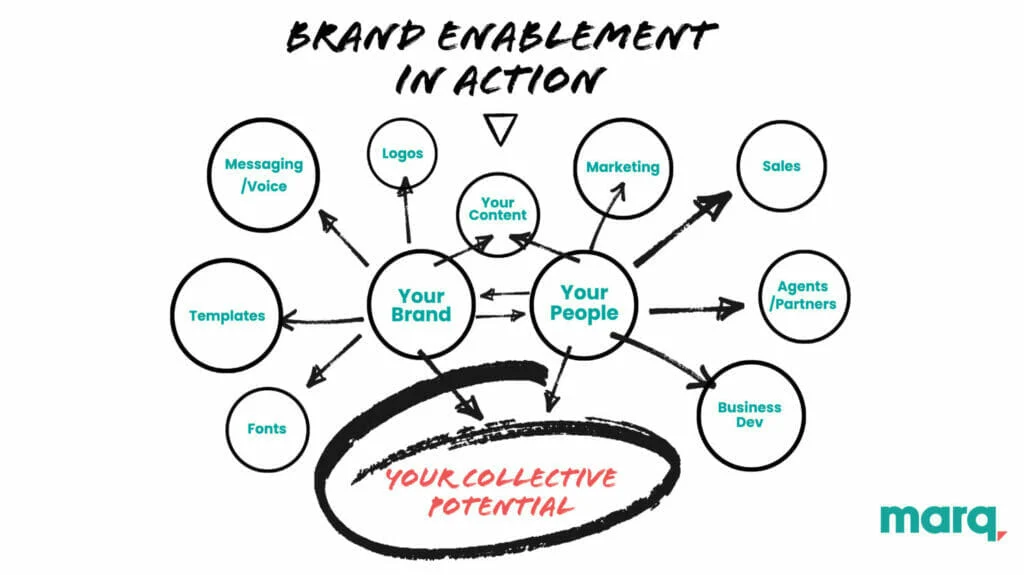
Our CEO, Owen Fuller, just shared in our 2022 Wrapped about where we are headed, and brand enablement is at the heart of it. We’d love to discuss how we can partner with you to help you do more in the new year.
Click here to schedule a 1:1 with someone from our team. Or, you can try Marq today, for free.
If you Google “brand definition” you’ll find forty-three different attempts on just the first page of search results alone. There are so many competing misconceptions about what a brand is that it might be simpler to say what a brand is not: A brand is not a logo. A brand is not a name. A brand is not a trademark, symbol or jingle. Yes, these things affect the brand, but a brand encompasses all of this and more.
Related: 7 key elements of brand identity design
What is branding?
To begin to understand what a brand is, you must first understand that your brand does not exist in your marketing department, your public relations team, or your CEO’s office. A brand exists only in the minds of your customers. Simply put, a brand is the sum total of all the impressions a customer has, based on every interaction they have had with you, your company and your products. Each one of these interactions tells a story to your customers. If your customer believes that a product is new and innovative, then those attributes become part of your brand in that customer’s mind. If your packaging is beautifully illustrated, then they may view your brand as sophisticated or elite. On the other hand, if your service is poor, customers might think you’re stubborn or rude. If your print materials are designed in MS Paint, you may look cheap and amateur.
Every interaction sends a message

Imagine all of these interactions as arrows, and each one points to a message. For example, your product (a big interaction) might point to the message that your company is innovative. Another arrow—your beautifully illustrated print advertisements—might point to the message that you’re sophisticated and elite. But what if an arrow—customer service—is rude and hard to contact? What if your CEO makes an off-color joke that’s caught on a news camera? Every one of these things are interactions you have with your customers, and every one of them is going to affect how they view your company.
All of these examples of interaction “arrows” point to different messages, sending a muddy overall brand message where the customer doesn’t know if you’re likable or not—whether they want to continue buying your products or go visit your competitor.
To manage your brand, you want to decide on a brand message then make sure that all of the interactions with your company—these arrows—are aimed at your brand message.
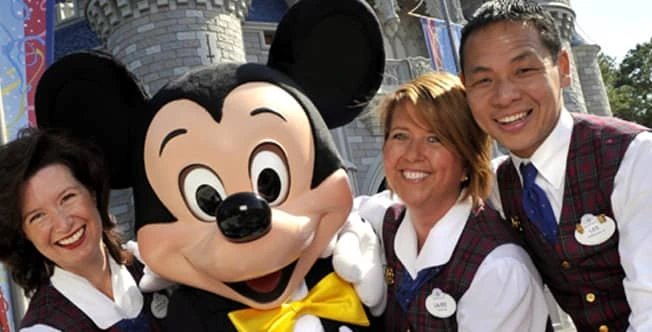
Think, for example, of Disney. Several years ago, Disney decided that their brand was “Magical Family Fun.” They now try to point all of their interaction arrows at their target brand, at every level of the company. Yes, there are the obvious examples, like their movies, and theme parks where actors at Disneyland (called “cast members”) dress up as Cinderella, Jack Sparrow and Mickey Mouse. But their brand influences the Disney Stores across the country: every morning, when the stores open, cast members select children to ceremonially unlock the stores with a special keepsake key. Even when providing customer service, the cast members integrate the Magical Family Fun brand message—aside from always sounding happy and eager to talk with you, they’ll spend extra time on the phone reminiscing about past experiences in the park, always happy to listen to customers’ stories or share their own memories. Everything they do, every one of their arrows, is aimed at Magical Family Fun.
Walmart is another interesting example, because their brand message became their slogan: “Save Money. Live Better.” Yes, they bargain hard to make sure that they have the lowest prices, but they also initiated the now-widespread $4 prescription plan, selling prescriptions for a much lower margin—or, often, no profit at all. They do everything they can to make their customers’ dollars stretch as far as possible. The company’s charitable giving is now more than a billion dollars per year.
Whatever brand message you choose, make sure that your customers’ impressions—your arrows—all point in the right direction. Remember the old marketing adage: “A bad advertisement is worse than no ad at all.” By being a brand ambassador—by sending consistent, targeted messages—your customers will understand exactly who you are and what you can do for them.
Why is branding important?
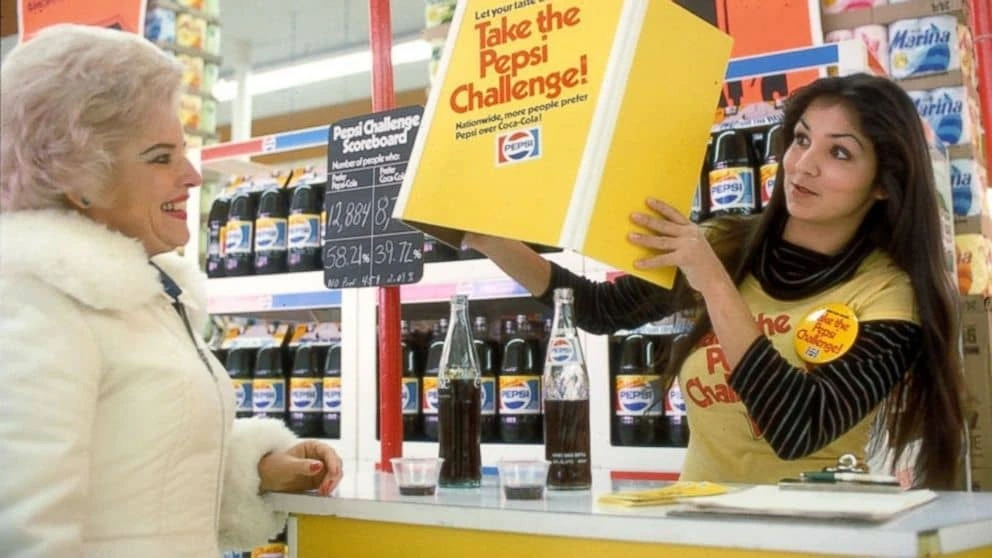
In 1975, marketers at PepsiCo started a campaign that would become a legend in the world of advertising, and would fire the first shot in the Cola Wars. The experiment was simple and effective: booths appeared in malls and supermarkets, sports arenas and state fairs; participants drank two sips of cola from unmarked cups and were asked which beverage they liked better. Overwhelmingly, the choice was clear: consumers favored Pepsi. In almost every venue, in almost every demographic, Pepsi was the winner.
But there arose the paradox: Coca-Cola was destroying Pepsi in market share. Even now, forty years later, Coke controls the largest piece of the carbonated beverage market share—seventeen percent. Diet Coke comes in second place at nine percent. And Pepsi—the clear taste favorite—languishes in third place at eight percent.
Now, there have been some attempts to explain the disparity. In his 2005 book Blink, Malcolm Gladwell suggested that the reason is due to the small amounts: that, when only drinking a sip, people prefer a sweeter drink—which Pepsi is. But studies haven’t always proven that to be true, nor has it been studied nearly as much as competing taste tests.
So what explains it? Well, a research professor at the Baylor College of Medicine decided to really put the claims to the test—to figure out, physiologically, why consumers made that choice.
He put test subjects into an fMRI, a machine that tests brain activity by watching the flow of blood from one region to another. In the first phase of the test, he had subjects drink cola while their brains were being scanned. Once again, Pepsi was chosen as the favorite. It was the ventral putamen that lit up on the scan—part of the brain that makes up the reward system. In essence, the brain was saying “I like this. It makes me happy.”
But in the next phase of the experiment, researchers altered a key component of the test: this time, they told participants what they were drinking. It changed everything. No longer was the reward system lighting up: instead, it was the cerebral cortex, the higher-level decision-making part of the brain. When people drank, their brain wasn’t evaluating flavor; it was evaluating memories and experience. And when this higher-level cognitive part of the brain was working, Coke soundly beat out Pepsi.
This, according to the researchers, was the effect of branding. When a consumer has previous impressions of a product or company, it will actually change the way their brain evaluates such straightforward decisions as “which tastes better?” Coke has a long history of standout marketing efforts. Collectors buy up old ads and bottles dating all the way back to the 1880s. People buy clothes depicting the famous Coca-Cola logo. There is even a Coke museum in Atlanta, where tourists pay $16 for the chance to view exhibits about how great Coke is. And when they look to make their purchase decisions in-store, all of that material makes for a powerful brand.
This is the strength of a good brand management strategy. Granted, Coke has more than a century behind them, and the love of the brand has been passed down from generation to generation. But while becoming the next Coke is daunting (at best), this does serve as a good aspirational lesson on why branding matters.
Key takeaways
- A brand exists only in the mind of your customers. It is the sum total of all impressions that your customer gets from all interactions with you, your product and your company.
- Every interaction sends a message—it is your job, as brand manager, to make sure all of those messages are pointing the right direction to support your brand strategy.
- Proper branding elevates your product to be more than just a sum of its parts. People make purchasing decisions based on more than just product features.
Want to know more about the impact of brand consistency? Download our free 32-page report, chock full of stats & great insights.
The internet is teeming with sites vying for attention, and a poor first impression could very well be your last. It’s a fine line one walks when it comes to nailing that website design. Some get it right; many don’t. From the layout and navigation to the colors and fonts, everything has something to say about the brand behind the scenes.
Related: 8 best practices of high-converting websites
Some studies suggest that it only takes 50 milliseconds for a user to decide whether your website is appealing enough. With such a short amount of time, your website needs to wow them fast and leave a strong impression.
Let’s delve deeper into three areas—design, user experience and content—that can make an impact on your viewer, to give you insight into what your website says about your brand.
Driven by design
With dwindling attention spans and fast-changing loyalties, the design of your website plays a huge role in holding the attention of fast-moving visitors and encouraging interaction.
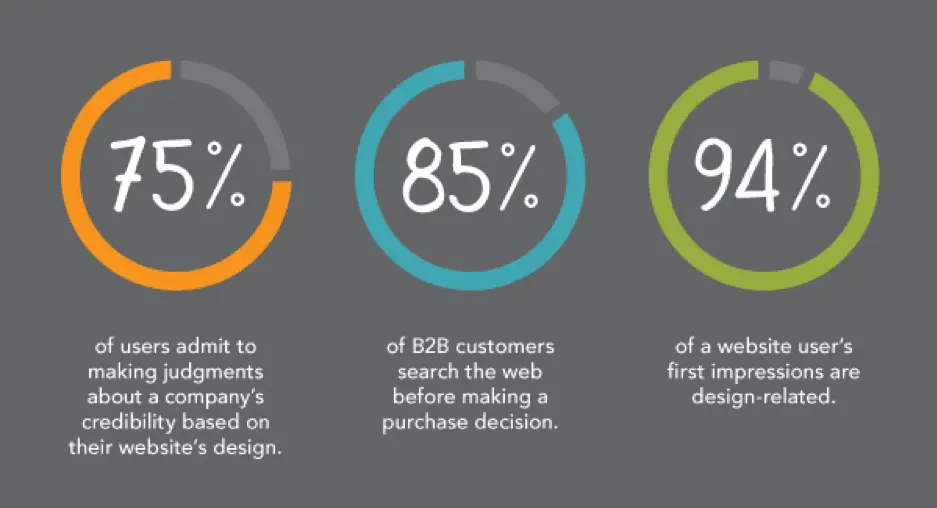
Source: Kinesis
Organizations spend top dollar to help their websites stand out amongst the noise. With special emphasis on digital marketing strategy, a great website design will help you grab your consumer’s attention.
Traits of a well-designed website
Visual appeal, but for the right audience
Looks matter.
In fact, 38% of users will stop browsing your website if they don’t find it attractive enough. So, a visually appealing website is half the job done. But remember—you are not trying to appeal to everybody.
Good design addresses the target audience with a brand personality users want to engage with. Check out this website, Crypton. It’s designed ideally for a tech-savvy audience.

Source: Crypton
Parallax scrolling heightens the user engagement here, but you don’t have to include parallax functionality on every website. Research your buyer personas and use design elements, functions and colors that make your target audience feel right at home.
Your above-the-fold section should do the job
A Nielsen study says the majority of your website visitors will spend 80% of their time above the fold. That’s the section you see without scrolling—call it the opening screen.
The best websites explain what they do in this opening screen. A general practice is to use a headline (think your company’s tagline or mission statement), followed with a brief subtitle text describing your services or products. Top it off with a CTA button to direct visitors toward the next stage in your conversion funnel.
Airbnb does this brilliantly; the headline is the CTA. While there’s no subtitle text, their call-to-action is strengthened by a slideshow of awesome travel photos. Just beneath the headline, a search bar is intuitively placed. The example text in the search bar encourages interaction.
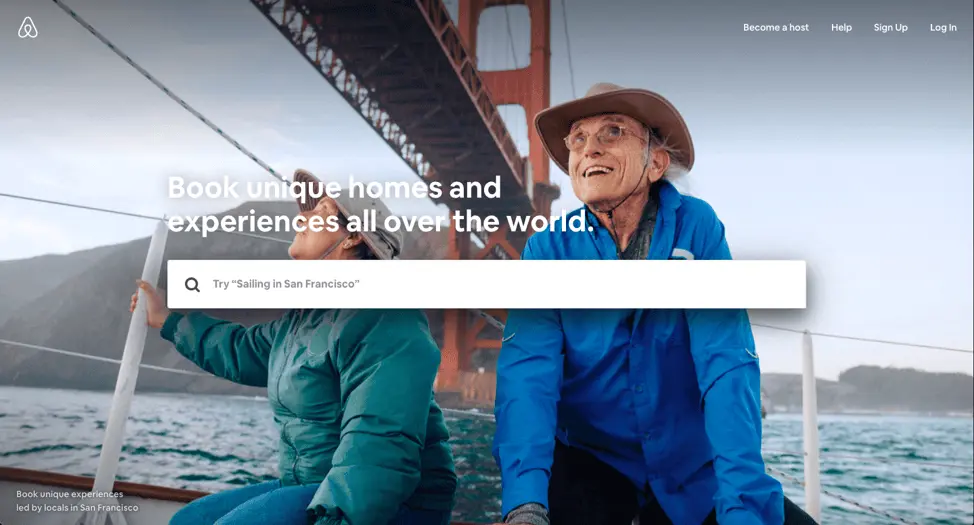
Source: Airbnb
Your design might be ineffective if:
- Your colors are wrong. For example, you’re targeting B2B consumers with a color theme that appeals more to B2C consumers.
* Your site has no visual hierarchy. This confuses the visitor, resulting in missed opportunities and eventual sales.
The design approach you take depends on many factors. Location, age brackets, and target groups will certainly affect how your website should look. Having said that, these factors should be the starting points for your design. A well-designed website that considers all these factors will set you apart from the crowd.
User experience counts
Today, it’s all about experiences. You could have a brilliant product or service, but if your website fails to deliver an enjoyable user experience, all that will be for nothing. It all comes down to how you make your customers feel.
The kind of experience users have, good or bad, will stay with them for a long time, even after the browser window is closed. A well-thought-out homepage or landing page with content that resonates will go a long way towards creating a great user experience.
Let’s see what your website’s UX has to say about you.
Good user experience:
- With good UX, your website tells the world that you think clearly about the end user. See Crunchbase’s website; its UI is done beautifully. There’s the search bar on top if you want to explore specific results, or you can click the menu on the left side to browse sections that interest you.
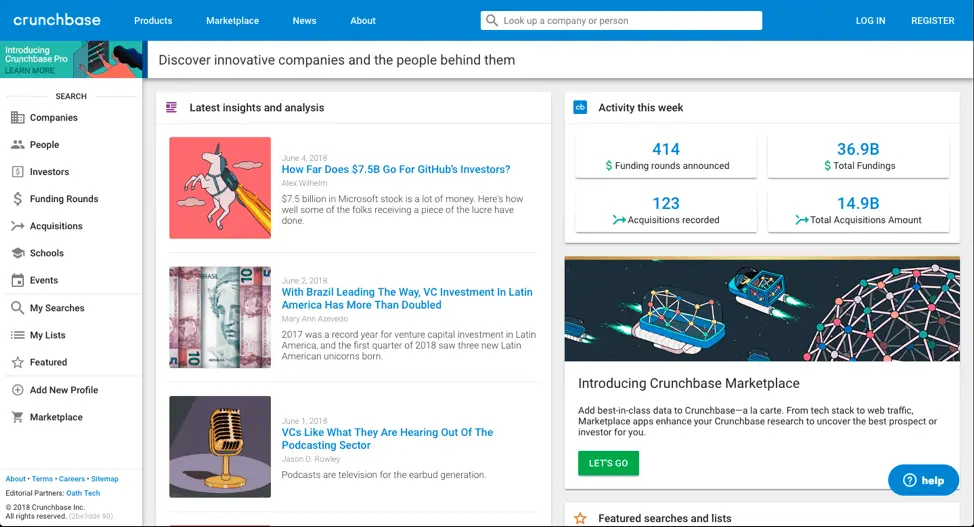
Source: Crunchbase
- Clean, intuitive user interface shows that you have a clear purpose.
* Got a 404 page built? Small things like this send out signals that you don’t skimp on your efforts to deliver an optimized experience.
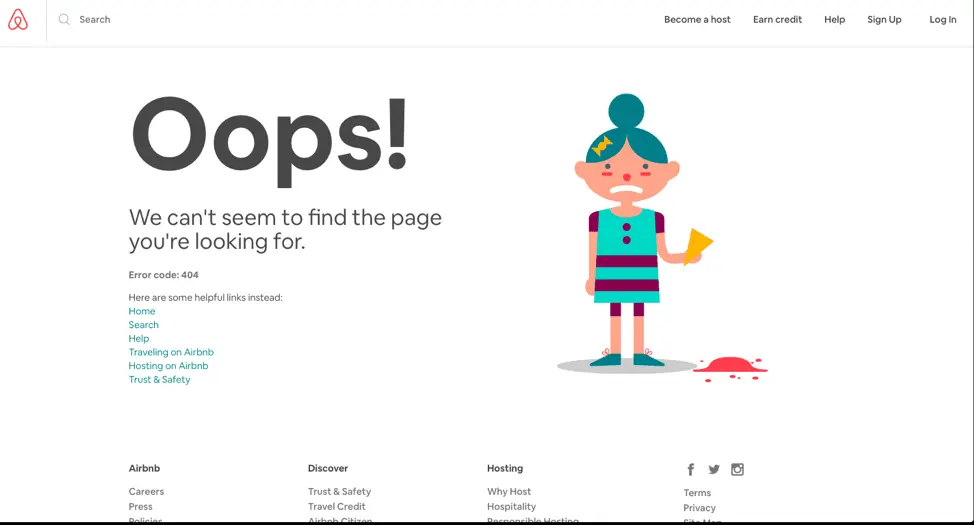
Source: Airbnb
Poor user experience:
- Your website doesn’t respond well to mobile or other screen sizes. This will send a bad message about the lack of strategy and planning behind its setup.
* Too many calls-to-action on one page show a lack of purpose for what your website aims to achieve.
User experience can make or break your website. To stay ahead of the game, it’s important to take feedback from your visitors. Incorporating that feedback will give your users a sense of gratification and improve future visitors’ experience.
Content will make it all work
Content might be the most important aspect of any website. Well-written content will bring you new traffic and repeat visits.
These days, content isn’t limited to the stuff you read. There’s now an increased demand for visual content. Animations, infographics and GIFs tell stories and illustrate data like never before. Compelling content with clear calls-to-action will eventually drive your users toward conversion.
Take a look at how the quality of your content reflects your brand’s personality.
Characteristics of good content:
- Great headlines and a call-to-action above the fold—nice. Videos on the landing page to engage fast-moving visitors—even better. This shows that you want users to get the best, most relevant material quickly without wasting their time.We especially love HubSpot for its content. The blog is fabulous, and there are explainer videos on all their landing pages, plus a video testimonial section. In short, almost every aspect of content necessary to build trust and conversion is present.
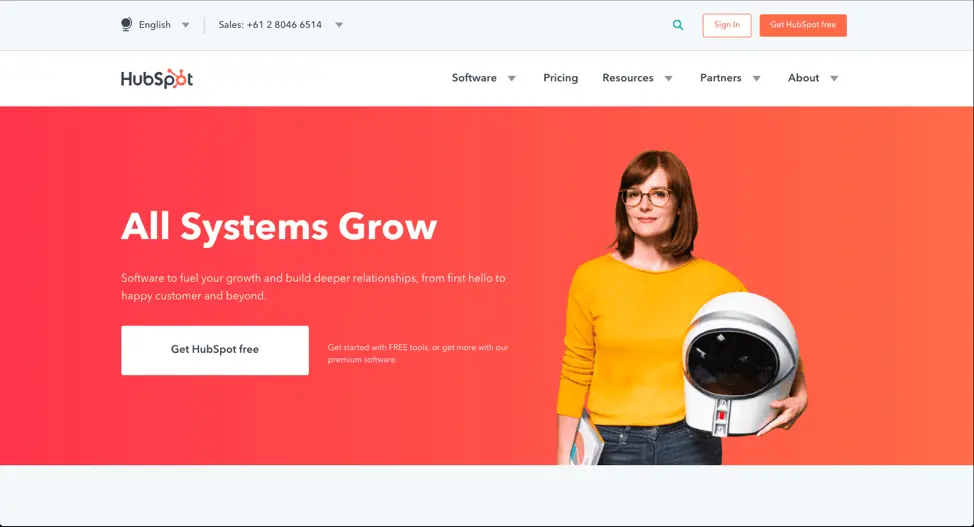
Source: HubSpot
- Use the language and verbal style your target audience speaks in. This shows that you’ve spent time thinking about and curating the content your target audience would appreciate.
* A blog should offer well-researched pieces that add value to your consumer’s decision journey. It will drive home the point that your content strategy cares more about the readers than ranking. This helps build trust and thought leadership.
Characteristics of poor content:
- Grammatical errors or typos on your site. Careless content informs your users that quality doesn’t matter to you. If you can’t pay attention to your content, who’s to say your product, services or customer support will be any better?
* Articles published just for the sake of traffic. If your content doesn’t target your audience or speak to a niche, it will be difficult for audiences to determine who your site is really for.
* Generic content that doesn’t offer anything valuable or new. This demonstrates a lack of research and understanding. The users goes away thinking you don’t really care about their needs.
Key takeaway
With so many sites competing for dollars and attention, it’s more important than ever to offer the user an exceptional experience. By breaking down your website into these three areas of design, user experience and content, you can evaluate how well each one contributes to your brand’s success. Conversely, you can also isolate areas that aren’t working and try new ways to engage your audience. When all of these areas represent your brand authentically and consistently, you will enjoy higher traffic, conversions and customer satisfaction.
Want to learn more about building & managing a brand? Check out our free eBook: Managing your brand in the cloud.
Why did you start your business? We’re pretty sure it wasn’t because you wanted to sell one product every blue moon, or because you don’t care about the services you provide.
Let’s be honest: We all want to make a difference, and we want to be recognized for delivering exceptional experiences. Without a positive reputation built on genuine feedback from satisfied customers, you can wave goodbye to local or worldwide recognition.
Related: 5 tips for building your brand with product & packaging design
You’ve probably noticed that bigger brands tend to have this nailed down. You see that red-and-white logo and instantly recognize Coca-Cola, or that blue background and yellow text belonging to IKEA. Even those multi-million-dollar brands had to start from somewhere. How on earth do you create something memorable—something that a customer will recognize and trust right away?
One answer is product packaging. Packaging is the first thing someone will notice on a shelf or when they receive a delivery to their home. The more they relate to it, the more likely it is that they’ll purchase or recommend it to others.
However, before you reach stardom, there are several ways to increase the chance of getting noticed. From the way you speak about your brand to how you package your products, here’s how to tell a memorable brand story.
Colors draw in the customer
Without color, the canvas is blank. A customer won’t look twice at your product if it doesn’t stand out to them in the first place.
Think about what feelings you want someone to get from your product. Should it make them feel like having fun, like a quirky craft beer? Should it make them feel cared for, like a health-related product? Make a list of how you want your product to make customers feel, and find ways to translate that to your packaging.
It can be easy to match colors with feelings: calming blues, bright yellows, passionate reds. A customer could be drawn to a certain color, depending on what they’re looking for. Colors can help you convey your brand identity, as well.
Who is your audience?
As with any form of marketing, keeping your audience in mind throughout the process is a must. Who will buy your product, and what product packaging will appeal most to that particular audience? Think about colors, shapes, sizes—even the wording on each individual product’s package.
Customers often read the text on a product to reinforce their purchasing decisions in their minds. [] For example, younger audiences prefer brighter, eye-catching colors with quirky shapes and blocky fonts. Older audiences who purchase luxury products prefer colors like black and gold, combined with elegant fonts and sophisticated language. It’s all about knowing who you’re selling to. Once you do, the rest will come far more easily.
Delivery boxes
No matter the size of your business, it’s not only important to have great product packaging on the shelves. When a customer makes a purchase online, they should feel the same excitement for their delivery as they do for the product in the box.
Depending on the size of your business, you might need to batch-order boxes for delivering your products. Businesses often need extra help to meet customer demand. BCS box-making machinery can help to create quality, durable boxing that makes an impact.
Consider sprucing up your boxes with custom-branded stamps, tape and delivery labels—as well as adding extra protection for your product inside each box. Think about padding, branded freebies, and money-off coupons as ways to encourage repeat purchases from your customers.
Logos & graphics
If you’re not including your logo and other branded imagery on your products, how do you expect a customer to know it’s you? When people see a familiar logo, they know almost instantly whether they trust that business enough to buy the product.
Graphics, although not always brand-specific, can often make or break your product packaging. If you’re selling healthy products, you’re more likely to succeed with a green, leafy design. Think about what works, and use a bit of common sense to gauge how you want the product to come across.
Product blurbs
Your brand story is important. So important, in fact, that many businesses make space on their product packaging to write a little about how their business started. Other companies write about their values, such as Lush and their natural, eco-friendly approach.
You can probably think of a few other examples of brands who do this well—which means they’re doing things the right way. The care and effort you take here will pay off when customers remember your story and take it to heart. Shoppers will appreciate an attractive design with an inspiring blurb more than one with a cut-and-dry description. Don’t forget that it’s often the packaging of a product that sells it, not just what’s inside.
Key takeaway
Customers need to recognize your products before building trust and loyalty in your brand. Find your brand’s voice and tell its story—your product packaging depends on it.
Like many things worth learning about these days, brand identity is a topic that sometimes gets so misconstrued and complex that the whole thing turns into a big meaningless fugazi.
For some reason, a lot of designers seem to think that making their ideas about brand identity sound more complicated will in turn make them sound like they know their stuff.
In my opinion, that couldn’t be further from the truth.
Related: Branding? Follow this template for creating a brand platform
In the famous words of Albert Einstein: “If you can’t explain it simply, you don’t understand it well enough.”
Sadly, because many businesses have a preconception that brand identity has to be a complex affair, they make it so. But in the ever-changing, fast-paced business world of today, who’s got time for complicated?
Simplicity is key to making good decisions, fast.
So, if we were to sheer away all of the confusing fluff surrounding brand identity, what sort of beast would we be left with underneath?
Welcome to the minimalist guide to brand identity, where all of the confusing and pretentious stuff is thrown out the window and we focus solely on the stuff that really matters.
Let’s dig in.
Rule #1: If it ain’t broke, don’t fix it.
Just take a look at Gap’s rebrand from 2010.
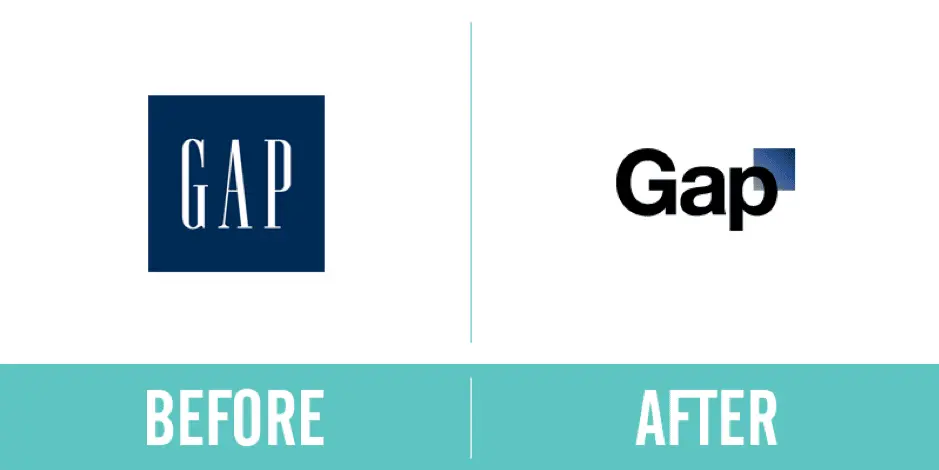
LOOK AT IT!
That change cost them 100 million dollars.
And, they changed it back.
The lesson? If you already have a brand that works, and no compelling reason to change it, leave it as is.
Branding (your brand’s identity) only needs to be changed when the perception of you in the market doesn’t match what you actually do and represent as a business… which leads us into the next rule.
Rule #2: Put your values first.
So, you’ve thought about the point above and decided, “Yes, we actually do need to fix our brand because it doesn’t match who we are.” Fair enough.
But, before you even start to talk about the visual stuff—fonts, colors, imagery and so on—you need to do a little soul-searching to get down on paper the values of your business.
This, in essence, is what a brand’s identity is: the values that the visuals represent. [ ]
Everything about the brand therefore needs to make sense and represent you in some way, so start by answering a few simple questions like:
- What are your business’ values?
- What values do your competitors have that you don’t want to be associated with?
- How do you want people to describe your business, product and service?
Answering those sorts of questions will help direct you in making choices about the visual aspects of the brand.
If you want your brand to be considered tough and macho, for example, you wouldn’t go for a curly, wavy font.
If you want your service to be perceived as simple and to-the-point, you wouldn’t want to go overboard with the imagery.
Once you’ve got those values nailed down, it’s much easier to say whether a visual idea is a good fit for your business.
Rule #3: Simplicity is key.
Sure, you could take a course on branding & design. You could read Pearce’s Theory of Semiotics. You could hire a team of brand consultants to come in with their chihuahuas, fedoras and turmeric lattes to give your brand “pizzazz” and make it pop.
But, why bother when you can keep the process simple?
You’d be amazed at how many companies waste weeks or months—even years in some cases—obsessing over minuscule brand details.
While it’s true that the devil is in the details, it’s also true that branding, just like any other form of art, is incredibly subjective.
Remember that, while you might get into disputes over the finer details internally, as long as the new brand looks good and represents your values, people won’t notice that your font is slightly lighter, slightly bolder, or that you’ve chosen Pool Party Valspar over Filoli Morning Valspar (yes, those are genuine Pantone colors).
In other words, don’t let your own personal ideas of perfection get in the way of progress.
Keep your decision-making system simple, while understanding that people on your team are bound to have a few ideas you don’t, and the process will be both quick and fruitful.
Rule #4: Look at your competitors.
If you want to save time while building a brand identity (and the elements to match), it’s crucial to put together a board of your competitors’ brands, including their logos and value propositions.
Why? Because a lot of businesses rush in, creating a brand they love, only to realize that it looks disappointingly similar to the competition.
Consider zagging where everyone else has zigged. If every brand in your industry is blue, pick another color that will make you more memorable and own that hue instead.
It’s far more powerful to stand out than fit in, so don’t assume that just because everyone else has done something for a reason, you should follow suit.
Looking at competitors early in the process is an easy way to guide your identity and the resulting elements. Other companies will give you insight into exactly which routes to pass by and which ones to explore.
Rule #5: Listen.
I’d strongly recommend using this exercise to build trust with your customers.
Ask them what they think your brand values are to get a picture of the way they see you.
Not only will they love that you got in touch, they’ll feel valued and potentially even become brand advocates.
This is the best and most accurate source of data when revising your brand identity.
Rule #6: Test, tweak and test again.
Once you’ve made your decisions and pushed your new brand identity out there, the key is to test and make sure the changes you hoped would be evident are the ones you actually get.
A soft launch to the same customers you spoke with can be a great way to gauge whether the decisions you’ve made are wise ones.
More often than not, some unexpected reactions and results are likely to occur. A/B testing new messaging & branding on your website and in your communications is a great way to measure whether certain tweaks are working.
When you do launch—especially with changes to messaging—it’s advisable to make incremental changes so you can track exactly what’s worked and what hasn’t. If you push ahead and change everything in one go, you’ll never know which elements are responsible for positive or negative reactions.
Key takeaway
Branding is a huge differentiator. No matter how you approach the subject internally, it’s important to keep a commercial head on your shoulders and realize that the more time & resources you sink into your new brand, the less cost-effective it becomes.
I know that’s a pretty boring thing to say when talking about something as exciting as branding, but many businesses fall into the trap of sinking so much time into brand identity work that the whole project becomes a false economy, costing you way more than it could possibly generate in revenue.
To avoid that pitfall, keep your decision-making process swift, honest, and void of too many personal preferences—and your identity project will be a flying success.
Ready to begin? Learn about the 10 assets you need to effectively manage your brand online in our free ebook.
Sometimes the best idea is the simplest one. That was certainly the case for the founder of J Dawgs, a Utah-based hot dog restaurant that recently opened its fifth location.
One day, Jayson “J” Edwards, then an unfulfilled Asian Studies major, walked past an abandoned red shack in Provo, Utah, and decided that it would make a great hot dog stand. Naturally, he dropped out of school and got to work.

Seven years later, J opened his first restaurant outside of Provo and attributed his success to a single factor: “the food.”
Related: 5 branding lessons we can learn from Metallica
J was right about one thing: the quality of a product determines whether customers will keep coming back to it. But letting a product speak for itself, alone, isn’t a very good marketing strategy—especially for a small, relatively unknown business. It might work in the long run, but it takes a very long run to get there (seven years for J, in fact).
That’s what makes a brand’s personality—the human personality traits that it projects to potential customers—so important. It introduces people to your brand so they can form a positive impression even before they take a chance on your product. (Fortunately, J’s branding has now caught up with his product: see his new page).
In this post, we’ll look at five brands that we think each exemplify one of the dimensions of great brand personality.
1. Sincerity — lululemon
In order for customers to trust a brand with their business, they must first believe that the company actually desires their well-being.
That’s exactly how lululemon comes across with its lowercase, low-key approach to branding. It’s got all the passion of other brands without the tension that comes from trying too hard to impress. Lululemon’s straightforward approach convinces users that this brand has nothing to hide, that it is exactly what it professes to be.
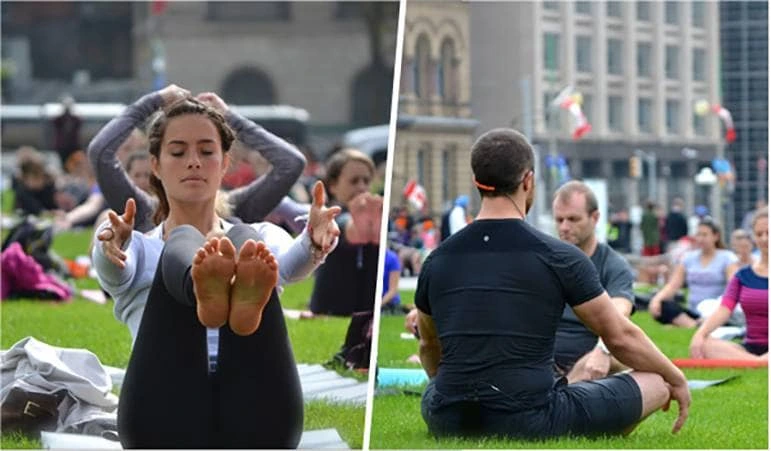
The lululemon blog’s focus on real stories about real people, such as those who participate in yoga on Canada’s Parliament Hill, reinforces its sincerity.
Businesses can develop a similarly sincere brand by setting realistic expectations with customers from the start instead of overhyping a product to force a sale.
2. Excitement — Johnny Cupcakes
While we all value our sincere friends for their truthfulness, they aren’t always the ones we turn to for fun on a Friday night—which is where excitement comes in.
Energy and inventiveness are at the heart of a brand’s excitement. Those are both strong suites of Johnny Cupcakes, a one-of-a-kind “t-shirt bakery” whose designs all manage to look vintage and fresh at the same time. We particularly admire the shaking cupcake-and-crossbones logo that appears whenever you’re waiting for another page to load: its movement suggests the energy underlying the whole establishment.

Companies wanting to give off exciting vibes should look for ways to incorporate pop culture references into their marketing. Such trendiness won’t just earn them more clicks—it will also convey to customers the thrill of buying and using their products.
3. Competence — Genius

A brand is considered competent if consumers perceive it to be dependable, intelligent and successful.
Genius.com manages to convey dependability with its barebones design, intelligence with its no-nonsense moderating system, and success with its insightful explanations of the history and vision of the site. Originally launched as a meeting ground for people to interpret rap lyrics, Genius is now home to helpfully annotated texts ranging from literary classics to fast food menus.
Takeaways for your business:
- Be sure to maintain a consistent brand identity as your business expands.
- Share customer success stories with your users to further cement brand competence.
4. Sophistication — Vango Art
Not every customer is looking for the pure functionality offered by competent brands. Sophisticated brands like Vango appeal to their clients’ more refined sensibilities.
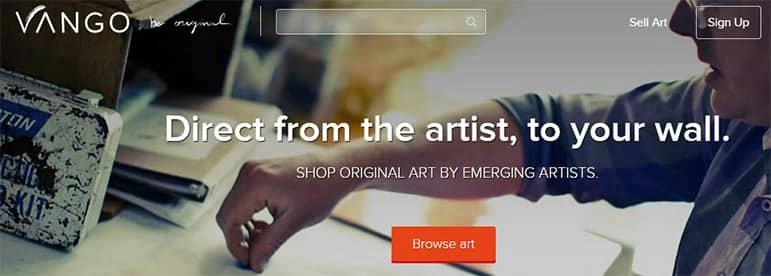
Everything from Vango’s cursive slogan (“Be original”) to the muted background colors contributes to a general sense of delicacy, balance and restraint. The real draw, of course, is the art itself, most of which appears to be the very soul of elegance.
To develop your brand’s sophistication, make it your goal to inspire, soothe and console your clients. For example, you might start a social media campaign, complete with a hashtag inviting users to share relevant, uplifting stories.
5. Ruggedness — Pebble Smartwatch
While a sophisticated approach might appeal to artistic types, it could just as easily leave behind the rough-and-tumble rovers.
In fact, a brand’s ruggedness can deliberately challenge the overblown sophistication of other brands. That’s exactly the case for Pebble, which produces a smartwatch that’s in direct competition with more expensive (and more indulgent) high-end watches. The ad below, with its retro pixel artwork and sassy tone, makes a strong appeal for getting back to basics. This tongue-in-cheek branding helps Pebble tap into the trend of anti-consumerism—without making you think it’s just a cheap watch.
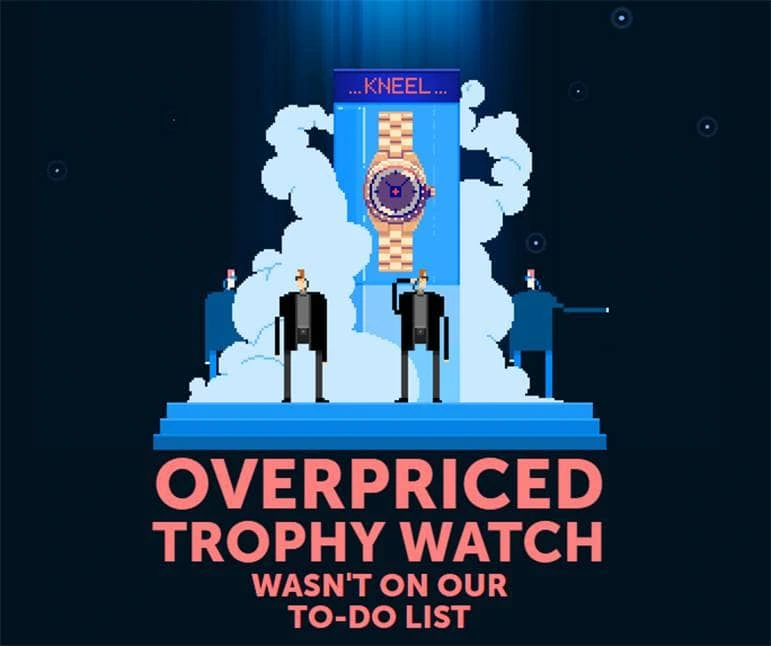
To build up a rugged brand personality, emphasize outdoor use cases and functionality over appearance. That’s not to say that your product should look bad; just don’t make it showy.
What does this mean for my brand?
While we’ve picked out brands that we think exemplify each of these characteristics, no brand can or should fit perfectly into a single category. Instead, you may blend several of these characteristics together for optimum results.
If you’re unsure where to begin, consider listing what you know about your audience. Your brand personality should be a response to their needs and interests. Once you know what speaks to them, you’ll begin to understand what kind of brand personality they will appreciate.
Learn more: Do you know the 10 essential brand assets for digital success?
With the right slogan, you can make people giggle at a pun, ponder the mysteries of the universe, or even experience a powerful craving. A poor slogan, on the other hand, risks making customers cringe. And forking over cash is usually the last thing someone wants to do after cringing.
This post will give you a 5-step guide to writing great slogans. So whether you need a brand new idea or you’re refining an existing slogan, you’ll be in business. Let’s get started!
Related: Learn more about the 10 assets you need to effectively manage your brand online in our free eBook.
1. Make your slogan ABC: Ambitious But Credible
Believability is the first test of a good slogan, because a customer’s belief or lack thereof largely determines how he or she will respond, and that response could very well be the difference between buying and walking away. No matter how much fun your slogan is to say, or how good it looks next to your logo, it won’t do any good if your customers don’t believe it. []
For example, Nike’s command to “find your fast” comes across as completely believable. While having the right equipment isn’t the only factor in athletic success, it is a factor. Slogans like this one invite consumers to put their trust in a brand, which is a big plus.
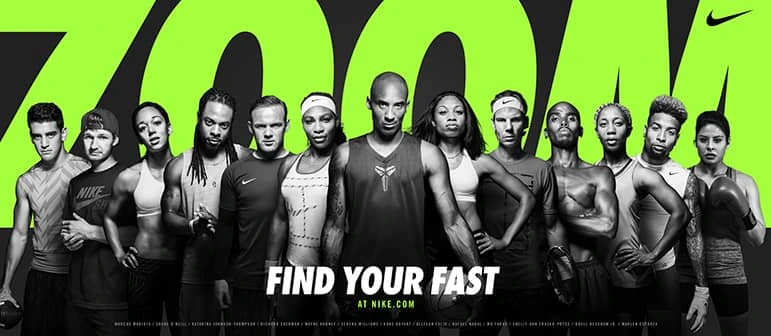
Some key questions to ask about your slogan:
- Do I believe it?
- Is there good reason for my customers to believe it?
- Does it set a high standard for the product?
2. Appeal to emotional needs
Making a purchase is often an emotional experience. If a slogan can incite a strong positive emotion (think joy, excitement, sympathy, etc.), it stands a better chance of connecting people with the products and services that aim to fill those needs.
For example, major hotel chains go out of their way to convey comfort: Hilton claims to be “filling the earth with light and warmth of hospitality,” while Aston bids “welcome home” to each traveler who sets foot on their premises.
You can also tug at the heart strings without being sappy. When Kleenex launched a video ad about a boy who gives a tissue to a girl he spots crying on the school bus, the closing observation that “someone needs one” positioned Kleenexes as the universal response to tears everywhere.
Questions to consider about your slogan:
- What emotions does it invoke?
- Which of my target audience’s needs does it relate to?
3. Stand out with clever wordplay
Your slogan ought to be tricky or clever enough to make most readers think about your slogan for a minute or two, which makes it more likely that they’ll remember it. If it’s too tricky, however, it can go right over their heads and leave them confused.
There’s no easy way to come up with a clever saying, but you can start by listing words that have to do with your product, then searching for rhymes, synonyms, and alternate definitions for puns.
Those aren’t the only ways to make your slogan stand out—in fact, sounding too catchy in a clichéd way could be counterproductive. Reese’s “two great tastes that taste great together” follows an A-B-B-A structure that, intentionally or not, imitates the peanut-butter filled structure of the candy itself.
Nor does it have to be complicated to sound good. “Ace is the place with the helpful hardware folks” isn’t just easy on the tongue; it’s also a straightforward slogan that goes well with the down-to-earth nature of hardware stores.
Ask yourself:
- Are consumers likely to understand the slogan’s wordplay?
- Does the cleverness of the slogan distract from or reinforce its overall message and effect?
4. Just say no to clichés and superlatives
How do you know when you’ve crossed the line from catchy to corny?
If people can sarcastically cite your slogan to disprove it when they experience setbacks, you’ve probably crossed that line. []
Another sign you may have gone too far is the use of tired clichés. Phrases such as “we do X so you don’t have to”; “for x, by x”; and “x of the future” are all used so frequently that consumers are used to tuning them out. If you really want to express the sentiment embodied in these phrases, find a unique way of doing so.
Some key questions to consider are:
- In what ways is my slogan different from most slogans?
- In what ways is it similar, possibly too similar, to most slogans?
- How likely are customers to roll their eyes at it?
5. Maintain a strong connection to your business
Can you match the following slogans to the product they represent?
1. Made like no otherA. beverages2. Rethink the daily grindB. women’s deodorant3. Live loudC. toilet paper4. Live life in full colourD. denture fixatives5. Bend the rulesE. 3D desktop scanners6. Designed to be forgottenF. ice cream
Having trouble making the connection? The point is that a slogan should strongly relate to the product it promotes. It if doesn’t, then it might catch people’s attention momentarily, but it won’t stay with them.
It’s best if there’s a strong, interesting link between your slogan and your product. For instance, Aquafina’s insistence that their water is “for happy bodies” makes good sense. Sunchips’ claim to be “unique in every wave” distinguishes their chips from their less curvy competitors. Finally, Paper & Packaging Board’s assertion that their products are at the heart of “how life unfolds” wouldn’t make much sense for, say, a burger stand.

(And if you want to know the quiz answers, here they are: 1. F, 2. A, 3. D, 4. B, 5. E, 6. C.)
Congratulations! You made it through Business Slogans 101. Once you’ve written a killer slogan of your own, be sure to sell it visually as well as verbally. Lucidpress templates can help you incorporate your new slogan into all kinds of marketing materials: social media graphics, digital magazines, company newsletters, and much more.
We love stories. We use them to understand our world, to make connections with others, and to find meaning in our lives. Ever notice how, at a party with a lot of loud conversations, when someone starts getting into a great story, the conversation dies down and everyone turns to listen? That’s the power of stories. We can’t resist the good ones.
That being said, it’s no surprise that the brands who tell great stories are being noticed. At its best and most powerful, content marketing is storytelling. [] That’s what the phrase “storytelling marketing” is getting at—a story-focused approach to your marketing and brand building.
Related: How to use storytelling to raise conversion rates
In this post, I’ll cover four examples of brand storytelling from top companies and talk about how all of us can learn from and apply their best practices. So keep reading to see what Apple, Airbnb, John Deere, and Jell-O can teach us about storytelling marketing and building a brand.
1. Apple and Steve Jobs
Apple was destined to make it onto this list. Ever since my family got our first Mac, I’ve been a fanboy. And as for Steve Jobs, his life and work have inspired me personally and professionally in deeply affecting ways. He’s one of my superheroes. Personal stakes aside, Apple can tell a great story. And often, Steve Jobs was the one who told those stories.
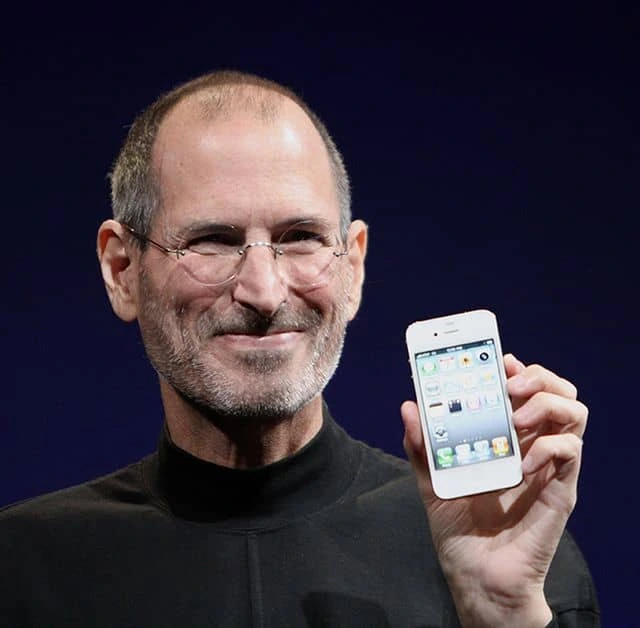
Jobs’ introduction of the first iPhone in 2007 is the stuff of legend. I still get goosebumps watching it and basking in the masterful storytelling. Steve begins by telling the audience why they should care about what he’s about to tell them. Because of what Apple had done before, and because Apple knew their market so well, it was almost a given that people were invested in Steve’s presentation. But he doesn’t make that an excuse to ignore good storytelling principles.
Steve begins the presentation by masterfully building suspense. A touchscreen iPod? A phone? An internet communicator? What is he up to? Then, even as the audience is starting to catch on, he lingers in the suspense a bit longer before making the reveal: a three-in-one mobile phone that would change the world forever.
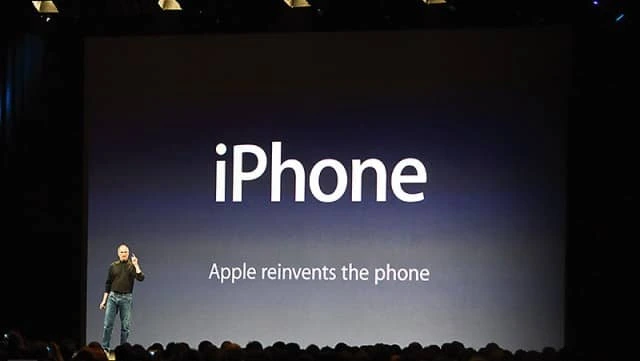
Jobs was building the iPhone’s brand even before the audience had seen it, and the story was consistent with the company brand Apple had already built. Apple knew they’d made something exceptional. It was up to Steve to tell the best story, and he did.
Today, Apple continues Steve Jobs’ tradition of storytelling marketing. They do a great job of telling a story about what it looks like for customers to successfully use their products. Apple weaves their products seamlessly into the story. They also show how their products help people create their own stories, and Apple highlights the stories people create.
An example of this is the “Start Something New” initiative that showcases art people are creating with Apple products. With this page, Apple is providing a platform for their customers to tell the brand’s story, a technique that can produce the most authentic and engaging results.

I will say that this site has some big UX issues, which is uncharacteristic of Apple, but I love the idea. Apple’s TV spots for the iPhone 6S also follow this principle. The spots don’t linger on gratuitous close-up shots of the iPhone and how pretty it is (though boy are Apple products pretty). They show relatable but slightly-cooler-than-is-realistic people using the iPhone to do really cool things.
What can we learn from Apple?
- Hook the audience first, introduce your product second
- Build suspense
- Focus your story on customers successfully using your product
2. Airbnb
I’ll just come right out and say it: Airbnb blew me away with their content. It’s the kind of stuff I would enjoy reading just because. After browsing the content for a bit, I was totally hooked. And I never once felt like I was being marketed to. But I can say that I definitely wanted to go stay somewhere with Airbnb after reading.
So their approach works. Airbnb’s content is totally focused on people—on the people who own the homes listed and the travelers who go there. They show how connecting with others is important to their brand and how their brand makes that possible. It’s a very human approach, and it works perfectly. In a very clear statement about the importance of stories to the Airbnb brand, there’s an entire page on their website labeled airbnb.com/stories.
This page has videos and little bios of Airbnb hosts around the world. It was one of my favorite things I found on the site.
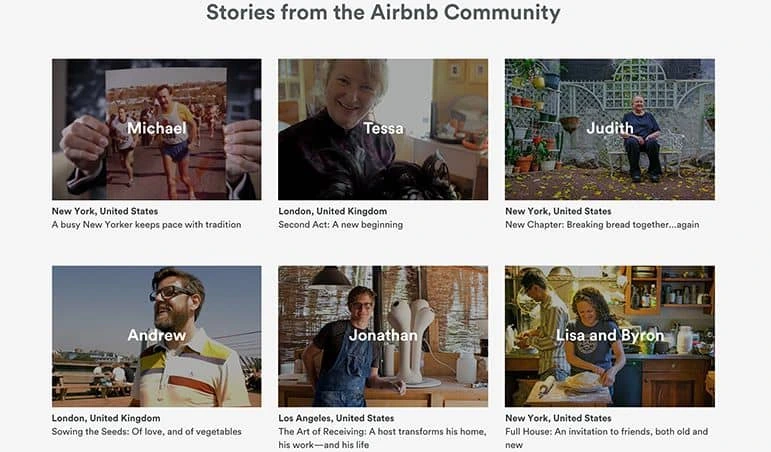
Here’s one of the stories that I especially enjoyed. Airbnb is also experimenting with a brand magazine called Pineapple. On their website, Airbnb describes Pineapple as “a platform for the incredible stories from Airbnb’s extended family to be shared; it is somewhere for readers to see how people live and create connections in cities today.”

This meshes perfectly with the rest of Airbnb’s approach. They focus on the stories and on the people, recognizing that this is the language by which humans communicate, so that is the approach that will attract more customers. There is also a truly genuine element running through Airbnb’s content.
At least I got the sense that they really do care about their communities and the impact that Airbnb has on them. They are invested in the lives of these people. They care. Content marketing best practice? Care about your customers. []
What can we learn from Airbnb?
- Ask yourself, “Would people pick up my content from their coffee table and read it?”
- Always bring it back to the human element
- Be sincere
Note: I found a lot of the information about Airbnb from this post.
3. John Deere
Believe it or not, John Deere is pretty darn good at content. And they’ve been putting an emphasis on content since before most other brands even existed. For some context, let’s take a quick look at the history.
In 1895, John Deere printed the first issue of The Furrow, their brand magazine. This was long before anyone had even mentioned the phrase “content marketing.” By 1912, the magazine was being distributed to 4 million readers. John Deere still produces The Furrow today, which is received by about 2 million global readers.

It may not have been hard for the folks at John Deere to realize that agriculture is important to their customers, and, predictably, agriculture is the focus of The Furrow. But it’s the diversity of the topics and stories covered that really makes this magazine stand out. It may be tempting to group all farmers into one category, but from what I’ve seen, they’re a diverse group. In speaking to farmers generally, John Deere has the difficult task of telling stories that a lot of different people will care about.
This is reflected on the topics that are featured in The Furrow. They run the gamut from a piece on the beef industry to coverage of gourmet chocolate production in St. Lucia. Both of these stories are focused on agriculture, but in very different ways. Even so, because they’re interesting, well-written stories, they have a broad appeal that transcends differences in the agricultural community.

I also really like the fact that The Furrow is a magazine, and even more, I like that it’s distributed digitally. Using Lucidpress, your brand can follow John Deere’s lead and create digital magazines to present your story and build your brand. Lucidpress has a great collection of online magazine templates that make the process fast and easy. Lucidpress also has collaboration features that allow a team to work together on the same project at the same time. If stories enhance human connection, then it’s also true that the best stories come from humans working together.
What can we learn from John Deere?
- Utilize the digital magazine medium
- Know what connects your customers to you
- Don’t get stuck telling just one story
Note: The historical information about The Furrow is from this blog post.
4. Jell-O
I thought it’d be nice to wrap this post up with a fun example. Who doesn’t love Jell-O, right? Ok, a lot of you probably don’t like to eat Jell-O, but I dare you to tell me that you don’t find joy in this:

And then there’s this classic scene from Jurassic Park:

Never gets old. But in addition to providing endless entertainment without ever leaving us too full, Jell-O does a good job of brand building with storytelling marketing. The story Jell-O has focused on is people successfully making delicious desserts using their product (a similar approach to Apple, but with gelatin instead of hard drives).
Half of their website is devoted to easy-to-make recipes, and the photos of the finished products come together to form a great example of visual storytelling. Take a look:
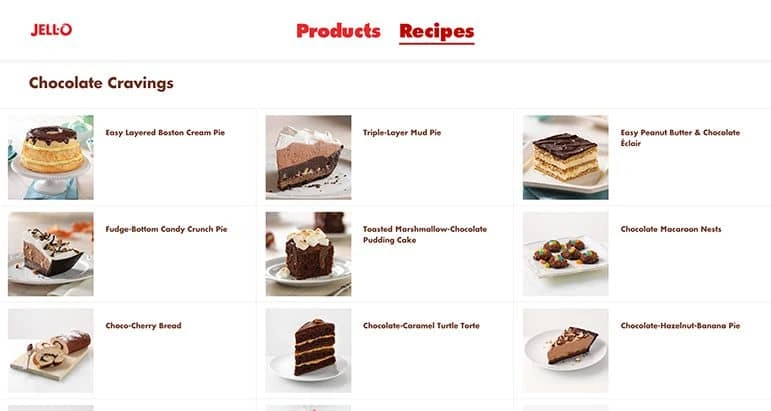
What this page illustrates is that you can get creative with brand storytelling. Recipes might not be the first thing that comes to mind when you talk about storytelling marketing, but because of the way Jell-O presents their recipes, it becomes a story about all the things that you can do with Jell-O. Sure, they left out this application:

But they told a good story, regardless.
What we can learn from Jell-O?
- Think outside of the box when deciding how to Kraft (couldn’t resist) your story
- Make your story actionable—what are customers going to do because of it?
- Don’t forget to make it look good
So now what?
Brands live or die on their ability to enhance human connection. And stories, I have found, are the best way to build connections. So, take a look at your brand. Find the human element, and ask yourself, “How can I make people’s lives better? What story would they like to hear?”
You can jump on a call with some of your customers or maybe send out a survey to find the answers to these questions. Once your brand’s story begins to take shape, you can use Lucidpress to present your story in the best possible way. Whether that’s a magazine, a monthly newsletter, an eBook, or something else entirely. If your customers feel that your brand improves their lives, then they’ll want to be a part of your story. And in the end, your story is your brand. So make sure it’s a good one.
Want to know more about how to build your brand? Download our free ebook on how to build a brand in 2020.
Put simply, the difference between corporate branding and product branding is that corporate branding represents an entire company and its complete portfolio of products, while product branding focuses on a single product. Orville Redenbacher’s popcorn is a product brand. ConAgra Foods is a corporate brand.
Related: What is branding, and why is branding important?
Let’s take a quick step back to a recent blog where we defined what branding is: a brand is the sum total of the impressions of all interactions that your customer has with you. If it’s product branding, it’s all the interactions with your product—the packaging, commercials, quality, and so on. If it’s corporate branding or corporate identity it’s all the interactions they have with your company.
How visible is your corporation?
Depending on your company, the corporation may be virtually unknown—everyone knows about Twinkies, but few have ever heard that they’re owned by Flowers Foods. On the other hand, your corporate brand may be front and center for your consumers.
For example, Procter & Gamble was an official sponsor of the Rio Olympics. Their individual products were mentioned, but the focus of their ad campaign focused on P&G as a whole, continuing the mom-oriented messaging they’ve used in recent Olympic games. The campaign focuses on the strength that moms pass onto their kids, and how P&G is an ally in that goal. They cite several of their products: Tide detergent, Bounty paper towels, Pampers diapers, and more. But those products are seen very briefly; this is about corporate branding, and it’s the P&G logo that is displayed proudly at the end of the commercial.
When corporate branding replaces product branding
Of course, Procter & Gamble doesn’t usually advertise the company as a whole (because their products are so many and so varied—from Dolce & Gabbana perfume to Pepto-Bismol to Febreze—that it’s hard to lump them together and promote them as a block), but other multi-brand companies choose to brand the company instead of the individual products. GE is a good example: they sell microwaves and ovens, but they also make MRI machines, wind turbines, light bulbs and mining equipment.
So, when GE advertises, they’ve made a decision to promote the entire company. A new ad campaign titled “What’s the Matter with Owen?” is a self-deprecating series in which a young college grad gets hired by GE and, instead of congratulations, he gets sympathy from his uninformed friends. He has to explain to them (and to us, the viewers) that GE is a great company for developers like him. They’re a “digital industrial” company.
When your product portfolio needs to be split up
Recently on this blog, we talked about Disney’s brand message: “Magical Family Fun.” It’s a message that defines its theme parks, movies, stores and merchandising. But The Walt Disney Company consists of much more than just magical family fun. They own other family fun brands like Lucasfilm and Marvel, the ABC Television Group (with channels like A&E, the History Channel and Lifetime), and ESPN with its many spin-off channels.
In this case, all of these disparate brands under The Walt Disney Company’s umbrella don’t get into corporate branding the same way that consumer-packaged goods conglomerates like Procter & Gamble do. They occasionally work together (ABC collaborates with ESPN during March Madness, for example), but ESPN never raises the Disney flag.
Your corporation has a brand whether you manage it or not
But here’s the thing about branding: you have a corporate brand, whether you are managing it or not. Your company’s products do not exist in a vacuum. Disney has suffered lawsuits and boycotts against one subsidiary because of the actions of another.
The Southern Baptist Convention voted to boycott Disney’s theme parks and movies because ABC was airing Ellen, the show in which Ellen DeGeneres came out as lesbian. The Catholic League called for a boycott of Disney when Miramax (a movie studio owned by The Walt Disney Company until 2010) released Dogma, a movie where God is played by Alanis Morissette. Because Disney owned all of these things, people chose to boycott more than just the properties which offended them.
When brands clash
A similar thing happened with the large brand conglomerate Unilever: Dove soap began the “Dove Campaign for Real Beauty,” a marketing campaign which focused on non-Photoshopped models and women who were comfortable in their own skin. It was, and is, a beloved campaign for Dove beauty products, but it was cited as hypocritical by some who realized that Unilever also owned the Axe brand—a brand that, according to protesters, objectified women. (Ads for Axe showed airbrushed models unable to resist men who had used the body spray.)
Protesters added that, if Unilever would show gratuitously sexual ads, then the “Dove Campaign for Real Beauty” is not a true value of the brand or the leadership at Unilever, but a simple marketing ploy.
Key takeaway
Not every conglomerate has to behave like Procter & Gamble, advertising its products together as a group with a single focus. Nor does a company need to be like GE, uniting all of its products under the same brand. But whenever you are interacting with your customers, you are sending a message. Corporate branding is happening whether it’s directed by the company or not.
Magazines have found new life on the web, where old brands have undergone a digital transformation to stay relevant and compete with myriad newcomers both fragile and nimble. A look at the newsstand might make one wonder where all the magazines have gone—but often, a simple Google search reveals the answer.
Related: How to make a magazine in 12 steps
We love magazines here at Lucidpress, which is one reason why we make it easy to design and share your own. Gorgeous and informational, magazines are an enjoyable way to connect with a lifestyle, hobby or industry—such as brand management, for example. Here’s our roundup of the 8 best free magazines online for brand marketers.
1. Branding Magazine
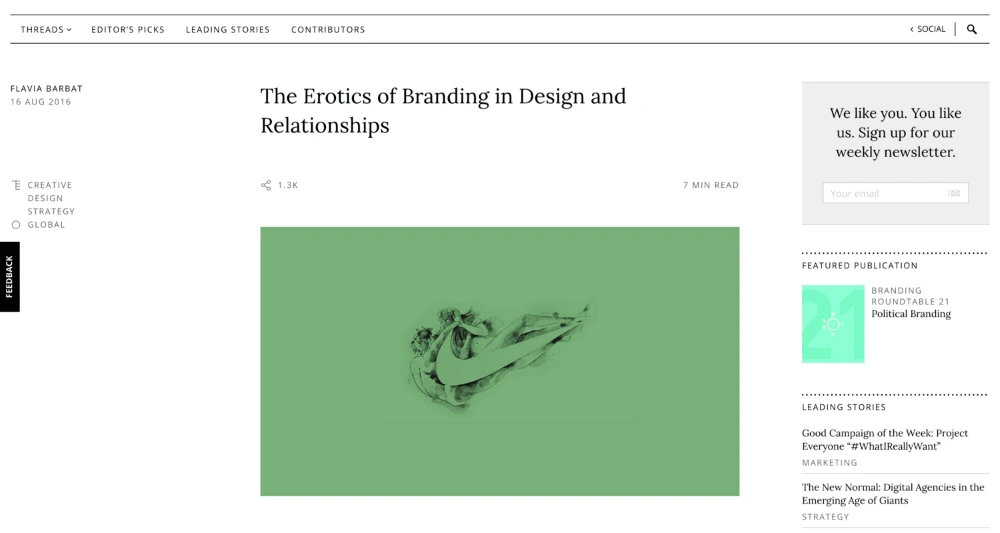
With the tagline “Narrating the discussion,” Branding Magazine covers thought leadership and conversations happening in the branding and marketing industries across the globe. Data and case studies combine to create compelling How-To guides and other advice. Articles are beautifully designed and free to read online.
Recommended first read: The Erotics of Branding in Design and Relationships
In this evocative article, design strategist Jonathan Ford speaks with relationship expert Esther Perel about brand desirability and devotion, and why we find ourselves drawn to some brands but not others.
Subscribe: http://www.brandingmagazine.com/
2. Brand Quarterly
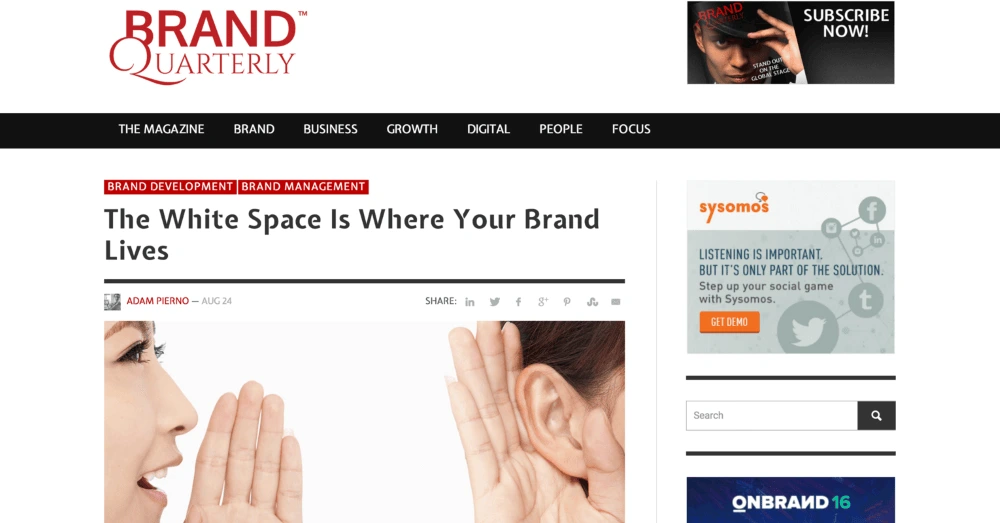
Brand Quarterly takes a holistic approach to brand management, pulling in relevant stories and data from various sectors of the marketing world. A quick glance at their latest articles reveals insights about multigenerational marketing, inbound strategies, and even personal branding tips.
Recommended first read: The White Space Is Where Your Brand Lives
In this article, author Adam Pierno reminds us that there is more to our brands than logos and messaging; context beyond our control contributes to brand perception as well.
Subscribe: http://www.brandquarterly.com/the-magazine
3. Brand Packaging
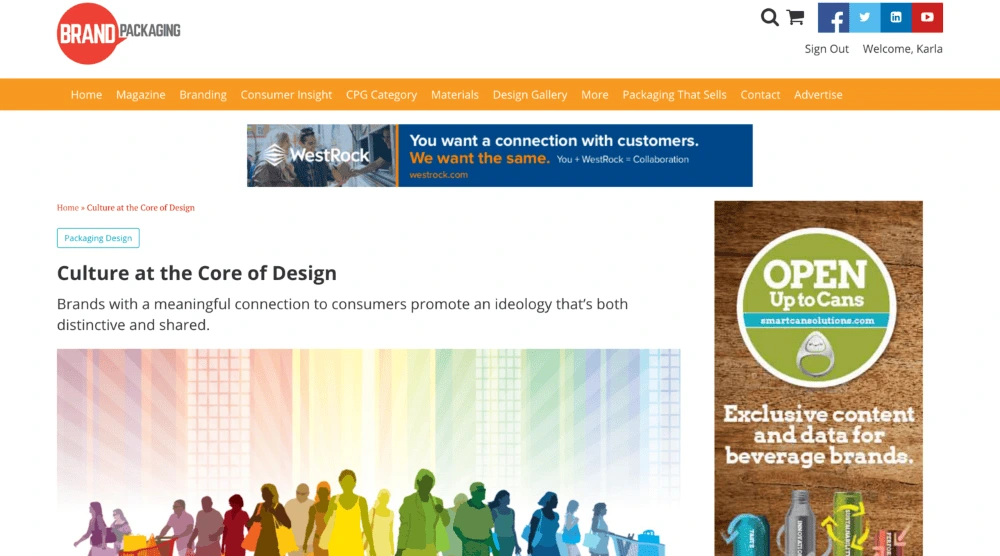
Brand Packaging puts a special focus on how brands present their physical products—that is, product packaging. However, it is so much more than that. In this magazine are important discussions about what makes a brand resonate, what keeps it relevant, and why consumers behave the way they do.
Recommended first read: Culture at the Core of Design
In this article, author Ted Mininni examines what makes a brand culturally relevant, and how one brand in particular—Monster Jam—became a unique cultural phenomenon.
Subscribe: http://www.brandpackaging.com/publications/3
4. Onbrand Magazine
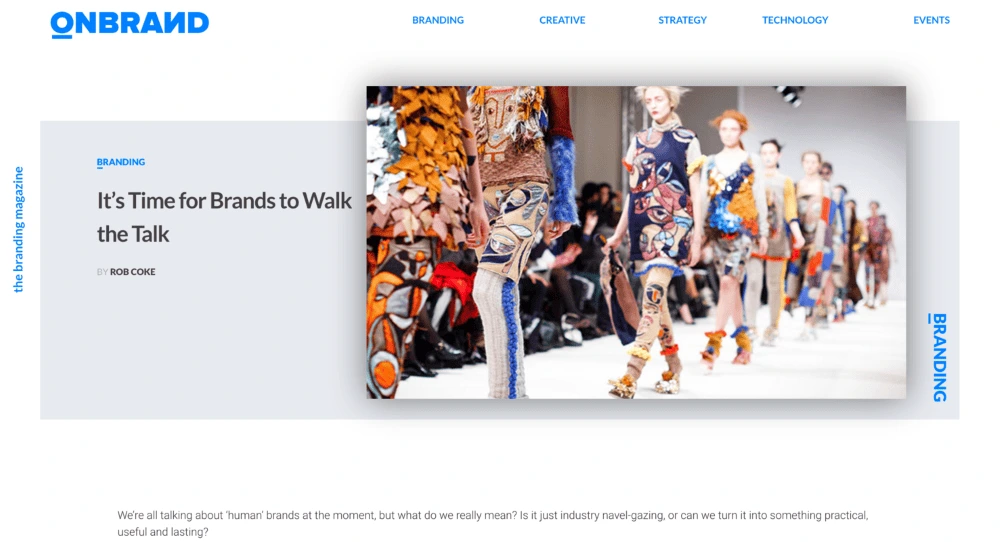
With a sharp focus on the outer edges of technology, Onbrand Magazine features contemporary discussions about the future of brand management. From virtual reality to the latest social media development, Onbrand raises questions and offers advice on how to move your brand forward.
Recommended first read: It’s Time for Brands to Walk the Talk
In this article, author Rob Coke wonders whether “brand” has become a redundant concept—or worse, conflated with the worst of sleazy advertising techniques. How can brands adjust to show their genuine, honest purpose?
Subscribe: https://www.onbrand.me/
5. UX Magazine
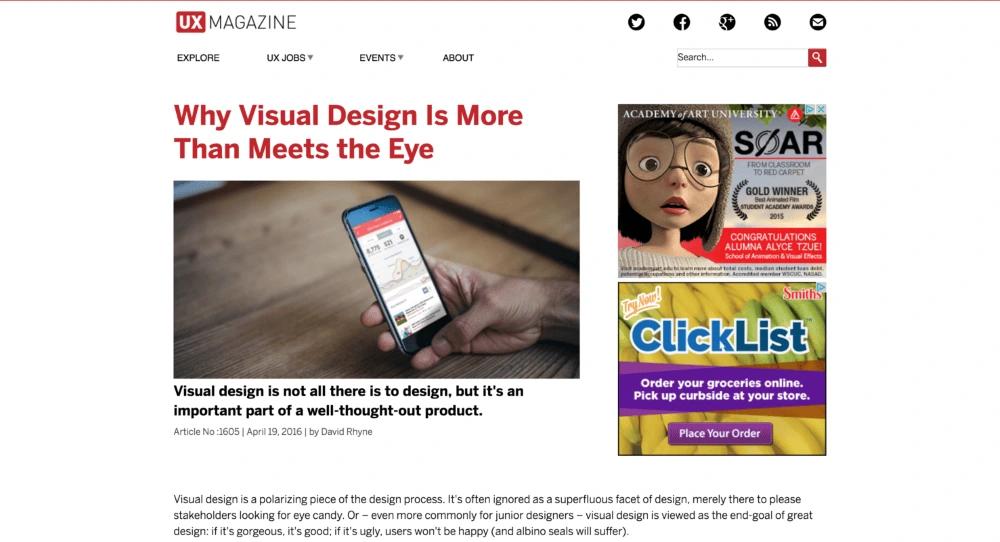
Although it’s primarily focused on user experience design, UX Magazine has a robust “Marketing and Brand” section, dedicated to content that lives in that shared Venn diagram space where UX and branding meet. If you aim to be a well-rounded brand manager, it pays to check in here once in a while.
Recommended first read: Why Visual Design Is More Than Meets the Eye
In this article, author David Rhyne examines the who, when and why of visual design—and how good visual design is part of a well-thought out product and an effective brand.
Subscribe: https://uxmag.com/topics/marketing-and-brand
6. Transform Magazine
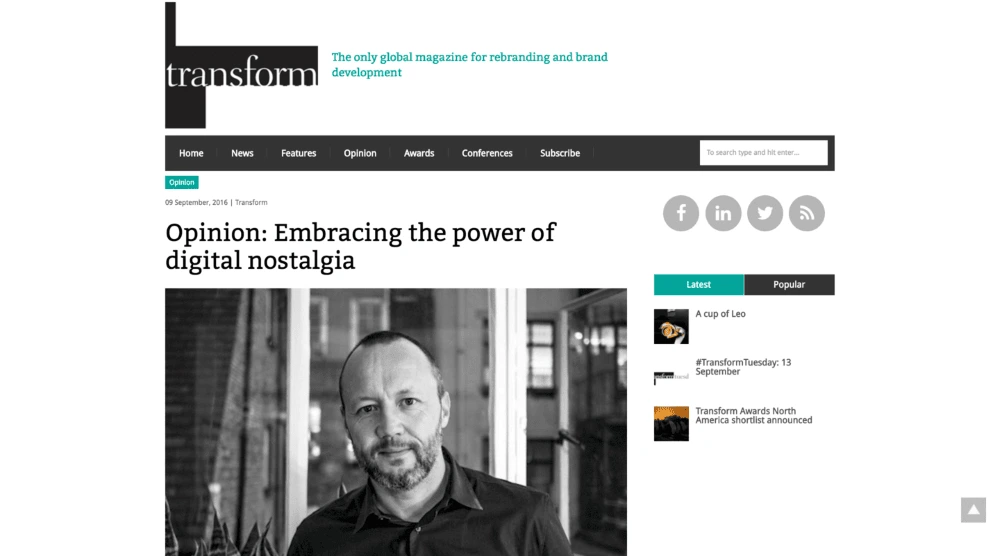
Calling itself the only global magazine dedicated to rebranding and brand development, Transform Magazine puts the spotlight on an area of branding that is often overlooked. Successful brands evolve and change with the times, and you can learn important lessons by hearing their stories.
Recommended first read: Embracing the Power of Digital Nostalgia
In this opinion article, CEO Simon Massey of the Gild takes a look at nostalgia in the digital age, and how brands can build a bridge between the digital and the physical.
Subscribe: http://www.transformmagazine.net/
7. Harvard Business Review
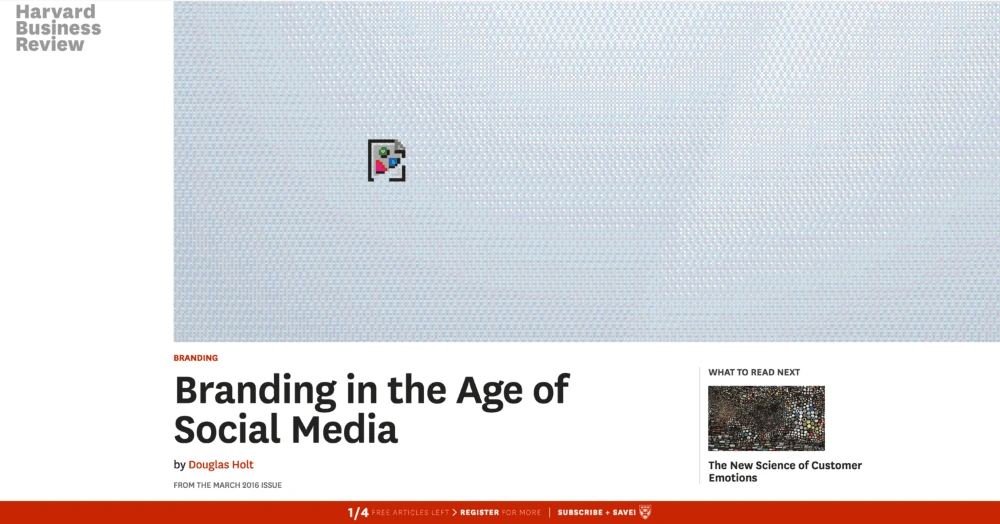
Just because you’ve graduated college doesn’t mean you should leave this gem behind. Harvard Business Review has an impeccable reputation for providing practical case studies and actionable advice. Check out the Branding section—you can read 4 articles for free each month, or register to read 4 more.
Recommended first read: Branding in the Age of Social Media
In this long-form article, brand expert Douglas Holt dives into the success and failure of brands on social media, and how a concept called “crowdculture” changes the rules of branding online.
Subscribe: https://hbr.org/topic/marketing
8. Chief Content Officer
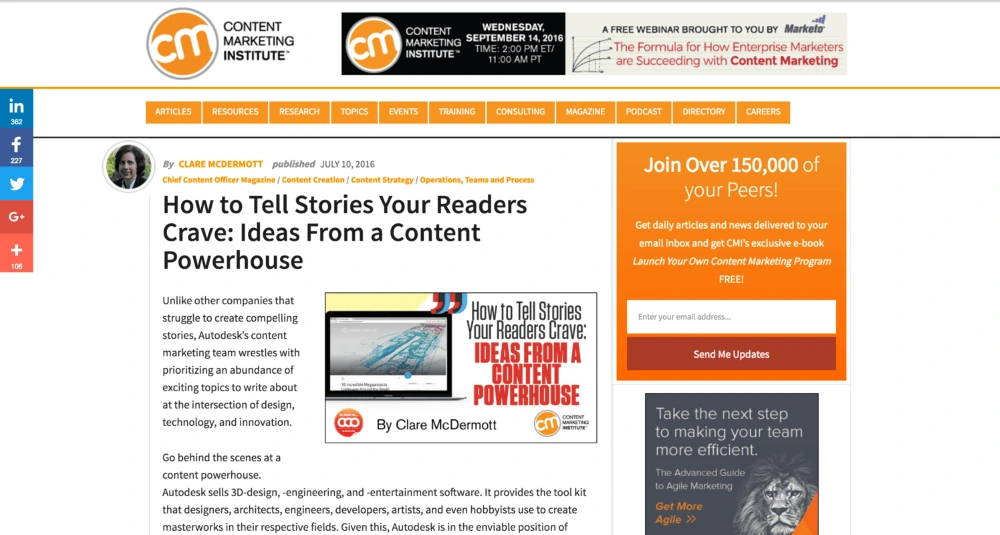
This magazine published by the Content Marketing Institute is uniquely focused on content marketing, a relatively new industry which grew out of SEO. Content is vital to brand messaging, making this publication a valuable read for brand managers.
Recommended first read: How to Tell Stories Your Readers Crave: Ideas From a Content Powerhouse
In this article, CCO editor Clare McDermott takes us behind the scenes at Autodesk, a 3D design & engineering company that took content marketing to heart and launched a highly successful content program which bolstered its brand.
Subscribe: http://contentmarketinginstitute.com/chief-content-officer/
What do you think? Will you be adding any of these to your must-read list, and are there important titles we’ve missed? Feel free to share your favorites in the comments section below.
First it was smartphones, quickly followed by tablets and now smartwatches. The move towards mobile devices is quickening, and marketers are following suit. In 2016, they spent $101 billion on mobile internet ads worldwide, $40 billion in the U.S. alone. From 2013 to 2019, there will be an estimated tenfold increase in mobile advertising spending.
Related: 10 digital trends that are transforming marketing in 2018
So how can your brand benefit from mobile spending? And how can you make sure that your mobile customers keep coming back?
Here are some ways marketers are using mobile to increase brand loyalty and cash in on mobile success.
Mobile pay creates loyal customers
No, mobile pay is not the leading form of payment. Not yet. But things are heading in that direction. In 2014, mobile pay accounted for $4 billion of in-store purchases. By 2019, it’s expected to increase to $34 billion. Though still lagging way behind plastic with only 13% of smartphone owners having used it to make a purchase, that number will rise. Especially since marketers for companies such as Android and Samsung are starting to offer incentives like loyalty cards for customers who use their mobile pay platforms.
Retailers like Starbucks and Dunkin’ Donuts offer mobile pay through their apps and reward customers who use it. The Starbucks mobile pay program via its app has been so successful that over 21% of all U.S. Starbucks store purchases come from it. There’s an expectation that in a few short years, the app payments will account for 50% of business.
Richard Crone, CEO of mobile-strategy company Crone Consulting LLC said the Starbucks mobile pay app was “the most successful launch of a new payment type in history.” Marketers, take note.
You can improve customer targeting with mobile ads
Mobile is on the cutting edge of marketing technology. Where else can you seamlessly integrate geofencing, purchase preferences and history, and social media interaction with your brand? Mobile lets you isolate essential customer information to offer the most personalized and targeted marketing in history.
Mark Ghermezian of Appboy says about the future of mobile marketing:
“Brands must understand how to strategically connect with customers on a personal basis and encourage engagement, based on customer behavior, to transform them into long-lasting users. Mobile marketing automation will allow companies to collect and use data in a more actionable way and deliver personalized and timely messages to their customers.”
Companies who effectively harness mobile tools create stronger relationships with their customers by anticipating their needs, stimulating their desires, and rewarding them with exclusive offers and promotions.
Customers like to shop on mobile devices
Consumers interact with brands through their smartphones in a number of ways. They look up brick-and-mortar store locations, search for coupons and make purchases. Anna Bager, senior vice president of mobile and video at the IAB (Interactive Advertising Bureau) says:
“Pressing the ‘buy’ button on mobile devices is now a regular occurrence the world over. […] Marketers and media agencies need to fully embrace smartphones and tablets as a critical pathway for all shopping activities and increase investment if they want to build meaningful relationships with mobile consumers, driving them from discovery to purchase.”
The fact is that customers like to shop on their mobiles. In a study involving mobile users in 19 different countries, 80% said they had a positive experience with mobile shopping. Also, consumers engage more proactively with mobile apps than with traditional forms of advertising. The ability to take advantage of deals and shop at their own convenience are key factors in mobile shopping’s popularity.
Mobile apps increase your brand frequency
Mobile apps not only incorporate all of the above principals, but they also effectively increase a customer’s exposure to your brand. Americans spend on average 4.7 hours a day looking at their smartphones. Factoring in sleep, that means that people are spending about a third of their day on mobile. If your brand is on their device, they’re being exposed to it constantly.
The marketing term “effective frequency” suggests that the more frequently a consumer is exposed to your brand, the higher their intent to purchase becomes. When you adopt a mobile marketing strategy, you’re exponentially increasing your brand’s visibility.
Dick Stroud, Managing Director at 20plus30 said it best when he remarked, “At the birth of the web, companies aimed to get their website bookmarked. Marketers should be in a race to get their apps on the home screen of consumers’ smart devices.”
Ignoring mobile is a big risk.
As the trend towards personalization and targeting through mobile increases, customers are changing their expectations of interactions with brands. 54% of consumers say that a poor mobile app experience would make it less likely for them to patronize that business again, and 27% of consumers say that it would give them a negative view of the brand’s products.
Marketers ignore the mobile trend at their peril. It was estimated that the UK retail industry loses a potential 6.6 billion GBP due to lack of investment in mobile. Jamie Turner of 60SecondMarketer warns: “If you’re not using mobile marketing to attract new customers to your business, don’t worry—your competitors are already using it and are getting those customers instead.”
An investment in mobile marketing is an investment in brand loyalty. Even fringe technologies like mobile pay are on the rise and some early adopters have already seen great success in using it to increase customer loyalty. Your mobile presence has a great deal to do with consumer perception of your brand. Bottom line: use mobile or lose customers.
Physics is to Albert Einstein as branding is to David Brier.
A walking, talking brand himself, David Brier graced our screens three weeks ago for a webinar that divulged the 19 questions every organization should ask before rebranding.
I have to admit, I expected all the cliché questions: Who is our audience? What is our core strength? Yadda, yadda, yadda. But David proved he isn’t a world-renowned rebrand expert for simply stating what I already learned in Marketing 101… he’s world-renowned for asking the kind of questions that require intense (organizational) introspection. Questions that actually make you think.
Intrigued? Watch the full webinar here and read to follow along.
David Brier’s draw can probably be attributed to his three decades of branding experience, but on a personal note, I think the bold, in-your-face personality may have a little something to do with it too. Case in point? “I’ve been compared to a triple-shot espresso.”
His words, not mine!
Now… sit back, relax, and let me take you on a journey through David’s mega-marketing mind as I summarize some of the insights we learned during his webinar. And remember, you can always just watch the recorded webinar in full if you’d rather hear it straight from him.
Why do companies rebrand?
Here’s a shocking fact:
For some reason, we as marketers can forget this minor detail. Entire populations who were once our brand loyalists don’t stay that way forever. They’re replaced by an entirely new generation of new human beings with new opinions and needs. Which means you need new messaging.
In David’s words: “With today’s technology, these changes are happening faster than ever. To stay relevant, sometimes the correct strategy is a rebrand.”
So we embrace the fact that the world constantly changes, we stay relevant, and we resonate with the new generations as they come. Easy, right?
Well, as David points out, companies repeatedly struggle to pull off an effective rebrand.
It’s that wall. No matter how hard you market and how targeted your campaigns are, there still seems to be a disconnect between you and potential customers.
The problem? Clichés.
David explained how certain phrases like “state of the art,” “knowledgable staff,” and “caring customer service” (who talks like that, anyway?) can alienate companies from their audience and be too predictable to hold interest.
More importantly, clichés distract from good branding.
Branding the right way
According to David, the definition of good branding is good differentiating. No surprise there, right? Stand out from the competition and potential customers will notice you more. As David reminds us: “Differentiating is not a luxury. You differentiate if you want to survive.”
You differentiate if you want to survive.
Now that’s a bold statement.
He’s got a point, though. The great thing about David is that he doesn’t make a bold statement without something to back it up. In this case, that something is a slew of real-world examples. Real brands that had real problems until he swooped in and differentiated the heck out of them. I’ll let you discover the intriguing before-and-after brand transformations when you watch webinar in full.
The 19 rebranding questions
The stage has been set. We understand why companies rebrand, what branding is, and why it matters. Now for the hard part—how to actually go through with a rebrand.
It’s about time we dive into the 19 questions, isn’t it?
I’ll cover the first five questions here. If you want the remaining 14, I’ll let you watch David reveal the rest himself.
Rebranding question #1: Why are we doing a rebrand?
Seems like an obvious question, but as David points out, many companies make the mistake of rebranding simply to rebrand—to be “prettier” and to change things up. But rebranding is not worth the time and money if it doesn’t revolve around strategy and relevancy.
Rebranding question #2: What problem are we attempting to solve?
Does your packaging get lost on the shelf? Is your product not valuable to customers once they get it? Figure out the problem you are trying to solve, and let rebranding help fix that problem. If you don’t have a clear objective to your rebrand, rebranding really won’t do you much good.
Rebranding question #3: Has there been a change in the competitive landscape that is impacting your growth potential?
As much as we’d like to think our brand isn’t impacted by the decisions of other brands, it is. No brand exists as an island. You always have to be watching the landscape around you, and be nimble and fluid in response.
Rebranding question #4: Has our customer profile changed?
Yesterday’s innovation becomes today’s normal, and new innovations can drastically change our customer profile. Don’t blindly base your strategy on information that could have been relevant for your audience five years ago but has no place in your brand today.
Rebranding question #5: Are we pigeonholed as something that we (and our customers) have outgrown?
Many times, businesses evolve as they grow. They start out with a certain focus, then shift that focus as time goes on. For example, a 25-year-old dance institution that still used a ballet dancer in their logo admitted to David that ballet now accounted for only 15% of their training. It’s a prime example of a brand pigeonholing themselves by not keeping up with their own evolution and growth in their branding.
As for the last 14 questions, they really are worth reviewing. David’s tips are chock-full of insights that get you to fight for your rebranding strategy—to really have a reason for how and why you’re doing it. A true rebrand should be hard—it should challenge your fundamental beliefs about your organization and spark new ideas of how to better hone in on the core value it provides.
Thinking about a rebrand? If it’s time for a brand intervention, you won’t want to miss our webinar with branding expert David Brier.
Your brand is your promise, and it’s important that you build it thoughtfully and deliberately. A brand has never been successfully established by simply uploading a good-looking logo and writing a few lines on social platforms. To create a real identity, brands have to invest a lot of time and effort. There’s research to be done, competitors to be identified, and expert professionals to be consulted. Every business should learn what branding is and why it’s needed. Whether you’re starting a new business or have already established one, mistakes are unavoidable. However, here are 7 mistakes brands make that you’d be wise to avoid.
Brand management is evolving rapidly. Are you prepared? Learn more in our free eBook.
1. Failure to research the competition
This is especially important if you are a new business. Researching the competition helps you understand what established businesses in your industry have done: where they have failed, where they have succeeded and where you can give your brand an advantage. Your research should include products, services, target audiences, websites and social platforms. If you don’t, this could trip you up in two ways: first, being unable to judge the competition properly and second, replicating a competitor’s strategies without truly understanding them.
2. Failure to understand your target audience
Before you start selling or even pitching, you’ve got to understand what kind of audience you’re speaking to. You should understand their demands, their expectations, the things they identify with and the kinds of brands they favor. Once you do find your target audience, branding and messaging will get a lot easier.
3. Taking feedback from the wrong sources
Depending on the type of product or service you’re looking to sell and the market you want to cover, you’ll need to take feedback from the right sources. Limiting your sources to positive reviews won’t help you set or measure appropriate goals. Friends, family members, employees and relatives might give you positive reviews no matter what, so think before accepting reviews from them. For any modern brand, the best platform for reviews includes both social media and review sites.
4. It’s not just about logo redesign
As already stated, branding’s not just about a logo or a tagline. Branding constitutes everything that you represent—even your company’s voice and the style of content you create. You will find an audience when you have a competitive advantage and a distinct style. Without that, there’s no value!
Some companies rebrand and spend thousands of dollars on logo redesign but not enough on other brand assets. For example, an online fashion brand can’t boost sales by just changing its logo design. To build a profitable e-commerce brand, it should focus on its customer care team, product quality, advertising (both online and offline), competitive pricing, and many other factors.

Here’s a real-world example. When Marissa Mayer became Yahoo’s CEO, she decided to change the logo of the company. It made for big hype among the users, marketers, bloggers and everyone else. But when Yahoo finally unveiled its new logo, all expectations were crushed. It wasn’t terrible… but it wasn’t exciting, either. It turned out to be just a minor change that didn’t bring any significant growth to the Yahoo brand.
5. Inconsistency
Brand consistency has a tremendous impact on your business. Consistency helps build familiarity, loyalty and eventually, credibility. Be consistent with your promotions, personality, communication and every other interaction you make with your audience.

For example, Coca-Cola might just be the most consistent brand in history. Its logo has hardly changed in 130 years. Everyone recognizes its fun-in-the-sun summer campaigns and heartwarming Christmas campaigns. The brand has built such loyalty that no other soda can beat it—even when Pepsi famously won blind taste tests with consumers. Now in the digital age, Coca-Cola has built a huge audience of followers on social media, so it’s quite easy to reach its target audience wherever they may be.
6. Not focusing on first impressions
A brand with clunky design is a brand that will go unnoticed. You could have an amazing product, great messaging and outstanding customer service, but without a visually appealing presentation, people may never pay attention.
Some larger companies that gained popularity before the internet still get away with bad design, but any brand created after the mid-2000s should know better. A modern, user-friendly design will build your brand’s credibility and bolster its overall appeal.
The fix: You don’t get a second chance at a first impression, so if your brand’s design or website needs a facelift, make it a priority. There are plenty of business resources out there to help direct your efforts, as well as tools like Lucidpress that can make visual design easy and effective.
Poor customer service
Whether you realize it or not, poor customer service can be a huge detriment to your brand. People are more likely to talk about their experience with a product if the experience was negative, which is why the customer experience should be your brand’s No. 1 priority.
United Airlines had a rocky time for customer service last year, for instance, as a video of a passenger being dragged off a flight went viral in April 2017. Adding insult to injury, the CEO’s delayed response felt cold and unapologetic. These incidents caused United’s stock to drop drastically and skewed the country’s perception of this brand altogether.
The fix: Apply the tried-and-true saying: “The customer is always right.” You need to meet your users where they are, even if you have to go out of your way to do it. Examples of brands with exceptional customer service include Costco, Marriott and JetBlue. Companies that offer satisfaction guarantees, provide incentives and make up for mishaps build a strong loyal customer base.
Misusing (or not using) social media
Neglecting social media is another way to hurt your brand and diminish customer satisfaction.
A lot of social media fails simply stem from good intentions, like when Cinnabon attempted to honor Carrie Fisher with a tacky image or when Crocs tried to tribute David Bowie—both insensitivity issues that were magnified by their wide social media reach.
Other times, brands simply fail to invest enough time and money into social media efforts at all. Keeping up with various social sites shows consumers that you care about them, especially when you’re able to reply to questions and complaints promptly.
The fix: Devote actual time and resources to building a social media strategy. If you’re looking for a brand to follow, Wendy’s is a great example of social media use. With almost 2.5 million followers on Twitter, more than 8.5 million likes on Facebook and over 700,000 followers on Instagram, the brand has a consistent image, posts often and interacts with its fan base. The company’s social media team also keeps up with current events and pop culture—a great way to engage with followers.
7. Not having a Plan B
There are many businesses that think a brand is something you establish and then it takes care of itself. Today, that’s completely untrue. You should constantly refine and revise your offerings to deliver better quality and adapt to the changing needs of the market. Not all branding strategies will work the first time. In those instances, you need to be ready with a second plan to ensure that recovery is immediate.
One of the most visible examples of a brand refusing to adapt to change is Blockbuster. In 2000, Netflix’s founder approached Blockbuster offering to sell his relatively small company that rented movies online through a mail subscription service. As the popular movie store was making most of its revenue through late fees, Blockbuster turned Netflix down, unable to see the potential.
Today, Netflix continues to be a model for adapting to change as it has transitioned from mail-order DVDs to streaming, and the brand now produces hundreds of original shows and movies. Meanwhile, Blockbuster is survived by just a handful of stores in Alaska.
The fix: Listen to your consumer base. When they push for greater convenience or more options, adjust your strategy to give them what they’re asking for. If you don’t, another brand surely will. [ ]
8. Insensitivity
Insensitivity in branding is a major issue. Companies make headlines all the time for creating well-meaning ads that turn into PR nightmares. Take the Kendall Jenner Pepsi commercial debacle of 2017. Rather than striking a chord of solidarity, it left viewers either laughing at the poor execution or feeling angry at the commodification of the Black Lives Matter movement.
Another prime example of insensitivity is the Filet-o-Fish ad from McDonald’s in the U.K. The spot featured a boy asking his mom about his deceased father, only to find out the one thing they had in common was their affinity for McDonald’s. Using such a grave subject to sell fish sandwiches felt emotionally manipulative to many consumers, and the company took down the ad shortly after the backlash.
The fix: Before delving into any controversial or sensitive topics, consider how your brand fits into the issue. An honest attempt at sparking emotion in viewers can quickly turn into exploitation. Learn where to draw the line.
9. Selling the “what” instead of the “why”
A common mistake in branding is selling your company’s features rather than a big idea. As Simon Sinek says, “People don’t buy what you do; people buy why you do it.”
Sinek references TiVo as an example of a company that led with its features—being able to pause and rewind live TV—and failed to really capture its users’ attention.
On the other hand, Apple is one of the most successful brands because the company sold a big idea by telling the world to “think different” about computers. It sold a mindset and lifestyle instead of some technical specifications.
The fix: Find something you believe in, focus on that value, and build your brand around it. Coke sells happiness in a bottle. Nike sells motivation. Rather than focusing on dry, explanatory messaging, your brand should have a nearly tangible energy.
Managing a brand is not an easy thing. But you must always understand that your business is more than just its products and services. Success depends on the way you shape the experience of your customers. This is what defines your brand identity. Once you’ve established trust in your brand, you’ll never want to look back.
Building a brand is easy to do. Building a strong, sucessful brand that stands the test of time, people, and competitors? Now that’s a different story. Here is an 8-step guide to building a brand development strategy.
Your brand comprises essential elements like positioning, personality, logo design, color scheme, tagline, etc.
All components are crucial to thoughtfully building your brand to stand against competitors and win.
Related: The 7 key elements of brand identity design
It can feel overwhelming but before you start to panic about the sustainability of your small business and your brand equity, keep in mind that developing a lasting brand strategy is within reach, you just have to know the right formula. Read on to learn how to develop a strong brand strategy
Brand building is the process of shaping customers’ emotions, feelings, memories, and opinions associated with your brand through a strategy-driven plan that stands the test of time and people.
Brand Development Process and Strategies:
Step 1: Establish what your brand represents, at its core.
Create a list of your business’s core strengths. Why was the business started to begin with? What problem did the founder (you?) set out to solve?
One great way to succinctly summarize your brand’s purpose is to create a mission statement. Airbnb for example does a great job of providing a mission statement that clearly defines values, benefits, and quality all at once.
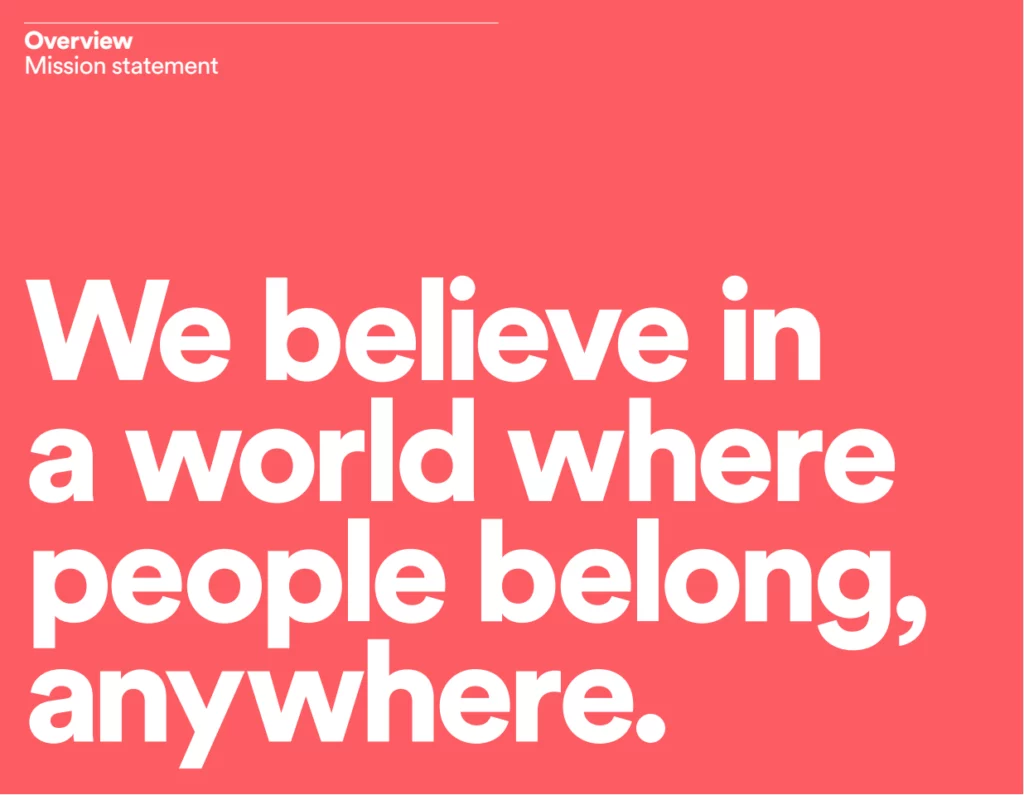
Your mission statement doesn’t even have to be displayed to the public for it to be impactful. Using one as an internal guiding light can still provide the vision and inspiration your employees need to know exactly what the company stands for and how their work should reflect that on a daily basis.
Step 2: Keep your brand distinct from its competitors.
Is it possible to sell the exact same product as competitors but still differentiate somehow? Yes. And companies do it all the time.

In the endless Apple vs. Android wars, the brands continue to differentiate themselves through strong branding, campaign messaging, and product offerings. You know them and you are likely very familiar with the ongoing competition.
The secret to competitive marketing is in your brand. It’s not just your product; it’s how you position your brand personality compared to everyone else.
Take a deep look at the competitive field, find out how others are marketing their successful brands, then throw it all out the window and get creative.
Step 3: Determine your target audience.
As good as your intentions may be, your business simply can’t be everything to everyone.
Don’t be afraid to get specific and think about exactly the kind of person that would most benefit from your product or service. The more specific, the easier it is to target them with messaging that resonates.
It may be tempting to skip this part of the process (or to continue ignoring it if your business already seems to be doing well), but brand building is about building for the long term, and the more generic your targeting is… the more generic your brand becomes down the road.
Step 4: Create an elevator pitch.
At Marq, we have messaging that answers what we are, what we do, and the problems we solve for.
Here is an example:
For marketing and brand leaders who need to drive business growth, Marq is the brand-templating platform that enables businesses to deliver relevant content to their audience faster, by empowering everyone in the organization to build on-brand content.
Unlike desktop publishing software or design tools built for individuals, Marq is built for enterprise readiness with lockable brand templates, creative automation, and highly customizable team management.Marq Messaging
The value in having a well-thought-out statement that everyone can access, which quickly explains exactly what we do, enables everyone to clearly understand our brand positioning.
Step 5: Build out your brand.
Now that you’ve determined the foundation of your brand and what it stands for, it’s time to put everything into action. That means creating a style guide, determining your brand personality, formulating your brand’s strategy, and making sure everyone is on the same page.
Food for thought: Broadway productions don’t tell great stories by simply creating ravishing brochures, and businesses don’t tell great stories by simply designing clever logos.
Your brand is the feeling your ads evoke, the kind of people you hire, the friendliness of your support team, your brand’s voice, your brand’s visuals, your business’s values… your brand is everything your business produces and represents. Make this step of the brand building process priority from the beginning and your brand will have the life and depth it needs to strengthen your business’s image.
Step 6: Promote away.
This is the fun part. We all know what promotion means, but the right promotion can mean different things for different businesses. So whether it’s social media, radio ads, magazine covers, YouTube videos, billboards, PPC, content marketing, or guerrilla marketing — figure out where your target market already is and then go to them. A whole article could be dedicated to this subject, but for now just make note that this step is important for raising brand awareness, and you should dedicate a lot of time to it.
Step 7: Personalize, personalize, personalize.
As much as you can, at least. It’s 2023 and consumers expect their products and businesses to get smarter about how they speak to them. That means understanding your target audience’s pain points, getting on social media, using their first name in emails, etc. are examples of content personalization. Robotic language, over-enthusiasm, and baby talking are looked down on and feel inauthentic. So get real, and find out the tone of voice your customers most appreciate.
Step 8: Consistency is key.
You can build a brand for the books, but it’s not going to last long if you don’t figure out a way to guarantee it stays consistent. What happens when Sandra from Sales stretches your logo? Or Evan from Events changes the color scheme on a branded flyer to orange and pink?
Zillions (to be exact) of brand managers face these harrowing situations every day and watch their strategically-built brands fall apart in the hands of well-intentioned employees.
One of the best ways to protect your brand from rogue content and inconsistencies is with web-based lockable templates. That way, beautiful branded content can start with your graphic designers and still look just as beautifully on-brand by the time it reaches your customers.
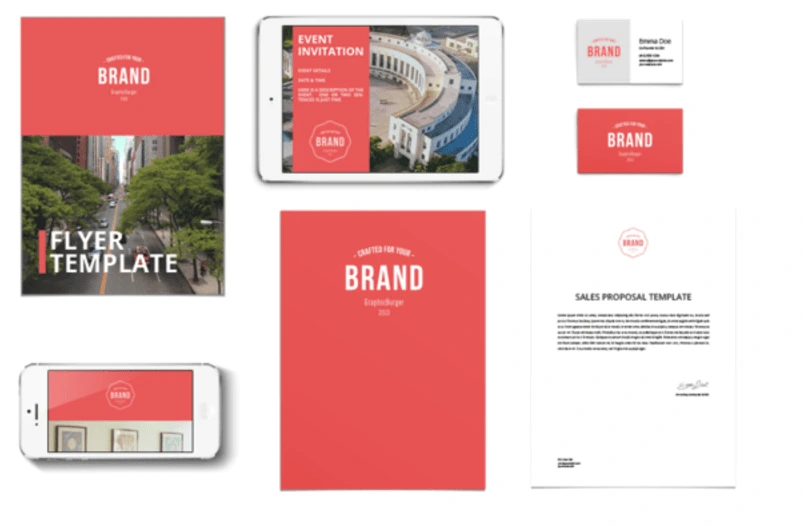
Your graphic designers can lock down the elements of your brand that should never be changed (logo, fonts, images, etc.) before sending the template off to other employees in the company to put to use. Pretty enticing, right? Saying goodbye to brand inconsistencies forever is one massive sigh of relief for brand managers, and anyone who cares about properly building your brand equity, for that matter.
If brand consistency is something your business could stand to improve as part of your brand management strategy, consider trying Marq. With Marq, you can import your business-branded templates (or create them directly in Marq), and share them across teams. Lockdown critical brand elements and no longer worry about content being produced that is off-brand.
Want to know more about how to build your brand? Schedule a 1:1 with one of our brand-templating experts. Say goodbye to rogue content and hello to brand consistency.
Branding your office can have a positive impact both on employees and on clients who visit, so it is well worth the time and effort to do it right. Yet, many businesses fail to do so, leaving their employees to work in uninspiring office buildings. Here, we present five office design tips to ensure your brand stands out.
Related: How to use print materials in the age of paperless offices

1. Define your brand values
Prior to starting any office interior design work, it is important that you and your design team establish exactly what your brand values are. In addition to obvious things like logos, slogans, color schemes and trademarks, you need to think of your business as having its own personality.
Ask yourself how your business helps people and what associations you would like customers to draw. One of the best ways to truly get to the core of your brand identity is to ask those working on the project to think of five words that describe your business and five words that describe your customers.
2. Differentiate between staff and client spaces
When planning your office design, it’s important to differentiate between client spaces and staff-only spaces. After all, employees and clients will likely view your business differently—and you may actually want them to do so.
Your staff can sometimes see through the branding that is aimed at customers, because they witness the everyday realities of the business. During the design phase, try to come up with appropriate branding ideas for the two different types of office spaces, so that you send the right messages.

3. Focus on key touchpoints
Office branding can be a balancing act, and it is certainly possible to overdo it. One of the best tips for getting the balance right is to focus on the areas where your branding will have the biggest impact.
An obvious client touchpoint is the reception area, so this should be branded to clearly state who you are and what you do. However, you should also identify what the most important employee areas are in your office and consider which behaviors you want to encourage or discourage there.
4. Include your products
Depending on the nature of your brand, one of the most effective office interior design techniques you could employ is to showcase your own products. After all, nothing tells the story of your brand quite like your products do.
“If you’re a company with a great product, then think about how you can bring this to the fore,” says Peter Ames, writing for Office Genie. “For example, John West’s Liverpool HQ has its testing kitchen as a central hub. What better way for a food company to demonstrate what it’s all about?”
5. Pay attention to color schemes
Last, but by no means least, you need to think carefully about the color scheme you use in your office and consider how it relates to your brand. Assuming the colors associated with your brand are not too outlandish, it may be appropriate to use them to decorate your office.
Alternatively, if using company colors would be too distracting, consider the nature of your business and decorate accordingly. If your staff works under high pressure, you probably don’t want to worsen this by using intense colors. At the same time, if creativity is at the heart of your brand, plain white walls will not suffice.

I’ve been writing page titles incorrectly my entire career.
Google has provided best practices for constructing page titles, including:
- Describe the content on the page.
- Create unique title tags for each page.
- Use brief but descriptive titles.
These are all great practices to follow on every page of your site. But I’ve recently learned that there’s something else just as important as the best practices Google provides:
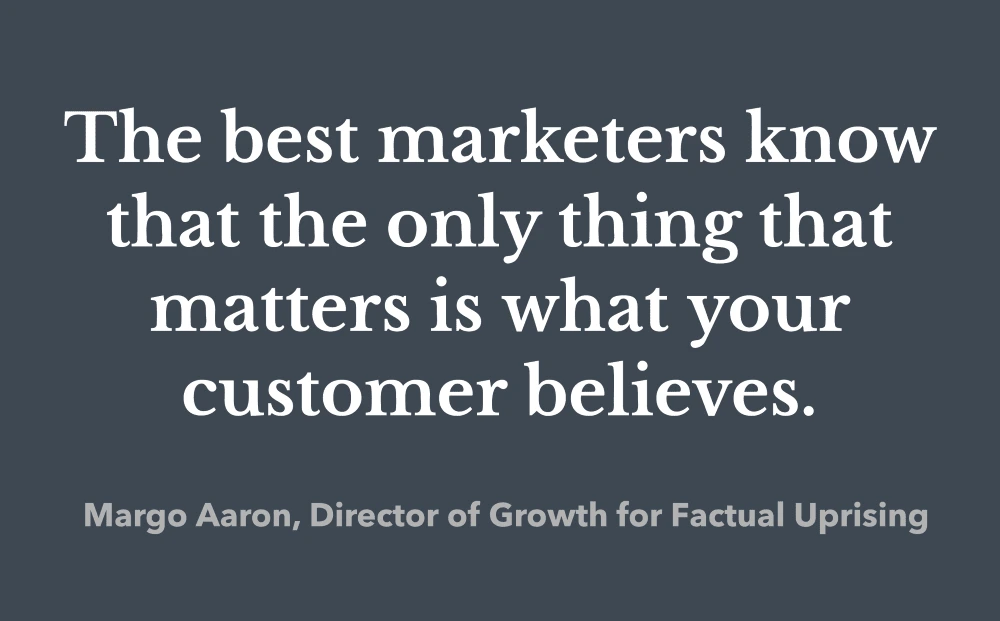
Don’t just optimize titles. Optimize thought sequences.
Your page title serves three primary purposes:
- To provide searchers with a description of your page.
- To provide Google with information that helps it determine how relevant your page is to a search query.
- To provide messaging to searchers that drives them to click on your result.
Succeeding in this final purpose will determine whether your pages achieve click-through rates that outperform average rates in Google. With page titles, I found an easy technique for presenting the right messaging to searchers: brand positioning.
Related: 8 best practices of high-converting websites
Why brand positioning?
Phillip Kotler, Professor of International Marketing at Northwestern University, defines brand positioning as “the art of designing the company’s offering and image to occupy a distinctive place in the target market’s mind.”
Occupying a space in the searcher’s mind is how you compel them to click on your result instead of your competitors’.
A case study
Here’s an example from a page on our site targeting the keyword “ebook templates.”
The original title for our eBook templates page was the following:
Free eBook Templates & Examples | Lucidpress
This title follows Google’s best practices: it accurately describes the page, it’s unique, and it’s brief but descriptive.
It also meets the first two purposes of a page title: it provides searchers with a description of the page, and it provides Google with information to determine how relevant your page is to a search query.
What it lacked was messaging that compelled searchers to click on our link. Nothing in the original title helped “occupy a distinctive place in the target market’s mind.”
Our hypothesis was this: If we could help searchers imagine how our eBook templates would help them grow their brands, then we’d be able to compel them to click on our result over the others.
Keeping this brand positioning in mind, here’s the new title:
Free eBook Templates & Examples to Help Build Your Brand
The result: a 118% increase in the click-through rate for the keyword “ebook templates.”
Incorporate brand positioning into your page titles
To incorporate brand positioning into your page titles, I’ve found it helpful to create a brand positioning statement for each page:
Our [subject] page helps [the audience] [achieve a result] so they can [benefit].
In the example for our eBook template page, here’s the statement we came up with:
Our eBook templates page helps small business owners position themselves as an authority so they can grow their brands.
Bonus: The power of branding
According to Marty Neumeier, author of The Brand Gap: How to Bridge the Distance Between Business Strategy and Design: “Brand will become the most powerful strategic tool since the spreadsheet.”
Data from a study we conducted at Lucidpress with the global marketing research & advisory firm Demand Metric seems to back up this statement.
In this study, we found that the average revenue increase attributed to having a consistent brand is 23%.
[Click here to view our full report on how brand consistency can help drive your company’s growth.]
We also found that brands with consistent presentation are 3-4 times more likely to enjoy excellent brand visibility than inconsistent ones.
This is the power of branding—the ability to improve organic search performance for your website and drive revenue growth for your organization. Try it on your page titles to see if it holds true for you, too.
Next steps
Ready to create compelling page titles?
- Create brand positioning statements for your high-priority pages.
- Incorporate your positioning statements into your titles.
- Track changes in click-through rates and rankings using Google’s Search Console.
Feel free to leave a comment below and tell us how it went.
Learn more about how brand consistency impacts your business in our free report.
Whether you’re a recently funded startup or a business that has been operating for years, building brand awareness will always be a top priority.
According to one recent study, 89% of B2B manufacturing marketers said increasing brand awareness was a primary goal for their content marketing tactics—edging out both sales and lead generation.
In startup marketing, in particular, brand awareness is everything. Think about it from the perspective of your reputation: you’re the new kid on the block, entering a crowded marketplace and trying to serve an audience with increasingly fractured attention.
You’ve got to do anything you can to stand out, and marketing is the best way to do it. But in addition to carving out a space in your industry, building brand awareness also brings an additional benefit: anticipation.
People won’t just take your word for it and immediately buy your product or service. They need to be convinced. If you can make them legitimately excited for the idea—if you can start before your product is even released and get them to mark “launch day” on their calendars—you’ll come out all the better for it.
Your brand’s image is long-lasting
Simply put, your brand is your promise. There’s a reason why studies estimate that 45% of a brand’s image can be attributed to not just what it says, but how it chooses to say it.
For a startup, creating an awareness campaign that both a) lets people know you’re coming and b) tells them what you plan to do when you get there checks the boxes of “brand awareness” and “anticipation” at the exact same time.
Remember that your brand is going to outlive whatever your initial offering is. You’re not just trying to sell today’s idea; you’re trying to sell tomorrow’s, too. You need people to stay with you long after they’ve made their first sale, which is why the “brand awareness” side of the coin is so important.
Anticipation builds momentum
To say you’ll be strapped for cash as a startup is quite an understatement. You’re living in a world where every cent counts.
Even so, people are going to need time to discover your product or service. If you wait until launch day to begin this process, you might get where you need to be eventually—but it’s going to take a lot longer. Momentum doesn’t just happen; it needs to build. If you time things right, you can make sure you hit your crescendo on launch day (or as close to it as possible).
Focus on creating visual marketing collateral that doesn’t just “engage” people but actually gets them excited. Build presentations and other visual collateral that contrasts their life before your brand and after it. How will the “after” be better? How will the “after” be easier? These are the questions you need to answer to build excitement.
Think about what you’re trying to do as a Venn diagram. The circle on the left is your product or service. The circle on the right is the daily life of your ideal customer. That space in the middle where the two overlap? That’s the sweet spot you’re trying to fill. If you can find innovative ways to communicate that in the run-up, you’ll make people aware of your brand and get them excited for your launch at the same time.
Guide the court of public opinion
Give your new followers a place where they can discuss what you and they have to say. Whether they’re responding to your launch campaign in a positive or negative way, you need to know what the general response is. Plus, there’s never a better chance to do some course correcting than when you hear feedback straight from the horse’s mouth.
In terms of brand awareness and anticipation, this also creates something of an echo chamber effect. After a certain point, excited customers become brand ambassadors and start spreading your message alongside you. This takes some pressure off your organization while customers do some heavy lifting for you.
Prime your audience
At its core, building brand anticipation is about priming your audience before you launch your business. It’s a strategy with two goals: let people know you exist and tell them how you’re going to change their lives.
Rather than wait until your product/service is absolutely perfect before doing any marketing, you should start thinking (and acting) on this as soon as you can. It’s far better to have a preemptive awareness campaign, even a small one, than to keep everyone in the dark until you’re “ready.”
Why? Because the dirty little secret of entrepreneurship is that you’ll never be ready. Your product or service will never be perfect. To think otherwise is a fool’s errand. Fortune favors those who boldly strike out where others are too scared to try. []
Instead, start building brand awareness as soon as you can. Today. Right now. Don’t just sell the product—sell the benefits your brand will bring. Then by the time your product is ready, your customers will be, too.
A good content marketing strategy should explain why a company is making the marketing decisions that it is. Anyone reading should see why content marketing is being used, why certain decisions are being made, and why the company wants the image it’s pursuing.
Unfortunately, since content marketing varies as widely as the brands using it, myths and legends about how to make it work still abound. With 70% of B2B brands planning to use content marketing next year, these myths will continue to spread into a new generation of marketing campaigns. That is, unless we marketers agree to let these myths go the way of Bigfoot and Nessie.
New to content marketing? Start off on the right foot with Lucidpress.
Myth #1: Trending topics will always work out
Let’s go viral! There’s this idea that the best way to market a brand is by latching onto an outrageous topic which will immediately grab the attention of anyone around. (Oh look, a shiny thing!) While interesting topics are undoubtedly fun, they’re not always a surefire win. Marketing topics should always coincide with the company’s message and values. Remember that trending topics rarely remain so, and one can quickly change from being adored to being annoying. Sigh—crowds can be so fickle. But setting smart goals for your content, whether it’s brand awareness or targeted selling, will help you keep the company’s mission as your North Star.
An example of doing this the right way? Our sister brand Lucidchart created this hilarious video about dogs (erm, that is, “doggos”) that is not only timely Internet humor—it also shows off what you can do with the product. In this case, the topic and the brand fit neatly into the middle of the viral Venn diagram, and the video has been a huge success.
Myth #2: Keywords are the most important factor
One particularly pervasive myth is that marketers should trust keyword data above all—even over the intentions of potential customers as shown by their search queries. In order for keywords to work at their best, they must be focused on the customer’s journey. SEO tools will only get you halfway there. []
Use keyword data to inform your content marketing strategy, not determine it outright. Think about why someone would search for a particular keyword—and what questions they have that aren’t being answered by existing search results. Match individual keywords to the different personas your brand targets so you can speak to the audience who most wants to hear what you have to say. All of this should lead to more interesting, relevant content that’s more valuable than simply writing about a keyword.
Note: Another myth surrounding keywords is that using them removes any creativity from writing altogether. Not only is this pretty lazy thinking—it actively undermines content writing as a means of marketing the business. SEO and content marketing should work together to support one another, and neither should become too dominant in your strategy. This leads us to our next myth…
Myth #3: All storytelling, no selling
Content marketing is a form of marketing (shocking, I know) which uses storytelling to draw in prospects and excite them about your brand, product or service. Around half of marketers admit to focusing more on the creative work than on measuring the results—which means they’re missing an opportunity to bring themselves into closer alignment with the needs currently driving their customers. You can tell great stories all day long, but if your audience isn’t being moved down the funnel, it does very little for your brand’s bottom line.
To an extent, content marketing can be considered a form of brand building. People often remember the content of a marketing campaign more easily and affectionately than they do the products and services on offer. This has contributed to the belief that storytelling is more important than selling, when in reality they should be equal. The content marketing should enhance your brand’s offerings—not the other way around. And speaking of brand building…
Myth #4: Content marketing is separate from brand building
We touched on this briefly in the previous section, but there is a pervading myth that brand building and content marketing are separate disciplines. In today’s world, they intersect. Brand building is accomplished through marketing; the specific nature of content marketing makes it even more useful to growing brands.
Brand building and content marketing are best mixed together because they build trust and good rapport between a brand and its followers, while simultaneously helping the brand become more visible and easily recognized. Combining the two results in consistently well-branded content that contributes to a brand’s image, reputation and conversion funnel.
Myth #5: Your content should only be hosted on your website
Content marketing can cover a variety of mediums and senses. However, many brands miss out on exciting possibilities and partnerships by keeping all of their work on their own sites. Podcasting, vlogging and guest blogging open doors to entirely new audiences who might not have interacted with your brand otherwise. You can even look for new channels to help distribute your content. For example, we’ve had success with a Lucidpress publication on Medium because it plugs us into active reading communities who are interested in our niche.
Key takeaway
Content marketing has become a popular branding strategy, but it’s still shrouded in a variety of myths which make it less successful than it should be. Toss these myths by the wayside and use these tips to connect with loyal brand followers and new audiences.
Ready to get started? See how Lucidpress can streamline your content marketing efforts today.
A friend of mine says she could not help but be swayed by what people were saying about the importance of social media for increasing sales. Some people kept rhapsodizing about how they were able to achieve rocket sales by establishing brand recognition and strengthening their brand’s presence in social networking sites.
So this friend opened an account on Facebook, created a blog, squeezed in a post here and there, and sent out newsletters to introduce her product—and generated no significant increase in sales at all. Why?
Related: 7 serious social media mistakes brands still make
The truth about the use of social networking sites
My own research shows that I should not rely on luck to sell my brand—not even when I use social networking sites. I cannot expect mere presence in social networking sites to work magic and automatically land me great sales.
How can I successfully market my brand in social media? How can I increase customer conversion rate?
I looked into case studies and marketing research. I read up on what the technical marketing experts had to say. Here’s what I found.
Put your brand where your target market is
Alex Chris is an author and Digital Marketing Consultant. He is an expert in Internet Marketing and SEO. He says that based on updated surveys, Facebook dominates the social media scene today. A massive 1.79 billion people actively use the site monthly.
Alex says that you have put your brand where your target market is. With 60% of people on the Internet using Facebook, there is no greater tool to promote your brand, find new customers and gain a loyal following.
He suggests that you create an optimized Facebook page, add friends to your personal Facebook page, and get as many “likes” as you can. He suggests putting a “like” box in your website. You have to put this “like” box in a conspicuous, readily accessible spot.
Create relevant content
Alex and a great number of other marketing specialists, say that it is not enough to create social presence. You have to create high-quality content for your followers. If you are able to do this effectively, you have a greater chance of turning your followers into constant website visitors, and eventually to customers.
Connect with your audience before selling your product
Kristen Matthews is a creative digital strategist. As an influencer marketing consultant, she has worked on a variety of case studies with innovative brands.
A Huggies case study highlights the need to create not just any content, but one that emotionally connects to your target market—even before you push your brand.
Speak, listen & respond to your audience
Brittany Berger heads the Content & PR Division of Mention.com. She says that when you send out newsletters as part of your marketing campaign, you speak directly to your target market.
Make your audience feel that you are listening to them. You create positive vibes when you respond as soon as you can to any queries or points that they want to clarify.
Do not be too promotional
When I create posts, I am representing a vision, specific objectives, and explicit principles. I am also creating awareness and recognition of my business brand.
I am not simply selling. I am informing and educating my audience.
If I become too promotional and focus exclusively on trying to sell my brand, people may see my posts as self-serving. I may lose my audience.
Online entrepreneur, writer, and founder of UpFuel.com Chris Guthrie agrees that you have to find the right blend of marketing and educational values. The right mix provides true value for your customers. It will also give you the opportunity to sell your brand.
Cater to your audience
I have a website on social media. I have a responsibility to my followers. I have to come up with content that has to do with my particular niche. I have to create posts that are engaging and useful to my audience.
If I want to maintain a loyal following, I have to go out of my way to share relevant posts in a variety of interesting ways that include written articles, videos, info graphics, images, and charts.
I want my followers to feel that they are important to me. If I send out e-mail, I have to respond to queries as soon as possible.
If I do not think my content through and create posts that do not offer anything substantial, I may end up hurting my business reputation instead of helping spark brand awareness.
In a nutshell: what to do
- To sell a product or service to people, build a strong social presence.
- Elicit interest. Build trust.
- Provide appealing and relevant content.
- Use storytelling effectively.
- Find out your audience needs and wants. Tell your story based on these.
When you are able to do these, you will be able to generate more traffic to your website. You will be able to create a bigger following. And you will be able to enjoy a higher conversion rate.
Ready to drive more leads with social media? Grab a copy of our free eBook: How to adapt your brand to social media
Building a local brand is tough. Even if your business is in an area with significant foot traffic, developing your brand within the community is critical if you want to be successful in the long term.
Usually, when people talk about branding, they’re often referring to large companies with a proportional budget for their marketing strategies. However, brand building is essential for local businesses, too. It’s what will set you apart from your competitors and determine how your customers perceive you.
Luckily, to develop a local brand, you don’t have to break the bank. Here are five important tips to keep in mind for branding your small business.
Create local partnerships
Team up with other local brands, and make sure that your objectives align or complement each other.
If you’re unsure how to connect with other business owners, you can join local chambers or community service groups to expand your network, especially if you’re just starting out. Then, you can partner up for campaigns that promote each other’s brands.
Another way would be to reach out to local leaders of your community and help them where they are struggling. This gives your brand a social cause and shows that you value giving back to your community.
Simply put, building a trusted brand is much easier when you form connections locally.
Build relationships with the community
Small towns are all about building relationships and trust. If you show that you care about your customers—which you should, since public opinion of your brand can make or break your business—you’re more likely to earn their trust and, even better, their loyalty.
To make this happen, you should actively listen to their feedback, be responsive to messages and inquiries, tackle complaints as fast as possible, and resolve issues. All that is to say: provide excellent customer service.
Leverage social media
These days, if a brand does not have a social media presence, it may as well not even exist. It’s that important. Especially among millennials and the younger generation, social media is a must-have.
It’s also a great tool for promoting your brand to potential customers; let them get to know it, and show different aspects of it. Social media is one of the best ways to interact with your current customers.
You can use social media to show that your brand cares about its community by sharing any local news you think will be of interest to your audience.
Establish a local SEO presence
There’s no getting around it: SEO is one of the most important tools in a brand’s arsenal to generate new leads and develop awareness. Many of the searches people perform on their phones today are location-based—meaning they’re looking for businesses around them to meet their needs in that moment. Your brand should be right there in the search results, waiting to take care of them.
Investing in SEO can effectively build your online search presence and have a monumental ROI for your business. If you do it correctly, this can become a continuous source of new traffic and leads.
Some tips to optimize your website for local search:
- Claim your business page in Google My Business
- Verify your local address with Google
- Make sure your business’s name, address and phone number are consistent across all business directories
Control your online reputation
Online reviews are an important ranking factor in local search. Perhaps more importantly, they influence purchase decisions. Businesses with a low star rating or a low number of online reviews are ofen overlooked by customers. Reviews also provide a valuable source of feedback as the business identifies potential problems and improvements.
Tips for getting more online reviews:
- Send the invite before the customer leaves your business
- Make it ridiculously easy to request a review and to give a review
- Send review invitations via text
Give back
Giving back means different things for different people, but it all depends on what you can do for the community. For example, you can offer to mentor another business owner and show them the ropes, so to speak. Or, you can volunteer for a local program. Lucidpress has a team of volunteers that deliver Meals on Wheels each day to local seniors.
Another idea is sponsoring local events (e.g. farmers markets) or sports teams, which is an effective way of getting your brand exposed to many people in the same area—and building a positive perception of your brand.
Aside from the business benefits, doing good for the community is rewarding in its own way. It feels great to get out of your bubble and do something for others.
Be consistent
I love this quote from former Disney CEO, Michael Eisner:
A brand is a living entity—and it is enriched or undermined cumulatively over time, the product of a thousand small gestures.
Your brand is being shaped every day by the thousand small gestures your customers (or potential customers) are getting from your company. A gesture might be an interaction with one of your employees, a post on your company’s Facebook page, or even a direct mail piece you send out.
If all these things contribute to building your brand, it’s vital to be consistent with each gesture’s message.
So, these are some essential tips to keep in mind if you’re looking to build a local brand. If you follow this list of advice, you’ll be one step closer to making your brand a success.
How to have more consistent local branding:
Tip #1: Establish brand guidelines.
If you don’t yet have brand guidelines, create them. If you do have brand guidelines, revisit them and make sure they are up-to-date.
Tip #2: Make your brand guidelines easy to find.
The issue at most organizations is simply that their brand guidelines are too hard to find. The best brand guidelines are useless if they’re too difficult to find.
Tip #3: Pick the right brand champion.
I’m curious: how would you answer this question? Who in your organization has the PRIMARY responsibility to manage and protect how your brand is used? Initially, I would’ve thought that, for most organizations, the designer or senior creative person has the primary responsibility to manage and protect the company brand. I mean, they’re the ones doing all that “branding stuff” all day, right?
In our survey, CMOs/CEOs won far and away.
If brand consistency is important to your organization (which it should be), primary responsibility for managing and protecting the brand should fall to the CMO or another member of the executive team. When senior management recognizes the importance of managing the brand, it sends a clear message to everyone that the brand is worthy of protection and investment.
Know the differences between local audiences.
This is all about knowing your customers. Once you know your different customer segments, you can understand the differences between them.
For example, if you own a car dealership and have one location in a more affluent neighborhood than your other locations, you might notice that the affluent buyers are looking for something different than the buyers at your other locations. Maybe they want to see cars with leather and sunroofs. Your marketing at this location should highlight these things.
Studies show that the average consumer is exposed to up to 10,000 brand messages a day.
To break through the noise, your brand image should be powerful and to the point, like an elevator pitch—an quick and accurate expression of your key values, unique benefits and mission. Delivering it successfully has never been easy, especially if you work with tech brands, which can often be hard to describe succinctly.
Does this sound scary? Probably. Should that be motivating? Surely!
Related: Tech marketing best practices
So what does a tech company brand consist of? What are the steps tech companies take to create a brand that reflects their values and appeals to their target audience?
We talked to 5 experts—startup founders, marketers and designers—about the answers to these questions and about their own brand-building experiences.
Here are the questions we asked:
- How did you come up with the idea of the logo?
- Why did you choose the colors you’re using now?
- What is the key message you wanted this design to convey?
- What are the general impressions and associations you think users get from the brand?
- What advice would you give to a startup working on their own branding?
- How do the current logo, design and tagline reflect the core values of your company?
Here are the insights they shared.
Markus Pirker, co-founder of Userbrain
Userbrain is a subscription-based tool that helps website owners, designers and developers improve their products by providing first-hand feedback from real users.
Before starting work on our logo, we made sure the whole team was aligned with our core values and beliefs. I don’t think you can create something as important as your brand image starting with the details like color choice—you have to work from inside out to create something authentic.
In the process of fine-tuning our core values, mission and vision, we decided to lead with the promise of effortless, ongoing user testing. This inspired the design and served as a baseline to assess the quality of different logo suggestions.
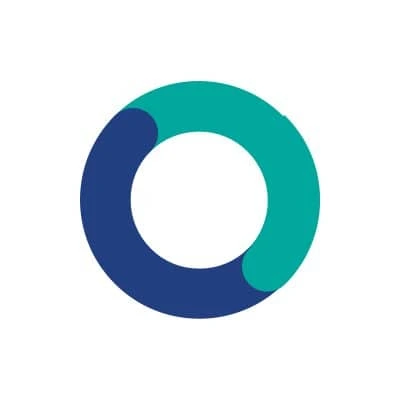
We went through a couple iterations before we decided to go with the current logo. Past suggestions used additional elements, and we tried to narrow everything down to a very simple logo which could be used across different platforms without substantial alterations.
User testing is often regarded as a tool for experts only, which it really isn’t. If you get the basics right, testing your own product with other people will always deliver valuable insights.
There are already several user testing services out there using subtle colors and an enterprise-like look in their branding. As a startup, you always have to fight for attention, so we wanted to stand out by using bright colors.

The Userbrain iOS app icon
We used two different color palettes and paired the main colors of our logo with shiny, vibrant colors like orange and violet.
The vision of Userbrain is to help people build better products by bringing them closer to their users. This is something we wanted to reflect in our logo, with the two circles depicting users and customers blending together.
As in sports, continuity in testing your products is the secret ingredient of user testing. We really wanted to embed the idea of ongoing user testing in our branding.
We ran a couple of user tests on our marketing site to learn more about how people reacted to our branding and service in general.
We had several people mention that it was fun navigating around our site, and they captured the basic idea of our service within a couple of seconds, so I guess we got the basics right here.
However, our branding is always adapting to the new needs—I think that perfect branding is something that evolves over time—you can’t get everything right with the very first version.
Maybe this sounds a little counterproductive, but I’d advise startups not to worry too much too early about their own branding. Startups should focus their early efforts on getting something really minimal yet valuable out in front of people.
This is not meant as an excuse for bad design, but if your product provides value to people and is a clever solution to a real problem they face every day, they will overlook your crappy logo.

The old, quite simple, Userbrain logo
The Userbrain logo has been the word “Userbrain” written in Open sans and uppercase for the first year and a half, and we’ve had customers sign up with no branding at all.
The promise of our service is effortless and ongoing user testing. I think that our team did a great job communicating this idea in a simple yet effective logo.
Tim Sae Koo, CEO at TINT
TINT is a content marketing platform that allows brands to source authentic community content from social media, new and review sites, then integrate it dynamically into any digital channel.

TINT’s logo is a powerful symbol that was designed back in 2012. It represents the connections between brands and their audiences. The intersecting lines resemble customer touchpoints and the circle that surrounds these connections represents our product, implying that these connections are the center of our product.
Warm red is our primary color. It’s meant to signify clearness and power—our brand essence.
The key message is meant to signify that we speak less and say more with design. We use simple and clear design that allows us to speak from the heart. We are direct, consistent, compelling and inviting. We are grateful. We are compassionate.
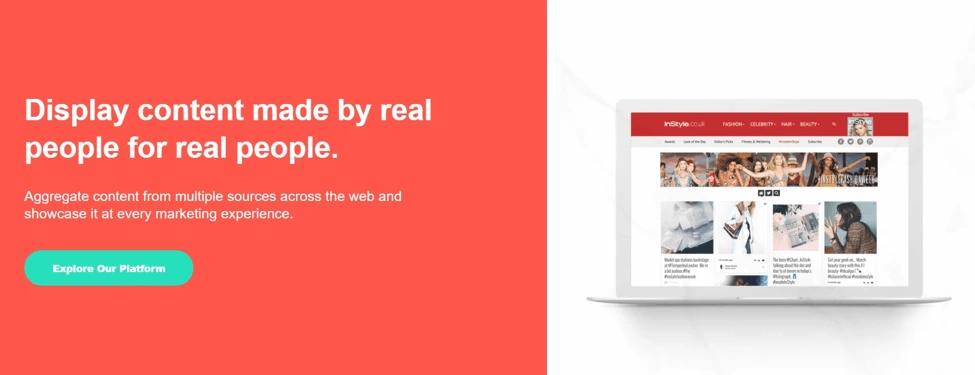
Start with why you started the company, and translate it into a physical manifestation via logo and branding. The logo reflects our personalities, which stood as the baseline for creating our core company values.

Hayley Snow, Marketing Project Manager at ContentCal
ContentCal is a simple tool to create, plan and publish compelling social media content.

Our logo was born from one of ContentCal’s core components: the approval flow UI. This UI consists of multiple dots on an axis, one for each step of the approval flow.
We started playing around with the concept of dots in a line in all different ways, then started to realize the potential in the idea. With some tweaks to its form, the graphic could morph into a line chart, process circle or share icon.
The flexibility of its form won over our team in an internal design critique. We developed the logo further to give it the form of a system, and after multiple iterations, the new ContentCal logo was born.
There are four brand colors used in our logo. The original UI colors in the ContentCal product were blue and “zing blue” (a very bright cyan), so these became two of the four colors used. We then added green and red, which are the ‘approve’ and ‘deny’ action colors within the product. So the logo looks like a system, and the colors are the ones used in that system.
Our logo doesn’t have a strong key message other than for it to represent our core values and to feel at home in the tech startup world.
General feedback has been that the logo works well in its environment, it feels associated with digital technology, which is definitely what we wanted to achieve. We also have great feedback about our logo being used at a large scale—for example, in exhibition spaces.
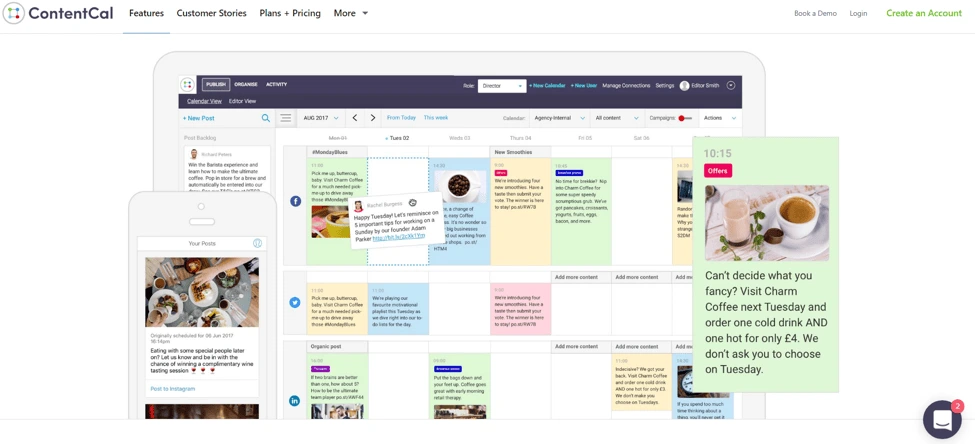
My advice to a young startup would be to stay agile with your branding. Branding in tech startups is predominantly used online now, so there are more opportunities to tweak and adapt over time. I also would suggest not worrying too much about brand guidelines at an early stage. Your company should constantly be adapting and growing, and so should your branding.
We’ve made many incremental improvements to the branding both on our website and in printed documents. It’s always adapting, and I think this is the best approach.
Our core values are Flexible, Dynamic, Together and Consistent. Our whole brand is built around these values. As we grow, staying true to this will become more and more important.
Nick Kamyshan, CEO at Chanty
Chanty is a fast and simple AI-powered business messenger designed to increase team productivity.

The idea was to make a dead simple symbol which clearly shows the letter “C” for Chanty and a dot in the middle to emphasize a human being in the center of information flow.
We decided to go for a high-quality logo and hired top-ten Dribble logo designers. After several months of their work and multiple iterations, our tests showed that none of the logo designs satisfied our target audience. Our founder and product owner was extremely frustrated with the low-quality results and came up with our current logo while on a plane.
We’ve tested a lot of color schemes, and it turned out that the color combination we chose is the most attractive to our target audience. It also has the highest conversion rate. I should highlight, however, that this color scheme is mostly used for marketing resources at Chanty, not for the software product.
Laconic is the exact word to describe the look and feel we’ve worked so hard to achieve. We believe that things should be simple. On top of that, laconic crystal clear designs are easy to remember.
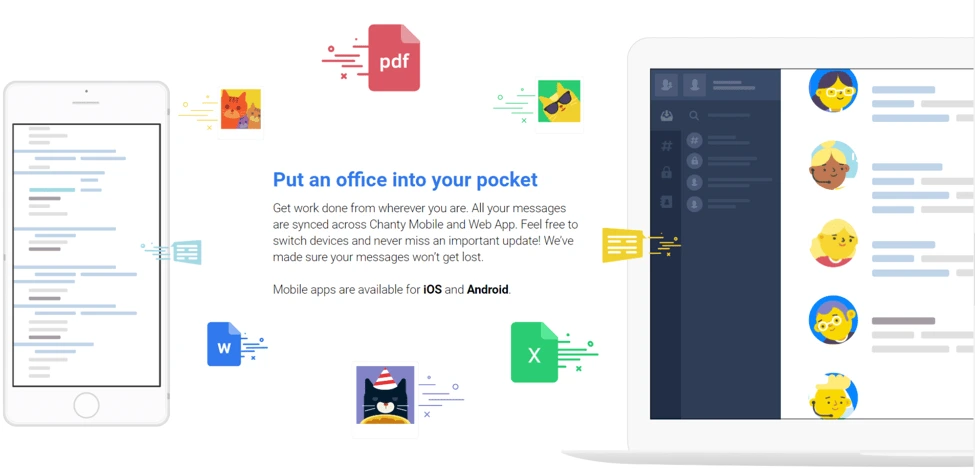
Experiment until you die or succeed. Find out which colors really work for your target audience by constantly testing different color schemes via various marketing channels (e.g. launching ad campaigns in Facebook).
Listen a lot. But don’t listen even more. Make discovery a part of your workflow. The more informed you are, the more confident you become.
Be unique, develop your own style, and go in a different direction than your competitors when it comes to branding.
Ksenia Levoshko, UI/UX Designer at Daxx
Daxx is a nearshore staffing company that helps companies hire talented developers.
Tech company branding is more than just the logo or color scheme on a website. The product or service a company sells is the foundational element upon which all branding is built. As your company’s offerings evolve, so should your branding.
The product I worked on consisted of several parts: a wearable device (bracelet or ring), an app, and a web portal. The wearable collected data on vital signs then transferred it to the app, which sent notifications motivating people to take action and pay attention to their health.
The primary objective of the project was quite ambitious: We needed to inspire users to change their behavior. As it turned out, the strongest motivator was the user’s desire for tangible, positive change and the use of personalized data.
That’s why we made a U-turn from a fear-based approach to a new, engaging one. We made it into a game, where at the beginning you see your current health state and set custom goals.
We used points to track users’ success and implemented badges and stickers as gamification elements. Each badge or sticker marked a small achievement that greatly motivated users and helped maintain their enthusiasm.
If you want to ask your audience about something, you have to give them something first. Early on, we asked our users for personal medical data and gave nothing in return. Now, we clearly explain why it’s necessary and how it’s going to change their lives for the better.
Understanding a user’s motivation is crucial. Once you realize what your users need, you can help change their behavior.
Key takeaways
Tech branding is not limited to logo design and a color scheme. Branding also includes the way a company communicates its values and mission, internal company culture, and customer relationships.
In an age of information overload, companies do their best to communicate brand messages as clearly as possible. This includes visual representation: as we saw, most experts prioritize simplicity—minimizing clutter and leaving only the key, nuclear elements that convey their message. Then, they make sure it’s 100% authentic and reflects their ideas and goals.
The experts also agree that designing brand elements is just the beginning of a long path—finalizing and polishing them requires a lot of experimenting and user testing. The branding process is never really complete. As a business evolves over time, the brand image should stay aligned by adapting to changing market requirements and business needs.
Want to know more about how to build your brand? Download our free ebook on how to build a brand in 2020.
New to content marketing? Start off on the right foot with Lucidpress.
Want to super-charge your brand visibility? The best way is through great content.
Now, hear me out. I know you’ve probably heard the old phrase, “Content is king.” It’s a hackneyed aphorism, but it does give us a reason to chat about how brands use content to get ahead—and how you can follow those same practices to earn more visibility for your brand.
How brands use content to get ahead
- Content marketing: Content marketing is creating content specific to the industry you’re in, without directly promoting your own brand. So if you’re a store selling wooden floors, for instance, you could use your expertise to write and publish articles like “7 creative examples of parquet floors.”
* Thought leadership: Also a form of content marketing, thought leadership goes the extra mile. It aims to take a brand representative and position them as an expert and visionary—someone who shapes the industry and whose words are important. Think of thought leadership as a cross between content marketing and public relations.
* Everything else: From press kits and ads (both traditional & digital) to pamphlets, hoardings, brochures, newsletters and email marketing—content is literally in everything.
The owned, earned & paid tripod
Another way of looking at content is through the trifecta of owned, earned and paid media. In a nutshell, owned media is what you put up on your own digital property or website. This is the first destination for the articles & feature content you generate.
Earned media is what happens when people like what you share, then re-share and re-blog it. Think of it as online word of mouth. Remember all those kitten videos that went viral? That’s earned media.
Paid media is fairly straightforward. It’s when you buy ads or pay to promote content. Google Banner Ads are an example. Most social platforms—like Facebook, Twitter & LinkedIn—have tools where you can pay to promote your content and run ads.
Any cohesive content strategy usually has a mix of all three.
3 super-charging content tips
Now that we’ve described the playing field, let’s delve into a couple of playbook ideas on how to use content to boost brand equity.
1. Decide on a strategy
A single piece of content can’t be all things to all people. Decide whether you’re doing content marketing, authoring a thought leadership piece, or writing a press release for distribution. All these pieces of content have their own styles and best practices—and their own goals and metrics for success.
You also have to decide which types of content you’ll be creating for your campaign. There are many possibilities, and you can repurpose ideas across different content types.
2. Have a distribution plan
Content that just sits there in your owned media isn’t much use. It doesn’t boost your search engine rankings, it doesn’t attract more eyeballs, and it doesn’t increase sales. The trick is to turn that static block of words into a flowing river of shares and likes.
Most marketers have a handy funnel that they push their content through. You can start by posting on your own website. Then, the next step is to share on your social pages. Here, you might decide to give it a boost by paying for extra promotion. A day or so later, start submitting to content aggregators like StumbleUpon. Eventually, re-blog on social blogging sites such as Medium.
By following a planned distribution strategy, you’ll have a far better chance of turning your words into traction-grabbing content.
3. Figure out your audience
So you’ve got your strategy in place, and you know whether content marketing or thought leadership, or both, is the way forward. The next step is to figure out the audience you want to tap, and what they might be interested in. If your audience is composed of silver-haired retirees dreaming of Caribbean cruises, chances are they won’t read a blog about buying their first home. So, pick topics that are relevant, timely and valuable for your audience.
Use these techniques as you build your next content marketing plan, and you’ll have a far better chance of resonating with your audience and reaching your content goals. Make sure that everyone who creates content for your brand understands these concepts. Finally, ensure brand consistency with a tool like Lucidpress, which uses smart lockable templates to keep everyone on-brand.
Ready to get started? See how Lucidpress can streamline your content marketing efforts today.
Some businesses naturally lend themselves to sharp design. Walk down any street in a hip neighborhood and you’ll see fashion boutiques, cafes and gastropubs displaying beautiful branding. Stylish typography, trendy color palettes—the kind of design that creates an enviable brand image.
Related: Building a local brand—5 essential things to know
When it comes to the service brands of the world—your plumbers, HVAC, pest control, any “man-in-a-van” type of business—design and branding are often an afterthought. The service comes first.
After all, there’s nothing cool about getting your drains snaked or having rat traps set up. Service brands don’t cater to a specific set of people the way a bar or boutique does. They sell a skill that everyone needs, not another form of self-expression. Beyond providing the best service possible, it’s hard to find ways to differentiate yourself from all the other service brands out there.
The result? Barebones websites, a lack of stand-out branding, and an endless supply of boring marketing materials. But it doesn’t have to be this way. In fact, investing in some simple branding & design can help your business stand out from the pack.
Why: The market is crowded
Service businesses, particularly in major urban areas, are incredibly competitive. A search for “plumber” on Yelp in Chicago will yield more than 2,000 results. In New York, that same search turns up over 6,000 results. Local plumbing businesses, nationwide franchise networks, and general service companies are all competing for the same work.
In a market that’s so incredibly competitive, you need a way to stand out from the crowd. When you ask a service brand what makes them unique, and how they’re different from competitors, you tend to get answers like “We’re really knowledgeable and honest with our customers.” Which is probably true. For them and just about everyone else.
That’s a great business model, but it doesn’t captivate the imagination. Before you can display your expertise, you have to get someone’s attention—and tradesmen, not being particularly design-focused, often overlook that the path to new revenue starts with awareness.
If your business has a bland website with sparse information, and you’re driving a white van in a city full of service vans, trucks and dispatch cars… how are you standing out? If you’re mailing brochures to potential clients, what saves that brochure from ending up in the trash?
In order to thrive in these competitive markets, you need to capture that initial attention. Marketing alone isn’t enough—you can drive visits to your website all day, and you can mail a flyer to every homeowner in town. On average, you have 8.25 seconds of their attention. Do you really think someone is going to look at a white-and-blue website that says “We’re trustworthy!” for more than 8 seconds?
Probably not. But then, how do you do it?
How: Color, design & user intent
So now, let’s welcome design back into the picture. We need it to capture the attention of potential customers, to stand out from the 2,000 other plumbing businesses in Chicago. But service brands don’t always have graphic designers—or even the budget to hire one. It’s tough to even know where to start.
Color
- A good starting point for service brands is color. Color has the power to influence user behavior. Often, service brands default to black & blues: simple, safe color choices that don’t stand out. That gives you an opportunity to choose something different.
* Color increases brand recognition by 80%. Some of the most notable service brands employ unique colors as part of their brand. Take Mosquito Joe as an example—the fastest-growing service franchise in the United States. Their bold green & yellow branding extends from their trucks to their uniforms. These eye-catching colors no doubt play a huge role in attracting new customers and franchisees.
Design
- Give your colors the chance to shine with some great design. Aim for a professional appearance, from the website to the trucks to the polo shirts your technicians wear. Every piece of your business should align with your branding to give your customers a consistent experience every time.
* This can sound like a daunting task to a non-designer, but it’s definitely achievable with the right tools. For example, Marq was designed with non-designers in mind, so anyone can quickly create attractive, on-brand content. You can create templates (or use pre-made ones) to publish and print- flyers
- brochures
- business cards
- newsletters
- banners
- social media graphics
- and much more.
User intent
- Finally, consider user intent. Who is your customer base, and what do they care about? What information do they need to make a purchase decision?
- Web accessibility: How easy is it to find the information they need on your website?
- Social proof: Do you provide ratings, testimonials, accreditations?
- Call-to-action: What can you say that persuades them to contact you?
When: Right now
It’s easy to put off projects like updating a website, improving flyers or repainting trucks. But, the sooner you can develop strong branding, the better off you’ll be down the road.
For many service businesses, winter represents downtime, which offers the perfect chance to brush up on your design skills and revamp your brand’s image. Imagine starting the next busy season with the right collateral in place to drive more sales. It’s within your grasp, and easier than you think.
See how Marq makes it easy to create attractive, professional marketing materials—no expert design skills required.
Many marketers want to step into millennials’ shoes, find out their preferences & dislikes, and speak to them in the best way possible. Despite being skeptical of advertising, millennials are fiercely loyal to brands, which gives you a unique opportunity to reach them. Content marketing, one of the newer tools in a brand’s arsenal, is leading the way.
Related: 5 myths that devalue your content marketing strategy
The connection between content and brand loyalty was established by MBC Research. The results of its study revealed that 62% of millennials feel that content drives their loyalty to a brand.
Millennials are among the biggest consumers of content online. Take Nielsen’s Q1 2016 Total Audience Report which shows that, in the U.S., content consumption by millennials can shoot up to 18 hours per day. Yet, that doesn’t make it any easier for marketers who want to target this demographic that can be split into as many as six distinct types.
So, how do you encourage this demographic to engage with your brand? Here are 5 top content tactics to help you get started.
1. Rev up the nostalgia
Nostalgia works wonders for the millennial generation, as we’ve seen in the case of Pokémon Go and its phenomenal success. Another example: Disney resonates intimately with millennials because it runs high on emotion. They feel connected with the brand because it was a crucial part of their years spent growing up. It was nostalgia, too, that generated 14 million views for Netflix’s reboot of the 90s sitcom Full House.
You can infuse nostalgia to amplify your own content by:
- Using your audio & visuals to tell a story that establishes a strong connection to common memories.
- Creating interactive content that brings back fond feelings of the past. Remember all those quizzes on Buzzfeed?
- Use retro charm to deliver a message in the latest content formats.
2. Forget text, embrace multimedia
A study from August 2016 shows that the leading social media platforms for millennials were Facebook, Instagram and YouTube. All three of these thrive on images, videos and multimedia content. Yet another survey showed that millennials communicate better via GIFs, emoji & stickers than via text. []
Brands like Starbucks and Nike are forerunners in creating multimedia content that engages millennials. They use trending formats like Instagram Stories to build brand affinity using micro-content that disappears after 24 hours.
3. Personalize, personalize, personalize
Personalization works for everyone, and millennials are no different. Start with curating your content.
“Personalized and timely content recommendations are one of the most powerful ways to make your leads stay longer on your website and recall your brand at crucial times. Bloggers and large content publishers vouch by predictive recommendations for awareness, reach and engagement (as opposed to ads).”
Jeff Bullas
Personalization requires in-depth research and careful coordination between content creators, technical marketers, automation specialists, customer service and more. While personalization is subjective, the core of your brand messaging and values should remain uniform across the board. A project collaboration tool like Workzone or Trello can keep everyone on the same page. If team-oriented tasks are disorganized, personalization can quickly turn into a mess.
4. Let influencers do the talking
According to Nielsen’s Millennials on Millennials report, this group is distracted. They’ll easily find ways to avoid advertising when given the chance. In fact, they’re more likely to depend on word-of-mouth and social media. Enter influencers.
Social media influencers can help you spread the word about your brand. This tactic can give you an edge over traditional advertising, because millennials trust influencers more than they trust ads. Also, influencers can come up with interesting content that you might not have thought of—as demonstrated by the Clorox brand Brita. Teaming NBA superstar Steph Curry with King Bach, a social media influencer, Brita generated an ad for YouTube that earned 2 million views and led to a 2,000% mobile search lift.
5. Encourage user-generated content
In contrast to baby boomers, millennials are more likely to trust user-generated content. Be it a status update, review or blog post, they take everything into consideration to form an opinion. For example, if someone’s considering a particular shade of lipstick, they’ll likely look at swatches and reviews posted by their peers and other users, rather than trusting the experts.
One way to generate user content is experimenting with branded hashtags. From KFC’s #NationalFriedChickenDay to Oreo’s #OreoHorrorStories, good hashtags can work wonders for brand awareness. It might take some innovation, but finding a winner is well worth your time.
Key takeaway
Millennials are going to remain a favorite demographic of marketers for the near future. Keep up on the latest tools, techniques and channels emerging on the market, and use them to propel your content and brand engagement.
Learn how Lucidpress can streamline your brand’s content marketing and keep your whole team on the same page.
Engaging followers on social media to boost your brand’s popularity is a fine art. Undoubtedly, your audience is spending a sizable chunk of their time on social, but there are way too many things competing for their attention there.
Related: 10 best social media campaigns you haven’t tried yet
If you don’t want to simply get scrolled past in the news feed, you need a better social media strategy. And to build one, you need to experiment with different techniques. Today, we’re going to take notes from the pros. Here are 5 social media hacks to get the right people to notice your brand, engage with your content, and share your posts.
1. Starbucks—Involve your audience in your campaign
A picture is worth a thousand words, right? Well, what if you could share your product’s best pictures on Instagram… by getting your followers to do it for you? That’s exactly what Starbucks has done with a host of seasonal hashtags.
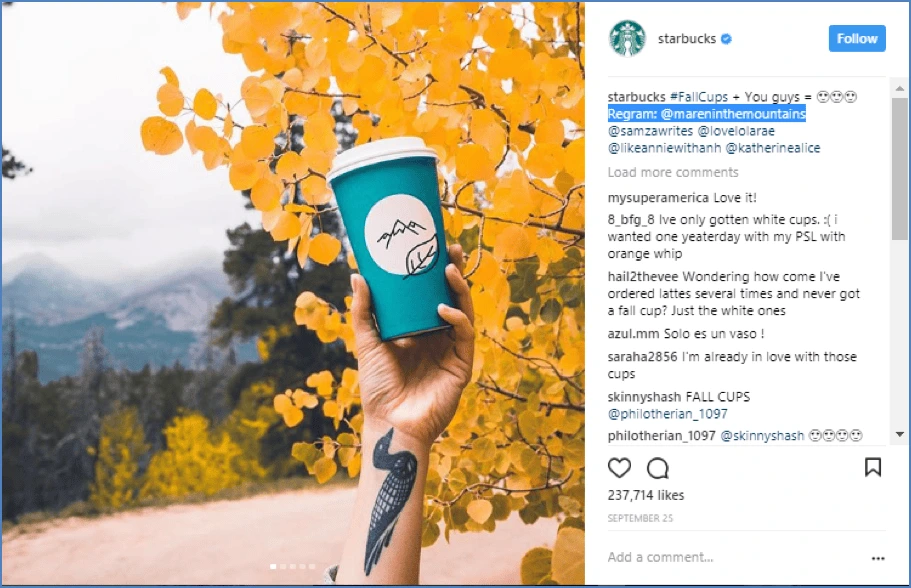
Source: Instagram
Starbucks constantly encourages followers to share their photos and, over time, has built a very active community of coffee lovers. They post their photos, and Starbucks shares the ones they like best.
As a result, the photo-taker gets attention and accolades, reinforcing the positive affinity they have for the brand. And Starbucks gets to spread beautiful pictures of their product that drive more engagement with their content.
You too can explore this option, starting by building a small community of users who love your product. Invite them to share pictures of themselves using your product, and watch how a win-win game can score points both for you and for your audience.
2. Just Eat—Hashtag your giveaways
Giving away freebies isn’t exactly a groundbreaker in business strategy, but there’s a better way to gain maximum impact. The food delivery app Just Eat nails this practice. It’s constantly running themed contests and food giveaways that ask users to tag their friends, send in entries, and generally join in the fun. As a result, for every item given away, Just Eat earns a great deal of traction and puts people in just the right mood for ordering food. #FindYourFlavor, #JustEatUK and #StrangerThings2 are just a few examples.
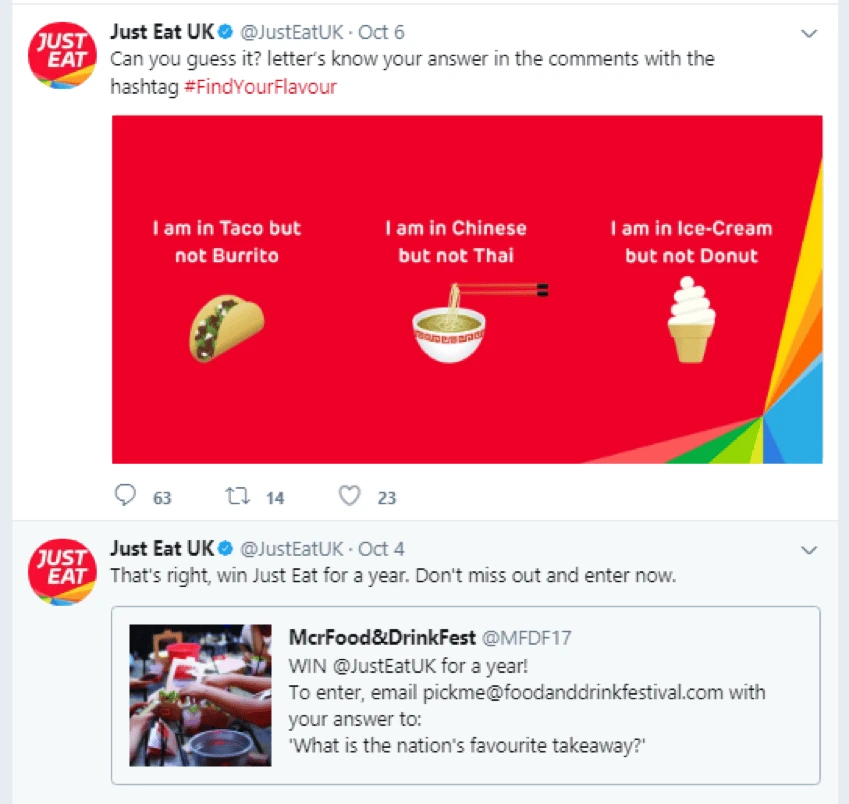
Source: Twitter
3. Lyft—Start a conversation
“While rival Uber is an efficient delivery service, Lyft is seeking to differentiate itself by offering a combination of ‘humanity and technology.”
Kira Wampler, Lyft CMO
Lyft crafts its social media strategy in that same vein by posting customer reviews, messages and conversations on their Twitter page. It aims to establish an identity as a warm, friendly taxi experience that nurtures relationships and cares about every single passenger. In fact, fantastic customer service has been Lyft’s calling card from the start, so playing it up on social media is a smart, brand-consistent move.
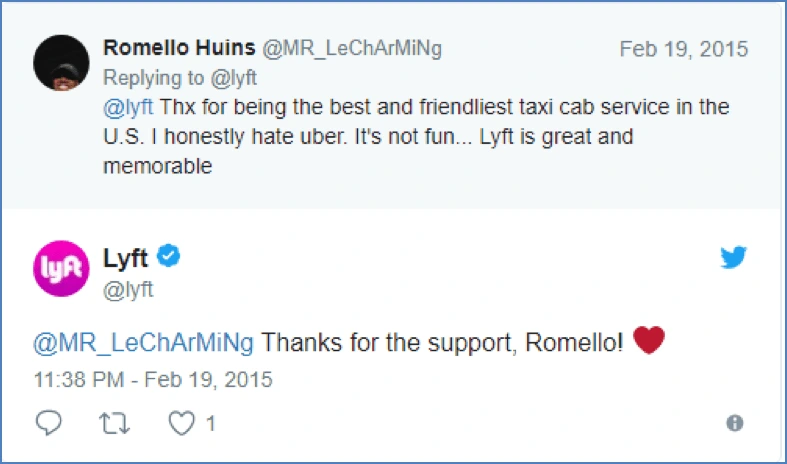
Source: Twitter
We all want to do business with brands that make us feel special. [] Forming personal relationships through conversation is basic human nature. You too can try exhibiting your warm, personal side by sharing users’ comments and conversations on your profile.
4. Pokémon Go—Roll out teasers before major updates
Pokémon Go brought augmented reality gaming to the masses and attracted a huge fanbase in very little time. However, with shrinking attention spans, the initial excitement could’ve fizzled out quickly if they didn’t find ways to keep the buzz going.
Fans of Pokémon Go are treated to small doses of upcoming excitement through a regular cadence of trailers and teasers. The anticipation for new levels, more items, and higher scores is enough to make fans look forward to playing every update, making it one of the highest grossing games ever.
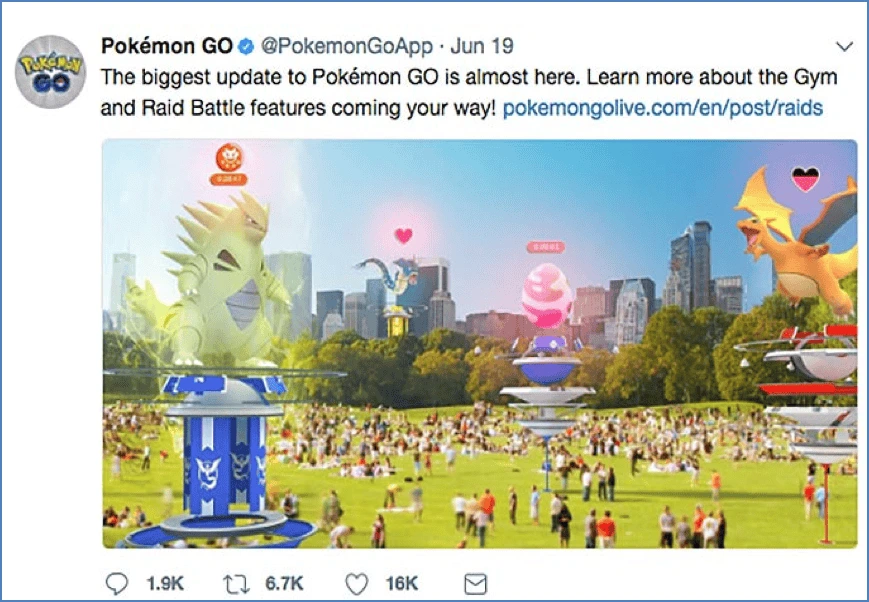
Source: Facebook
If you have a major update coming out, tease your followers with alluring clues, images and videos. This will keep the excitement alive until the update is finally out.
5. Angry Birds—Have a little fun with games
Angry Birds has been on social media since 2009, and from the start, their team has infused their brand’s personality with the fun of gaming. They are constantly running fun contests, posting fan artwork, giving away extra lives, and adding a light touch of humor to everything they post.
Plus, it’s not just your typical “share to win” giveaways. Contests come with clues and incentives to lure people into downloading the app. Riddles, puzzles, cryptic images and poems, it’s all there to keep users tuned in. Sometimes all it takes is a little fun and games to keep your audience engaged.
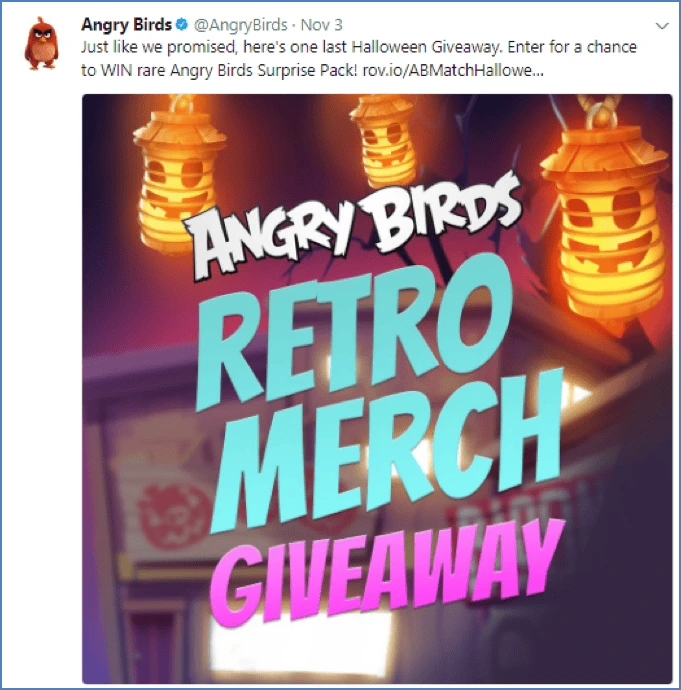
Source: Twitter
Wrapping up
Now you have 5 tried-and-tested strategies straight from the pros. These techniques can be adjusted and applied to nearly any brand willing to experiment with creative flair. The idea is to build connections and foster relationships with your users so you become part of their social lives. Try one (or more!) of the above tips and see how your audience responds—you might be surprised at your success.
Ready to drive more engagement and leads with social media? Grab a copy of our free eBook: How to adapt your brand to social media
Sometimes, change is a good thing.
A fresh lick of paint can revive a dull living room, a new haircut can boost self-esteem, and a rejuvenated image can bring life back to an outdated brand.
The catch is that, unlike changing your hairstyle, a brand refresh isn’t something to do on a whim because you’re bored or haven’t had a chance to play with your design software in a while. Without a solid strategy, your renovation could turn into a DIY disaster.
Related: 10 best branding & corporate identity design examples
When you’re considering a brand refresh, start by asking a few honest questions:
- Why does the brand need a new image?
- How will a refresh help the business?
- What’s involved in a refresh, and what resources will you need?
Let’s take a look at a few reasons why a brand refresh might be the right choice for your company today.
Is my brand outdated? Separating the dynamite from the dinosaurs
Perhaps the most obvious reason to refresh a brand is that its image has simply outgrown its effectiveness. IBM is a great example of a brand that’s successfully evolved its image to match the changing nature of its product portfolio. By adapting its visual identity and voice throughout the decades, IBM has shown it can stand up against modern competitors.

This IBM logo offers a look back at the brand’s history
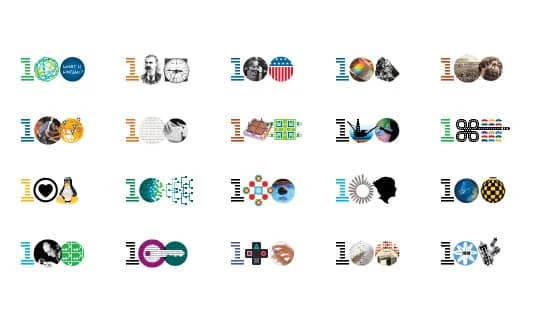
A selection of icons designed for IBM’s centennial
Many enterprises struggle to make changes because an old brand can gradually start to feel like an old pair of shoes-sturdy and comfortable. Unfortunately, you will need to make changes eventually if you want to be seen as an authority in your space, rather than a relic. Here are a few ways to check whether your brand is becoming outdated:
- Is your visual identity fresh and modern? Look at your logo, website, and any other visual media you use to connect with customers.
- When was your branding designed? If your logo is more than 20 years old, it’s probably time to revisit it.
- Is your brand getting the right results? Are you still marketing to the right audiences?
- Does your messaging and positioning accurately reflect your current value proposition and customer pain points?
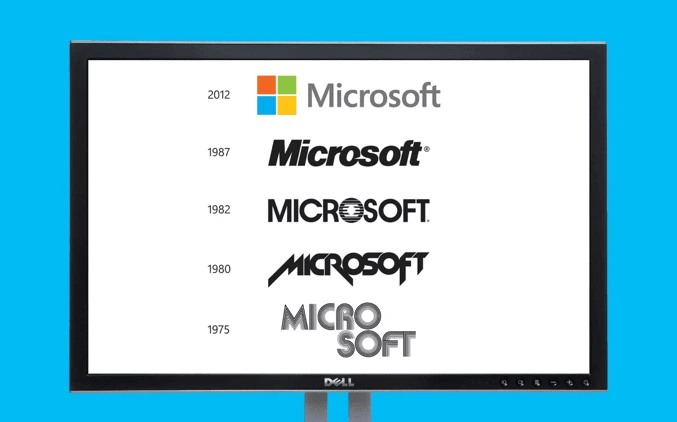
A timeline of Microsoft’s evolving logo design
Refreshing vs. rebranding
It’s easy to confuse a rebrand with a brand refresh, but ultimately, they serve two different purposes. A company rebrand is an extensive endeavor that involves completely removing the basic structure of the brand and starting over. A company typically only pursues this strategy if the current brand identity is confusing, contradictory or misrepresents the core of the company’s mission. A brand refresh, however, involves updating and building upon the brand structure that is already known and loved. Rather than a complete overhaul, it involves an update to visual elements, tweaks to messaging or changes to other differentiators.
5 practical reasons to refresh your brand
A brand is more than just a name and a logo. It’s also your company’s reputation, identity, and public perception. In many cases, companies recognize the need for change but want to preserve the brand’s positive aspects. With that thought in mind, here are 5 reasons you might consider updating the brand rather than undergoing a full rebrand.
1. You aren’t getting enough attention
A great brand doesn’t just generate an image for your company; it gives your customers a reason to sit up and take notice. There are plenty of ways to tell whether your audience has moved on from your message, and the first is that you’ve seen a steady decline in sales.
If people are just as happy with your products as they’ve always been, but you’re not gaining ground in the market, this could be a sign that your brand has lost its selling potential.
Remember, refreshing your brand doesn’t involve turning your identity upside down. Instead, it can be something as simple as redesigning your logo, unrolling a new slogan, or switching to a new color palette. It’s giving your audience something new to chew on while sticking to your brand’s core values. []
The power is completely in your hands.
2. You don’t stand out from the competition any more
Making an impact is hard in today’s saturated online marketplace—and copycats are running wild. Even if you have a great product or service, it won’t be enough if customers can’t distinguish your brand from the other players in your niche. You’ve got to stay ahead of the pack.
If your brand image is starting to feel like a copy-paste job, then you’re going to need new and unique ways to recapture your audience’s interest.
This can be a complex process because it means getting to the bottom of what your company stands for, what it can do today, and how it outshines your competitors. If you can find a way to differentiate yourself, you’ll find it much easier to drive brand awareness and loyalty.
3. Your company has changed
A founder’s initial vision and the company that grows out of it aren’t always one and the same. Sometimes, a brand is born with a particular product in mind—like Starbucks and its signature coffee. Then, as the business continues to grow, it’ll develop new products to better serve its audience.
Over the years, Starbucks has updated its product list to include everything from sandwiches to iced tea. These changes meant that the company had to reimagine the brand’s image based on what they could offer customers in a new marketplace.
As the business evolves, keep an eye on your brand and take note of any constraints that might make it difficult to branch out into new areas.
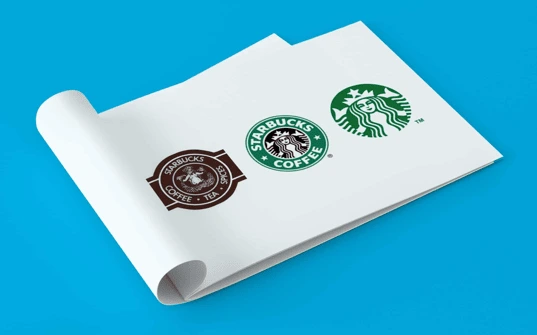
Starbucks has evolved to serve much more than coffee
4. Your message is inconsistent
For most companies, building a brand is about refining ideas and values into a voice and image that they can project to the world. As you can imagine, this is a complicated process that even the best of intentions can belie.
A brand refresh can help to realign your company’s values when they start to lose their way. After all, we know how valuable brand consistency is—not just to your customers’ experience, but also to your bottom line. If you want your brand to become a trusted name, then you’ve got to deliver the same, familiar experience whenever customers interact with you.
5. You want to attract new customers
When a brand is just getting started, it’s often easier to target a small, niche audience. However, as the brand grows, it’ll find opportunities to expand into different areas that offer new sources of revenue.
Sometimes, tapping into a new share of the market requires changing your voice or image so it’s more likely to appeal to a wider range of customers. A brand refresh can help you reimagine what the future looks like for the company.
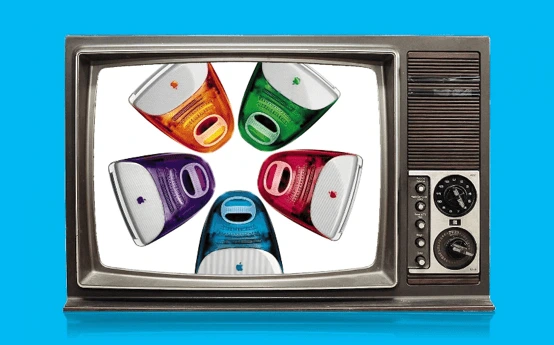
Apple excels at making its brand & products feel fresh. Remember these?
Is it time to refresh your brand?
Ultimately, the decision to refresh your brand can be a difficult one, but it’s worth thinking about when your current image isn’t delivering the results you need.
In severe cases, you might discover that the best way to bring your company back to life is a complete rebrand, where you go back to the drawing board and start fresh. While a rebrand is a more dramatic approach, a refresh allows companies to make tweaks over time that help their brand evolve with the market.
Considering a brand overhaul? Grab a free guide to conducting a rebrand
Jeff Bezos once said, “Your brand is what other people say about you when you’re not in the room.”
Your brand identity is the essence of your brand. It’s who you are, what you do, and how people describe your brand, based on the way you make them feel.
Related: 5 content tactics to ignite brand engagement with millennials
The problem is, people don’t always trust brands. They inherently don’t believe the identity you’re selling them is who you really are. That’s why you need to reach out to relevant influencers to validate the brand identity you’ve built.
Influencers reflect your brand identity
Just as you use a consistent voice and imagery across your content, the way influencers talk about your brand should sound like they are talking about the same person.
If multiple friends shared posts about a single friend online, you’d be able to tell who that person is. Likewise, when multiple influencers share posts about your brand, your brand identity should be clear.
When a person zooms out and views your various influencers as a group, the picture should make sense. Maybe they are all in the same age group, from the same city, or share a similar interest.
The most basic influencer marketing program would have a Venn diagram with one thing in the middle that all the influencers share. However, as your influencer marketing program grows and matures, you can envision several chains of interconnected circles that all tie together.
Lululemon’s ambassador program includes a diverse group of individuals from foodies to snowboarders to dance instructors, but they all share one thing in common: a life devoted to being fit.
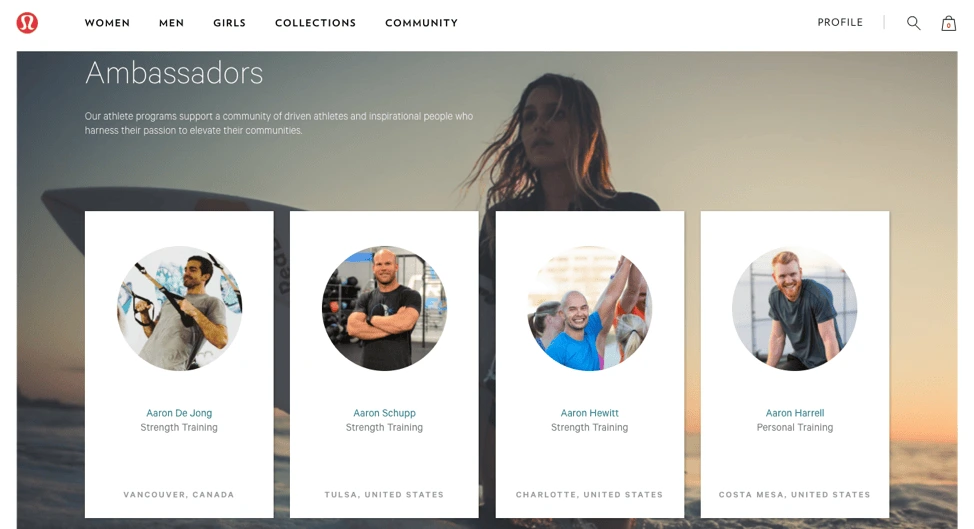
Work with the right influencers
You know the saying, “You can tell a lot about a person by the company they keep”? The same goes for brands. None of your influencer choices should seem jarring to someone who heard about you from another influencer.
That’s why it’s critical to do your research up front. This keeps you from running into problems of discrepancy; if you sell business software, it will come off as insincere—or worse, desperate—if you have a fashion blogger chatting you up. Your influencer’s personality and niche should match, or at least mesh with your brand, as someone you would associate with.
If your brand was a person, would they run in the same social circles as your influencer? Even if they might not do everything together, it makes sense for a fitness vlogger to promote a pet-sitting service if they regularly travel to weightlifting competitions.
Align your brand with specific types of influencers
If your brand is suffering from a case of poor brand identity, one way to fix that is strategically partnering with a targeted set of influencers. Of course, these influencers should overlap with your customer audience, and their values should jibe with your brand’s. But, a focused campaign can help your brand become known as “that one all the [fill-in-the-blank] bloggers love.”
This is a good strategy for breaking into a new niche or vertical. If your product is extremely specific, this strategy can work wonders. Your association with a niche set of influencers will quickly spread your name among potential customers and solidify your legitimacy within the community.
Take Royal Caribbean for example. Cruises have traditionally been viewed as a travel option for the over-50 age set. The cruise line wanted to attract more millennials, so they partnered with Periscoping travel bloggers via an influencer livestream campaign.
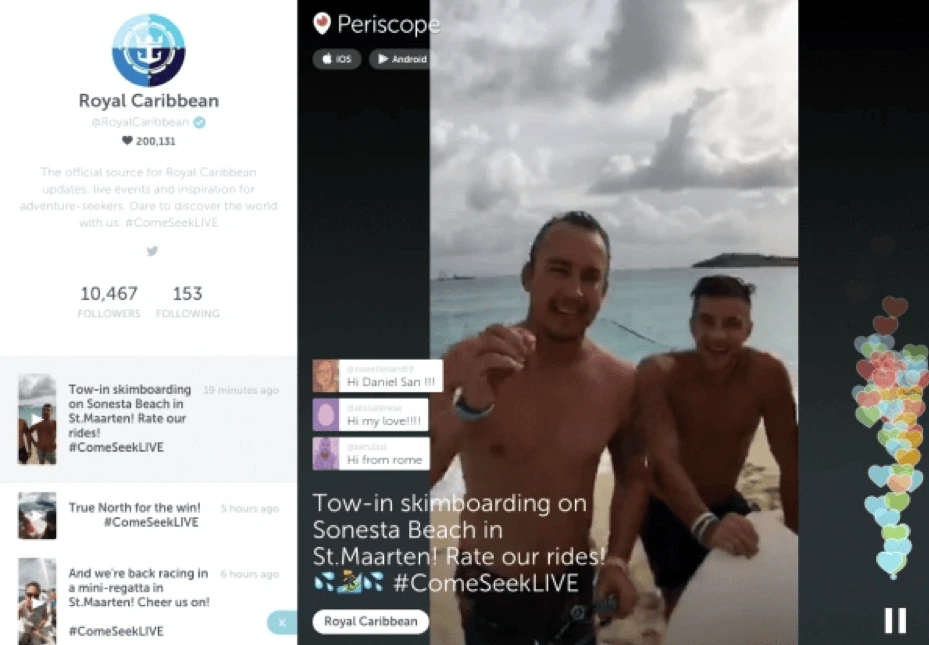
Give influencers what they need
The better that influencers understand your goals, as well as the ins and outs of your service, the better they can promote you. Give them what they need to understand your product. Then, they can create promotional content that feels authentic, rather than a one-size-fits-all sales pitch slapped on a pretty picture. You can guess which one is more effective.
Use influencers to make your brand real. Ask them to highlight how your free sample felt personalized to their needs or was delivered in a special way. Suggest that they talk about how your product solved a specific problem for them, or request that they mention an employee they spoke with at a store or over the phone.
Just as the laughs you share with a new friend help your relationship blossom, these little details are what shape a consumer’s relationship with your brand.
Key takeaway
The great thing about brand identity is that the more people talk about it, the stronger it becomes. [] And when those people are influencers, it becomes stronger even faster. If you have a solid brand identity, it might be time to find influencers who can help you drive awareness and adoption.
In a stressful world, it’s no wonder that people are drawn to the idea of “wellness.” According to The Global Wellness Institute, the wellness industry grew by 10% to $3.7 trillion between 2013 and 2015-while the global economy shrank by 3.6%. It’s one of the world’s fastest-growing industries, and as we move through 2018, it’s showing no signs of slowing down.
Related: 5 ways sleep can boost your productivity
For those in the wellness industry (and aspiring startups), this is both good and bad. Consumers are more aware than ever of the benefits of good sleep, a good diet and activities like yoga, and they’re seeking new ways to improve their health and productivity. Along with this increased awareness, however, comes the fact that wellness brands must fight for attention in an extremely competitive market.
Even a small glance at Instagram is enough to illuminate the ubiquity of food and fitness gurus. So how can you, in a market that’s perhaps best described as “visually noisy,” give your brand the best chance of standing out?
Determine your brand’s visual strategy and be consistent
We all understand the desire to get your brand out there, and it’s natural to want to jump straight into social media to put your brand in front of as many people as you can. However, there’s huge value in taking a deep breath and considering your content strategy.
The reality of modern marketing-much of which takes place in the digital realm-is that you have to create far more content than businesses had to in the past. For example, you might decide on:
- 3+ daily tweets
- 2 Facebook posts
- An Instagram photo
- An Instagram or Snapchat story
- A weekly blog
- Occasional guest blogs
That wouldn’t be an unusual workload, and it sits on top of all the ongoing work you’re already doing. Not only that, it needs to be compelling and engaging for your audience. Add to this your print marketing, website design, and everything else you have to consider, and you are looking at a huge amount of content.
It’s easy to see how you can lose consistency and quality control without careful planning and brand guidelines, which is where a platform like Lucidpress can help keep everyone aligned. Just ask brands like Bar Method and Club Pilates:
So where do you start?
Of course, defining your brand strategy is easier said than done. It helps to look at what else is out there. You’ll likely fall into a certain sector of wellness-like fitness, diet, alternative therapies or life coaching-each of which has its own norms that can be surprisingly hard to move away from.
Many fitness brands are overtly masculine with a palette of striking primary colors, photos of sweating brows and ripped abs, and a “no pain, no gain” mentality. Others take a gentler approach. Aspirational images of yoga performed in stunning landscapes is everywhere; you’ll often find it accompanied by encouraging language which values self-esteem and “finding yourself.”
Meditation tends to be pastel-shaded and broadly spiritual. Food brands are fresh-faced, brightly lit and often obsessed with avocados. None of this is bad, of course, and some elements may suit your brand perfectly. The trick is to incorporate inspiration from other brands while avoiding imitation and finding your own particular voice-and avoiding clichés as much as possible.
Don’t be afraid to show personality
One common theme in the wellness market is a tone of earnest sincerity. While it’s vital that you do sincerely believe in your product and its potential to improve the lives of others, one way to stand out from the crowd is not to let this fact prevent you from showing a little personality.
For example, try not to be too high-handed and “guru-y.” As an expert and leader in your field, your authority on these subjects should be clear. Being friendly, personable and letting some humor shine through won’t detract from this. Social media has changed the game for brands; being strictly professional is unlikely to catch anyone’s attention.
The visual language you use for your brand can be as fun, interactive and enjoyable as you want to set it apart from the dominant and blandly perfect images of “clean” living. Be public with your personality and enthusiasm for your brand and product.
Use science, don’t abuse it
One accusation often leveled at the wellness industry is the flippant and misguided use of scientific language in order to substantiate dubious claims. This can seem rather unfair, but unfortunately, a few high-profile cases have helped cement this view.
What’s especially unfortunate is that there’s so much legitimate science to back up the benefits of wellness practices. With a little effort, it’s easy to avoid the traps of bad science.
- When you hear scientific information from news articles, make sure to read the original studies. Journalists aren’t usually trained in scientific language and can sometimes misrepresent the findings. There have even been cases of journalists writing an article based on the work of another journalist.
* Recognize that different studies hold different weight. Look for the sample size, whether the methodology is well-supported and makes sense, and whether they were funded by organizations with vested interests.
* If some of your evidence is anecdotal, don’t be afraid to say so. Take the vegan diet as an example; it is demonstrably healthy in many ways and has both environmental and ethical merit. However, anyone trying to prove that it’s irrefutably the best diet for everyone is going to have a hard time, and they’ll likely spend their days arguing with others over opposing studies that suggest this isn’t true. If you have a great story to share, distinguishing between scientific study and what you believe through your own experiences is ultimately far more convincing.
Don’t maintain a social presence just because
It’s a near-fact of modern branding that you have to be on social media. However, a brand can get so busy that their social media presence becomes a half-hearted nod to the power of these platforms. This doesn’t mean you should shut down your branded accounts, though. It just means you have to think about them a little more.
The best place to start is to consider your own social media use. What motivates you to follow certain accounts? Why do you take the time to engage? If you look at your content and can’t find a reason why you would bother to like, comment or share it outside of your professional life, then it probably isn’t going to interest anyone in your target market, either.
Social media isn’t just a platform on which to post a series of promotions. A hard truth that every marketer has to swallow is that most people hate ads. What they do appreciate is being entertained, learning something new, or finding information relevant to them. With this in mind, before posting something to social media, consider whether:
- It will prove interesting to your audience. Is it funny, informative or entertaining? Is the imagery visually striking, beautiful or unexpected? Does it communicate your brand values?
* You actually find it interesting yourself. It’s important to notice when you’re posting “dead content” simply to fill up space or because you feel like you have to.
* You’re alternating promotional content with expert guides, behind-the-scenes insights, influencers’ content, and competitions. Your promotional content should be engaging in its own right.
The world of wellness is by no means oversaturated, and there’s much to be said for brands who want to provide people with tools and knowledge that will profoundly improve their lives. By finding your unique voice, your brand will naturally stand apart from the crowd.
See how Lucidpress’s cloud-based brand management software can streamline your creative process.
How many advertisements do you remember fondly? Probably not that many, considering we’re bombarded with content on a daily basis.
But the ones you do remember seem to creep into your subconscious. It’s like a catchy song that you can’t help but remember.
Good visual content has a lot to do with psychology. Appealing to human emotions will influence people to react to your ad a certain way.
Related: 4 ways to increase conversions with visual content
Corporate Executive Board did a survey on this in partnership with Google. They contacted marketing leaders, vendors, consultants, and over 3,000 B2B buyers to understand the rise of emotion-driven content marketing.
In their report From Promotion to Emotion, it’s revealed that 86% of buyers believe that brands are all selling the same stuff. Unique value propositions are not turning out to be… not so unique. But, brands that connect with customers on an emotional level will see 2x more impact than those trying to sell based on functional value alone.
If you’d like to tap into that influence, here are 7 emotions that drive people to connect with brands—and real-world examples of each.
1. Urgency
Even when your customers want your product, they can still be hesitant. Maybe they feel like they can buy from you any time, so why spend money now? Later, they say, later.
This is when you need to infuse a bit of urgency. Add a timer or an expiration date in your email newsletter or video ad, and buyers will take the cue. No one wants to miss out on a good deal.
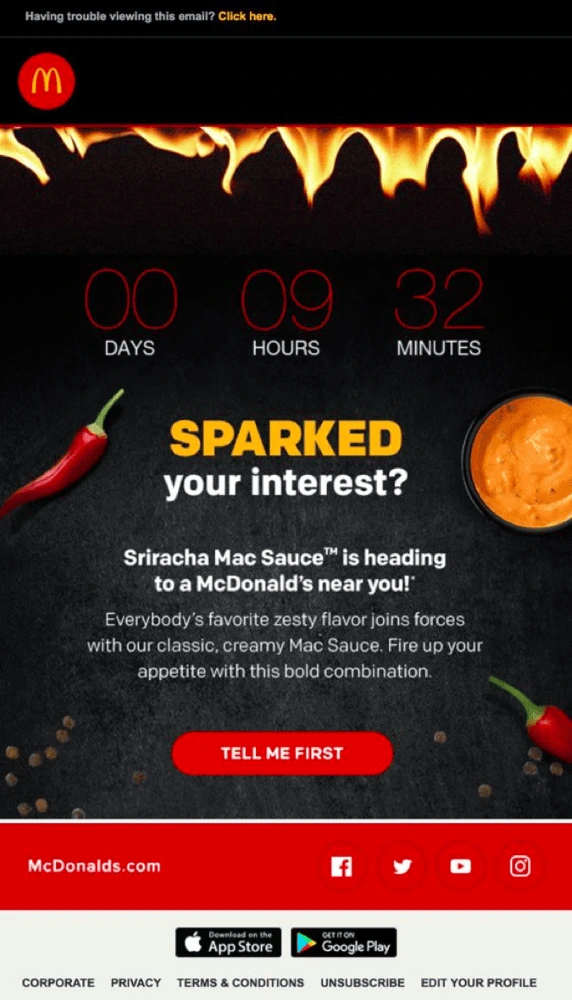
Source: McDonald’s
Big retail & e-commerce brands use urgency (tick-tock) to promote instant consumer action or purchase decisions. However, make sure you have a good reason for incorporating urgency in your offer. For example, countdown timers are often used for festive occasions or limited product runs.
Urgency even works better when you pair it with scarcity. Use phrases like “limited stocks available,” “limited tickets,” or “first come first serve.”
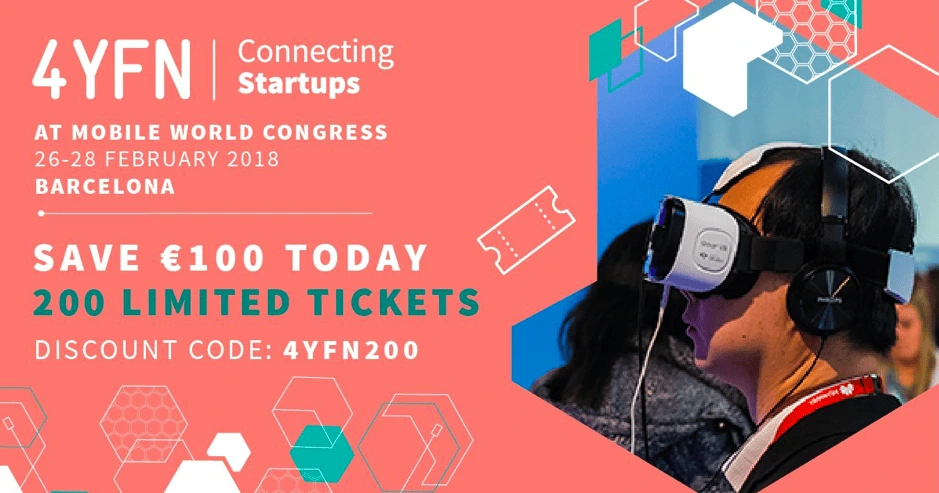
Source: 4YFN
A similar psychological catalyst is FOMO. Fear of missing out is a social worry that if you don’t participate in time, you won’t be able to enjoy the same rewards other people are reaping. One study reveals that around 69% of millennials experience FOMO when they can’t attend a popular event. You can use that fear to your advantage.
2. Desire
Desire is a powerful emotion. Almost every action we take and purchase we make is driven by desire. Many brands channel desires into their visual ads to capture an audience’s interest.
One way to do this is through before-and-after images. Olay took this concept even further with their “Identical Twins” campaign, where one of the twins uses the product and the other does not.
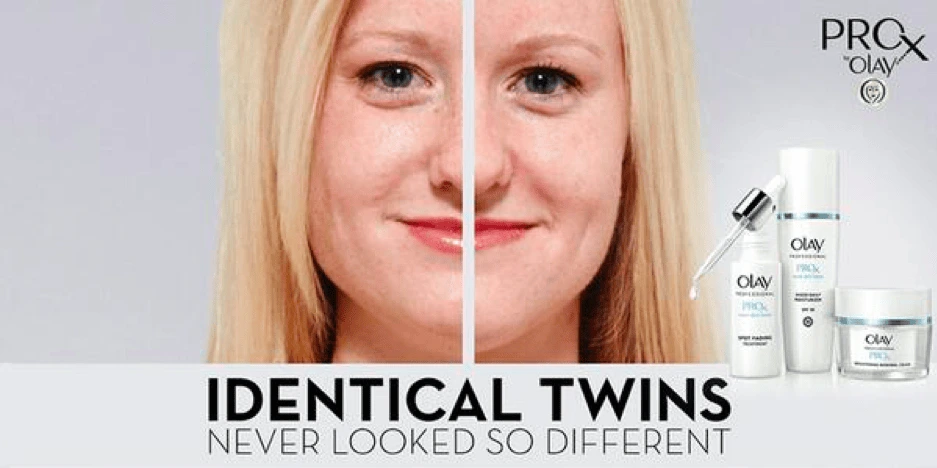
Source: Olay
But, before-and-after images don’t have to be about skin care or weight loss products. Check out this GIF, for example. SiteFlood creatively uses the before-and-after concept to show prospects what kind of results their service delivers.

Source: SiteFlood
Similarly, most explainer videos use a “problem-and-solution” format to identify prospects’ needs, then provide a solution to help them fulfill that desire. This video explores the desire to live in the Caribbean, the problems one faces to achieve this, and the solution.
At Lucidpress, we used the same animated format to introduce our brand management platform—complete with white knights, bodyguards and Mama bears.
3. Compassion
We’re social creatures, and that’s frequently reflected in our behaviors and reactions. We care about our family, our friends, and even random strangers. Doing something for others makes us feel good.
Thai Life Insurance produced a series of heart-warming videos that showcase the sentiments of altruism and care, even in adversity. In the end, it’s wrapped up nicely as part of the brand message.
Attaching your brand to feelings of love, care, attachment, altruism and charity can give your visual content a strong emotional pull.
4. Delight
Humor provides more delight than almost any other emotion, but it can be difficult to pin down and execute well. You must know your audience and their sensibilities, so you don’t end up missing the mark, falling flat, or even offending them instead of making them laugh.
Old Spice has perfected the art of appealing to its demographic in a variety of fast-paced, cinematic ad campaigns. It’s delightful, humorous and exciting to watch.
5. Personal care
Advertising is everywhere, and it rarely feels like an ad is speaking directly to you. In this constant deluge of content, personalization is valued more and more. If you want my business, make me feel special. Show me that you care.
Starbucks is no more “special” than any other coffee brand, but they show their patrons that they care. It’s a brand synonymous with warmth, comfort and convenience, and it’s easy to make it your own.

Source: Tumblr
Starbucks proves that it cares about the individual experience by providing a casual meeting space, a work environment, a place to relax, free Wi-Fi and other comforts. Perhaps more importantly, they ask each customer for their name and write it on every cup of brew they order.
In some ways, Starbucks has come to resemble a hospitality brand without actually being one, simply by extending a comforting personal touch.
Introducing customization or personal touches to your brand can make you far more appealing to your audience, because they will feel special and cared for.
6. Trust
Your customers have their own personal tastes, values and opinions. Likes and dislikes. Movies or music that they love or hate.
It turns out that personality will largely determine a customer’s shopping behavior. They buy products and experiences that either reinforce their personality or help them get closer to who they want to be.
So it stands to reason that if you associate your brand with a celebrity they like (or want to be like), that would give them a reason to trust in your brand and buy from you.

Source: Nike
This is why brands hire celebrities and influencers to drive brand awareness and adoption.
The idea here is to create an image your target customers will like or aspire to. Do some research on who your customers are (or who you want them to be). Once you’ve sketched out a buyer persona, including their likes and interests, you can solidify brand messaging that speaks to their personality and values—and earns their trust.
7. Motivation
Participating in social causes you believe in can be very gratifying. But, that gratification often comes from harrowing personal experiences, or at the very least, a visualization of others’ worst experiences.
CoorDown, an advocacy group for people with Down syndrome in Italy, made a beautifully profound video featuring people with Down syndrome delivering their own messages of reassurance to a future mother who’s worried about what kind of life her child will have.
The video is a rollercoaster of emotions that culminates in the promise of a happy, fulfilling life.
Find a cause that speaks to your brand values or to your employees. You can draw on personal experience or the hardships of others to create stories that inspire hope and motivation for your audience.
Key takeaway
Emotions are fundamental. You don’t need a PhD in psychology to figure out what makes people tick. You just have to do some research on your buyers. Draw up a buyer persona, then create visual content that will resonate with that audience.
Brand management is one of the most important parts of marketing. It can take a long time and a lot of work to create a brand image that people like and trust, but in an instant, all that work can be completely undone. There are certain situations businesses have to deal with that, if not handled properly, can severely damage the brand’s image. Here are a few common situations and how you should respond.
Related: Why brand equity is important & how to measure it
Problem #1: Having poor customer support
If you look up any public polls or surveys that list companies with the worst ratings, one of the biggest reasons is due to poor customer support. If someone calls you with a problem they’re having with your brand’s products or service, you will make a bad situation worse by making it difficult for them to get help from you. []
Bad support is a good way of burning a bridge not just with that customer, but with their friends and family, too. After that, there’s more damage to worry about if they vocalize their discontent on social media.
To respond to this situation, you need to overhaul and clean up every line of communication between you and your customers:
- Make it easy for your customers to find your phone numbers and/or email addresses for support.
- Create a functional process flow to handle customers through your support channels.
- Make sure your customer support team adheres to that process.
The longer customers wait to get the help they want, the more annoyed they’ll be. They should be able to contact you quickly and easily. Most importantly, they should receive a useful response that resolves their problem. Auto-response emails and phone messages are simply not good enough in situations where your real customers are involved.
Problem #2: Failing to live up to your brand image
If you build your brand image around certain promises or guarantees for your customers, you had darn well better deliver on those promises and guarantees every single time. If you say you have the cheapest products, you’d better have the cheapest products. If you offer the quickest service, your service had better be very quick. If you have a satisfaction, money-back guarantee, then you need to take your customers’ dissatisfaction seriously and mitigate their concerns or issue a refund. Nothing can ruin a brand’s image like being inconsistent in living up to its own standards and promises.
If your company’s brand is starting to take a hit due to this, you need to take immediate steps. Get all hands on deck and start generating as much positive brand awareness as you can. The best way to do this is by delivering on the promises you make.
In the short term, that means doing what you can to raise your brand’s reputation, and in the long term, it might be shifting your brand’s image to something more realistic. For instance, if your business is not able to offer the cheapest products, change your marketing to start offering the friendliest service instead.
Problem #3: Getting negative attention from an employee
It is an unfortunate reality that how your employees behave, even when they’re off the clock, can reflect back on your brand. If they’re caught on the news, in a newspaper, or online behaving in an unethical manner—or even just in poor taste—your brand can get negative publicity from it. That’s why so many businesses include clauses in the employment contract regarding “off-duty conduct.”
From a brand image perspective, what should you do in this situation? First, be open and transparent to the public so they don’t think you’re covering anything up. Apologize to anyone affected by your employee’s actions, both publicly and in private. Second, look into how you are legally allowed to handle the employee based on that specific situation.
Finally, you need to be seen responding against the negative behavior in question. For example, if the employee went on a racist rant online, you can donate or form a partnership with an anti-racism organization and/or hold special seminars and training to improve tolerance in your company.
Problem #4: Offering a poor website experience
In today’s world, you cannot afford to have a bad website. The design can’t look old and dated; the navigation can’t be poorly structured so customers can’t find what they’re looking for; and the functionality can’t be compromised so they’re unable to perform important actions, such as completing a lead form on your site, completing an online purchase, or simply entering the buying cycle.
Even if your business is running smoothly otherwise, having a bad website that creates a poor user experience can really hurt your brand’s image. It can set a bad first impression if your users’ first interaction with your business is through a dysfunctional website.
The first thing you need to do is fix your website, of course. Upgrade the design or fix your theme and template, rearrange the navigation (site architecture) so it makes sense for your end-user, and fix any bugs or broken pages so that your visitors don’t get any site errors telling them your website pages cannot be found (404).
The next thing is investing in search engine optimization (SEO), then promoting the heck out of it. Create special promotions for the re-launch, start digital paid ad campaigns intended to drive new traffic to the new website, and retarget traffic from your old site back to the new site so they can see the difference.
Problem #5: Receiving a bad customer review
All of the above situations often lead to a customer leaving a bad review for your business online—on Yelp, Google, TripAdvisor, and other websites where customers review businesses. The worst thing you can do is ignore a bad review.
If reviews pile up and you don’t respond properly, your customers will assume you don’t care about them or their business, causing other people who look up your reviews to form a bad impression of your brand.
Make sure your business has an account on every major review website that your business gets reviewed on, and monitor them regularly.
When you see a bad review, take the information in the review and find out what happened before responding to it. Sometimes, the customer could be lying or omitting the truth, and you can point that out to tell your side of the story. Other times, your business legitimately failed the customer, but you can respond in a way that offers an apology and makes the situation right for them.
Want to know more about how to build your brand? Download our free ebook on how to build a brand in 2020.
At one point in time, a recognizable brand was all that was needed for a business to thrive. But now, that brand must be accompanied by trust because modern consumers are different than they were several decades ago. Today, there’s the internet and consumers can easily conduct research on a brand before they make a purchase.
In fact, they often do. Some stats suggest that 61% of consumers read reviews before they complete a purchase. They look for a reason to trust your brand before investing their hard-earned money in your product or service.
Related: 4 easy tips for effective online brand management
62% of Americans actually believe corruption is widespread in corporate America, so it’s safe to say that trust in corporations and big brands is lacking. Companies need to be careful so that they earn a trusted reputation. But there are also great opportunities to amplify what consumers are saying online to build trust for your brand.
Here’s some ways you can build brand trust online.
Provide valuable content
As the saying goes: content is king. Quality content can do a lot for a company, whether it’s on your website, blog or social media. It sets you up as an authoritative voice and, hopefully, a thought leader.
To write content that will benefit your brand, do some research to see what your competitors are doing. Then, create content that fills in the gaps they’ve left. Make your content more detailed, engaging and better in any way you can. This will prove you are the authority in the industry.
Keep in mind the 80/20 rule for your content creation: 80% of your content should be useful and non-promotional while the other 20% can talk about your product. This will engage consumers and prove to them that their wants and needs are a priority for you. Keep this in mind when posting to social media, writing a blog post or creating a video.
By providing reliable and insightful content, rather than a sales pitch, you’ll nurture a sense of trust in your brand.
Dove’s viral campaign “Dove Real Beauty Sketches” is an excellent example of this concept. Most of the video is about how women perceive themselves. The ad doesn’t mention Dove products, it simply finishes with the brand’s logo as a reminder of the company behind the message.

Source: Dove.com
IKEA is another example of a company creating useful content. The authentic Swedish brand added to its trusted reputation with its “Make Small Spaces Big” campaign, which provided tips and creative ideas to make better use of small spaces… information that is both valuable and relevant to its audience.
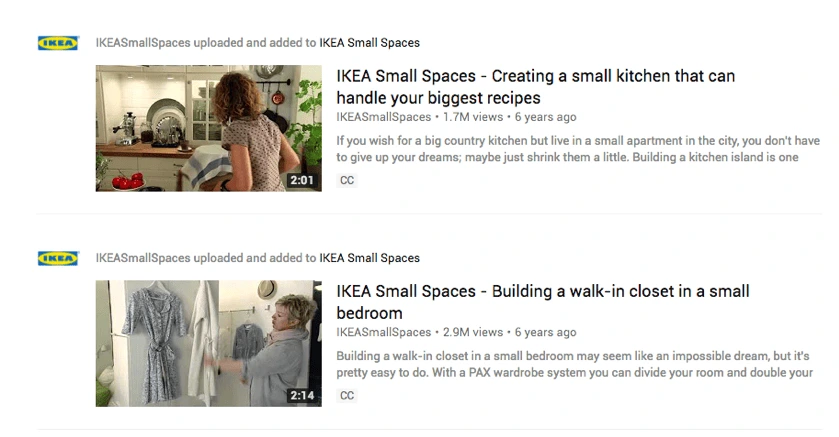
Engage customers in two-way communication
Consumers today like to be engaged and have relationships with brands. If you can do this, you’ll build trust. Social media is a way for modern companies to respond personally to individual consumers, and by doing so, these companies contribute to their own mouth-to-mouth marketing. One consumer impressed by a company’s communication can quickly go viral and generate positive press coverage.


Source: Twitter
To engage customers successfully, you need to interact with them on a regular basis. You must have a solid, active presence on social media. You need to monitor your pages for comments, questions or complaints and respond personally and appropriately. Be responsive and start conversations, and you’ll be able to build a positive relationship with consumers.
The IT networking company Cisco understands the importance of online engagement and offers its customers various avenues for interaction. In fact, the company claims it saved $200 million annually by moving its engagement efforts online. Cisco blogs, chats via Google+, has a full Facebook support page with more than 800,000 followers, uses LinkedIn and has even won awards for its customer support.
Building this rapport and being within reach of your customers is important to building a reputation as a trusted brand.
Host live video events
Whether you host a Q&A on Facebook Live, a demo on Periscope, or a webinar on your own website, live video events are a great way to build trust online. They require a lot of planning but can be very effective. There’s something about the unedited aspect that really motivates interest. Customers can engage and ask questions while they watch. And as it’s live, they know the answer they’re getting hasn’t been given a stamp of approval by the PR department, so it’s a great way to build trust with fans.
Keep your brand consistent
There’s nothing like going off-message to destroy a brand. From your logo and brand colors, to your tone and personality, you must be consistent in everything you do and say. [] A brand playbook can help you maintain the right voice, while brand management tools like Lucidpress can help your documents and content look consistent all the time, no matter how many people are on your marketing team. Consistency is also great for building brand awareness and recognition, as people will come to recognize your brand’s unique style.
Encourage user-generated content
Today, millennials in particular are using social media to discuss brands they like, and this can be important for companies looking to build trust. In one survey, 76% of millennial consumers said that content shared by average people is more trustworthy than what brands share. In another study, 92% of people said they trust the recommendations of other people, even ones they don’t know, over branded content.
User-generated content is a great opportunity for your business to show how real people are enjoying your products and build some serious brand trust.
Make sure to share these endorsements on social—Starbucks is constantly doing this. You can also actively highlight this content on your testimonials page, blog or, like Zappos, create a specific destination for this content.

Source: Twitter
Beyond your everyday customers, let other trusted sources advocate for you. You can highlight collaborations with other trusted brands, work with an influencer relevant to your industry, or share media coverage from reputable sources to build trust.
Share trustworthy links
Links are an important asset for any business as they connect your brand with the online world. Whatever link you’re sharing, make sure it leads to a reputable website. Refer to fact-driven sources in your blog posts, industry favorites for your curated content, and always use branded links on social media so followers have an indication of what it is they’re clicking on.
Branded links are made up of a custom domain name and a keyword in the slashtag. By associating your links with your brand, users know it won’t lead to spam or phishing sites and this increased trust can boost click-through rates by up to 39%.
Encourage user reviews
You should encourage your customers to provide reviews of your products or services online. Even a bad review can be used as an opportunity to testify to your company’s transparency and demonstrate your responsiveness and willingness to turn that negative customer experience into a positive one.
By encouraging reviews, your brand will show you care about what your customers think and are confident in the quality of what you’re selling. Often, before committing to a purchase, consumers will check how your company is rated on Facebook, Yelp and other review sites. If they can see at a glance that you’re close to a 5-star rating, they’ll be converted in seconds.
Make sure your brand acts responsibly
According to Forbes, millennials feel strongly about affecting change, and a lot of this is done online. They expect companies to be socially responsible, too, so if your brand is doing its part, make sure you let your audience know. Whether you’re reducing your carbon footprint, taking steps to ensure gender equality, or raising funds for a good cause, share the news online. This will build your image as a noble brand that can be trusted by its customers.
Key takeaway
Providing compelling content, interacting with customers, and maintaining brand consistency is essential to building a brand that people trust.
Today, your brand isn’t simply what you say it is, but rather a reflection of consumer trust in your product or service. You have the ability to develop that trust online and turn it into a powerful marketing tool for your business. It takes work and planning, getting involved and interacting, but it has the potential to cultivate lasting trust that will build brand loyalty and benefit your business into the future.
Want to know more about the power of brand consistency? Download our free 32-page report, chock full of stats & great insights.
Three years ago, Gartner predicted that 30% of our interactions with technology today would happen via conversations with smart machines—and mainstream adoption would be just around the corner.
Related: 10 digital trends that are transforming marketing in 2018
We can see the evidence of this change all around us, from Siri and Cortana to Alexa and Google Home. And while we haven’t reached mainstream adoption quite yet, marketers shouldn’t wait for the masses to catch up before grappling with the implications of voice search.
In particular, voice search represents a move from the abstract to the physical. Certain aspects of your brand—voice, tone, personality—will soon become real in ways they never have before. Just like mass marketing has shifted into digital marketing, we’re now seeing the dawn of conversational marketing with voice search. Here are five factors that show how voice search will impact your brand.
1. Copy that can be read aloud
As more people turn to smart machines to ask questions, brands should be prepared to respond in kind. Creatives will have to write copy that sounds good when read out loud—often in the form of answering a question. Offer the most important information first (remember the inverted pyramid?), and for goodness sakes, keep it brief and unambiguous.
For example, in an older blog post of ours, we discuss the definition of branding. If someone were to ask “What is branding?” today, our blog post would respond like this:
To begin to understand what a brand is, you must first understand that your brand does not exist in your marketing department, your public relations team, or your CEO’s office…
And as pretty as it looks on the page, no one is going to stick around to listen to that. Instead, our response should get straight to the point. Again, from the post:
A brand is the sum total of all the impressions a customer has, based on every interaction they have had with you, your company and your products.
If we wanted to optimize this content for voice search, we could restructure it intelligently by putting the important data first. Then, we have plenty of space for the kind of writing that’s meant to be read rather than spoken aloud.
Finally, keep in mind that voice search is more conversational than traditional search. The queries are longer, and they’re often localized (e.g. “What’s the weather like today?” or “When does The Copper Onion close tonight?”). Your responses should follow suit, mimicking how real people talk (including conversational phrases).
2. New advertising rules
With new advertising mediums come new advertising guidelines. This doesn’t just mean best practices, like we see with paid and organic digital search. We’ll also see big players in voice search (like Google) establishing new rules for brands who want in.
Remember this voice ad from Burger King last year? The commercial was designed to hijack your Google Home device by asking “What is the Whopper burger?” This request prompts devices to begin reading the Wikipedia entry for the Whopper—which, of course, Burger King had edited to their benefit.
The Whopper is a burger, consisting of a flame-grilled patty made with 100 percent beef with no preservatives or fillers, topped with sliced tomatoes, onions, lettuce, pickles, ketchup, and mayonnaise, served on a sesame-seed bun.
Oh, be quiet, already!

My feelings exactly.
Not only did this violate Wikipedia’s terms because it so clearly sounds like ad copy, it also left open the door to vandalism. People were quick to edit the Wikipedia entry to include phrases like “cancer-causing” and ingredients like “toenail clippings.” Not exactly what the fine folks at Burger King had in mind.
Even when the ad worked as intended, people were annoyed by the tactic—but online trolls had made it so, so much worse. It should come as no surprise that Google shut down the ad 3 hours later, and Burger King pulled it entirely.
Consumers aren’t used to advertising in voice search yet. Take care not to annoy them with lengthy descriptions or aggressive sales pitches—and follow the terms and guidelines of the services you use.
3. What does my brand sound like?
Today, Alexa always sounds like Alexa, but it’s not hard to imagine a future where voice search becomes highly customized. Brands will be able to choose their own vocal characteristics, which opens up a world of questions and considerations.
If your brand was a real person, what would they sound like? How would you determine:
- Gender
- Age
- Language or dialect
- Accent
- Conversational tone
- Conversational speed
- Personality

Source: Pexels
Some of these characteristics even raise ethical considerations—like gender, for example. According to OnBrand’s State of Branding report, 54% of marketers prefer a female voice assistant (while only 17% prefer a male). Nearly all the voice assistants we’re familiar with today default to female voices, which raises the question why.
“The simplest explanation is that people are conditioned to expect women, not men, to be in administrative roles—and that the makers of digital assistants are influenced by these social expectations,” says Adrienne Lafrance in an article for The Atlantic. Power structures influence our technology all the time, and it’s important for brands to consider these traits (and their impact) carefully.
In the mean time, it’s likely that female voices will continue to answer most consumers’ vocal commands. How can masculine brands compensate for this—punch up their language, perhaps?
4. Consistency matters
Voice search does not alter the impact of brand consistency, but it does present new channels to manage. Once you’ve decided what your brand sounds like, it’s important to convey that across all channels and communication. Voice and tone need to remain consistent for the brand to be distinct and recognizable.
After you’ve set the tone and refined your brand voice, go back and make sure it’s reflected everywhere:
- Voice-optimized content on webpages (especially Q&A format)
- Voice-optimized ad copy
- Product descriptions
- Social media posts (hashtags & emoji don’t always translate)
- Program dialog
- Chatbot dialog
Interesting note about chatbots: If your brand already has one, you might be ahead of the game. Because chatbots are designed to be conversational, they can help to inform your strategy for voice search. Look to them for guidance as you explore this brave new world!
5. First-mover advantages
And now, the good news. Because voice search has yet to reach mass adoption, there’s still plenty of time to move into the space before other brands catch up. It’s a rare opportunity to reap first-mover advantages without being one of the big, established brands.
“Given that many people are currently rather disappointed with their voice search interactions, the first brand to create a genuinely standout experience is going to garner a lot of excitement,” says Rob Curran in this article for Campaign. And like we’ve seen with other new mediums like augmented reality, it’s only a matter of time before someone does. Could it be you?
Key takeaway
Equal parts scary and exciting, the adoption of voice search represents enormous opportunity for savvy marketers. With it, you can deliver a digital brand experience that’s more personal and human-like than ever before—and hopefully, one that’s consistent with your brand messaging. Drive the conversation and address these factors now to enjoy the benefits while we head into the next decade.
Want to know more about the power of brand consistency? Download our free 32-page report, chock full of stats & great insights.
Bonus: Voice search infographic
Want to share these insights with your followers? We’ve adapted the main points of this article into a sharable infographic perfect for Facebook, Twitter, LinkedIn and Pinterest.
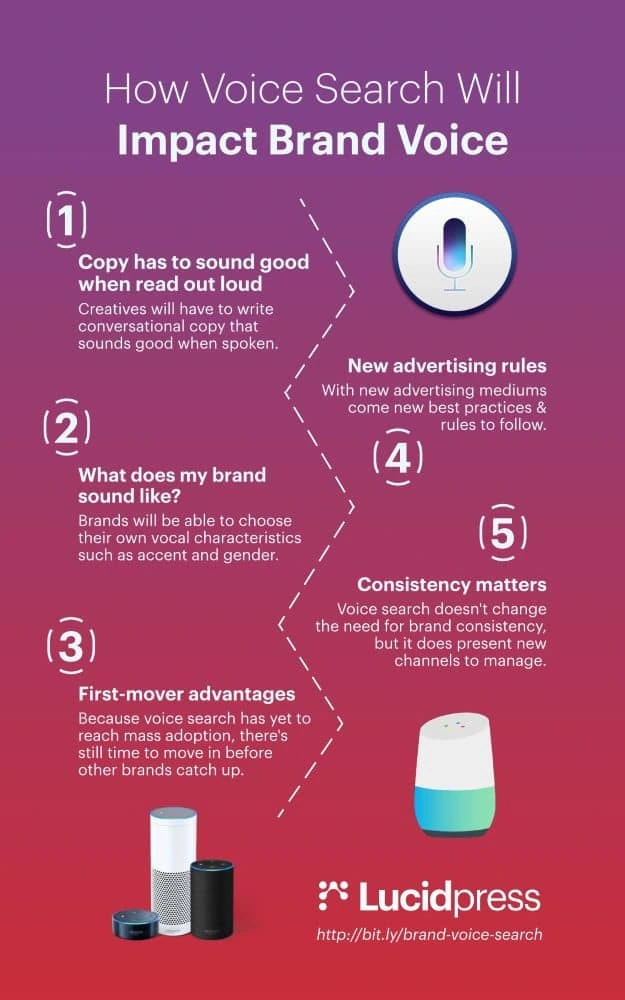
Okay, so you’ve recently made the conscious decision to focus more of your energy on creating content with the hope of collecting more leads.
As an avid devourer of content yourself, you’ve seen a ton of other brands leverage content to generate massive amounts of buzz for their companies.
You’ve heard the success stories and statistics. You know content marketing can drive in 3x as many leads as traditional marketing—and it costs businesses 62% less than traditional methods, too.
Related: 5 myths that devalue your content marketing strategy
So, you decide to give it a shot. You spend hours creating a number of insightful and informative blog posts that you know your target audience will find valuable. You post them on your site, sit back, and wait for the new customers to start rolling in.
But… nothing happens. Those blog posts? Nobody’s reading them. Or—and this might sting even worse—people are reading them, but it hasn’t made a lick of difference to the size of your customer base.
In either case, it can be incredibly disheartening to realize your efforts haven’t paid off as well as you thought they would. On top of that, figuring out where you went wrong can be rather difficult, which may lead you to throw in the towel on your content marketing initiatives before they even get off the ground.
Before you throw your hands up in resignation, though, let’s take a look at some of the most common reasons many content marketing campaigns fall short of their intended goals.
4 content marketing mistakes that may be costing you leads
Before we dive in, let’s admit that the true list of reasons a given content marketing campaign could fail is inexhaustible. Because so much goes into content marketing, Murphy’s Law can rear its ugly head at almost any given time, for many different reasons.
For our purposes, though, we’re going to discuss some of the overarching mistakes and problems that could sabotage your content marketing campaign before you even get started.
Not focusing on your true purpose
Presumably, your goal is to generate more leads (and eventually more sales) by publishing intriguing and informative content for your audience to devour.
But have you really thought about how creating such content will actually lead more people to purchase your product?
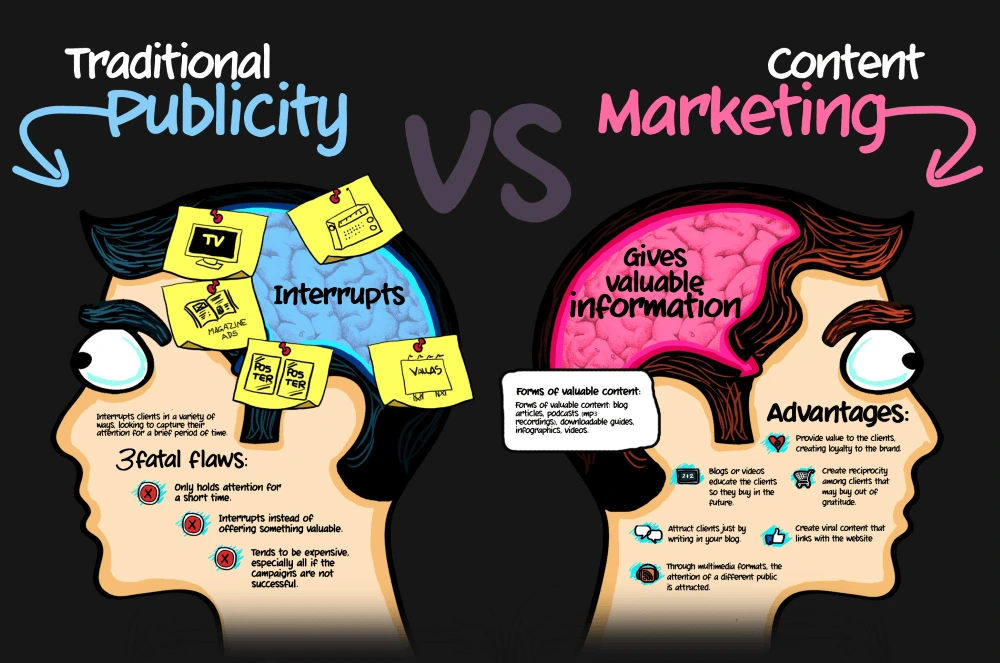
Source: 87 seconds
The only thing worse than seeing no increase in your visitor count is seeing an increase in your visitor count but no increase in your sales numbers.
As you begin creating content, it can be easy to lose sight of the fact that your purpose is to create awesome content that leads your readers toward conversion. It can be easy to slip into a routine of churning out pieces of content that, while interesting and informative, simply don’t do anything to move your readers further along the buyer’s journey.
Solution:
Ask yourself the following question before you begin creating any piece of content:
How will this content benefit my reader and bring them closer to conversion?
It’s essential to keep in mind that content is not your product; it’s part of your marketing plan. [] While the content you create absolutely should provide value to readers, it should also provoke them to take action and engage further with your brand.
For individual pieces of content, you might aim to get your audience to sign up for a mailing list, follow your brand on social media, or share the article they’ve just read. Depending on the context, you might ask them to sign up for a demo of your product. While such calls-to-action are typically found at the end of a piece of content, they can also be placed within the content as appropriate.
Over a longer series of content, your goal is to build your readers’ understanding and curiosity about your brand and the services you provide. As this article from Copyblogger points out, you can use content to create “open loops” in your readers’ minds that essentially keep them wanting more—meaning they’ll look for ways to engage with your brand that ultimately may involve making a purchase.
Always remember that your main goal is to have them come away from your content closer to converting than they were before they read it.
Writing for a mass audience
As the old saying goes:
“If you try to please everyone, you’ll end up pleasing no one.”
Unfortunately, when getting started with your content initiatives, it’s tempting to create content that you believe will appeal to your entire consumer base at once. In doing so, you end up creating content that is either:
- So general that it doesn’t provide value to any individual audience members
- So packed with information that it completely overwhelms your audience
In either case, the result will almost certainly be the same: your potential customers will bounce from your content without taking the action you hoped they would.
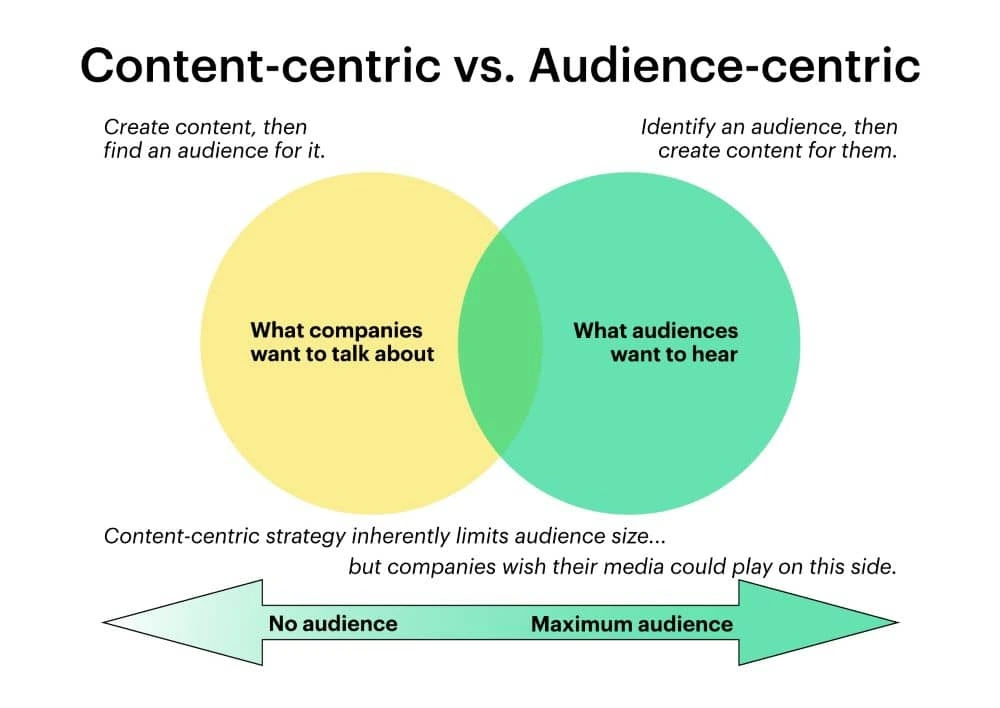
Source: Content Marketing Institute, lovingly recreated in Lucidpress
Solution:
First things first, make sure you’ve developed a variety of personas to target. Find out as much as you can about the people who belong to these segments: their demographic and geographic data, their personality types, and their actions and behaviors as consumers.
Once you’ve defined and developed a number of customer personas, you can begin planning content intended for each of them (rather than using a “one-size-fits-all” approach).
While this means you’ll be creating more pieces of content, you’ll ensure each piece of content will resonate with its intended audience.
You can make sure the right content gets in front of the right person in a few ways:
- Categorizing posts on your blog by topic
- Implementing a search function on your site
- Allowing mailing list subscribers to choose which content they receive in your newsletter
Focusing on one content format
Typically, when most people hear the phrase “content marketing,” they automatically think about blogs.
But there are many, many more types of content out there for you to choose from.
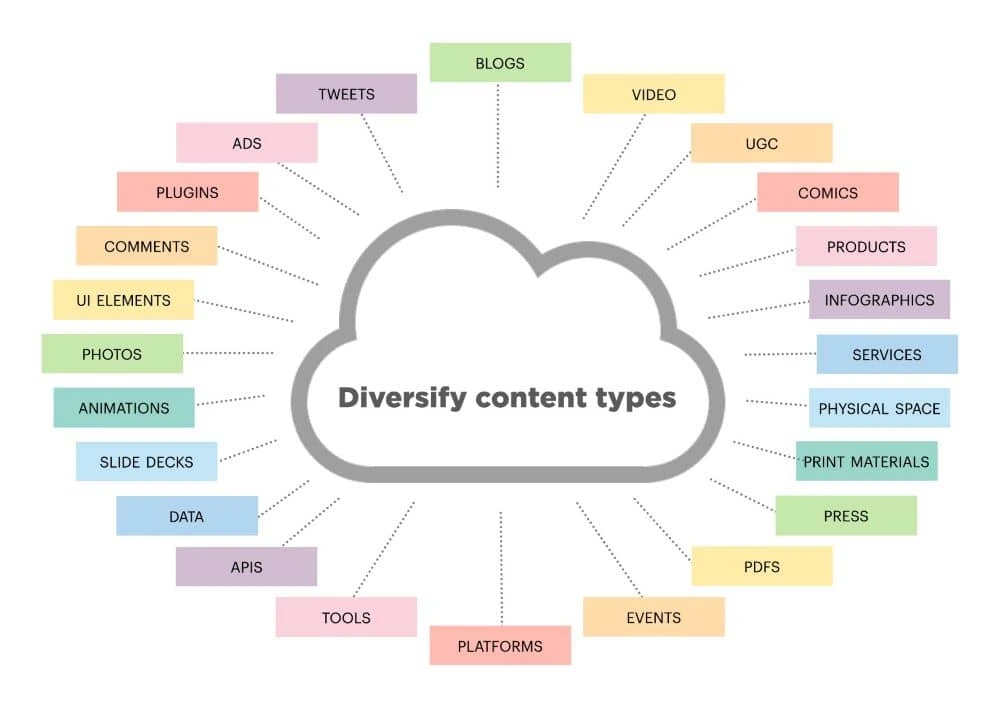
Source: iPullRank, lovingly recreated in Lucidpress
Content marketing is the act of using content to market your brand. With that in mind, the following are just a handful of content types that you can leverage for marketing purposes:
- Podcasts
- Webinars
- Social media posts (see templates)
- eBooks (see templates)
- Infographics (see templates)
Simply put, sticking to one type of content is a good way to bore your audience. No matter how valuable your blog posts may be, your readers will likely get tired of them at some point if you don’t change things up a bit.
Solution:
Your first order of business is to determine which formats will best engage your audience.
Some individuals devour podcasts on a daily basis during their morning commute, while others would rather read an eBook while relaxing on their couch at night. Still others might not have the time to devote to these ventures and would prefer to get quick-hitting information via infographic.
As you do when figuring out what your audience wants to know, it’s also important to determine how they want to receive this information.
Even though you’re going to create content in a variety of formats, that doesn’t mean you need to create completely new content for each. In other words, you can repurpose content you’ve previously created and present it through a different format.
You’ll definitely want to tweak the content so it fits its new platform, but generally speaking, the meat of the content will remain the same. For example, when repurposing a blog post into an infographic, you’d typically include only the hard-hitting facts and statistics mentioned in the article (leaving out the “discussion” parts).
By repurposing your most successful content in a variety of formats, you can give the piece maximum exposure across the customer segment it was intended for.
Not following up (or through)
In the intro, we set up a hypothetical scenario in which a content marketer creates a handful of blog posts, publishes them, then sits back and waits for business to start booming… and it never happens.
A big mistake many marketers make when starting out with content is living by the old adage, “If you build it, they will come.”
It just doesn’t work that way. With over 2 million blog posts being published every day, the chances of new readers just happening upon your content are practically zero.
But, even assuming you do generate some traffic to your new content, you still haven’t succeeded yet, and you can still miss out on major opportunities. Another mistake beginner content marketers make is failing to engage with their audience members after they’ve reeled them in. They also miss out on the opportunity to not only nurture these individuals through the buyer’s journey, but to learn more about their needs.
Solution:
The solution here is two-pronged.
First, focus on promoting your content. There are a number of ways you can do this, including:
- Sharing links via social media, adding relevant hashtags to the post
- Posting links in appropriate online communities, such as Reddit or Quora
- Engaging with influencers and bloggers who write about your industry to see if they’d be interested in sharing your content
Once you’ve gained some visibility and have begun seeing audience members engage with your content, don’t let them go. If they’ve left a comment on your blog, keep the conversation going; if they’ve shared your content on social media, shoot them a quick “thank you”; if they seem to be looking for more information, give it to them!
Technically speaking, once your content has attracted a potential customer, it’s done its duty. But the work you put into this content will be for naught if you don’t follow up with the lead as soon as you possibly can.
Key takeaway
It’s no secret that content marketing can be an effective way to attract highly qualified leads that have a good chance of converting. This is, in large part, why 92% of companies view their content marketing efforts as a business asset.
But if done haphazardly, your content marketing efforts can lead to nothing but wasted time, energy and money.
Before you dive into your next content marketing campaign, keep in mind that the purpose is not just to create amazing content, but to create amazing content that ultimately leads your audience toward conversion.
Learn how Lucidpress can streamline your brand’s content marketing and keep your whole team on the same page.
Are you emotionally connected to a particular brand? Maybe it’s the design of its packaging. Maybe it’s the colors they use or the shapes that remind you of something good. Maybe it’s the smell of the store. When you go into a small fragrance boutique, you’re mesmerized by a unique scent that sticks in your memory. Whenever you decide to buy perfume in future, you’ll prefer going to that specific store.
Why does this happen? When you understand the psychological theory behind the human senses, you’ll realize why sensory marketing is so important. Our senses are our connection to the outside world. Our brain interprets the messages they send and forms its perception of the world in accordance with those interpretations.
Related: The subtle art of using emotion in your visual content
Marketers can implement sensory experiences to make their campaigns more effective. With sensory marketing techniques, you lay the foundation for a positive brand impression. Let’s see how our senses influence our perception of a brand, so we’ll understand this approach a bit better.
1. Taste
Unless you own a restaurant or coffee shop, this is the sense you can influence the least. However, taste can still become an important aspect of your marketing strategy. For example, if you’re promoting an Italian brand of jewelry, you could organize a cocktail for your most faithful customers where you serve Italian gelato and wine. These tastes will remind people of the Italian lifestyle, and they’ll see how your jewelry fits in.
The sense of taste can deeply influence our memories, emotions and moods. A savvy marketer will find ways to use that fact to the campaign’s advantage.
2. Sound
You already have experience with sound affecting your perception of a brand. When you dine in a fancy restaurant, you want slow, calm music in the background, right? When you’re at a nightclub, the music that’s being played affects your experience. When you enter a store, the music can make you feel energized or relaxed, depending on the selection.
But it’s not limited to in-store experiences. Daniel Monroe of BestEssays explains how sounds are important even for online services: “The element of sound was crucial when we were designing the live chat. We didn’t want our website visitors to be disturbed, which is why the live chat is never activated without their request. When they drop us a message, however, they surely want to be notified when the agent sends a response, so the sound has to be noticeable yet subtle. It has to create a sense of urgency without making the website user nervous.”
Think: what behavior are you trying to encourage in your target audience? What kind of music would promote such behavior? Once you answer this question, it becomes easier to implement music and sound effectively in your brand experiences.
3. Touch
The sense of touch also influences our behavior. Research has shown that touching rough or smooth objects has an effect on our decisions. Hard surfaces, for example, evoke the impression of firmness, stability and security. However, they also impose a sense of strictness. They might be great for offices or banks, but you’d want to include a bit of softness in a store that sells products for kids, right?
Many brands neglect the sense of touch in their campaigns, mainly because they’re selling products that already have a particular structure. The way you design the packaging and space around the products, however, will have a huge effect on the brand experience.
4. Sight
This is probably the sense that affects our brand perception the most, since we first see a product before involving any other senses in the experience. That’s why brands invest so much effort and resource in visual content.
When you’re presenting your brand to the world, advertising and packaging have a huge impact on audience perception. This effect is heightened when all your branding is consistent and cohesive. Posters, social media posts, flyers, newsletters and other promotional materials should all share a similar design and color scheme. After all, those colors are rarely chosen by accident.
For example, when we’re trying to evoke optimism, warmth and clarity, we often reach for the color yellow. Orange is cheerful and fun (like Fanta), and red is bold and exciting (like Virgin). Blue evokes trust, strength and dependability—think Dell and HP. Green is peaceful and symbolizes growth and health, which is why you’ll find it in the logos and marketing of many environmentally friendly or healthy lifestyle brands.
5. Smell
Have you ever wondered why brands like L’Occitane and Lush sell their products in specialized boutiques? It’s because their marketing campaigns are based on the sense of smell, and they don’t want their scents being diluted by other products in the store. When you get to the Lush store, you’re so mesmerized by the smells that you simply cannot leave without a new bar of soap. That’s how powerful scents can be.
Even if your brand is not related to scents, you can still benefit from sensory marketing. Researchers found that the smell of chocolate can boost sales in bookstores. They observed the behavior of the customers and concluded that when the bookstore smelled like chocolate, people were more engaged with the staff and the books. They looked more closely at books, read the summaries, and lingered in the store. That’s not a coincidence.
The smell of chocolate is comforting and inviting. It’s no wonder why many real estate agents like to bake something in the kitchen before showing the property to a potential customer. They also make sure the property is clean and smells nice in every room.
Just as a pleasant scent promotes better behavior, an unpleasant odor will have a negative effect. If the store is dusty or smells funky, it won’t matter how awesome your brand and products are. The smell will distract visitors from taking the action you want to encourage.
Key takeaway
Our senses have a major impact on our purchasing decisions. Sensory branding is a well-established practice in some industries, such as cosmetics and food. However, brands from all other industries can benefit from this approach, too. Which sensory marketing techniques could you take advantage of in your next branding campaign?
Newcomers to the world of brand awareness marketing often feel overwhelmed or utterly lost. There’s a veritable plethora of channels, tactics & tools to explore. To make things even more difficult, some make much more sense for your business than others, depending on a matrix of circumstances.
Related: 7 things to consider before your next social media campaign
Before jumping into a brand awareness campaign, remember to ask yourself these key questions.
Is your content tailored to the right people?
You’re pretty sure you wrote compelling content… but is that actually the case? It’s time for a bit of self-reflection and honesty, which—while sometimes tough to swallow—is vital to the refocusing process.
One of the easiest mistakes to make in brand awareness campaigns is tailoring the content towards current customers. In reality, you’re targeting potential customers instead. []
The people you’re targeting likely have no idea who you are prior to seeing your ad. This is why the content has to be super compelling, either to draw them into visiting your site right away or ensuring that when they need a service or product like yours, you’re at the front of their mind.
The main things you need to include within the copy are:
- The unique selling points of your business—what makes you different from all of your competitors?
- How you can solve their problems—most consumers have some sort of problem (which is why they purchase services/products), so tell them how you can be the answer they’re looking for.
- A convincing call to action—whether this is telling them to visit your site, sign up for your newsletter or take advantage of a limited-time promotion or discount, tell people why they should act on their impulses now.
Put yourself in the shoes of your potential customers. What would you want to read? What would convince you to use your own product or service?
Marketers often forget to place themselves in the shoes of their target market and instead take a product-oriented approach.
Are you targeting the correct people?
Next, examine your target audience. Are you completely confident that you targeted the correct people? If your brand awareness campaign failed, then it’s possible you performed for the wrong audience.
Basing your target audience on your current customers seems like the place to start. They clearly love your brand, so people who share the same interests are your perfect target, right? Not necessarily.
In most cases, the audience you want to target is going to be slightly different. Before your current customer base found you, they were high-intent users actively searching for an answer to their problems.
In a brand awareness campaign, however, your audience isn’t likely to be high-intent when they first see your ads.
This is where you have to be creative; think about the types of people who may have pain points you can solve but don’t quite know it yet.
Think about the age range that’s most likely to face these pain points soon. Are there any geographical areas more likely to need your help? Are there any interests people have that could likely lead to needing you?
For example, if your brand specializes in decorating services, based on intent and life event options, you can target people who are moving soon or have recently moved. This would be more effective than simply targeting people who love decorating.
Are you tracking success correctly?
Finally, let’s review how you measure your brand awareness campaign’s success. You could run a hugely beneficial campaign, but if you’re focused on the wrong metrics, you may see it as a failure and not capitalize on it.
There are so many metrics you can use to gauge the success of a campaign that it can be difficult to know exactly what you should be looking for.
Success metrics should be chosen during the planning stage of your campaign, to give you a clear view of how the campaign should be structured and how you can get a sensible idea of the performance.
When you sit down to decide these metrics, use SMART goals and objectives. Many of you have probably already heard this acronym, but just in case, it stands for specific, measurable, attainable, realistic and timely.
Setting your goals this way will help you get an in-depth understanding of which metrics to evaluate when measuring the campaign’s success.
And when it comes to brand awareness campaigns, success can be harder to measure. Focus on top-of-funnel metrics rather than sales or conversions. When it’s over, don’t stop reporting just because the initial boost of traffic and engagement has died down. Remember that these campaigns can continue to pay off with gradual increases over time.
Common brand awareness mistakes
With so much on the line, you can’t afford to dive in unprepared. Here are 7 rookie mistakes that often fly under the radar yet profoundly impact your brand awareness strategies and goals.
Mistake #1: Scattergun approach
Spreading yourself too thin is an easy trap to fall into. You can’t please and cater to everyone—and you shouldn’t. In fact, attempting this futile endeavor will result in satisfying no one.
Case in point: many startups establish accounts on every social network they can, only to find that managing them all is virtually impossible. Even if you do post to every network with the help of automation, you’re not delivering a great experience tailored to that platform—and you’re likely missing out on a lot of engagement.
Instead, do your research to find a highly targeted market. Know who they are and understand their habits, wants & needs. You have to find where they are and spend time there, not in a hundred places where you desperately hope to stumble upon them.
Mistake #2: Passive social presence
A “build it and they will come” mentality does not work on today’s internet. You can’t just set up a website or social media page and hope to see customers eagerly interacting with your brand. First, you have to engage the audience. Responding to comments in a timely manner is a good place to start… but it’s only a start.
Come up with a content calendar and post on a regular basis. Talk to users and influencers, and ask them for opinions. Use your social presence to carry out customer service around the clock via instant messaging and other channels. Social media is about building lasting, meaningful connections that strengthen brand loyalty. You can’t simply stuff your messages with hashtags and expect magic to happen.
Mistake #3: Incoherent cross-channel strategy
Rookie marketers tend to lose sight of the big picture and how coherent their messages appear across different channels. This is not the way to build strong credibility and inspire trust. Successful brand marketing is deeply rooted in consistency.
This journey calls for much more than investing in a decent logo and slapping it everywhere you can. You will need to use elements like the color palette, fonts, visual identity, images, and voice to set the tone for your marketing campaigns. Tailor to the medium and the platform, of course—but never lose the integral pieces of your brand’s identity. [ ]
Mistake #4: Overcommitting to digital
Cost-effective digital platforms have unparalleled reach, but they are not be-all and end-all of brand marketing. Not everyone is tuned in to social media, apps and online search. Depending on your target market, you could work wonders with print collateral or merchandising.
In other words, you can let human psychology work to your advantage and leave a lasting impression by giving away branded office supplies, quality printed shirts, and other handouts. Don’t overlook the potential of printed media. You could reach a lot of people via brochures, business cards, flyers, newsletters, and other printed marketing materials. In the digital era, print is personal and memorable.
Mistake #5: Going all-in on advertising
Advertising is the mainstay of many brand awareness campaigns. However, it’s generally a bad idea to put all your eggs in one basket-especially if you’re a rookie who’s worried about wasting your budget.
What’s more, people have grown weary of aggressive pop-ups & ads, even when they’re targeted with laser-like precision. They install ad-blockers to completely shut them down.
Instead, try to start small and set aside a limited ad budget. Test your awareness campaigns over a course of few weeks and evaluate the results. Paid marketing works best when you prioritize ROI, so as you learn the ropes, gather data and scale your campaigns based on your insights.
Mistake #6: Misunderstanding content marketing
Viral marketing is one way to enter with a big bang, but directing all your efforts there is a double-edged sword. If you win, you win big. If you don’t, you get nothing. You’re probably better off crafting compelling, quality content on a consistent basis. Be entertaining, educational, and add value to people’s lives.
Once you start producing a stream of relevant content, you have to promote it. Bear in mind that you might not achieve immediate success. Don’t cut corners, and show patience. It takes time to gain momentum and traction. In due time, your efforts will start to snowball via word-of-mouth and social signals.
Mistake #7: Disregarding or copying the competition
It always pays off to scope out the competition. Doing this homework will show you what works for them—and what doesn’t. You gain valuable insights that help you set your brand apart. You should always keep an eye on what others are doing, but refrain from imitating them.
Looking and feeling like another business stirs brand confusion and slows the development of your own reputation. Instead, being genuine is the best way to win people over and keep them in your camp. That being said, you can still borrow good ideas and implement them in your marketing strategy. Just make sure you’re doing it in a way that’s fresh and authentic to your brand.
Key takeaway: Brand awareness by design
Effective brand awareness campaigns are hard to pull off. You have to put the right messages in the right place and serve it to the right people. Much easier said than done. There’s a lot of ground to cover without losing your footing and plenty of tools to consider.
Right away, put a sound strategy in place and let it guide your efforts across channels and platforms. Steer away from common mistakes that can bite off a big chunk of your budget and hinder your brand. Concentrate on turning curious visitors into prospects, prospects into customers, and customers into satisfied brand ambassadors.
In 2014, Marketing Sherpa published a report on customer acquisition costs (CAC) in e-commerce. According to this report, the median CAC is somewhere between $12 to $25. These costs add a lot of overhead to your business. If you’re a low-margin business, like most e-commerce stores, high customer acquisition costs can sink you fast.
Related: 8 killer email marketing tools for e-commerce
One way to bring CAC down is by building a bigger brand for your business. Branded e-commerce stores attract a lot of loyal customers. Such customers tend to shop several times throughout the year and are instrumental in improving profitability.
Let’s take a look at some strategies that can help e-commerce businesses establish themselves as a brand.
Establish stringent brand guidelines
The first step in the brand-building process is to establish stringent brand guidelines. These guidelines must include parameters like the “tone of voice” used in your messaging, logos, color palettes, fonts, photography style, and so on. Basically, it should cover anything used in your marketing materials.
To establish better brand equity, it’s important to accomplish two specific objectives. First, invest in building a style guide that will set you apart from the competition. This includes picking unique fonts and colors that aren’t common in your industry. You could also invest in creating unique image filters that will give your photos a distinct identity. Second, follow these guidelines across all your marketing channels: social media, website, TV, print and any other form of marketing.
A good example of this is Frooti, an India-based fruit juice brand. Although it’s not strictly an e-commerce brand, you can see that all their visuals adhere to a brand philosophy that includes flat design and a limited color palette.
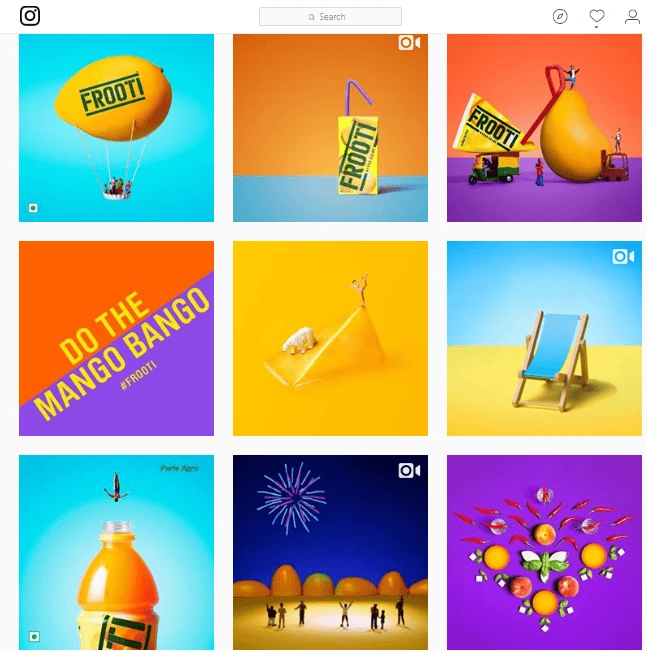
Source: Instagram
The reason this works is because your target audience tends to associate these visuals with your brand. This contributes to better recall and builds loyalty over time.
Pro tip: Lucidpress has a template-locking system that can help you adhere to brand guidelines consistently. Read more about it here.
Find your competitive advantage
There are many factors that contribute to an e-commerce sale. One of the most powerful ways to establish a brand is by identifying one factor where the rest of your competition sucks and mastering it. For instance, if you’re in a niche where the leading sellers take at least a couple days to ship, you might invest in overnight shipping. Alternatively, if all your major competitors charge for shipping, you could choose to offer free shipping.
This is exactly what Zappos did to establish themselves as the online shoe seller of choice. CEO Tony Hsieh realized early on that customers tend to have unique tastes for shoes, and in order to succeed, they’d have to make the return process ridiculously simple. The company provided its customers with prepaid return shipping labels that they could print for free returns. In doing so, Zappos outdid all competitors and established the most well-known brand in online shoe commerce.
The reason this works is because doing something better than others gets noticed by customers who then associate your brand with it. [] In addition to bringing word-of-mouth publicity, this strategy also gets your customers to return for future purchases. While such strategies can cost a lot of money, they also help to establish a brand name and improve customer loyalty.
Know your customers’ values
Learning your customers’ values means building a relationship with them that goes deeper than just producer/consumer. When people recognize and trust your brand, it’s because they see their own values reflected in it.
One of the easiest ways to learn about your customers’ values is simply to ask them. You could do some informal research on social media (or your blog) by covering certain topics and testing the engagement. Or, you could be even more scientific by conducting surveys and focus groups to learn more about the audience you’re pursuing.
After you’ve done this research, look back at your company. What do you already do that’s aligned with the values of your customers? These are the messages that will ring out the loudest.
When you can back up what you say with what you do, people will trust you and be drawn to your brand. [ ] Begin by looking for the values you already share with your target audience, then find ways to embody the others.
Know your brand story
For as much as things have changed in the world, people still love a good story. Whether it’s the story of a hero, an underdog, or simply the shared challenges and pleasures of the human experience, a good story moves people’s hearts and minds.
Every brand out there has a story—every one. The challenge is to share that story in a way that’s authentic and relatable. It might take some time to discover the best way to communicate your story to your target audience.
Start by zeroing in on your company’s purpose, or more specifically, the problem you solve. Let’s consider an example.
Say you manage an e-commerce brand that sells eco-friendly furniture and clothing. What’s your story? In short, you provide people with comfort and security in an environmentally friendly way.
But there’s something larger going on: climate change and the movement to address it. Your role in this global story is to meet people’s basic needs at a significantly lower cost to the environment. Your brand creates better harmony between humans and the earth, and people who care about the planet will want to help your cause.
In this example, your story represents and exemplifies your brand’s values. Positioning your brand as an environmental activist, or as a lover and defender of nature, will help you connect with your target audience. This powerful brand image comes from digging into the story, bringing to light what it really is.
L.L. Bean is a good real-life example of this. It started with a man designing his own pair of boots to make it easier and more enjoyable to walk around outside. But the larger story is about humanity’s love of nature. Through this narrative lens, you can easily recognize L.L. Bean’s brand. This is no coincidence.
Of course, your history might not be as deep as L.L. Bean’s, but it’s still meaningful. Take some time to find the best way to communicate your story, and it will clarify and reinforce your brand in the eyes of your customers.
Investigate influencer marketing
When it comes to ecommerce branding, customer trust is heavily influenced by the testimonials and referrals your business receives. Influencer marketing is one of the most effective ways to impact trust. This strategy involves hiring niche influencers (that is, social media users with thousands of followers in your industry) to spread the word about your brand.
Success with this marketing strategy relies on how targeted your influencers are. It’s a good idea to start small and reach out to influencers who have small audiences of less than 10,000—such influencers cost less and have a highly targeted audience.
Measure the impact of such a campaign and use the lessons to deploy larger campaigns. While partnering with large influencers outright might seem like a good idea to scale fast, these influencers appeal to multiple demographics and are thus not as targeted. The conversion rate from such campaigns tends to be lower.
The reason influencer marketing works is that prospective buyers tend to associate the credibility of the influencer with the brand they endorse. This makes it a much quicker way to establish a brand presence than growing your followers organically.
Pay attention to content authority
A typical customer goes through several stages of research before they land in your store for a purchase. Your store could miss on some real branding opportunities by not investing in content that the prospective buyer uses for research.
So, why is this important? First, it helps establish your brand as an authority in the industry. Customers trust authority sites which they return to for future product research. A comprehensive directory of articles could potentially make your website their “go-to” source.
It also provides your brand the opportunity to shape readers’ opinions and nudge them towards products in your store. Additionally, a comprehensive content directory helps your business rank better in Google searches, which reinforces your brand authority.
One of the best ways to do this is called the pair-up strategy. Essentially, marketers are advised to create a comprehensive content page that’s mapped to each of their product pages. Prospective buyers land on this central page during their research phase and are nudged toward the product pages through the content.
Key takeaway
Building a brand for your e-commerce business is an investment, but it’s one with dividends. By enforcing brand guidelines, finding your competitive advantage, and influencing buyers with great content, you’ll lower customer acquisition costs and develop an impressive reputation for your brand in the process.
Where to go next? Learn more about building & managing an online brand in our free eBook: How to build your brand in 2020
A well-designed website is a valuable investment that will generate revenue for your business—but 38% of people say they won’t explore a site if they find it unattractive. If your website hasn’t been updated in a while, your web design could unintentionally be hurting your business by turning people away at the door.
If it’s time to refresh your website, we’ve put together a list of 10 website design best practices and coupled them with the do’s and don’ts of great web design. Follow these best practices as you update your site.
1. Target audience
- Don’t ignore the users
Always keep your target audience in mind. Your point-of-view, as a professional, might be very different from that of the user. Pretend you’re visiting your website with fresh eyes. Walk through the user’s journey as they explore different pages. Focusing on this experience will help you create a user-friendly website.
Good design addresses the target audience with a brand personality users want to engage with. Check out this website, Crypton. It’s designed ideally for a tech-savvy audience.

Source: Crypton
Parallax scrolling heightens the user engagement here, but you don’t have to include parallax functionality on every website. Research your buyer personas and use design elements, functions and colors that make your target audience feel right at home.
- Do optimize for search
Websites that don’t rank well on Google and other search engines have very little chance of breaking through the noise. As you update your website and add new pages, make sure you’re following the most recent SEO guidelines. Your page titles, meta descriptions, and content are all important players in driving better search signals.
2. Layout
- Don’t create a cluttered layout
Have you seen websites that look like rows of boxes—all different sizes and arranged haphazardly? Would you spend more than two seconds sorting through it? Probably not. That’s because cluttered websites are visually confusing; the viewer doesn’t know where to direct their attention. A well-organized layout, on the other hand, guides the viewer where you want them to go.
- Do create a focal point
So, where do you want your visitors to go? It depends on the purpose of your website. An e-commerce site will drive visitors to purchase, while a SaaS site might drive visitors towards a demo or a free trial. Whatever purpose your website serves, make it the focal point of your homepage.
- Do use catchy headlines and call-to-action
The first things that attract a visitor’s attention when she lands on your homepage are the headline and call-to-action. Not the contact info, articles or product specs, but these two elements. For this reason, the more action-oriented your headline and CTA are, the higher your chances of success rise.
CTAs are designed to incite an immediate response from a customer. That’s why clear, concise CTAs are more effective. One software company reported that their site’s conversion rate increased by 106% after it got a makeover that included a clear, direct call-to-action.
3. Color scheme
- Don’t use all the colors
Using too many colors will make your website design clash. Colors have strong psychological impact, and they will affect a viewer’s opinion of your brand. If you’re unsure how many colors to use, the rule of thumb says your design should not use more than three colors. If you’re working with a brand palette, you might be able to use more, as long as you balance them well.
- Do use color combos that enhance your content
Your website’s colors should reflect the brand, complement the content, and visually delight viewers. [] Avoid selecting random colors just based on what you like. Instead, think about the brand and its users. If you have a primary color but don’t know how to make color schemes, you can use an automatic color scheme generator to help fill out your palette.
4. Text placement
- Don’t fill the page with long paragraphs
Just like the layout, you don’t want the design to be cluttered with text. If you have long-form content on the website, create a clean, spacious design that divides the content into readable chunks. You can do that by adding ample white space, using images, and creating proper flow.
- Do make it easily scannable
If your pages are easy to scan, you have a better chance of luring readers to the bottom. Attention spans are short online, but if you can make your content easy to absorb, readers will get more value from it. In addition to high-quality writing, use headings, bullets, quotes and blocks to emphasize the essentials.
- Do establish trust & credibility
Potential customers are less likely to enter their contact information or make a purchase if they suspect that your website is not secure or trustworthy. Communicate your trustworthiness by featuring customer testimonials, case studies, reviews, security badges and your privacy policy. Make sure your contact information is easy to find so visitors know they can reach you. All of these signals will help you establish trust and credibility as a reputable brand.
- Do communicate your value proposition
Use compelling language to convince and show readers how your brand will add value to their lives or resolve their problems. What benefits can customers expect to enjoy by making a purchase or signing up for your service? What features make your products better than what your competitors offer? If you can excite your visitors with your value proposition, you will see your conversion rates improve.
5. Search & navigation
- Don’t make it hard for users to find what they need
Everything on your website should be easily searchable. Whether it’s the sign-up form, the “About Us” page, or your contact information, readers should not have to spend more than a few seconds finding it. To make things even easier, include a search box so people can find things that don’t align with the page’s primary focus.
- Do set up proper navigation
If your site requires users to sign up, use colors to make the navigation simple. For instance, if your navigation headers are blue, make your sign-up button green or some other color. Organize your content into categories that users can browse if they like. You can also organize content on various hub pages.
With good UX, your website tells the world that you think clearly about the end user. See Crunchbase’s website; its UI is done beautifully. There’s the search bar on top if you want to explore specific results, or you can click the menu on the left side to browse sections that interest you.
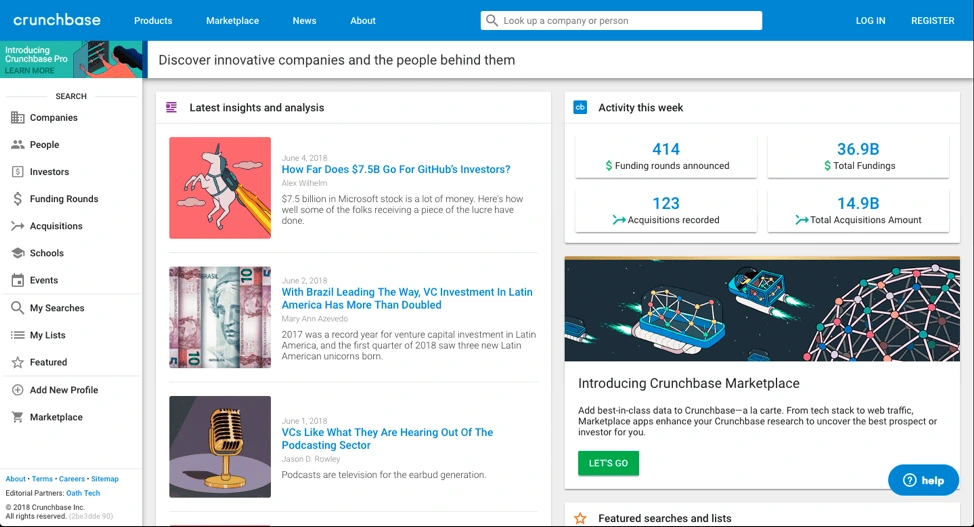
Source: Crunchbase
6. Fonts
- Don’t use too many fonts
A website that uses five different fonts loses users in seconds because it takes too much effort to read. Too many fonts on the screen can make a website look chaotic and unprofessional. The ideal number of fonts is three: one for main headings, another for sub-headings, and the third for the body text.
- Do select the right font sizes
Font size has a huge impact on legibility. It’s important that they’re neither too big (taking up half the page) nor too small (uncomfortable to read). The sizes of your fonts should reflect the importance of each element. For example, section titles and taglines are more significant than the body text, so they’re bigger. This helps readers scan the content, too.
7. Images
- Don’t use too many images
Too many images will crowd out your message, so use them sparingly and impactfully. Remember, search engines can’t read images very well, so don’t rely on them to convey text. If you’re using a background image, keep it under 1 MB. Large images slow down your site’s loading time.
- Do make it visually attractive
People think visually, which is why images are so effective. Feel free to use images in your web design, but find ones that are visually attractive, high resolution and not pixelated. Make sure the images you use reflect your brand’s personality. Don’t forget that you can also use textures and gradients to add visual appeal.
8. Mobile compatibility
- Don’t forget to optimize for mobile
57% of mobile users won’t recommend a website that’s not optimized for mobile. More people are browsing and shopping on mobile devices, and they expect websites to provide great mobile experiences. Invest in responsive or mobile-first design so you don’t miss customers during crucial moments.
- Do test for functionality
It’s not enough for your website to look good on mobile—it needs to be fully functional as well. Give your mobile users the tools to get things done, such as product search, store locators, service details, and more. If you can seize these opportunities, you won’t lose customers who are searching on the go.
- Don’t compromise on speed
People are not patient, and slow-loading webpages will almost certainly lead to a higher bounce rate. If your page takes longer than five seconds to load, it’ll frustrate your visitors and give them a reason to search elsewhere. To increase the loading speed of your webpages, consider removing any nonessentials, such as videos or large images that take extra time to load. Compressing images will also reduce loading time. Finally, utilize browser caching for storing cached versions of static resources to speed up your pages significantly.
9. Conventional vs. unique design
- Don’t ignore the power of convention
People are used to certain structures and formats on the web. This familiarity makes it easier for the brain to absorb content and make decisions. Your visitors shouldn’t have to be detectives to figure out who you are and what you offer. The power of traditional web design is that users will understand what your website is about with a single glance.
Your above-the-fold section should do the job
A Nielsen study says the majority of your website visitors will spend 80% of their time above the fold. That’s the section you see without scrolling—call it the opening screen.
The best websites explain what they do in this opening screen. A general practice is to use a headline (think your company’s tagline or mission statement), followed with a brief subtitle text describing your services or products. Top it off with a CTA button to direct visitors toward the next stage in your conversion funnel.
Airbnb does this brilliantly; the headline is the CTA. While there’s no subtitle text, their call-to-action is strengthened by a slideshow of awesome travel photos. Just beneath the headline, a search bar is intuitively placed. The example text in the search bar encourages interaction.
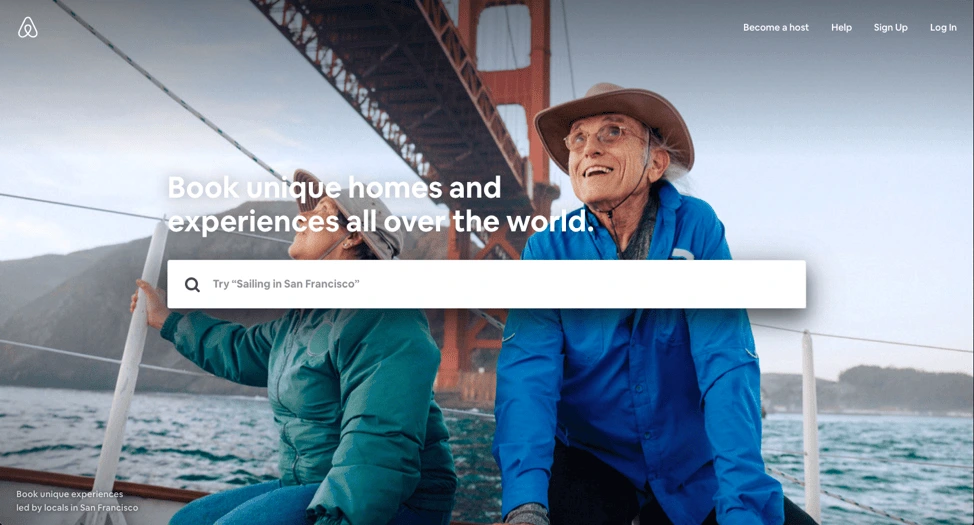
Source: Airbnb
- Do use floating menus
It’s very frustrating for users to have to move all the way to the top or bottom of a page to navigate the site. What many websites have now are floating menus: menus that move along the top or side of the screen as you scroll, making navigation a lot easier.
AMD, a giant in the computer hardware business, uses floating “share” buttons that visitors can use to share the content they find interesting across a variety of social sites like Twitter and Facebook. This helped AMD drive a whopping 3600% increase in social sharing, as more and more people found and shared their pages.
- Do be creative & unique
Still, you do want your brand to stand out from the crowd. Be creative, and use elements that make your site unique without disrupting the flow of information. Whether you experiment with moving images, video, or other design elements, try different things and monitor the results. You might be surprised what works.
10. Test it out
- Don’t forget to take it for a test drive
Once you’re done designing the site, test it to make sure everything is working correctly. Use multiple devices to navigate your website and see if it’s doing what it’s supposed to do. A user’s experience can vary depending on device type, internet browser, and location. Try to recreate different scenarios so you can catch any bugs or performance issues before they do.
- Do think like a CEO
A successful web designer needs to think like a CEO as well as an artist. This will help you view the website with business strategy in mind. Critical evaluation will give you a site that looks good, is user-friendly, and helps the business reach its goals.
Ready to design? Try Lucidpress today to create professional, compelling graphics for your brand’s website.
Marketing is getting tougher and tougher—there’s no doubting that.
With 41% of brands planning to significantly increase their marketing budgets this year, and customers becoming choosier than ever, you wouldn’t be alone if you’re exploring new techniques to get more out of your marketing cash.
Related: The complete real estate marketing guide
One strategy you should consider is SMS marketing, the process of sending short text messages to your ideal customers in an attempt to engage them with your campaign and get them to convert.
Even though average open rates for SMS messages beat email by a whopping 28%, your real estate company sells homes for a large price—unlike small-ticket items that can be purchased on a lunch break.
So, how can you make text message marketing your biggest driver of website traffic, leads and sales?
Here are the five steps you’ll need to build out your mobile real estate marketing strategy, as well as two brands who are already killing it with their text messages.
1. Determine who you want to contact
Just like any marketing strategy, you’ll need to base your mobile marketing campaign on buyer personas—a clearly defined document that lists details about your ideal customer.
For real estate companies selling student accommodation, that might include:
- People with less than $20,000 to spend
- Between the ages of 18 and 25
- No long-term commitments
- Currently living within 5 miles of the local college
Once you’ve got this to a T, you’re left with a bunch of shared interests. Use this information to find the people you want to target with your text messages.
2. Collect their information
The next step in your real estate text message marketing strategy is to collect the information of the people you’re targeting. You can do this by taking advantage of your other marketing strategies.
For example: why not run a Facebook ad, using the details you defined in your buyer persona, to encourage them to fill in a form? (You might need to offer an incentive to do this, such as a free ebook or a guide to purchasing a new home.)
But once you’ve got their information, don’t push the Send button just yet. You’ll need to have explicit permission from your prospect before sending an email, or you could land a hefty fine—and an unhappy buyer.
3. Choose an SMS marketing platform
While purchasing a new phone to send out your new messages is a great way to get started, it’s wise to invest in an SMS marketing platform from the outset.
That way, you can:
- Track various metrics after you send, including open and response rates
- Send SMS messages in bulk
- Personalize each message you’re sending
- View your strategy online, and share with other staff on your marketing team
Platforms like Text Local, Text Request and Textedly can help with this, just to name a few.
4. Select a text messaging schedule
Gotten to grips with your new software? Awesome! It’s time to make a start on your text messaging schedule.
You’ll want to put some thought into the time of day you’re messaging your potential buyers, and the day of the week they’re being delivered.
Why? Well, because texting your customer at 11pm could frustrate them—they’re likely to be asleep. However, sending an SMS message at 5pm could reach your customer when they’re on their daily commute with time to respond.
Find the perfect schedule by referring back to your buyer personas and filling out a daily routine for them.
Remember: You want to push your messages at times they’re unlikely to be busy—and have time to invest into their search for a new home.
5. Perfect your messages
Before rushing off and sending the first message that comes to your head, take some time to think about what you’re actually sending. You don’t want to send 10 messages only to find a spelling mistake, right?
Use key copywriting principles to make your sales messages as effective as possible, and focus on replicating your ideal customer’s language.
Going back to our example of student accommodation, this example:
“Ready to let your hair down at this years’ Homecoming? Make sure you’ve got somewhere safe to call home. Reply PARTY to find five local student dorms near Stamford from just $200/month.”
…would be much better than:
“With stunning high ceilings and low-interest mortgages, find student accommodation near Stamford to help with your studies. Reply YES to opt-in.”
Why? Because it’s avoiding the overused jargon that would push them away and making your real estate brand feel more relatable.
2 awesome examples of real estate companies using SMS marketing
Ready to make a start on your SMS marketing strategy and see tons of new leads roll in?
Here are two awesome examples of real estate companies nailing their text message marketing strategy to provide inspiration for your own.
1. “Text for more information”
Earlier, we listed collecting your potential buyer’s information as a key part of your SMS marketing strategy.
…But, what if you could collect their information by asking them to hand it over in a way that suits them?
This real estate company used this idea on one of their “for sale” signs, asking potential buyers to text a number for more information on the listing. It’s a fantastic way to personalize the texts you’re sending—and make sure you’re only focusing on people who are actually interested.

2. Asking for more information
Another fantastic way to engage your potential real estate buyers through text is to ask them for more information, based off the data you’ve already got from them—like this example:
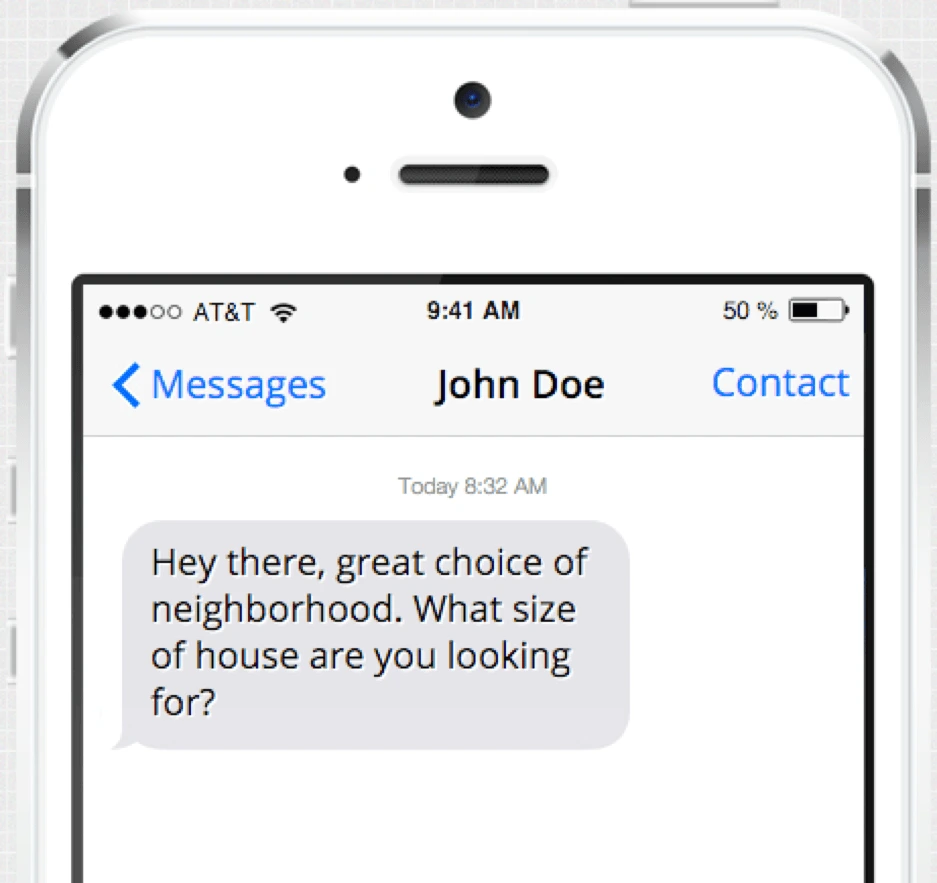
But, why does this work so well?
Well, the prospect doesn’t feel like they’re being contacted by someone out of the blue. They’ve mentioned previous information that’s already been shared (the choice of neighborhood), while asking for more in a way that prompts a response.
Key takeaway
Once you’ve made a dent in SMS marketing for your real estate company, we’re confident you’ll soon see a boost in new inquiries about your properties.
However, don’t forget that it may take some time to see results from your text message marketing strategy. Collecting customer information and perfecting your message can take a while, but don’t give up—you’re almost there.
Your brand matters. Learn how to protect and elevate your real estate brand in this branding essentials guidebook.
Every business owners’ hope is that their business will grow. Whether it’s a small, medium or large business, there’s always room for growth. It’s an exciting process, but it might be short-lived if you’re unable to manage your brand consistently.
Related: Brand consistency—the competitive advantage and how to achieve it
As you add more people to your team and start producing more content (such as landing pages, social media posts and ads), how do you keep everyone on the same page? How do you maintain brand consistency to keep your brand’s message clear and strong?
Here are five tips on how to do just that.
1. Create a brand style guide
With more employees and less time to look over every piece of content, it’s difficult to catch off-brand materials before they go out.
Create a brand style guide that shows employees how to use your branding properly. This will help your employees create on-brand content that shares a consistent look and feel.
Your brand is more than just the logo and colors that you use, so naturally, your brand style guide will cover more ground than that. Here’s a list of useful sections to include.
Mission
What does your company do? Lay the foundation for your style guide by first addressing your company’s goals and what you hope to accomplish in the future.
If you haven’t written a mission statement or want to spice yours up, here are some powerful examples.
- Patagonia: “Build the best product, cause no unnecessary harm, use business to inspire and implement solutions to the environmental crisis.”
- Walmart: “Saving people money so they can live better.”
- Wendy’s: “To deliver superior quality products and services for our customers and communities through leadership, innovation and partnerships.”
Target audience
Discuss who your target audience is. What’s most important to them, and why do they use your product? This will help your employees better understand who they’re talking to and why it’s important to communicate with your audience in a consistent way.
Values
When someone reads through your brand style guide, they should be able to relate to your brand and anticipate how your brand will respond in certain situations. This is why it’s important to have a section dedicated to the values of the company.
What values must come first in your company? By including these, your employees will know how to communicate with your customers.
Brand personality
Your brand personality comprises the characteristics you use to describe it. If your brand was a person, what would they be like? Professional, witty, funny?
If you’re struggling to think of characteristics that describe your company, survey your customers and ask them what personality traits they feel your brand has.
This helps bring your brand to life and give better depth to your brand’s voice, tone, messaging, and even its visual elements.
Visual elements
This section is where you put all the specifics regarding your logo, colors, typography and imagery. Provide as much direction with these elements as possible. For example, show each version of your company’s logo and describe how it should be used, where it should be located, when to use certain colors, etc.
For more help in setting up your brand style guide, check out our post on great examples of brand guidelines. You can also look at this 99designs blog post that goes into more detail about brand guidelines.
2. Pay attention to messaging & tone
Communicating with customers is often achieved through writing. Text appears on your advertisements, in your product, in blog posts and on your website—just to name a few examples.
Imagine how confusing it would be if you had a friend who always spoke with a Midwestern accent, but then one day, they showed up talking like a Californian surfer or a seasoned New Yorker? All of these accents are great, but you’d be pretty confused about what was going on with your friend. Could you even trust them anymore?
This is why consistent messaging is important for your customers. If the writing on your website uses a formal tone, but they receive emails from you that sound like a casual conversation, they’ll be wary—and rightfully so.
While creating your brand style guide, focus on describing your company’s tone and provide writing examples that fit your company’s voice.
When you read what other employees have written, give specific feedback about what is on-brand and what is not. Over time, they’ll learn which words, phrases and punctuation are appropriate for the brand.
3. Regularly train your team
Now that you have a brand guide for your employees, show them how to use it. If you don’t, your brand style guide will likely end up being ignored. If you can get your employees excited about your brand, they’ll be inspired to represent it well by following your style guide.
The opposite is also true. If you fail to get your employees onboard with your branding efforts, they may reject these new “restrictions.” This will promote more inconsistency and upset employees.
Keeping your brand consistent is a team effort that requires everyone to be onboard. Prepare an engaging presentation to introduce the brand style guide and strategy. Listen to their feedback, but make sure everyone understands the importance of consistency.
There might be a need for additional training for employees who are more involved in branding efforts such as writers, designers, marketers, customer service reps and managers. Once these employees are ready to build up your brand, ask them to share the same training with new employees as they onboard.
Keep an eye on the enthusiasm surrounding your brand. As it fades, you’ll have to recalibrate with reminders and additional training. It’s important for employees to know that you will champion the brand over the long term.
Key takeaway
When you focus on building a brand, the most important thing is to commit to it. No matter how well thought-out your brand is or how clever your messaging is, if it’s inconsistent, consumers will lose trust in you.
Create your brand guidelines, train your employees, find the right messaging and stick to it. The best companies in the world have championed their brands for decades. This consistency is part of their success—they’ve become familiar, beloved names for millions of customers. Lay the foundation for your brand today, so it can reap the benefits for years to come.
Want to know more about the impact of brand consistency? Download our free 32-page report, chock full of stats & great insights.
When you’re fine-tuning your brand, it’s important for everyone in your company to be on-board.
Let’s face it: Keeping your brand consistent is a tricky task—but it’s one that’s almost impossible if your staff aren’t fully educated about the strong brand you’re trying to create.
Related—Brand building 101: An 8-step brand development strategy
But, how can you keep everyone up to speed with the branding guidelines you’ve put together? In the modern age, when teams are becoming increasingly tech-savvy, an old Word document with a bulleted list of brand elements isn’t the way forward.
There’s one not-so-tiny thing that can help: a brand platform.
Here’s how you can create your own brand platform, and a free template to help you get started.
What is a brand platform?
Acting as the overarching document that includes important details about your business, a brand platform typically includes:
- Your mission statement: What are you hoping to accomplish through the products or services you’re offering?
- Your key values: What do you stand for as a company?
- Your brand’s tone of voice: Do you use slang in your communications with customers or stick to industry jargon?
- Your brand personality guidelines: Are you a fun and friendly brand, or do you talk to your customers professionally?
- Your visual branding elements: Which logos, fonts & colors are you using on your website and marketing collateral?
Every company, no matter what industry they’re operating in, should have a brand platform.
Why do I need a brand platform for my business?
It’s all well and good for me to harp on about brand platforms, but you want to know why this document is so important for businesses, right?
Here’s your answer: This central document helps to make sure everyone in your business is on the same page. From sales and marketing teams to creative departments, your business’s brand platform should be accessible by all employees, and clearly understood before undertaking any new marketing strategy or messaging.
This helps to keep your brand consistent—a tactic that has been proven to influence a 23% increase in revenue, on average.
In short: You’d be foolish to neglect it!
The perfect template for creating a brand platform
While brand platforms are critical, creating a document that is well-received by all members of your team isn’t an easy task.
However, we’ve created this brand platform template to provide inspiration for your own development. Simply open the template in Lucidpress and edit each element to match your brand.
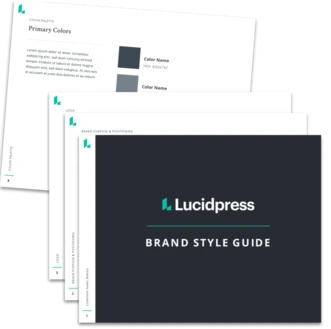
Download this free brand platform template.
3 tips for adding your own identity to this template
Now that you’ve got a template to base your brand platform on, use these three tips to add your own identity.
1. Dig deep into your business’s true values
Certain sections of this template require you to dig deep into the core of your brand—including the mission statement and brand personality sections.
So, avoid filling this section of your template with fluff. Remember: A strong brand has a strong reason behind the things they’re doing.
You could gain valuable insights for this section of your brand platform by:
- Interviewing your CEO or founder to discover why the company started, what problem it was created to solve, and what aim it means to accomplish.
- Asking co-workers why they enjoy working at the company.
- Surveying previous customers to unveil which company value prompted them to purchase.
The latter option is fantastic because you’re able to identify which of your branded elements have worked previously. For example, if you notice an overwhelming number of customers purchased because of your company-wide passion against animal testing, don’t miss out by failing to include this in your brand platform. It’s already proven to be effective.
2. Use your brand platform for every type of marketing activity
Planning to launch a Facebook advertising campaign? Looking to use Google Ads to sell more products? Gearing up to attend an industry trade show?
In any of these occasions, your brand platform is critical.
Why? Because a powerful brand is consistent. Think about it: One of the most recognizable brands in the world is Nike. I’ll bet their signature checkmark logo wouldn’t be as iconic if it wasn’t plastered across their sneakers, website and social media profiles.
So, use this consistency concept when doing any type of marketing activity. Encourage all members of staff to refer back to the brand platform when representing your company, and you’ll be on the road to a strong, powerful brand in no time at all.
3. Don’t try to be something you’re not
Did you know that 94% of all consumers are more likely to be loyal to a brand when they commit to transparency? Attempting to be something you’re not isn’t going to sit well with the people you’re working so hard to win over.
Going back to our tip on digging deep into your brand’s true values, pretending to be something you’re not—and fabricating your values to seem more interesting—shouldn’t be part of your brand platform creation process.
Instead, be true to your brand. Marketing to the beat of your own drum is much better than following the crowd.
Final thoughts on creating a brand platform
Are you ready to make a start on your brand platform and experience the benefits of consistent branding?
That’s great, but don’t let your hard work go to waste.
Make sure every member of your team is fully on-board with your brand platform before publishing any marketing materials—including social media posts, online ads or blog posts.
Whether you’re printing out the template and pinning it to your office wall or holding a company-wide meeting to explain each element, your new brand platform won’t be effective if it’s not being taken seriously. Be the champion your brand platform needs, and you’ll see results in no time.
Customer loyalty separates historically successful brands from the rest. Why do people consistently drink Coca-Cola or wear Nike sneakers? The answer is a simple one: Those brands have earned trust from their customers. Their products are of high quality, and their brand messaging has remained consistent, making it easy to cultivate brand integrity with customers.
Building integrity through your brand requires following the correct blueprint. You can’t build an entire house by following instructions on how to assemble a new sofa. In the same vein, building and maintaining brand integrity starts by using strategies that help you stay on-message and foster loyalty and recognition.
If you’re looking for the right blueprint, consider following these five guidelines to build and maintain your company’s brand integrity.
1. Choose the right products
One misstep can create a long-lasting negative impression for a brand. IHOP drove this lesson home when the company changed its name and logo to IHOB to announce new burger offerings on its menu. Customers and critics alike lampooned the decision, stating that the company had strayed from its breakfast roots. IHOP reverted to its old name and logo, and it claimed the move was only a temporary promotional stunt. Even if that’s true, it didn’t undo the negative publicity the brand endured.
The lesson here is simple: Choose the right products to maintain consistency in your brand message. Trying to go “off the menu” to deliver what you think is a better product could confuse customers, employees, vendors and other parties. Products should always feel cohesive and congruent with your overall brand identity. That consistency lays the foundation for brand trust.
2. Make customers your top priority
Customer engagement forms the backbone of any successful business. Your company gains strength by offering high-quality products and reliable services to its customers time and time again. It’s the cornerstone for building relationships of trust with those customers.
Dropping the ball can be a disaster. Customers notice when your company makes mistakes, such as producing inferior products or offering poor customer service. Such slip-ups can convince them to leave, which ultimately hurts your brand reputation and negatively impacts your bottom line.
One of the best things your business can do is to fulfill what your brand promises by putting your customers first. Start by
- Identifying their needs.
- Create solutions tailored to meet their needs.
- Keep communication open by hiring a dedicated customer support team and maintaining an active presence on social media.
Because when your business is approachable, customers are more likely to trust your brand to find solutions for their problems as they arise.
3. Be honest
Chances are, when you see an infomercial pop up on TV, you quickly change the channel. Why is that such a common reaction? The simple answer is that no one likes feeling manipulated.
Infomercials have a lousy reputation partly because the products featured are often long on promises and short on results. From cookware guaranteed to never wear out to miracle cures for a host of ailments, these products are often too good to be true. No customers enjoy feeling misled, and the brands associated with “As Seen on TV,” products often suffer the results of negative perception.
Your business should be wary of falling into the same trap. Always be truthful in advertising and other forms of communication with customers — respect their intelligence. Be honest about what your products and services can do, and play to their natural strengths.
Fostering integrity with your brand starts with honesty. If a customer can’t trust your brand messaging, how can you expect them to trust your business?
4. Employ realistic marketing strategies
Reckless marketing campaigns give the wrong impression about your brand to customers and employees alike. It’s tempting to kick the hype machine into overdrive whenever you roll out a new product or service. But bigger isn’t always better. If your marketing veers into uncharted territory by making promises your business can’t keep, the road back to restoring brand integrity can be long and treacherous.
How do you feel when a product works as advertised? It’s amazing! You want to give that same feeling to your customers and employees. Give them a reason to feel excited, of course, but make sure you’re still coloring within the lines. Focus on the real benefits and results of your products, rather than allowing your creative energy to devise claims that aren’t achievable.
5. Maintain a consistent moral code
Doing the right thing for the right reasons is not an antiquated virtue. Businesses who play dirty often end up looking dirty in the eyes of the customers they want to attract.
Understanding which values your customers cherish is essential. Take enough time to learn what those values meanwhile you’re conducting market research. Then, take it a step further and weave those values into the fabric of your brand.
If your brand has core values that define your company’s culture, stick to those values. Doing so fosters an authentic and favorable brand image. Betraying those values can do more to undermine your brand’s integrity than just about anything else. The last thing you need to do in a crowded marketplace gives customers and employees a reason to turn away and march into the arms of a competitor.
Key takeaway
Building and maintaining brand integrity is a long-term strategy for success, but the results are well worth the investment. By choosing the right products, putting customers first, making promises your brand can keep, and sticking to your company’s values, you build a long-lasting brand that customers and employees are proud to support.
Want to know more about how to build your brand? Download our free ebook on how to build a brand in 2020.
Like every other industry, real estate has experienced rapid change due to new technologies. Perhaps the area that’s felt the most impact is marketing. It’s imperative to keep up with how it’s evolving to stay ahead.
Although direct advertising methods are still popular in real estate marketing, they’re not the only way to help consumers change their minds. That’s where influencer marketing comes in.
Related: How to boost your brand identity with influencer marketing
Word-of-mouth is no longer limited to meeting people in person; it’s expanded to include social media, too. Influencer marketing in real estate aims to draw in potential clients with content they’ll find engaging and valuable. Here are five influencer marketing strategies your brand can try.
Don’t underestimate the power of Facebook
Facebook offers ample opportunities for influencer marketers to connect with audiences organically. For example, you have personal pages, business pages & groups, all of which can provide multiple touchpoints.
There are various content options, such as photos, blog articles and videos, through which you can engage potential clients. Facebook posts that get the most likes are creative, genuine and have your brand’s personality written all over them.
In addition, Facebook is proven to be a brilliant tool to expand your database and sphere of influence. Personal interactions, even a simple birthday wish, are a great way to reconnect with clients and remind them you’re available.
Work with a combination of influencers
Many brands make the mistake of pairing up with the wrong influencers. Not every influencer will work for you, so it’s best to realize this early on. Influencers can usually be divided into three categories: mega-influencers (celebrities), macro-influencers (well-known), and micro-influencers (niche).
To determine which influencer would be right for you, you need to define your target audience. Are you looking to attract families and professionals? Perhaps millennials? People tend to follow influencers that represent the lifestyle they hope to achieve.
Many real estate brands choose a variety of influencers to maximize their reach on different platforms. The best influencer would be the one who’s most relevant to your campaign and can reach the most significant potential audience.
Be creative with video marketing
Video marketing, today, is a force to reckon with. Video marketing stats show 84% of consumers choose to buy something after watching a video and, by 2020, 82% of all consumer web traffic will be video. Compared to content that’s text-based, video has proven to be very effective and is perhaps the biggest trend for content marketing this year.
What does it mean for real estate brands? Well, it means more creativity. Audiences aren’t interested in the same old content anymore and are looking for something that’s authentic and hits home. Videos seem genuine, are fun, and add a degree of reality to the business.
A brilliant example of video marketing is Bedrock Real Estate’s “Anthem of Us” to encourage purchases in the Detroit area. The award-winning video starts off with a voiceover by rapper Big Sean (a native of Detroit) and highlights its culture and, most importantly, its people.
The video employs the use of a mega-influencer and multiple micro-influencers, a combination that hits the bullseye. Big Sean’s voiceover would be not worth sharing if it weren’t for the local people & businesses whose promotion led to the video going viral. The micro-influencers played a massive role in the campaign gaining ground locally, so if you’re aiming for a regional campaign, then local influencers might be more effective than international ones.
Related: Real estate video marketing — The ultimate content marketing tool
Build long-term relationships
With the growth of influencer marketing, the demand for influencers is at an all-time high. The number of brands getting in on the game has led to a rise in cost. In the past, brands could get away with free products as a form of compensation—not anymore.
Today, brands have to invest more time and effort in working with influencers. Once you’ve built a healthy relationship, you can ask them to promote your content. Perhaps the best way to get a referral is to make your influencer a client and have them share their own positive experience with their followers. There’s nothing more impactful than a genuine review.
Invest in Instagram
Last year, Instagram ranked as the best platform for influencer marketing campaigns. There are over 800 million users using the app every month, and that number is still rising.
Influencer marketing is likely to cross $2 billion by 2019, and Instagram is the best platform to use for brands and influencers alike. Its visual nature inspires you to get creative with your content and grab the attention of your target audience.
The best content on Instagram doesn’t just flaunt your product; it flaunts your personality. Don’t just post pictures of luxurious houses—post pictures of what makes it a home, too. How about a dog in the backyard? Or people enjoying food at the open house?
Influencer event marketing, in particular, is gaining momentum and is something you should start thinking about. Host an event and invite people with large followings to attend. The influencers are then responsible for creating engaging content that will drive awareness for your brand.

Source: Instagram
For instance, look at the photo above. Isn’t it gorgeous and fun? Would you believe me if I told you it’s from an open house in Los Angeles and the woman in the photo is an influencer?
The open house was set up in the most Instagram-worthy fashion and encouraged social media sharing. These real estate professionals understood the importance of making open houses seem less like what they are and more like a fun, eye-catching event that’s worth telling your friends about.
Key takeaway
Influencer marketing can boost your brand awareness efforts and be a valuable addition to your content marketing arsenal. The right influencer and the right platform are bound to set you on the road to success.
It’s something you’ve been told to do for years, as far back as your high school English classes: Define your voice. Voice is sometimes talked about as some ineffable je ne sais quoi. It’s something that’s felt more than defined.
Related: Branding? Follow this template for creating a brand platform
But in reality, voice—the elements of personality that make a brand or person so distinctly themselves—can and should be defined. In fact, according to the Nielsen Norman Group, voice can have a huge impact on how much consumers trust or care about a brand. And that matters, because customers are far more likely to spend money with a reliable brand than an unreliable one.
What is brand voice?
Brand voice specifically refers to the content your business publishes online, in print, and anywhere else. It’s made up of the words you use and how you choose to use them—in other words, it’s the voice with which your business speaks.
Not sure what your brand’s personality is or should be? Here are five tips to help you define and sustain your brand’s voice.
1. Spend time putting words to your brand voice
While this step might look simple on the surface, it’s something a lot of companies overlook. If you want your brand’s voice to be consistent and scalable for growth, you have to clearly document it.
Begin with a voice tool as a starting point, or simply play through a few improv-style scenarios, feeling out how you and other stakeholders would expect the brand to respond in a given situation. As you launch new products, would your brand message contain more excitement or confidence? When customers write in for support, is it more important for your staff to be appeasing or authoritative? Which main values or interests do you want your messaging to regularly drive home?
Carefully document the responses, then identify any patterns or trends. Narrow down your list to a core set of descriptors (between three and five). From there, you can construct statements highlighting what your brand identity is and isn’t. By establishing and documenting the foundation of your company’s voice, you have a point of reference for any future communication or branding.
MailChimp’s voice and tone guidelines are a great point of reference for how to do this. The description is fairly brief, but each word gets a lot of work done.
2. Create consistency in every bit of content and copy
A truly effective voice requires consistency across all messaging. No piece of copy, content or communication should stray from that core persona, or you risk hurting how consistent your brand is perceived. And given that consistency can provide a 23% revenue increase over brands that lack it, inconsistency is one mistake you really can’t afford to make.
Take Cards Against Humanity. Every piece of writing in its games and on its website bursts with snarky sarcasm. The company has even set up training to ensure that support staff can meet customer needs without losing the signature sass that has come to define the brand’s voice.
If you want to follow this model, share the brand guidelines you established in the point above so all staff members know what is and isn’t allowed. Set up QA processes to make sure that everything aligns, from your social voice to your customer support voice. Specific tone can differ to suit different situations, but the central voice that defines your brand should remain constant across all communications and posts.
3. Raise your brand’s voice through proper channels
Everyone has that one extended relative—a grandma or a great aunt—who uses Facebook in a way that’s just a little bit off. And that’s exactly what you want to avoid. Because in a lot of ways, where you share your message matters almost as much as what you’re sharing.
The reason for this is twofold: First, it makes good financial sense to put brand resources and time where they will have the most impact. Second, and maybe more importantly, the platforms you use can impact how your brand’s voice is perceived. A teen-focused brand posting primarily on LinkedIn will confuse a lot of people; the platform lends itself to more formal business voices. Forcing a casual, slangy brand into that mold could be a recipe for failure.
Influencer marketing and advertising deserve attention here, too. If your strategy involves partnering with influencers or celebrities to sell a product—and there are plenty of good reasons to go this route—pay careful attention to how and where they share their messages. You can’t demand that an influencer change their persona to advertise your product without defeating the point of influencer marketing. Instead, spend some time listening to and watching the people you want to partner with to find someone who naturally matches your brand’s voice.
For a great example, look to underwear brand TomboyX. The brand works hard to speak to the LGBTQ+ community in a voice that feels human, confident and aware. TomboyX found an ideal voice pairing in Cameron Esposito, with an influencer-esque ad that plays during Esposito’s podcast, QUEERY. The ad, which involves Esposito giving a positive review of her own experience with the brand’s product, sounds genuine and real, perfectly harmonizing with TomboyX’s voice.
4. Walk the talk
As we’ve discussed, content and copy are huge parts of brand voice definition—but that’s not where consistency ends. For a voice to feel honest and genuine, it has to be backed up by other brand elements, including visuals and products.
A lot of beauty and fashion brands have pivoted to include more “natural” messaging in recent years. “Organic,” “pure,” “unretouched” and similar terms have gone beyond slogans and now feel baked into brand personas. But, how many brands succeed when it comes to backing up those words with concrete action, both in terms of visual advertising and product offerings? Not many.
That’s part of what made American Eagle’s recent #AerieREAL campaign so refreshing: The brand translated its voice and values into its ad campaign photography. For many consumers, this was the first fashion campaign they’d seen that included models with disabilities—real bodies wearing the product they were advertising.
If you really want to sell your brand voice, you have to back it up. Otherwise, even the strongest voice will start to ring hollow.
5. Don’t be afraid to—consciously—grow and adapt
Finally, adjust your voice as your brand grows.
That’s not a call to revamp everything at the drop of a hat—constant rebranding won’t do much to help encourage company recognition or loyalty. But an occasional and purposeful shift to respond to a growing market or changing attitude can and should be encouraged.
A particularly relevant example of voice evolution is Soylent. It started out as a niche, DIY-focused product with a voice that spoke primarily to busy engineers and developers who cared more about the function than the form of what they were eating. The creator himself said that even the brand name was designed for “encouraging further discussion and thought,” solidifying the brand’s methodical, analytical voice.
However, as the product picked up new followers and expanded into new markets, that voice changed. It holds on to some of its original directness but now brings friendlier reassurance to the table. What once read as intentional austerity now feels more palatable.
Since the change, Soylent has seen more commercial success, moving into markets on Amazon and college campuses. It’s unlikely that it would have seen that level of success without some voice adjustment to better speak to its newer, larger audience.
Key takeaway
There’s no denying that it can feel daunting to establish your brand’s voice in a world that already seems saturated with a lot of noise. But, it’s not all about volume. Use the tips above to build a voice that resonates with your audience, and reap the benefits of better brand recognition and a better bottom line.
Before the rise of social media platforms, marketers relied on evergreen content. Evergreen content is content that’s always interesting, valuable or relevant to readers.
In contrast, ephemeral content is content that’s designed to last for only 24 hours. Snapchat, Instagram Stories and Facebook Live are all examples of places to post ephemeral content.
Related: How to use memes for social media marketing
The psychological concept of FOMO (the fear of missing out) makes ephemeral content great at increasing customer engagement.
Here, we’ll discuss how you can take advantage of FOMO to build your brand with ephemeral content.
Why should brands create ephemeral content?
When Snapchat came to smartphones, many people didn’t get it. What was the point in making a video or a photo that would disappear?
At that time, content creators focused on creating evergreen content to capture the interest of readers and stand the test of time.
Although evergreen content lasts, ephemeral content offers a sense of exclusivity. If you miss it, you miss it for good.
By making content ephemeral, you can keep your audience on its toes. They don’t want to miss out, so they pay attention. And on the internet, attention is king.
Large brands are already taking advantage of FOMO with their content. In 2016, an estimated 21% of BuzzFeed’s total traffic came from Snapchat views. As of 2018, Instagram Stories has an estimated 400 million users.
If you don’t get in on this trend soon, you’ll be the one who ends up with a bad case of FOMO.
How to use ephemeral content effectively
Ephemeral content offers unique ways to engage an audience. There are several different strategies you can use, depending on your preferred platform. Here are a few of them.
Reach out to your users and make them feel special
First, you have to reach out to your users. There are two good ways to do this: remarketing and influencer marketing.
If you’ve already established contact with your users, you can try remarketing. Use remarketing to announce new products, sales or discounts on products or services they’ve bought before to keep your audience engaged.
If you haven’t reached your audience yet, you can tap influencers to attend expos or invite-only events. Provide opportunities for them to take great pictures and try out your product. These influencers can then share their experiences with your brand via their social media accounts.
Keep in mind that not all fans have the clout or money to go to these events. Instead, you can give your regular users a “sneak peek” that not only makes them feel special, but also makes your brand feel real and authentic.
Be authentic and humanize your brand
Speaking of authenticity, one of the things that makes ephemeral content attractive is that it feels more real. However, to do this, you first have to know who you are and what you want to do as a brand.
According to Shopify, putting to paper the intangible facets of your brand (e.g. principles, philosophies, etc.) “should provide an ample introduction of why you’re in business, why you’re different, what you have going for you, and why you’re a good bet if you’re asking for an investment.” These will give you a guide for how to appear more authentic in your social media posts.
But, it’s not enough to know who you are and why. You also have to run your brand in line with your identity. When you have an identity and stick to it, it’s reflected in your content. Users like seeing employees at work behind the scenes—or real people using products in their own way. Take advantage of this and show users the unpolished side of your brand.
Keep your audience on its toes with live video
Live video is one way to show your audience that you’re authentic. But aside from that, it hooks them immediately.
When you use live video, your users are the seeing it at the same time as everyone else. According to Facebook, users spend up to three times more of their time watching live videos than non-live videos.
Here are a few ways to use live video:
- Show what goes on behind-the-scenes. You can show snippets of processes in your business, or company culture by showing staff in their element.
- Training videos. These videos are great for technical or creative brands. You don’t have to do full training sessions. Instead, you can treat users to related tips & tricks, Q&As or how-to guides.
- Contests or giveaways. These would not only reward loyal customers, but they can bring in new customers, too.
- Share live events. Not everyone has the chance to attend exclusive events. Live video lets you share memorable event moments with all your users.
Facebook Live is a popular platform for live video streaming. If you plan on using Facebook for your live videos, make sure you know when the best times are to go live so you can get the most engagement.
Get your users involved with a call-to-action
In the end, you want your users to do something. That’s why you include a call-to-action.
With ephemeral content, the call-to-action is usually a link to a landing page. Because ephemeral content doesn’t last forever, you need to make your CTA clear and concise.
Make sure you tell your audience exactly what you want them to do. “Click this link!” and “Swipe up!” are good examples of clear calls-to-action.
Best platforms for ephemeral content
Now that you have an idea of how to maximize ephemeral content, it’s time to decide which platform to use. Each platform has its own features and user base. Here’s a short breakdown of three popular platforms.
Snapchat
Snapchat is popular with younger users, so you should consider Snapchat if they’re your target market. Snapchat uses Snapcodes, which are QR codes users can scan to follow brand profiles. Snapchat also has geo-filters, which can be used for time- and location-sensitive events or promotions.
Facebook has a huge user base that’s varied in demographics. If you plan on integrating ephemeral content with a brand page, Facebook is the way to go. Facebook Stories gives users a way to enjoy ephemeral content without clogging up their newsfeed. It also allows you to supplement your ephemeral content with posts on your main page.
Instagram has a huge user base. In 2017, Instagram Stories had more than 200 million daily active users, a number that’s doubled since then. If your brand is visual in its marketing style, Instagram is worth a look. You’ll be able to supplement your photo feed with Stories. Instagram also allows in-story links, making calls-to-action easier for users to follow.
Key takeaway
Ephemeral content is a trend that isn’t going away soon, even though these posts only last for 24 hours.
If you’re looking for a new way to engage your users and keep them interested, ephemeral content is something you should think about. Are you already using ephemeral content? How is it working for your brand? Show us your favorite examples on Twitter by mentioning @lucidpress.
Why did you start your business? We’re pretty sure it wasn’t because you wanted to sell one product every blue moon, or because you don’t care about the services you provide.
Let’s be honest: We all want to make a difference, and we want to be recognized for delivering exceptional experiences. Without a positive reputation built on genuine feedback from satisfied customers, you can wave goodbye to local or worldwide recognition.
You’ve probably noticed that bigger brands tend to have this nailed down. You see that red-and-white logo and instantly recognize Coca-Cola, or that blue background and yellow text belonging to IKEA. Even those multi-million-dollar brands had to start from somewhere. How on earth do you create something memorable—something that a customer will recognize and trust right away?
One answer is product packaging. Packaging is the first thing someone will notice on a shelf or when they receive a delivery to their home. The more they relate to it, the more likely it is that they’ll purchase or recommend it to others.
However, before you reach stardom, there are several ways to increase the chance of getting noticed. From the way you speak about your brand to how you package your products, here’s how to tell a memorable brand story.
Write your story early on
Before you get too far in with your products, button up your brand story. Keep in mind that a business is generic and faceless without its history, values, mission, vision and personality.
To refine the story you’d like to convey to the public, ask yourself some of these questions:
- What beliefs drive you and your company?
- What makes your business and product unique?
- How would like to see the business a few (or many) years from now?
- How can your products change the lives of your consumers?
Once you’ve answered these, it’ll be easier to focus your brand story—and that story can inform the choices you make with product development and package design.
Give your product a persona
Don’t think of package design as just a way to deliver your product. To truly convey a message, a story or a brand identity through your product, you should think of it as a person. That’s right, just like in marketing, you’re creating a persona—but this time, it’s for your product. This is where brand personality comes in.
By thinking of your product as a person, it’ll be easier to design packaging that reflects the brand personality and resonates with your target audience. Potential buyers will notice that authenticity and gravitate toward the product before they even realize what it is. They’ll know that it’s been designed for them.
Colors draw in the customer
Without color, the canvas is blank. A customer won’t look twice at your product if it doesn’t stand out to them in the first place.
Think about what feelings you want someone to get from your product. Should it make them feel like having fun, like a quirky craft beer? Should it make them feel cared for, like a health-related product? Make a list of how you want your product to make customers feel, and find ways to translate that to your packaging.
It can be easy to match colors with feelings: calming blues, bright yellows, passionate reds. A customer could be drawn to a certain color, depending on what they’re looking for. Colors can help you convey your brand identity, as well.
Who is your audience?
As with any form of marketing, keeping your audience in mind throughout the process is a must. Who will buy your product, and what product packaging will appeal most to that particular audience? Think about colors, shapes, sizes—even the wording on each individual product’s package.
Customers often read the text on a product to reinforce their purchasing decisions in their minds. [ ] For example, younger audiences prefer brighter, eye-catching colors with quirky shapes and blocky fonts. Older audiences who purchase luxury products prefer colors like black and gold, combined with elegant fonts and sophisticated language. It’s all about knowing who you’re selling to. Once you do, the rest will come far more easily.
Delivery boxes
No matter the size of your business, it’s not only important to have great product packaging on the shelves. When a customer makes a purchase online, they should feel the same excitement for their delivery as they do for the product in the box.
Depending on the size of your business, you might need to batch-order boxes for delivering your products. Businesses often need extra help to meet customer demand. BCS box-making machinery can help to create quality, durable boxing that makes an impact.
Consider sprucing up your boxes with custom-branded stamps, tape and delivery labels—as well as adding extra protection for your product inside each box. Think about padding, branded freebies, and money-off coupons as ways to encourage repeat purchases from your customers.
Logos & graphics
If you’re not including your logo and other branded imagery on your packaging, how do you expect a customer to know it’s you? When people see a familiar logo, they know almost instantly whether they trust that business enough to buy the product.
Graphics, although not always brand-specific, can often make or break your product packaging. If you’re selling healthy products, you’re more likely to succeed with a green, leafy design. Think about what works, and use a bit of common sense to gauge how you want the product to come across.
Product blurbs
Your brand story is important. So important, in fact, that many businesses make space on their product packaging to write a little about how their business started. Other companies write about their values, such as Lush and their natural, eco-friendly approach.
You can probably think of a few other examples of brands who do this well—which means they’re doing things the right way. The care and effort you take here will pay off when customers remember your story and take it to heart. Shoppers will appreciate an attractive design with an inspiring blurb more than one with a cut-and-dry description. Don’t forget that it’s often the packaging of a product that sells it, not just what’s inside.
Don’t over-design it
It’s easy to succumb to this temptation. In trying to make a product the most eye-catching or unique, some companies over-complicate the packing design. Sometimes, these products luck out and sell well, but they do little to build or reinforce the company’s brand.
Don’t get too carried away with embellishing your packaging designs. Stick with simple, clear concepts that your audience will easily understand. Often, it’s the most simple and well-thought design that wins out in the hearts and minds of customers. []
Be consistent
According to famous designer and author Robert Brunner, “Everything you do creates the brand experience. Ergo, design is your brand.”
Just as it’s important to maintain brand consistency in your marketing, it’s important to design product packaging that’s consistent with your brand’s identity and values.
We’re not saying you should slap your logo on everything. But you do need to design concepts that reflect your brand—concepts that could be informed by the logo, typography, color, etc. Even if your product doesn’t share the aesthetic characteristics of your brand, it should feel congruent with its values.
Invest in packaging
Don’t underestimate the power that packaging design can have on your brand. Because your packaging often sparks the first connection between a customer and your product, it’s often the first experience they’ll have with your brand.
On top of the time and money spent on product design, you should also carefully consider your packaging. Design packaging that stirs up emotions of excitement, joy, delight or amazement. Once you’ve created packaging that instantly connects with your customers, your brand awareness and recognition will benefit.
Key takeaway
An effective brand will help sell products and attract customers. If you want your customers to get excited about your new products before they’re even announced, build a strong brand using these concepts.
Bonus: Product packaging infographic
Want a few more tips and pointers on the importance of product packaging? Check out this data-packed infographic from our friends at Uppercut Box.
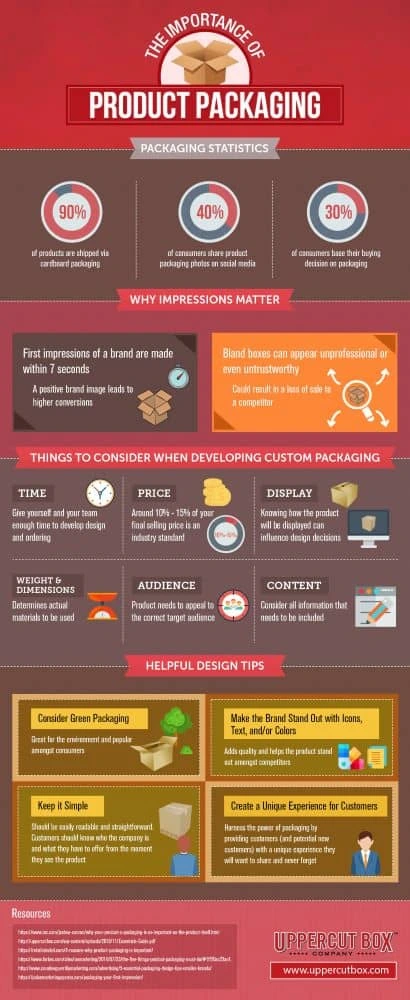
Why talk about sustainability?
You’re probably fed up with the terms “millennial” and “Generation Y,” but they’re still helpful when describing that particular group of consumers.
For example, one trend that keeps popping up is their desire to buy from brands brave enough to set standards of behavior and live by a set of principles.
Related: 5 content tactics to ignite brand engagement with millennials
I’m a millennial, and for the first time this year, I was able to go to my local zero-waste store and buy travel toiletries for my summer vacation. I even paid a lot more for the privilege and left the store with a fuzzy feeling and a huge smile. Does this sound unusual? Trust me—I’m not the only one in my peer group who looks for opportunities like this.
If you’re looking for more reasons to build your brand around sustainability—and examples of brands that are doing just that—read on.
Boosting that bottom line
If you want to show the market that your company is in it for the long haul, having a sustainability strategy is a case of when, not if.
We know that 75% of millennials millennials say sustainability is a shopping priority, more than any other group. [] Yes, we came of age during the Great Recession and aren’t the richest generation (hello Boomers), but we are getting wealthier. And, importantly, we are willing to pay more for things that matter.
The problem with sustainable business practices is the misconception that being good equals less revenue.
Even Forbes agrees that you can earn better returns from investing in good companies. If you’re not positioning your company to look after the planet and its people, you’re already behind. The time is now.
Leading from the front
Do you want your brand to be on the cutting edge, forming relationships with international audiences? Or do you want to be trying to figure out why your quirky social media campaigns aren’t getting the engagement they used to?
The United Nations are fully focused on achieving their Sustainable Development Goals by 2030, and your brand can be part of that through the work of the Global Compact division.
Of course, this is step one in the process. Your brand won’t survive on goodwill alone. It has to produce a steady profit to grow and spread your positive message further.
Step two is telling your story, integrating sustainability into your brand and making sure the entire company is on board and proud of the work you’re all doing.
Telling your “triple bottom line” story
If you’re not familiar with the triple bottom line, it’s the idea that your business should be measuring and reporting not just a financial bottom line, but social and environmental bottom lines, too.
This is how you truly integrate your business with sustainability. There are several ways to get started on this, but some useful resources are:
- B-Corporation. This is a framework any business can pick up and follow. It guides you on best practices for triple-bottom-line business plans, and you get a certification at the end.
- Global Reporting Initiative. The GRI is the go-to resource for sustainability reporting. Using GRI, you can easily figure out what you can report and how to report it.
- Integrated Reporting Council. Integrated reports are becoming increasingly necessary, bringing together financial and non-financial data in one place. It helps your stakeholders get a fuller picture of your company’s performance.
You can use these frameworks that are already created and layer them throughout your business. It’s a time-consuming process to get all of the data in place, but once you have it set up, it’s well-worth the effort.
What’s important to you?
The next part is understanding which issues are important to you and your audience. For smaller brands, your audience will include customers, employees and management teams. For bigger brands, that list might also include governments, local residents and other organizations.
A great place to start with your sustainability efforts is to pick an issue that you all feel strongly about. This will get everyone excited to transition, and while we all know that change can be difficult, successfully launching one project makes it easier to do more.
If you’re thinking of starting a business or just launched one recently, this can still apply to you. Think about your processes as you build them, and ask the question: “Can I repeat this action for the next five years and feel good about it?” If the answer is no, then you have an opportunity to future-proof.
Now that you have an amazing project going on—whether you’re off-setting your carbon output, adding mental health support to your team’s healthcare packages, or engaging your local community in a social development project—it’s time to tell the world.
Using social media
We’re past the point of debating whether social media is relevant. It is. It’s also a fantastic place to tell your brand story in an authentic and engaging way.
The number-one rule here is not to just throw out a few posts about sustainability and expect them to get the engagement they should. Create a new marketing plan with your project at the heart of it, and find ways to tie more of your posts back to sustainability.
The power of Instagram and live-streaming
For Instagram, consider using longer captions. If you have a good reason for a long post, then don’t be afraid. Yes, social media is often about standing out, but that in itself is not a sustainable business practice. If you’re just using pictures of puppies because research shows that puppies get the most likes, then you’ve missed the point of marketing.
Make your social media pages (especially Instagram) reflect your authentic self. Check out @ErinOutdoors or @SophieHellyer, who’ve both attracted loyal communities with their authenticity. Let it showcase the values of your brand so you can attract an audience who cares about those same things.
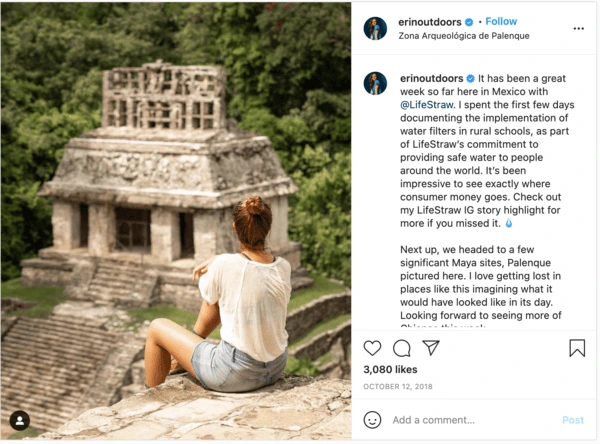
A post shared by Erin Sullivan (@erinoutdoors) on Oct 12, 2018 at 8:00pm PDT
If you have someone who’s particularly good on camera, give them a platform to talk about your project in a live stream. Most social platforms now have a solid live-streaming option. Take advantage and give your audience access to backstage conversations about your brand. Be brave and be there for your community.
Building a community
Having worked in marketing for a long time now, the most common thing I see is a fear to stand up for something important because it might upset some of your customers. You could sell anything to anyone, but that’s not building a brand legacy—that’s trying to make a quick buck.
If you consider community-building to be part of your marketing strategy, then you need to have a positive message. Brands that build positive messaging in their content and communication are the ones that stand out against the negative cycle of mainstream news.
Examples of great sustainable storytelling
There’s nothing like seeing examples that work, so we’ve curated a few samples of brands we absolutely love.
TRIBE — Sports nutrition with a conscience
At Conscious Creatives, we try to encourage physical activity as part of a healthy lifestyle, getting our team healthy through running, cycling, surfing and more. One of our biggest forms of inspiration in this respect is Tribe—a brand dedicated to making sports nutrition products with natural ingredients.
What we love about Tribe is that their marketing plans are based on creating a community. They’re a collection of people who love being outdoors, brought together by sporting events all over the world and a combined effort to rid the world of human trafficking.
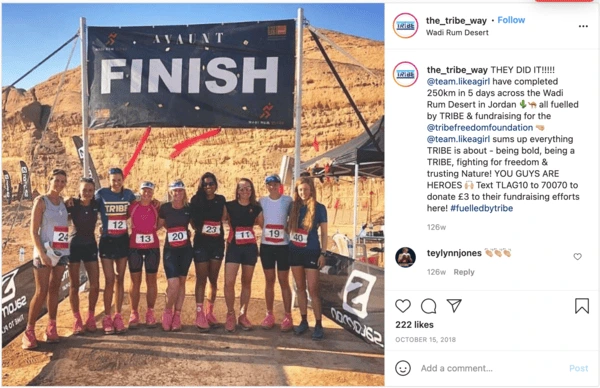
A post shared by TRIBE (@the_tribe_way) on Oct 15, 2018 at 12:46pm PDT
Tribe is a community of nutrition experts who care about the world. It just so happens that they also sell nutrition products.
Lewis Pugh — Swimming to save the seas
An example of someone who definitely fits the definition of inspirational is Lewis Pugh: swimmer, speaker and general mind-boggling human being.
He’s just completed The Long Swim, a 560-kilometer effort spanning the length of the English Channel.
Why would a person attempt such a thing? To raise awareness of the sorry state of our oceans. Lewis’s feat is the start of a worldwide campaign that aims to fully protect 30% of our oceans by 2030.
A real-life hero and conservationist, Lewis defies all logic and pushes himself to the limits to earn media coverage of the cause. See this photo of his encounter with a plastic bag during his long swim. He used a powerful image, a long caption and specific instructions to make our oceans cleaner.
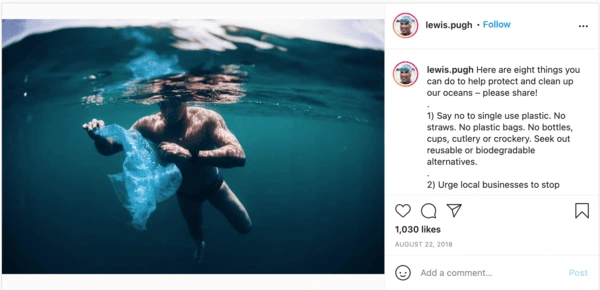
A post shared by Lewis Pugh (@lewis.pugh) on Aug 22, 2018 at 7:19am PDT
That is how sustainable marketing will change the world.
rCUP — Recycling reusable cups
I am proud to share a hometown with these folks. They discovered that only 0.4% of recyclable coffee cups were actually being recycled. So, they set about designing a product made from precisely those cups.
The rCUP is a reusable coffee cup that is affordable, looks great and has some wonderful little design elements that make it really easy to use.
A post shared by rCUP (@rcuponeplanet) on Jul 21, 2018 at 11:32am PDT
Sustainable marketing is so much easier when you’ve got products that make a real difference.
How to get started
If you’re reading this and are equal parts excited and confused, you are not alone. I suggest finding a community of like-minded business folks who are also looking to make more money by doing the right thing.
LinkedIn is a great resource for finding sustainability professionals, and our community is strong in voice. We’re all so proud of the work our peers are doing and the causes that we stand for.
Look into your industry to see which organizations support sustainability. You’ll be surprised to discover wonderful groups ready and willing to help, no matter what stage you’re at. For example, if you work in fashion, the Ethical Fashion Initiative is a wonderful example.
The key, though, is to start.
Don’t be afraid to try. Know you aren’t going to do it perfectly, but also know that simply trying is a great thing. Watch as your community grows and rallies around your brand for years to come.
In the digital age, we are constantly surrounded by bleeping phones and notification alerts. The onslaught of incoming communications can seem incessant and unceasing. Most modern consumers are surrounded by distractions, and marketers have a tough job helping their brands catch the attention of prospects.
Related: Create strong emotional connections with your brand story
Often, an effective approach is to add to the stream of information and hope to outdo competitors by offering big discounts and exclusive deals. These quick wins can help your business reach its short-term goals, but they won’t lead to long-term loyalty from consumers. Brands need to build trust with customers so they come back time and again—a one-off discount can’t achieve this.
Instead, the best-known and longest-surviving brands create and nurture emotional connections with their customers—turning them into faithful followers. To do this, marketers use emotional branding. It can take some time to reach the point where your customers’ actions are fueled by emotion, but it is worth the investment, as repeat customers are extremely valuable.
Why invest in emotional branding?
It costs more to acquire a new customer than it does to keep one. The exact figures vary, with different studies suggesting it can be between 5-25x more costly to attract a new buyer than to retain one. One Harvard Business School study suggests that improving customer retention by 5% will increase a company’s profits by between 25% and 95%.
Every marketer knows that building a strong brand is hugely important in distinguishing a business from its competitors. But, they may not realize just how much it can impact their bottom line. A successful brand goes much deeper than its logo; it creates an emotional connection with customers.
Emotional branding defined
Emotional branding is about building a brand that appeals directly to consumers’ emotions, needs and ambitions. With emotional branding, marketers aim to trigger an emotional response in consumers.
By provoking emotions, marketers can create a bond which disrupts traditional consumer decision-making models. These models are largely based around the idea that consumers make a purchase based purely on logic, but these models are changing.
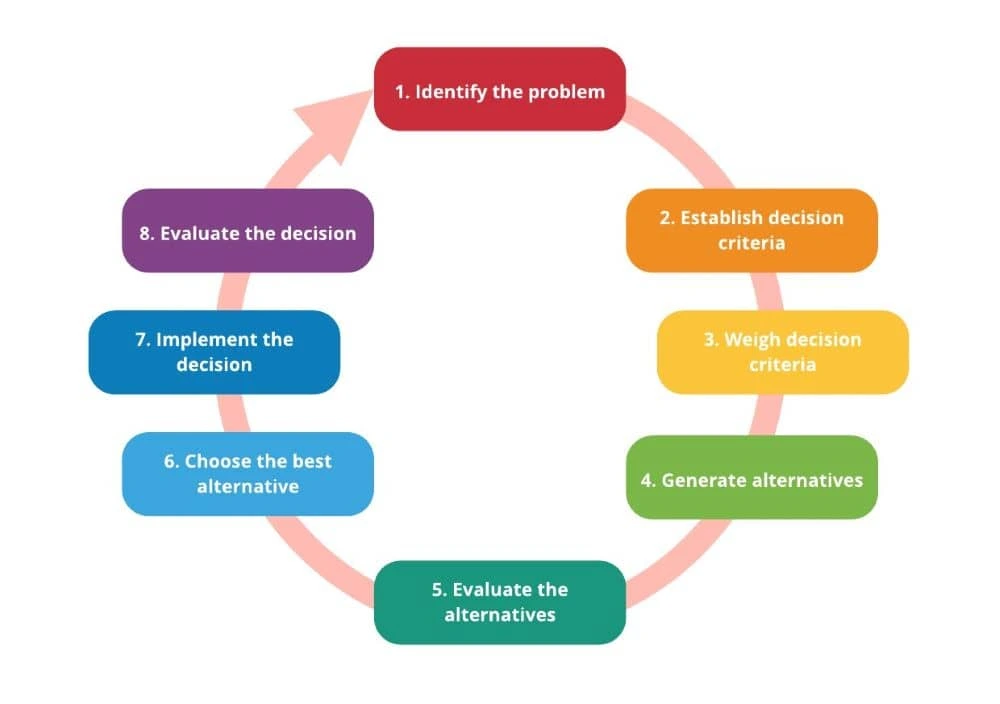
Quizlet’s rational decision-making model,lovingly recreated in Lucidpress
When emotional branding comes into play, decisions can become irrational. When given the choice between two similar products, a consumer may simply follow logic and choose the cheapest or most convenient option. However, when emotion is in the mix, they may choose to buy the brand they relate to most.
It’s easy to see how building an emotional bond with consumers can increase profits and why premium brands like Nespresso and Coca-Cola engage in building emotional connections with their customers.
Often, people choose purchases based on ego rather than necessity. Consumers can show who they are through the brands they choose—and they are willing to pay more and go out of their way to do this. It is up to marketers to position their brands in a way that will connect and resonate with their target audience. When done right, cutting through the distractions of the modern world will come easy.
How to incorporate emotional branding in your marketing strategy
The likes of McDonalds, KFC and Disney employ a number of methods to connect in a meaningful way with consumers. The longer a business is around, the easier this becomes, and many brands take advantage of anniversaries and nostalgia to bond with their market.
But, newly founded businesses don’t need to miss out. Here are just some of the approaches to emotional branding that can be used to bond with consumers.
1. Show your customers you care
To succeed at emotional branding, it’s essential to thoroughly know your audience. You need to treat your customers as people rather than faceless consumers. Do your research, conduct surveys, then decide how you can connect with your audience.
What do they value? What triggers them emotionally?
Once you’ve decided which emotion you want to tap into, this should consistently be evident in your marketing messages. From social media to customer care, a brand should constantly address customers’ emotional needs.
Over the years, e-commerce site Zappos endeared itself to customers by going above and beyond to provide great service. From providing free overnight delivery to a customer in a sticky situation to assisting a hungry helpline caller in need of pizza, the site has built up a loyal following.

While Zappos provides an extreme example of customer care, creating an emotional connection by meeting and exceeding customer service expectations doesn’t have to be so extravagant.
Apple has built a cult following simply by demonstrating that it understands the needs of its users. Nike recognizes its customers’ dreams and ambitions, and the brand uses marketing to show how it can help with the journey.
French beauty brand L’Occitane simply provides customers with beautifully presented deliveries and free gift-wrapping—making a memorable impression which, for many of its customers, is more appreciated than a discount.
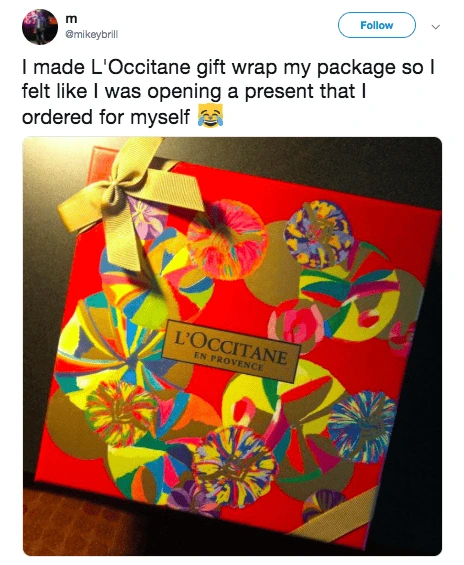
2. Be consistent
For online marketers, consistency is key. Sharing content which demonstrates a consistent tone and style builds both visibility and trust for a brand.
Without the trust of your audience, there is no way you’ll be able to build a strong emotional bond that will keep customers coming back.
Here are some practical ways to ensure brand consistency:
- Set out your brand values. Share them with the whole team to help employees at every level stay on-brand and make decisions that reflect your brand’s true personality.
- Create a set of brand guidelines. Outline your brand’s tone of voice and key design elements like font, color palettes and correct presentation of the logo.
- Put together a social media style guide. This will reinforce some of the elements set out in the brand guidelines, but it will also advise the social media team on which content they should post and how to respond to criticism.
- Use a branded URL shortener. Customize your short links so they are on-brand. This will improve brand consistency and build trust with your audience. For example, Rebrandly links receive up to 39% more click-throughs because consumers trust them.
- Create design templates. From presentations to social media images, make it simple for everyone to create high-quality, on-brand content. Then, make them accessible to the whole organization through a brand templating platform like Lucidpress.
- Monitor brand mentions. Keep an eye on what’s being said about your brand online using Google Alerts or another brand monitoring tool. Determine if your brand is coming across as intended and connecting emotionally with consumers.
3. Give customers an experience they won’t forget

Beyond providing great customer care, consider what other kind of experiences your brand can use to build an emotional connection with customers. Big brands often sponsor concerts and sporting events—or run their own. What could be your brand’s Disneyland?
If you have a brick-and-mortar location, could you host an entertaining event? If you’re working with a smaller budget, could you provide an Instagrammable installation in-store? This is a simple, but impactful, way to connect with consumers in today’s digital world.
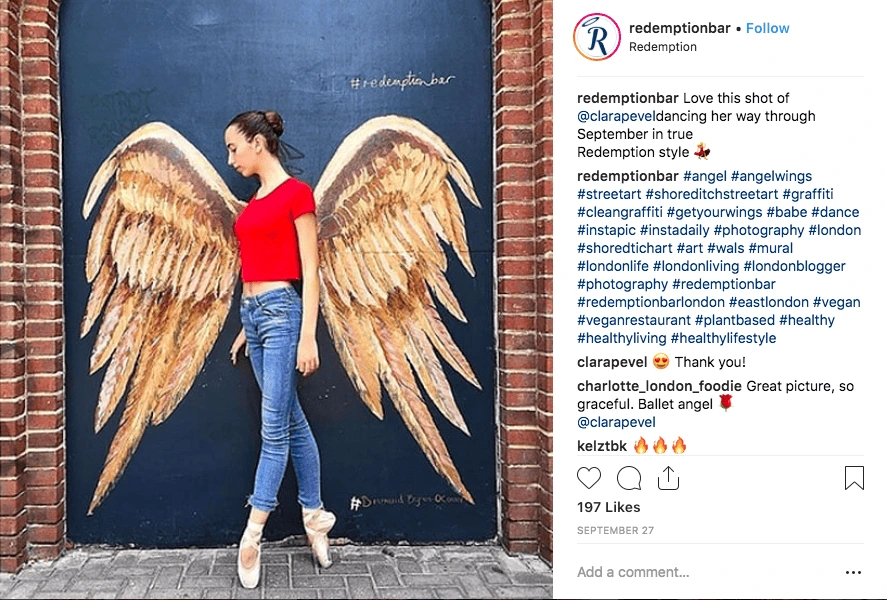
Source: Redemption Bar
Provide a positive experience as customers use your product or service wherever possible. UX is growing in importance for online businesses and is intertwined with the overall brand experience.
Companies like Slack impress customers by providing a helpful and supportive experience through friendly reminders, convenient app integrations, and cleverly auto-populated gifs.
Alternatively, you can use marketing campaigns to align your brand with a particular lifestyle or emotional experience. Coca-Cola’s “Open Happiness” campaign is a clear example of this.
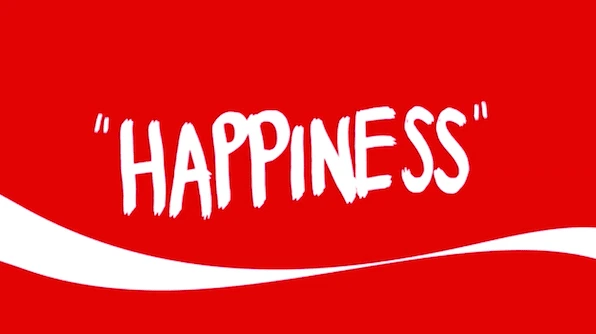
4. Put a friendly face at the center of your brand
Whether it’s a celeb, an Instagram influencer, or an employee-turned-brand-ambassador, sometimes the best way to connect with consumers on an emotional level is through a warm human personality.
Female consumers don’t go through enormous lengths to get one of Kylie Jenner’s lip kits just because of the product’s quality. They do this because of their love for the company’s CEO.
You don’t have to have a famous face to build a close relationship with your audience. Many charismatic CEOs have become the heart of their company’s brands.
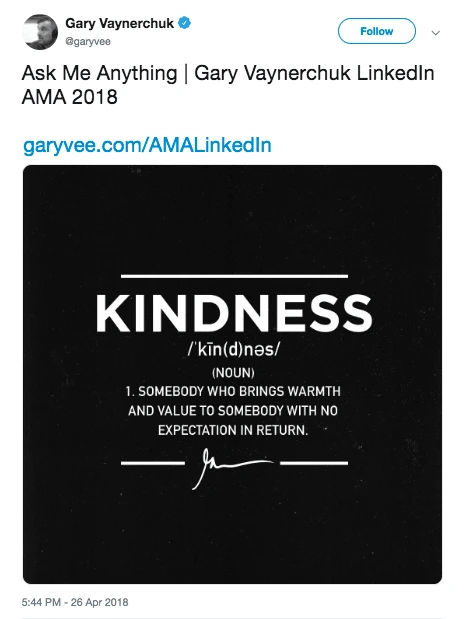
Think of Gary Vaynerchuk or Neil Patel, who have both built strong personal brands and businesses through social media. Their willingness to share knowledge and expertise with consumers has helped them to connect with audiences on an emotional level.
On a smaller scale, it’s very possible for a friendly waiter to drive customer retention by creating personal connections with diners. Brand ambassadors can come in many forms, and they’re a great way to reinforce brand values and build rapport with customers.
Key takeaway
Emotional branding builds lasting relationships with your audience and can improve the profitability and longevity of your business. You want to bring your customers to a point where they can’t imagine going to anyone else to get the products or services you provide.
Big brands are leading in this area, but small businesses can get in on emotional branding through the smallest of gestures and actions. As social media algorithms change and internet browsers seek out online communities, connecting emotionally will become a key strategy for cutting through the distractions of the modern world and reaching audiences.
Learn more about the power of emotional branding & storytelling in our webinar with branding expert David Brier.
Competition for customers is fiercer than ever, but a well-planned franchise marketing strategy can make you stand out from the crowd.
However, strategy is quite a complex subject. Can it be condensed into a simple article?
If you ask us, we say yes. We’ve distilled the most important steps a marketing strategy should contain. You’ll see in the examples below that even major brands follow the principles explained in this article.
Related: 4 best franchise softwares to boost your brand
Whether you’re a franchisor, a franchisee or a marketer, this is a great practical resource for you because every principle here is backed with concrete examples to inspire you.
Ready? Let’s dive right in.
Segment your audience if you want to maximize your results
You already know that you can have the best product on the planet, the most persuasive sales message, or the most creative ad ever—but if you deliver it to the wrong person, it will never work, right?
This applies whether you’re a franchisor looking for franchise buyers or a franchisee who wants to attract more people to your business.
So, if you want to make the most of your marketing efforts, your marketing plans have to start with your core audience in mind.
Below, you can find a few essential questions to ask yourself (or even better, your existing customers) to find out who’s most likely to buy from you.
Questions to ask yourself & your team:
- What are your product/service’s best features, and how does each translate into a benefit for the consumer?
- What’s special about your product/service in comparison to your competition? Are you unique, cheaper, quicker, better value, safer? The most trusted, the first, the oldest, the most tested?
- What could be your customer’s main objections?
- Which topics are your customers interested in? Who influences your ideal client (books, publications, media, influencers, etc.)?
- Where can you catch your ideal customer’s attention? Phone, email, social media, TV?
- What is your ideal buyer’s income?
Questions to ask your existing customers:
- Why did you choose us and not a competitor? Is there anything that pushed you in favor of us?
- How did you find our website or location?
- How would you feel if you could no longer use us? What would you miss?
- What’s one thing you don’t like about a competitor, or that we could improve to better meet your needs?
- What would you likely use as an alternative if we were no longer available?
- Have you recommended us to anyone? Why or why not?
Prioritize channels
One of the biggest mistakes entrepreneurs make is trying to be on every platform out there.
Trying to tackle every channel available can be a great strategy if:
- You have the resources to do this (time + money + knowledge).
- Your audience is on every platform.
The first point is pretty clear. Few companies have the resources to go that broad with their marketing efforts. Second, often times, our audience isn’t everywhere.
For example, if your target audience is between 18 to 25 years old, you might be better off going for Instagram than Facebook.
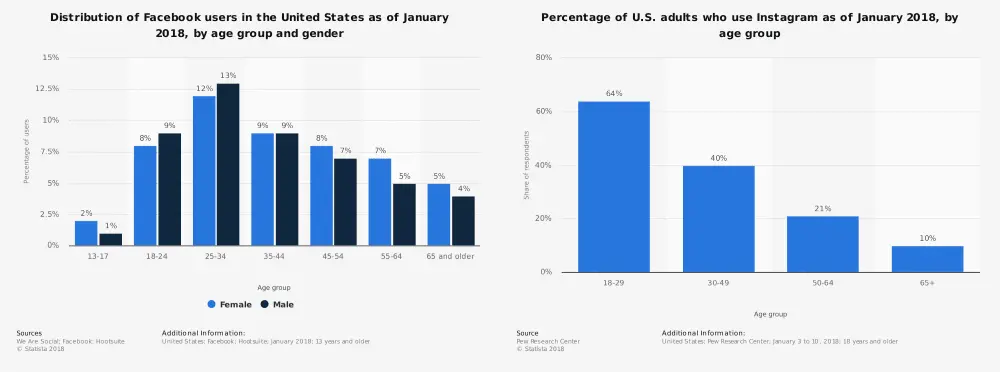
Source: Statista
Or, if you want to use Twitter as one of your main marketing channels in Europe, you might reconsider because Twitter hasn’t penetrated Europe as much.
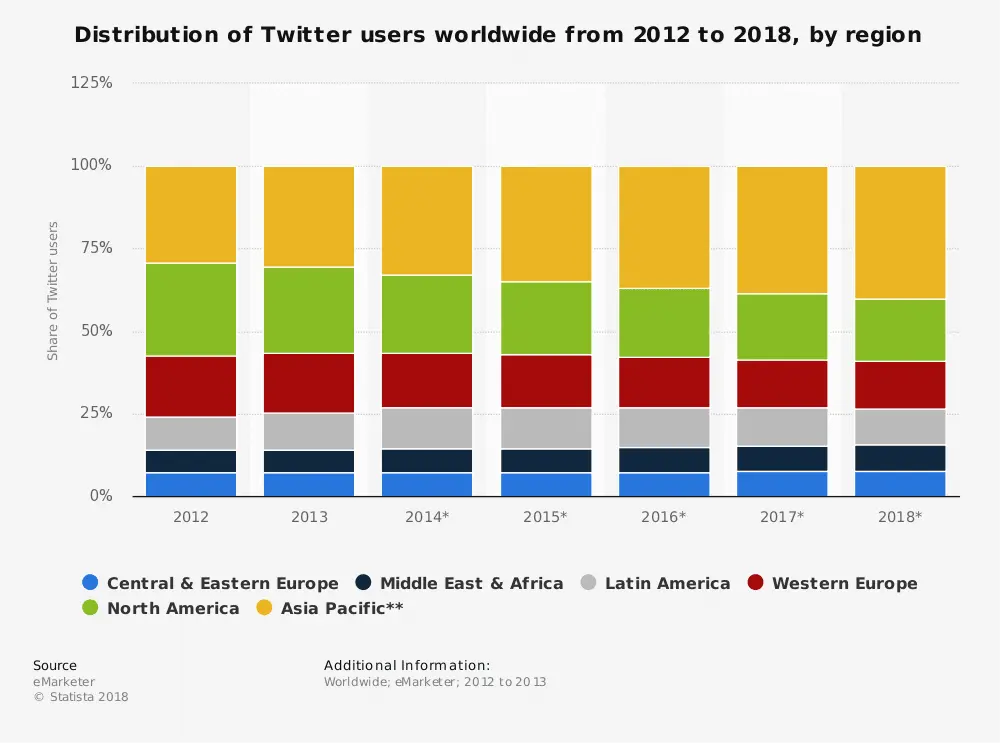
There are a lot of effective channels available. How do you prioritize them?
Here’s a simple, tested system borrowed from growth hacking marketing you can use. This is the same marketing concept used by startups like Facebook, Twitter, LinkedIn & Airbnb:
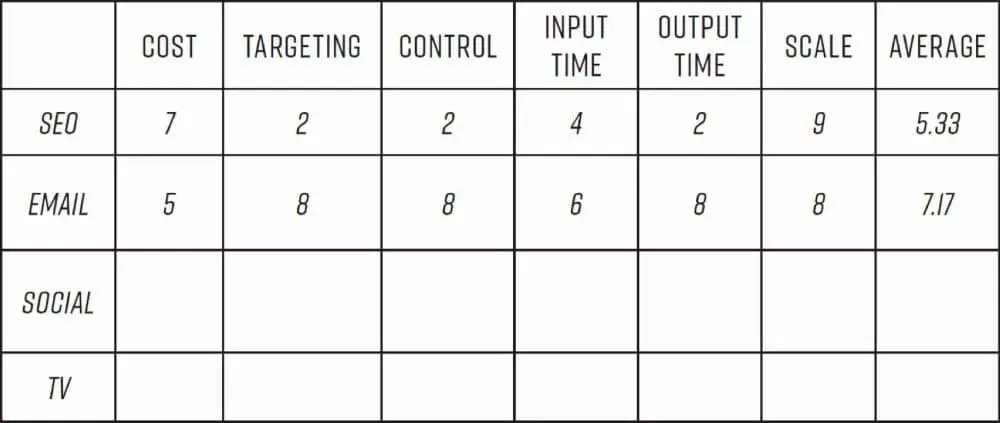
Source: GrowthHackers
Cost — how much you expect to spend on that particular channel (check cost statistics beforehand).
Targeting — how easy it is to reach your intended audience and how specific you can be. Does your chosen platform/channel have local advertising capabilities, for example?
Control — how much control you have once you go live. Can you stop it easily or adjust if it’s not going well? For example, it’s much harder to change a billboard than a Facebook ad.
Input time — how much time it will take to launch the experiment. Filming a television ad, for example, has a much longer input time than setting up a promoted tweet.
Output time — how long it will take to get results once it’s live. For example, search engine optimization (SEO) could be a great channel for your franchise marketing, but it has a much longer output time than pay-per-click does.
Scale — how large an audience you can reach with the experiment. Television offers much larger scale than advertising on a niche blog does.
Make sure you maintain consistent branding
Different channels require different creative.
Twitter is more text-based because people use it for news and articles.
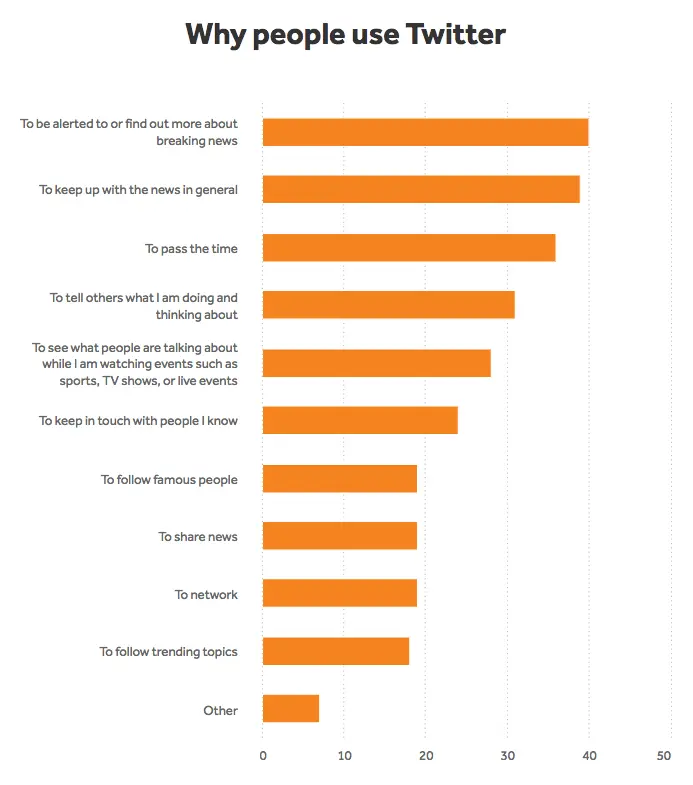
Source: Buffer
Instagram is a more visual platform and requires high-resolution photos.
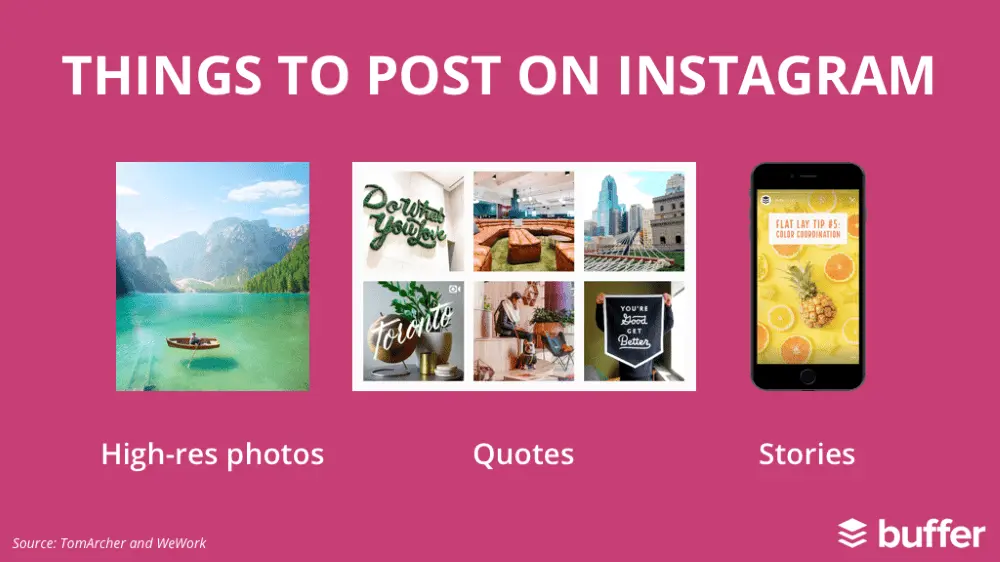
Source: Buffer
On Facebook, a recent BuzzSumo analysis found that videos have higher average engagement than images and links.
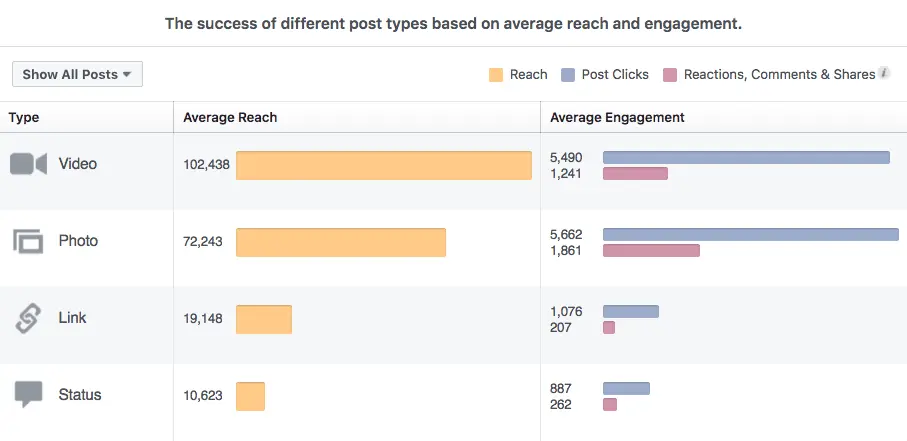
Source: Buffer
Therefore, no matter if you are a franchisor or a franchisee, you have to make sure you:
- Maintain consistent branding across all your franchises (as a franchisor).
- Maintain consistent branding across all your channels (as a franchisee).
What does this congruent brand identity actually mean? Below, you’ll find some real examples.
Communicate your value proposition in the same way across all channels—offline, online, TV, radio, direct mail or anything else. []
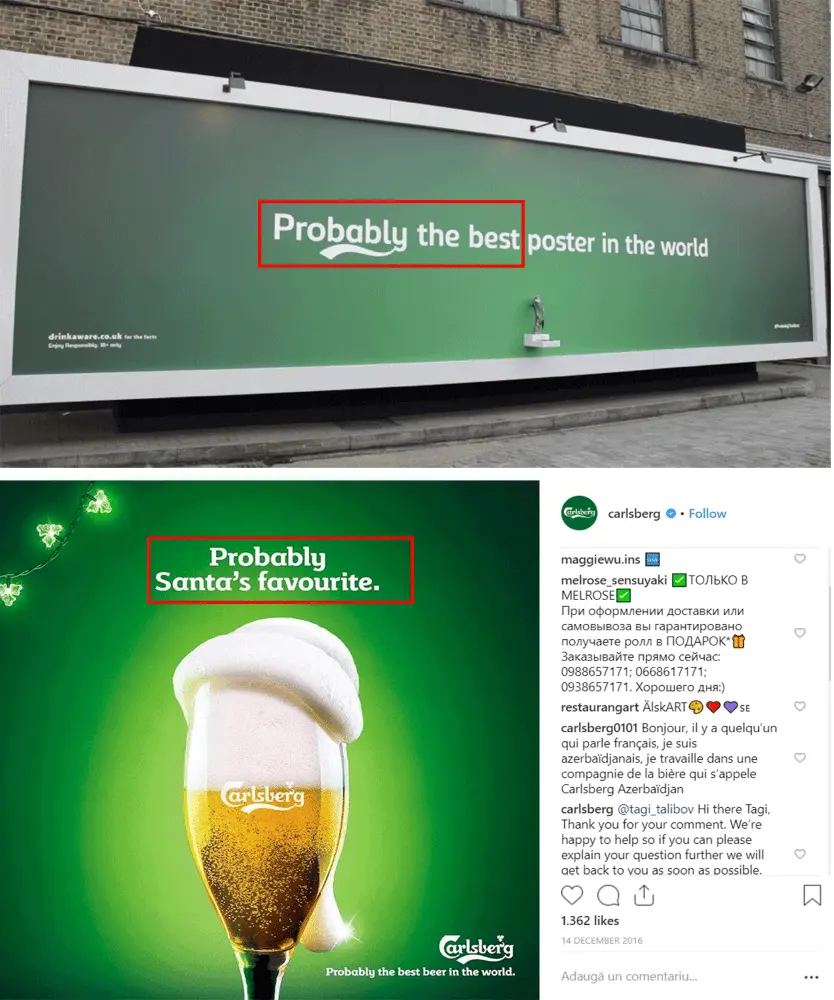
Your design (colors, logos, fonts, tone) has to be the same whether someone sees an ad on Facebook or landed on your website from a Google ad.
One of the best examples here is Coca-Cola.
As you can see, the color red is always present in one way or another. They also use the same fonts and design elements.
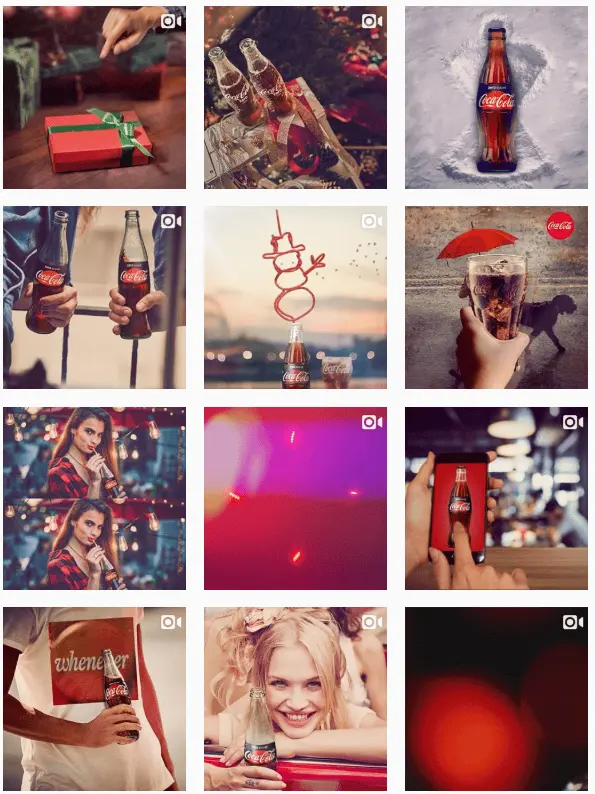
Another important element to a congruent brand identity is tone of voice.
If we continue our Coca-Cola example, we can see that almost all their posts express happiness, joy, fun, or the feeling of enjoying a great moment with friends.
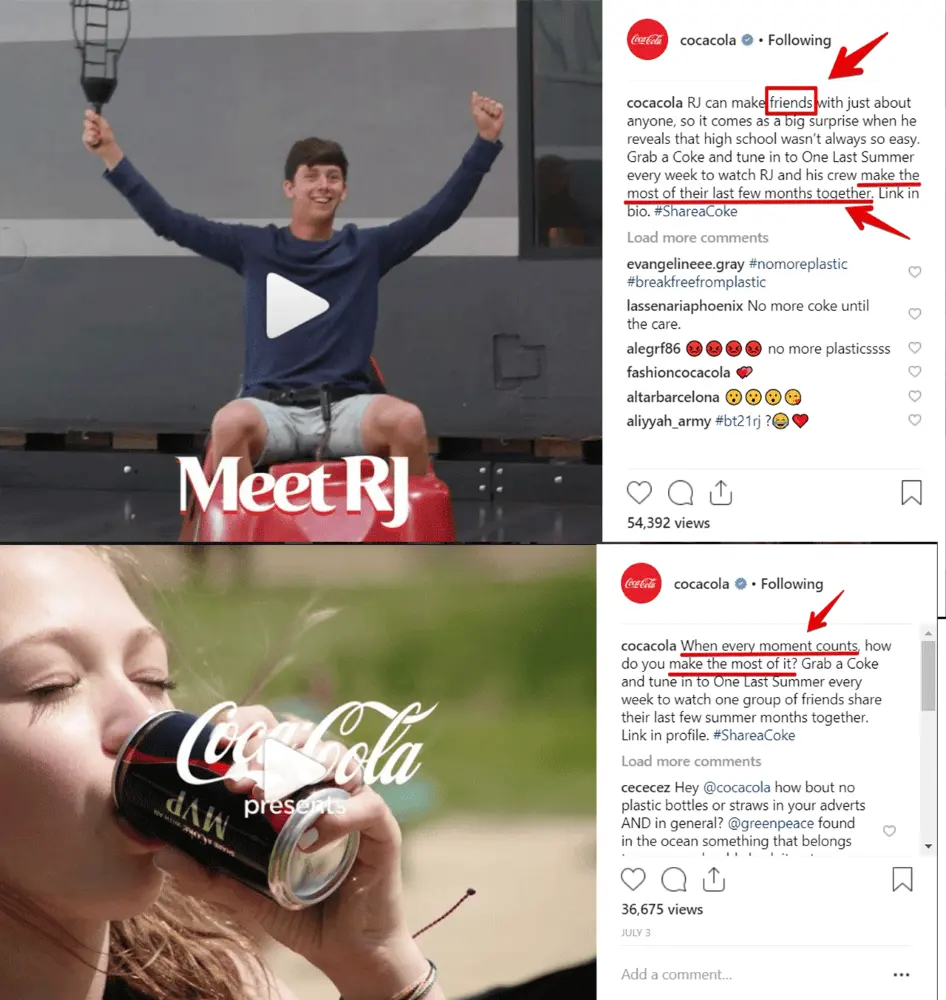
If we take another example, Charmin, you can see that whether they communicate offline or online, they maintain a playful tone.
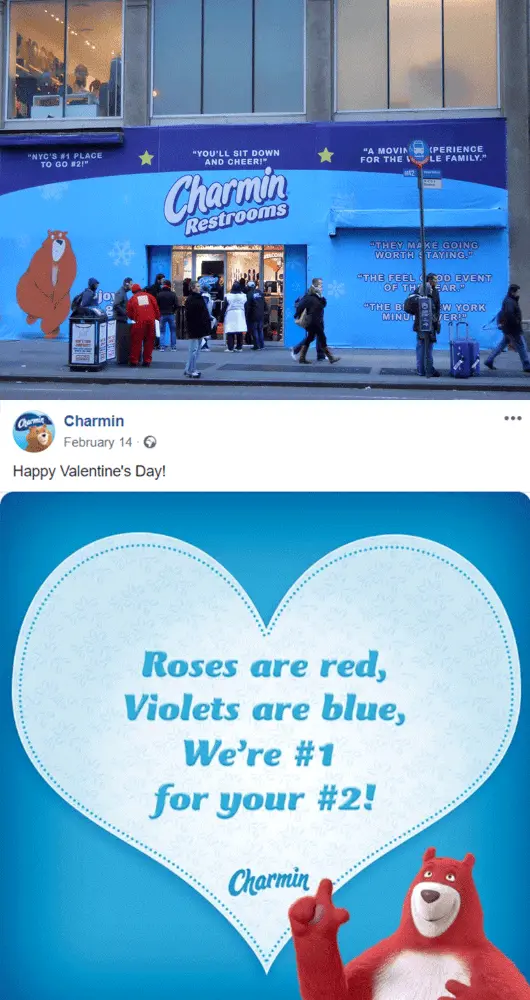
How can you make sure your franchise brand stays consistent?
First, you’ll have to create a brand manual which includes details about your tone of voice, preferred professional terms, and general code of conduct. Every business should have one, no matter their stage in the journey to perfect branding.
(We’ve handpicked some of the best brand guideline examples for you.)
Then, in order to minimize errors, you can create “best practice” templates that are in line with your brand’s ethos and aesthetic.
This ensures no one in your company has to take matters into their own hands, because they can draw on templates that reflect your brand every time they create a new document.
If you’re using Marq, you can create & customize templates to easily create stunning content without having to start from scratch every time. And because of its innovative Brand Assets feature, you can make sure everyone is using the latest version of your branding elements. Fonts, colors and logos are all pre-loaded and ready to go.
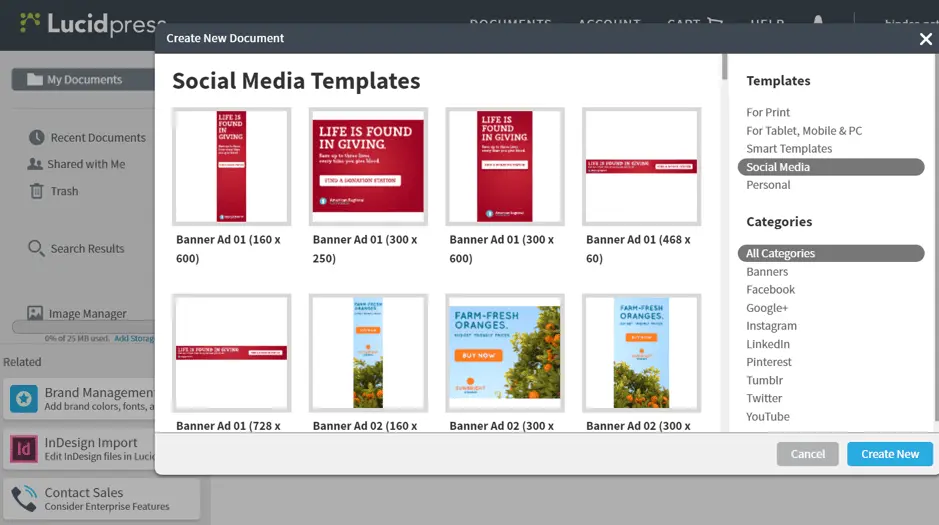
How can franchises maintain brand compliance across locations? Learn more in our free ebook, The complete guide to multi-location branding.

Before starting your efforts, make sure you can measure them
There’s an old adage that says half of the money invested in marketing is wasted. The problem is you don’t know which half.
Well, thanks to digital analytics, you can track your results so in-depth that you’d be amazed at how much leverage you have… if you measure the right things.
Here are just a couple of examples. Let’s say your marketing team developed two or three video messages for a certain audience, but you don’t know which one to choose.
It’s super easy. On Facebook, for example, you can check how much of your video was actually watched by a particular group.

If you compare it to television advertising, for example, you don’t get this level of accurate data. You can’t know whether a person left the room when the commercial started.
But, Facebook isn’t the only tool that allows you to track the results of your franchise advertising efforts.
If you run email marketing campaigns, you can see how many people opened your email and clicked on the offer inside.
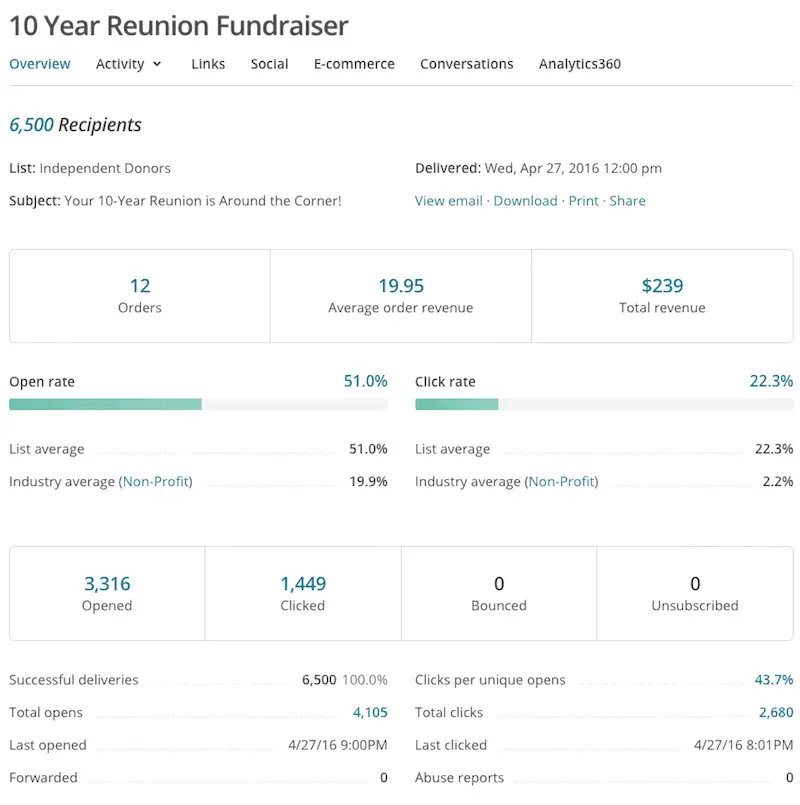
Source: MailChimp
If you run any other digital marketing campaigns, you can check Google Analytics to see how much time people spend on your website, which campaign brought in the best results, where the most traffic comes from, and much more.
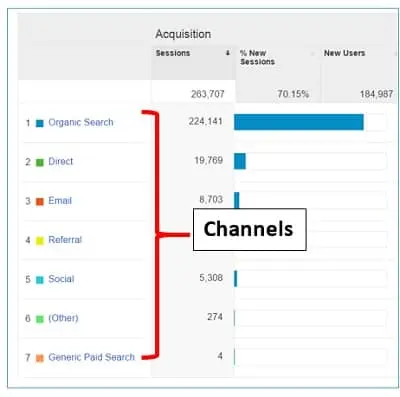
Source: Optimize Smart
Or, maybe you just bought a pizza franchise and you’re using local Google Ads. You can track how many times people called versus how much money you’ve invested and see if there’s a positive return on investment.
Ultimately, analytics don’t have to be limited to the online world. If you’re using offline marketing tactics like flyers or coupons, you can use codes to measure whether your campaign was a success.

Always keep an eye on trends
Marketing is first and foremost a battle for attention. If you don’t have people’s attention, you can’t communicate with them. If you can’t communicate, you can’t sell.
In the 50s, attention was on the newspapers, then on TV and radio.
Today, our attention is on social media. Messaging apps like Facebook Messenger are becoming more powerful.
Influencer marketing is growing, because they have people’s attention and they’ve already earned their trust.
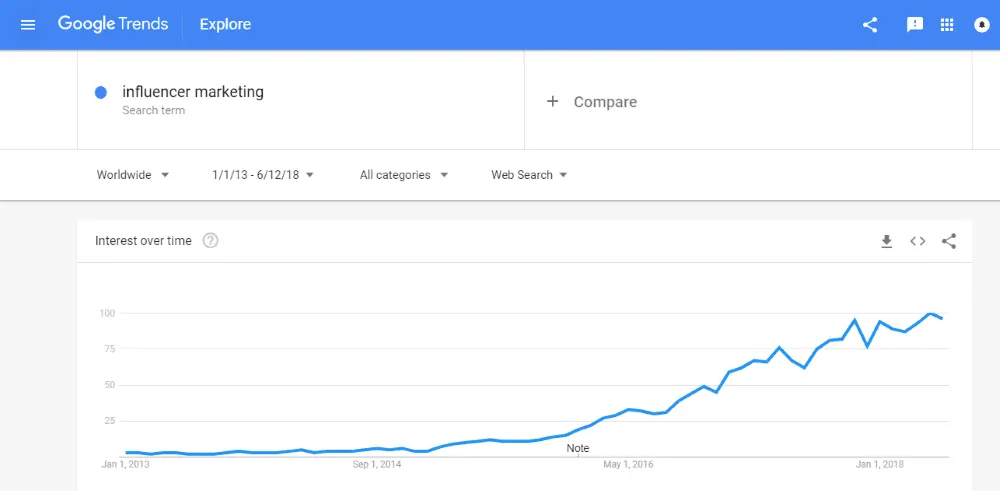
Source: Google Trends
What’s next? Voice search & marketing will have a huge impact on consumer behavior. More than 35 million Americans used a voice-activated assistant at least once a month in 2017, according to eMarketer.
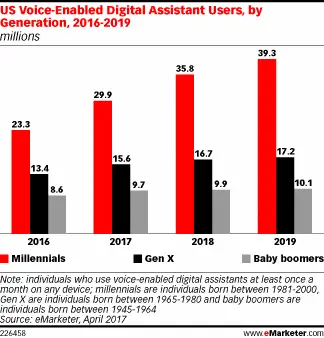
Coordinate local & national franchise marketing
There are many methods to handle franchise marketing. Sometimes, the franchisor and a corporate marketing team are wholly in charge. Other times, the franchisee takes on all marketing responsibilities. Most often, it’s a mix of the two.
It’s easy to see how this arrangement could cause confusion for your customers. But by coordinating your marketing efforts, your brand message will be strong and clear across all franchise locations.
Large-scale, national marketing campaigns
Here are some tips for coordinating large-scale marketing campaigns between the franchisor and franchisee.
Focus on the brand
In a franchise, the brand is often the selling point for customers. They know they can trust a certain brand and will support that franchise, no matter where they are. This is why it’s beneficial to focus on the overall brand image in your marketing efforts.
Provide a brand style guide
Franchisors can create a brand style guide for franchisees, to help them create on-brand materials and limit branding mistakes. It you aren’t sure how to create a brand style guide, take a look at this blog post for some killer examples.
Here at Marq, we’re pretty obsessed with staying on-brand and empowering everyone (even franchise owners who have no design experience) to create visual content. If you’re curious how Marq could streamline your franchise marketing, then check this out.
Communicate clearly & frequently
To maintain your brand image across multiple locations, communication is key. Set the precedent that there will be consistent communication regarding marketing efforts between the franchisor and franchise owners.
One area that’s often under-communicated is digital marketing strategy. The franchisor should coordinate website and social media creation with franchisees, so there aren’t multiple accounts that could confuse or misdirect customers.
Looking at these marketing strategies, the biggest factor is the brand. Build a strong brand identity that will give your franchises a good reputation, then give franchise owners the freedom to create their own marketing collateral using approved brand assets.
Small-scale, local marketing campaigns
Small-scale marketing strategies should focus on specific efforts in the local community. Franchises often have the good reputation of the larger brand, but localized marketing is what will win the community over and create a loyal fan-base.
By empowering franchisees to control their own marketing on a local level (and by giving them the tools to stay on-brand), individual franchise revenue will soar.
Here are more tips for localized, franchise-level marketing.
Find local sponsorships
Talk to local charities, sports teams or schools in the area to find opportunities to donate to a good cause and get some advertising. This is a great way to show community members that you’re invested in the area.
For example, when I was in high school, there was a Taco Time that always sponsored the school’s football and basketball teams. Their sponsorship included banners hanging up at the football field and inside the gym. They sold food at the concessions stand and had their logo printed on the game rosters. As you can imagine, my friends and I ate a lot of tacos.
This was a worthy investment for this franchisee, as it showed their support for the community and offered unique advertising opportunities. The owner of the Taco Time had a great relationship with the community and people loved going to his location.
Personalize your messages
When you’re advertising to a specific community, it’s important to personalize your messaging for your audience. Every community is different, and by catering to yours, customers will feel special and more inclined to support you.
A great example of marketing personalization is CrossFit gyms. Each gym (or “box,” in CrossFit lingo) has its own website and social media accounts that tailor their messages to the area where the gym is located. Whether it’s about the weather or events happening in the city, these gyms create a local identity for themselves that members can be part of.
Keep up-to-date
Encourage franchise owners to stay on top of trends and news as they create marketing for their franchises. Being in tune with the local news can help you spot opportunities and avoid embarrassing advertising mistakes.
Any time you post about current news or trends, make sure you do your research. An unfortunate example of this is DiGiorno. When the hashtags #whyistayed and #whyileft were trending on Twitter, DiGiorno tweeted “#whyistayed You had pizza.” The problem: these hashtags were dedicated to discussing and raising awareness of domestic abuse—an incredibly serious cause. Needless to say, many people were offended by the tweet and DiGiorno quickly apologized for its mistake.
Be where your audience is
This, of course, is one of the most important rules in marketing. No matter how clever and wonderful your marketing efforts are, if your audience doesn’t see them, then it’s a waste.
So, find out where your local audience is: Do they spend time on Facebook, Instagram or Twitter? Do they read the local newspaper? If so, that’s where you should be, too.
Be consistent with the brand
Much of the traction and business a franchise location enjoys comes from the brand name that it carries. To continue attracting and retaining that business, it’s important to stay true to the brand.
If the franchise brand is known for great customer service, then local managers have to make sure that customer service is a priority for them. Personalize each franchise to the local area, but stay true to the brand it represents. For example, maybe there’s a way to provide outstanding customer service that’s unique to your community.
A great example of this is Chick-fil-a. It’s a well-known fact that if you say “Thank you” to any Chick-fil-a employee, they will reply with “My pleasure.” Quality customer service is part of the Chick-fil-a brand, and customers can expect to receive the same level of customer service wherever they go. While each Chick-fil-a has its own concerted marketing efforts, they stay on-brand with their customer service.
Key takeaway
Marketing within a franchise can lead to miscommunication and overlap if the franchisor and franchisee do not coordinate their efforts. However, through communication and a good brand management system, your marketing efforts can complement one another and culminate in more success.
Before you start your franchise marketing strategy…
Everything starts with your ideal client in mind. From there, you decide which channels would bring you the best results, depending on your budget.
Next, you have to make sure your brand identity stays consistent across all channels—from your value proposition to your design elements.
Then, make sure you keep an eye on the latest trends in order to leverage first-mover advantages. This strategy will give your franchise business the best chance at standing out and finding success with your preferred customers.
Maintain brand consistency with Marq, the brand management platform for franchises. It’s perfect for franchise brands of any size.
Taking your brand global is an exciting prospect but also a significant challenge. Establishing and growing your brand in your own country is challenging enough, but expanding it into other parts of the world will present hurdles different from any you’ve experienced before.
Related: The brand manager’s guide to brand extension
One of the principal challenges is maintaining consistency as the brand spreads into other cultures and regions. Being consistent, though, is key to success. That’s not to say you should ignore the differences between customers in different markets—you need to meet customer needs while still keeping your brand consistent, which is easier said than done.
Maintaining a strong brand while going global requires substantial research and planning, as well as careful monitoring. Here are 6 branding tips to remember when you’re going global.
1. Establish brand guidelines
Before attempting to expand a brand globally, the company should have well-established, consistent brand guidelines. It needs to distribute these guidelines to everyone who will represent the brand in any way and ensure adherence.
What should be included in brand guidelines? They cover the overall definition of the brand, visual style and content style. That’s not to say all of these elements need to be included in the same document, but they should all be well-defined. The guideline should define the brand’s values, mission and vision statement and include a description of the key messages you want to send, as well as the brand’s personality.
These guidelines should include rules for using the company’s logos, colors, fonts and any other visual elements. They should also describe its preferred voice and tone, any words that should be used and any to be avoided. The use of these guidelines must be enforced throughout the company to keep the brand consistent. This will be of immense value, since research shows that consistent brands expect to earn 23% more revenue annually than inconsistent brands.
2. Emphasize your values
Your brand guidelines should include a description of company values, but they should be emphasized through every aspect of the global expansion. This strategy consists of both customer-facing and internal elements and will help the brand maintain its essence, even if the details of how the company operates are different in new markets.
Making sure everyone in the company understands its values is crucial to consistency. Brand values can serve as a guidepost when trying to determine whether something is on brand or not. While representations of the brands should still be subject to review, understanding brand values can help keep ideas on track in the early stages.
3. Be aware of culture & language differences
Before expanding into a new region, a company should take time to research any aspects of culture or language that may affect how their brand is perceived. The business should also conduct a legal assessment to avoid inadvertently breaking any rules or regulations.
If your company is seeking to form partnerships and make business acquaintances overseas, it’s important to have a thorough understanding of the country’s business culture. For example, in Singapore, it’s important to talk about any successes as a team effort. The interests of the group as a whole are generally put ahead of individual interests there—something you’d want to keep in mind if you were trying to create a mutually beneficial partnership.
When translating a brand into another language and culture, miscommunications are easily possible.
If a company doesn’t take sufficient precautions, it risks making a faux pas that could damage the brand. KFC fell victim to this issue when it expanded into China in the 80s. The company translated its slogan “finger-lickin’ good” to “eat your fingers off.” While KFC eventually recovered from the mistake, this slogan did not send the right message.
4. Keep it customer-focused
While you need to maintain brand consistency, you also need to ensure that you communicate your brand in a way that will resonate with the new customers you’re attempting to reach. You may need to make small adjustments to better appeal to customers in different regions, as well.
Determining what you can change to appeal to a new set of customers and what you can’t alter without sacrificing brand consistency is critical.
KFC provides us another example—but this time, in a positive way. In the 70s, KFC created a campaign in Japan called “Kentucky for Christmas” that encouraged Japanese customers to go to KFC on the holiday.
The campaign was a huge success because it capitalized on the fact that there weren’t many established Christmas traditions in the country. KFC still catered to one of the traditions that did exist in Japan, however, by including a special cake in its Christmas meal bundles.
5. Optimize your approval process
Companies should have an established approval process in place before expanding globally. This process helps employees to easily submit materials and enables company leadership to ensure brand consistency.
A complicated process can lead to off-brand materials slipping through the cracks. Once they do, these misbranded materials can spread, because people who see them will assume they’re acceptable.
Using a brand templating platform like Lucidpress can streamline the approval process, which encourages employees to get quick approval of their materials and move their projects forward.
6. Promote consistent internal communications
To orchestrate a global brand expansion, a company needs a strong internal communications system to ensure that all offices, departments and employees are on the same page.
You need a reliable communications system to inform everyone in the company of updates to branding guidelines, information about new products, details about new promotional products and more. Internal disconnect creates a risk of brand inconsistency.
Businesses should create an internal communications plan that includes information about communication objectives, target audiences, available channels and more. They must then monitor their progress to ensure that their internal communications are effective.
Also, everyone within a company who needs access to logos and other brand materials should have access to them. Using a cloud-based system like Lucidpress (through which employees can download logos from anywhere at any time) can resolve this issue seamlessly.
Key takeaway
Expanding a brand globally is, of course, no small feat. A global brand has many moving parts that all face different challenges based on their location. Despite these differences, the branding must be consistent throughout the entire company.
Achieving this kind of cohesiveness requires a well-defined brand and open communication about what the brand is to everyone in the company. That information and meaning can then be communicated effectively to customers across the globe.
Want to know more about the power of brand consistency? Download our free 32-page report, chock full of stats & great insights.
To get people interested in your brand and have them become loyal customers, it’s no longer enough to simply produce a good product or provide a great service.
Related: 4 easy tips for effective online brand management
What buyers are looking for today is an impeccable user experience—one that really makes them feel like they’re getting their money’s worth. This is why top brands appeal to their customers’ emotions; they realize most purchases aren’t rational. Your brand exists in the minds of your audience as all the experiences, impressions and interactions they’ve had with you, both positive and negative.
The power of branding is so incredible that 72% of marketers say branded content is more effective than print advertising. To help you harness that power, here’s our list of 9 ways to make people fall in love with your brand.
1. Focus on user needs, not features
This is where many brands go wrong. They choose to toot their own horn and go on about how great their product is, when in reality, the market couldn’t care less about it. What they really care about (whether they’re looking to buy a lawnmower or reaching out to cheap writing services) is what the brand and its product can do for them.
Make sure your brand focuses on how buying your product will solve a particular issue for your audience or address a particular pain point. Make them feel like the hero for choosing you.
2. Research what your target audience wants
While it’s fairly easy to assume that the attention span of most millennials is only a few seconds or that older generations are not present on social media… If you’re basing your branding strategy on these assumptions, you have failed spectacularly right off the bat.
Researching your target audience and identifying their needs is crucial if you want your brand to connect with them on an emotional level. Find ways to speak to your customers—and ideal customers—about what really matters to them.
3. Respond to consumer feedback whenever possible
According to research, 57% of consumers say that brand’s failure to respond to negative feedback is a good reason to cut ties with that brand. Responding to user feedback and acknowledging it, even if it’s negative, can help turn things around if you try your best to remedy the issue.
By responding to customer reviews and feedback, you’re showing that communication is a two-way street, and that your brand is not generic and faceless like all the others out there.
4. Provide a free solution
Obviously, the whole point of marketing and building your brand is to get potential customers to purchase from you—but getting there doesn’t have to involve you pushing for a sale. For example, you can provide your audience with helpful, applicable, free content that will help them overcome a particular problem.
What this does is inspire trust and establish you as an authoritative resource. When they’re ready to make a real purchase, your brand will be their first choice.
5. Deliver more than you’ve promised
One of the most effective ways to create a positive brand experience is to delight customers by delivering more than you initially promised. For instance, if you surprise them with a discount or throw in a free sample, they’ll be thrilled.
While it might be a sizable investment on your part, keep in mind that customer loyalty can be worth ten times more than a single purchase.
6. Find the right distribution channel
While mobile advertising and branding are the trend of the moment, how successfully you’re going to reach your consumer audience depends on how well you’ve done your research.
For instance, if you’re trying to reach older people with your brand, you might assume mobile advertising is off-limits. And while it’s true many of them don’t use social media, they do still use smartphones—which would mean that your brand might benefit from SMS marketing.
Think carefully about all your options, and don’t take any off the table before giving them proper consideration.
7. Tell a story
It’s pretty easy to fall into the trap of making your brand’s message too salesy. A much better strategy is to tell a story with your message. For example, if you’re trying to sell an espresso machine, don’t talk about how it’s made of stainless steel or how it can make you a cup of coffee in less than 30 seconds…
Instead, focus on how amazing that first cup of freshly brewed coffee feels on a lazy Sunday while the kids are still in bed. You’re selling a better quality of life, and your product can make that happen. Figure out how to tell a story that captures what your brand can really do for your ideal customer.
8. Pay attention to the visuals
Up to 90% of purchases are influenced by visual factors—especially color, which can increase brand recognition by up to 80%. Having a website which features eye-catching responsive design is a must, but your brand identify should also extend to your social media, marketing materials and product packaging.
Every visual touchpoint is an opportunity to tell your brand story, so don’t let them go to waste.
9. Find out where your audience hangs out
Make peace with the fact that your brand cannot be all things to all people. While casting a wide net might help you attract a bigger audience, it might not be worth it when you take into account all the marketing expenses.
Instead, find your intended audience online and figure out what they want. Regardless of what your product or service is, there’s a target audience for it out there. It’s up to you to find out where they are, how they communicate, and what they value.
Key takeaway
These techniques will not only make people fall in love with your brand—they will keep them coming back for more. And when it comes to building brand loyalty and driving growth, that’s really the best-case scenario, isn’t it?
Want to know more about how to build your brand? Download our free ebook on how to build a brand in 2020.
At the onset of building a business, branding might not seem like the first thing to conceptualize. Establishing the foundations of your brand by creating a brand book could be a tedious process, but its long-term benefits are well worth the effort.
Related: Branding? Follow this template for creating a brand platform
To help you get started, let’s review what a brand book is, what it does, why you should take the time to build one, and how to best go about it.
What is a brand book?
A brand book can also be called a brand bible, a brand style guide or a brand guide, among other similar terms. Essentially, it’s the document that sets distinct guidelines for maintaining brand identity across all aspects of the business.
From designers to marketers to sales teams, a brand book helps align different departments in communicating consistent messaging.
Some of the things included in a brand book are:
- logos
- color palette
- typography
- design system
- imagery
- tone of voice
Why do you need one?
One of the biggest benefits of having a brand book is that it gives the business a framework of consistency and cohesion. This consistency and cohesive messaging serve as great tools for defining your company’s personality—which, when committed to over a period of time, breeds trust. Strong, consistent brands are valuable; we know from our research that consistent brands expect to earn 23% more revenue annually.
When your audience sees that there is consistency in color scheme, tone of voice, and logo usage across all platforms, it delivers a level of professionalism that tells your customers you’re a brand they can trust.
Pros of having a brand book
As pointed out by Mayven, having a detailed brand book establishes the voice and personality of a company, governing virtually every aspect of company communication. From in-house communications to marketing messaging, having a well-made brand book ensures everyone is on the same page, consistently delivering a unified message that’s always on-brand.
Cons of not having a brand book
On the flip side, the inconsistency that easily creeps up when you don’t take the time to create a brand book can confuse and, eventually, alienate your customers.
Imagine a coworker who’s always well put-together: perfectly ironed shirt, neat haircut, clean shoes. Now imagine if, out of nowhere, that same person came to work with unkempt hair, ripped jeans and a neck tattoo. You’ll inevitably feel uncomfortable because it’s just not something you’re used to from that person. Chances are, you’ll be wondering if everything was okay with that coworker or if there’s some inner turmoil going on.
Essentially, the same instinct applies to brands and the way they present themselves to their audiences. You don’t want to confuse your audience with mixed messages.
How to create a brand book: Setting up the brand
Before you create a brand book that guides all aspects of the business, you need to envision what you want the brand to be. This means understanding four key components: the brand’s mission, its vision (which includes core values), target audience and brand persona.
Mission
When you’re crafting your brand mission statement, don’t fall into the trap of stringing together buzzwords that merely result in empty concepts and vague statements. As noted by Branding Strategy Insider, settling for a mission statement of that ilk does little to guide the company or employees toward having and maintaining a competitive edge. On top of that, it doesn’t provide motivation or a daily mission to make each workday matter.
Instead of vague concepts, your mission statement should clearly establish:
- your company’s purpose
- its reason for existing
- the difference it strives to make in the world
Establishing these does a number of things for your business: it immediately helps employees figure out whether they fit what the company wants to be, it creates strong brand differentiation from competition, and it inspires consumer passion and engagement.
Vision
As noted by Goalcast, a strong vision statement will serve as a guiding force for all of your business decisions. It’s a virtual compass that points the company towards where it wants to be and what it wants to become.
To help craft your vision statement, you can ask questions like:
- How big do you want your company to get?
- Do you plan to branch out with products and services not currently offered?
- What kind of legacy do you want your business to leave behind?
Paired together, your mission and vision statements serve as important start and stop points—tools that will guide you as you make strategic business decisions that refine your brand.
Brand persona
Establishing a brand personality is a key element in setting the tone for your brand messaging across all communication channels. Mixed messages make it harder for customers to connect and identify with your brand.
One age-old practice is thinking about what kind of person your brand would be. Do you want your brand to be straightforward and to-the-point? Or would you rather it be playful and witty?
There’s also the old is/is not exercise. This involves listing three to five adjectives that your brand is and three to five adjectives that it is not.
Whatever collection of traits you decide to incorporate into your brand persona, it’s best to turn those into a statement that guides your overall messaging.
Lucidpress—a brand templating platform—uses this:
Lucidpress is the intuitive brand templating platform that empowers anyone to easily create on-brand materials.
In this statement, you can see a number of descriptive branding words:
- intuitive
- empowering
- easily
- on-brand
These traits drive our messaging and many other branding decisions, from how our software should feel to who would benefit from using our platform. Speaking of which…
Target audience
Just as you need to understand your brand, it’s likewise important to understand your target market. What types of people do you want using your products? Which ones do you want to visit your website, consume your content or subscribe to your emails?
To identify your audience, you need to have a solid understanding of what their needs, wants and values are—and how you factor into all of those.
The process of identifying and understanding your target market allows you to narrow down your audience focus. Your messages are always tailored to your audience, and it gives you a clear picture of what you need to be for a specific group of people.
How to create a brand book: Visual guidelines
Logo usage
Coming up with a distinct, identifiable logo is one thing. Ensuring that it remains optimized in different environments is another. This part of your brand book should include all approved versions of your logo and how it will be used in different platforms, from placement to acceptable alterations.
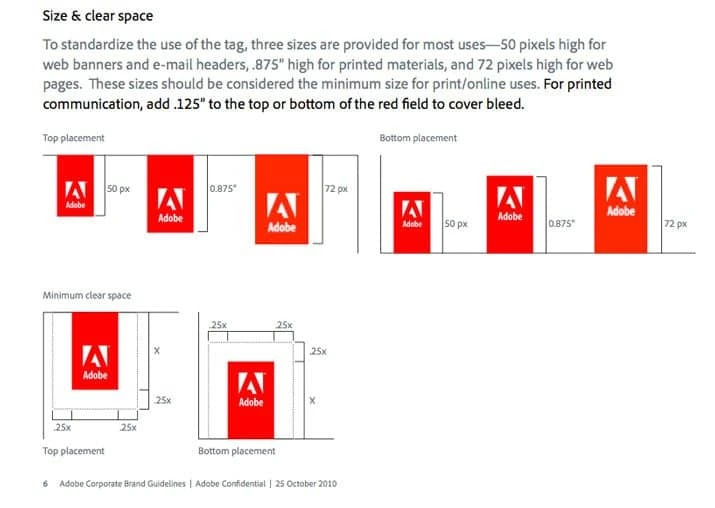
Source: Design Shack
As you can see with Adobe’s brand guidelines, it’s very clear how the logo should be used, including its placement, size and white space.
Color palette
Your brand’s color palette is another element that gives your business a consistent look and feel. Most brands choose four or fewer main colors that don’t stray too far from the hues of their logo. As you can see with Heineken’s color palette, they picked one light color for backgrounds, a darker color for text, a neutral hue, and one that gives design elements a bit of pop.
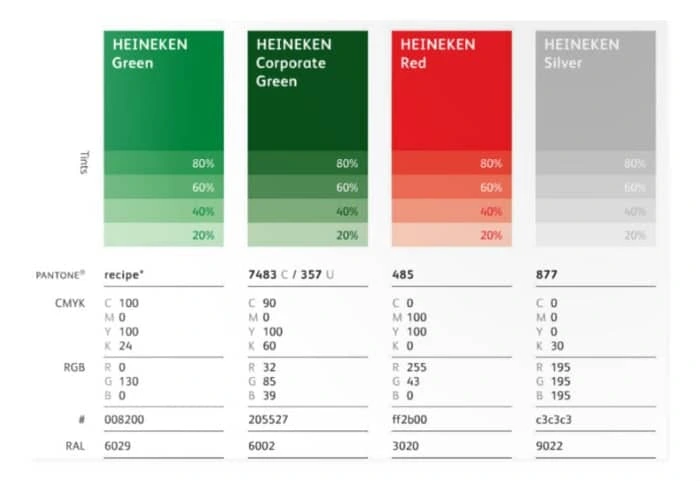
Source: 99designs
And just as it is with your logo, you need to outline how and when each color should be used (Which ones are for text and design elements? Which are for the logo, and which are for backgrounds?). Mayven also points out that you should define the following:
- color names
- color values (CMYK for print, RGB & HEX codes for digital, and PANTONE name & number)
- primary, secondary & alternate colors
Typography
Similarly, there should be a defined font style for both print & digital applications. In your brand book, typography should cover how and when certain fonts are used, which typefaces are acceptable, as well as guidelines for additional styling, size, and use of color.
As pointed out by Mayven, most brands use one or two primary typefaces, a complementary typeface, and substitute typefaces.
Tone of voice
As with all the other elements on this list, your tone of voice needs to be consistent across all communication channels—email, social media, press releases, blog posts, ads, etc. Your voice should be aligned with your brand’s persona, mission, vision, values and target audience.
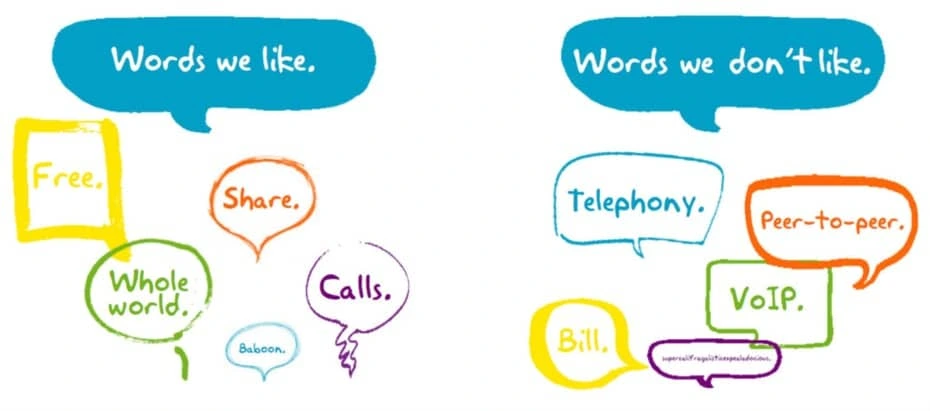
Source: 99designs
You can start by identifying words you like and don’t like to be associated with. Then, decide what type of language fits your brand persona and your target audience. Go back to your list of adjectives describing your brand personality to come up with language that is on-brand.
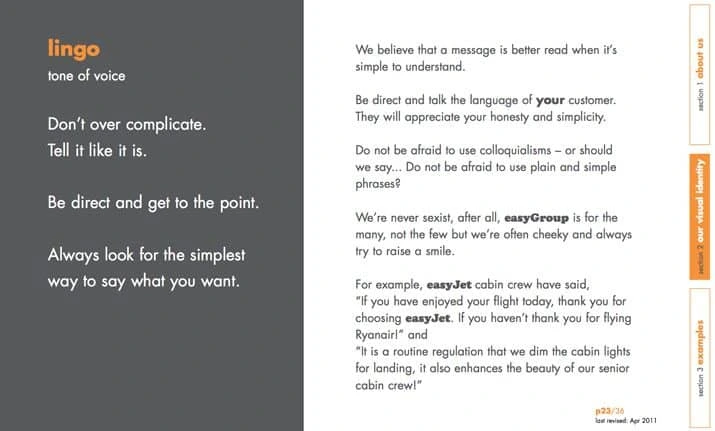
Source: Design Shack
Imagery
Apart from indicating whether you’ll be using photos, illustrations and other types of graphics (as well as when and how you’ll be using them), your brand book should also detail how images will be edited, which colors to place them with, and any other design elements related to image use.
Collect inspiration from successful brands, particularly those that have similar brand messaging as yours. You can also create a mood board with images that convey the feelings you want people to get when they interact with your brand.
Key takeaway
A thoughtfully crafted brand book will bring your business consistency, alignment and cohesion. To avoid confusion, your brand book needs to be detailed, covering all possible bases to ensure everyone’s on the same page. It will give every employee in the company a concrete framework to work with, while still giving them the freedom to do what they do best.
Today, over half of the world (4.89 billion people) use social media. A pretty staggering number, right? What’s more, a typical social media user spends an average of 151 minutes per day scrolling through their feeds. Given all of this, it’s easy to understand why most brands are active on social media today. There’s a huge opportunity to grow your brand awareness here, especially if you follow the right strategy.
So how can you cut through the noise and make sure your brand stands out to the right audience? Let’s go over a few tips that will help you get the most brand awareness out of our social media efforts.
Choosing the right platforms
Right now, there are over 120 social media platforms out there. Thankfully, your brand doesn’t need to be on all of them to have an impact. Remember the phrase, “more isn’t always better”? That’s a good mantra to keep in mind when you’re choosing the platforms you want to be active on.
With so many options, it’s okay to be picky here. To help you get started, consider the strengths and weaknesses of each platform, along with the demographics of its user base and how easy (or difficult) it will be to get your content in their feeds.
Of course, just because one platform is popular doesn’t mean it will necessarily be a good fit for your brand. For instance, if you’re an HR consulting firm targeting c-suite teams, your content might be more suited to LinkedIn than TikTok – despite it being the fastest growing platform out there right now.
One last note here: While we think it’s important to be somewhat picky here, try not to put all of your social media eggs into one basket. As platforms grow and change, they may no longer be suitable for your brand. For example, you don’t have to look very far to see plenty of brands that either paused advertising or left X a.k.a Twitter entirely after controversial changes to the app and its leadership.
Creating a brand persona
Brand recognition = brand awareness. There’s nothing that builds brand recognition faster than a unique, memorable brand persona. Think of this as the voice and POV of your brand. What – or who – does your brand sound like?
Nailing your brand’s personality is one of the most important parts of building a rock solid social media strategy. Knowing your target audience inside and out can help – after all, it’s much easier to develop a brand persona that will resonate if you know the kind of people you’re looking to reach.
But what if you have multiple audiences? No need to fret. You’ll just want to develop a more flexible brand voice that can speak to your different audience segments. For example, you may showcase more of your brand’s fun, humorous side on TikTok, while your LinkedIn presence may be more focused on product updates, internal news, and informative content.
Publishing authentic, consistent content
If you want to thrive in today’s over-saturated market, your brand needs to be consistently producing high-quality, engaging content.
You can start by focusing on topics closely related to your particular niche. For example, if you own a plant shop, you can share information on various plant species, as well as helpful tips and tricks on how to take care of them.
Pre-measured templates are an easy way to start building on-brand content at scale. At Marq, we’ve got a library full of social media templates to get you started.
Lastly, a note on consistency. You can post the most amazing content, but if you’re only posting a few times a year, you’re not going to be able to build the kind of brand awareness that a more active account can. If you’re irregular or inconsistent with your social media branding efforts, your audience might forget about you. (Plus, your absence and lack of posts might even make them think you’ve forgotten about them, too!)
If you can’t post consistently on a regular basis, try using scheduling tools. Schedule your posts at peak times when your followers are most active. This will give your content the best chance to gain visibility and momentum.
Building brand awareness through audience engagement
If you look at successful brands on social media, the vast majority of them interact regularly with their audience. They start conversations, ask questions, and interact with their fans in many of the same ways you might interact with a friend.
Intentionally engaging with your audience can have an incredible impact – not only driving brand awareness but helping people build an emotional connection with your brand.
Here are just a few methods for drumming up engagement on your socials:
- Host giveaways or promotions with branded hashtags
- Sprinkle in user generated content into your social calendar – and encourage your followers to tag you in their own photos for a chance to be featured
- Partner with local or micro-influencers to build a sense of community around your brand
- Respond to audience comments, questions, and concerns to create trust
Key takeaway
It’s not enough to simply have a social media presence anymore. Any brand can publish content, but those that truly go above and beyond have the chance to cultivate a level of brand awareness that rivals the world’s leading companies.
Want to streamline your social media content creation? Check out our template library and start designing on-brand today!
What is brand authenticity? Well, generally speaking, it’s when brands act, illustrate and feel (or be) genuine to their customers.
The byproduct of brand authenticity is more important than brand authenticity itself — i.e., brand loyalty. Brand loyalty is the emotional affirmation of your brand’s authenticity. And brand loyalty is what drives your revenue.
Related: 7 Key Elements of Brand Identity Design
But brand loyalty requires hard work and patience. And it involves understanding your customers’ core values and delivering on them.
So, what makes a brand authentic?
- Reliability
- Respect
- Realness
Brands that do all three are brands that customers prefer and trust. How can you adopt these qualities and make your brand more authentic?
We gotcha!
TIP 1: Be reliable – Quality over quantity, and keep your promises
Seems like a no-brainer, right? Unfortunately, there’s an authenticity deficit in the global marketplace today. Not all brands keep the promises they make, not all communicate honestly, and not enough place the customer’s interests above their own.
Take any variety of tech companies for instance (with admittedly the exception of large-scale corporations like Google, Facebook and so forth… kindly ignore those!) PayPal comms SVP Franz Paasche said: “Tech brands combine the excitement of innovation with [making] the everyday living of life easier, and that gives you a trusted role in people’s lives.”
For example, even when Microsoft felt customers brand loyalty wane after the launch of its disastrous Vista operating system, they hit the ground running to find out why it let their customers down and focused its efforts on trying to right the wrong.
Kathleen Hall, advertising and marketing VP of Microsoft, said: “We went back to our consumers and did a global study, visualizing what the brand meant to them. There was consistency worldwide: Microsoft means opportunity, access and connection, a combination of strength and possibility.”
Ten years later, the company is still enjoying the fruits of that study. The idea is to take stock of what people need and expect from you, then deliver on your promises. What you do on the ground can sometimes speak more than your marketing dollars ever could.
TIP 2: Be respectful — Customer-centricity is key to revenue growth
By far, the most important aspect of a brand’s authenticity is its customer-centricity.
It’s crucial to treat your customers as the most pivotal part of your business. You don’t need a major PR push to show the world how much you care, instead what you need are genuine efforts to deliver the basics and help your customers.
Take the Patagonia brand as an example. The company mission statement is to “build the best product, cause no unnecessary harm, use business to inspire and implement solutions to the environmental crisis.” To that end, the company has many checks in place to ensure it hits on that mission statement. Such as:
- Environmentally-friendly production practices
- Educational programs and initiatives for the public
- Fair pay and wages for it direct employees and partner employees
Now, that’s just the beginning. To see for yourself, check out Patagonia’s core value page!
TIP 3: Be real – Personalize customer communications
Authenticity doesn’t come from the product or service you sell, but from how, why and where you sell it.
Winning brands take great pains to communicate with customers in ways that feel personal. They see themselves as a productive part of the customer’s life, and each marketing message is personalized for them. They nail practices like cross-cultural marketing, localization, creating dedicated websites for different countries, and identifying as a local brand despite being a global brand.
By being real, you inevitably build trust and rapport with your customers. And to establish that trust, you need to be honest in your words and actions. Michael Boychuk, the former executive creative director of Amazon, said: “You can say whatever you want, however, you want to say it, but if you’re not interacting with people authentically, advertising is nothing.”
Be really reliable, respectful — and really real
Be reliable, be respectful and be real. That’s what gets customers to trust you and perceive you as an authentic brand. Revenue and profits are a byproduct of customer-centricity. Always remember that a good brand serves the customer. If you can take these ideas to heart, you’ll build better brand authenticity than millions of marketing dollars ever could.
Want to know more about the power of a strong brand? Download our free 32-page report, chock full of stats & great insights.
Over the last decade, marketing has undergone a variety of changes. The purchase funnel is more complex than ever before, and marketers have more information at their fingertips.
Marketing is smarter now—it pulls data from different sources and uses modern technology to reach new customers and keep existing ones. It’s possible to predict where the next trend will lead, which helps with planning out marketing campaigns for the months ahead.
Related: 25 branding stats & facts that will change your life
Out of top-performing companies, 65% have a written content marketing plan. Before you focus on any specific marketing trend, you should write out your goals for the year and how you plan to reach them.
Major goals include increasing sales, adding more customers, retaining current clients or expanding brand recognition. Once you have a specific goal in mind, consider the following trends as potential ways to reach it.
1. Intelligent marketing attribution
Artificial intelligence (AI) helps marketers and brands determine where their impressions, sales and leads come from more easily than trying to analyze data manually. Since most data is already in the cloud, AI simply takes that data, does a few computations and comes up with algorithms showing what works from a marketing standpoint and what needs adjusting.
Use AI and recognize patterns from different data sources so you can predict upcoming changes. For example, say your inventory records show that every November, sales of blue sweaters pick up, and you’ve sold out of blue sweaters the last seven years in a row. Now you know you should probably order more blue sweaters before November.
Marketing and sales will intricately tie into one another, so marketers know which inventory to push, and salespeople know what inventory they need more of. The seamlessness of a system that tracks marketing efforts, results and sales means more effective marketing—and more revenue.
2. Increasing voice search
About 13% of all U.S. homes owned a smart speaker in 2017, and experts predict that number will reach 55% by 2022. An increasing need for voice search will drive marketing towards offering voice-friendly search functions and thinking about the way people naturally speak.
What questions does a person ask when hunting for a specific product?
With conversational AI, marketers have an opportunity to send out targeted messages faster than in the past. AI can analyze the voice search conducted around a subject and help you craft descriptions and website information to match those long-tail keyword phrases.
Expect voice search to impact brand voice as it becomes more prominent, even on social media and e-commerce sites. Marketers should be aware of the key phrases people are using for voice search, so marketing campaigns align closely with those phrases.
3. A/B testing with AI
A/B testing is a powerful tool for marketers. It empowers them to quickly see how changing one element of an ad campaign or landing page impacts their conversions. As AI adoption increases, brands no longer need their own data science departments. Instead, they can call on a huge pool of information stored in the public cloud.
In the past, A/B testing meant trying out changes on one element at a time and waiting several weeks before getting the results. In 2019, expect A/B testing to become lightning-fast as tests are streamlined. You’ll be able to find out how multiple variants work with just a few clicks of the mouse. The result is a visually pleasing design that attracts users.
Marketers will become savvier about which types of AI to use for which projects, saving time and money for their companies and making the analysis more accurate than ever before.
4. Automated workflows
Adding automated workflows saves time and effort because it gives marketers the freedom to focus on tasks that can’t be automated. [] For example, you could create a workflow that pairs phone calls and emails. If you make a phone call and get the person’s voicemail, an email is triggered along with your voicemail message. If you spent time discussing a specific aspect of your brand with a lead, then you can trigger a different email.
Personalization is still possible, even with automatic triggers. Simply add the person’s name and change a few details based on your conversation. For most brands, though, the same conversations happen over and over, and the same emails go out after those conversations. Automated workflows keep you from repeating the same work multiple times.
5. Experiential content
In the past, e-commerce stores have presented simple, straightforward descriptions and images. However, as augmented reality (AR) enters every area of life, expect websites to become more of an immersive experience.
Online retailers create content that engages the user and creates an experience. One example might be a local real estate brand. Rather than simply throwing up a few photos and a description of the property, they’ll give you an interactive 360-degree walkthrough, where you choose which room to go into next and which angle to view the room from.
Storytelling and user experience will be more critical than ever before.
6. Relevant and interesting videos
Video is no longer optional when it comes to marketing. The trend for a while has been heading towards more video-viewing, but recent studies show that about 73% of Americans engage with YouTube. Across all social media platforms, video-viewing is on the rise. What does this mean for marketers in 2019? It means video is a necessity when it comes to creating a marketing campaign.
However, consumers are also savvier than ever before, so throwing up just any old video isn’t going to work. You need short, to-the-point and entertaining videos if you’d like the attention of your target audience.
Key takeaway
Effective marketing includes planning for a digital presence, but your efforts should also take into account changes in technology and how people interact with brands online.
In addition to the behavior of customers, you must also consider any Google algorithm changes and where your target audience hangs out online.
The savviest marketers never stop learning about trends in the marketplace and aren’t afraid of trying new techniques to stand out and grab attention.
Open source learning. A global economy. Shifting demographics. These are just a few realities impacting your college recruitment strategy.
According to the National Student Clearing House Research Center, Spring 2018 college enrollment across U.S. campuses was down from the previous year. University and college recruiters have shifted to overdrive in response.
Related: How to improve higher ed student retention
Some focus on radio ads, alumni referrals and online recruiting fairs. Others build interest on social media and at live events.
Regardless of the outreach method, one thing is clear: In today’s higher education landscape, recruiters must be increasingly creative and strategic to attract new students.
A varied college recruitment strategy
“The times, they are a-changin’,” sang Bob Dylan. Want to keep up? Pay attention to your audience.
Today’s students don’t want a cookie-cutter version of their parent’s university experience. They’re also not impressed by (pun alert) old-school marketing tactics.
Instead, create a varied strategy that will reach your top prospects on multiple channels. Essentially, you want to provide engaging information that helps your college sell itself.
Use multi-channel enrollment marketing
Most colleges and universities know their target demographic well, and they market to basically the same audience year after year.
However, success also depends on reaching new targets via a multi-channel approach:
- Website — a branded, responsive hub that’s easy to navigate and engaging to use
- Blog or vlog — where interested prospects go for bite-size information
- Social media — critical online outreach, both locally and internationally
- Email campaigns — important tactic for lead generation and nurture
- Direct mail — still relevant and effective marketing for certain audiences
- Phone calls — an effective, if time-intensive, method for personal outreach
- Brand ambassadors — relatable outreach by faculty, students & alumni
- Parent outreach — critical influencers of your target audience
- Campus visit days — highly successful recruiting events, up close and personal
- High school visits — successful outreach that meets students where they are
- College fairs — key events that can market your institution both off and online
- International markets — a growing segment of your target audience
Now, for a few of the most helpful enrollment marketing strategies…
Recruiting college students online
It’s no surprise that most prospective students live online, particularly on mobile technology.
So, today’s recruiting strategies must be mobile-friendly. End of story.
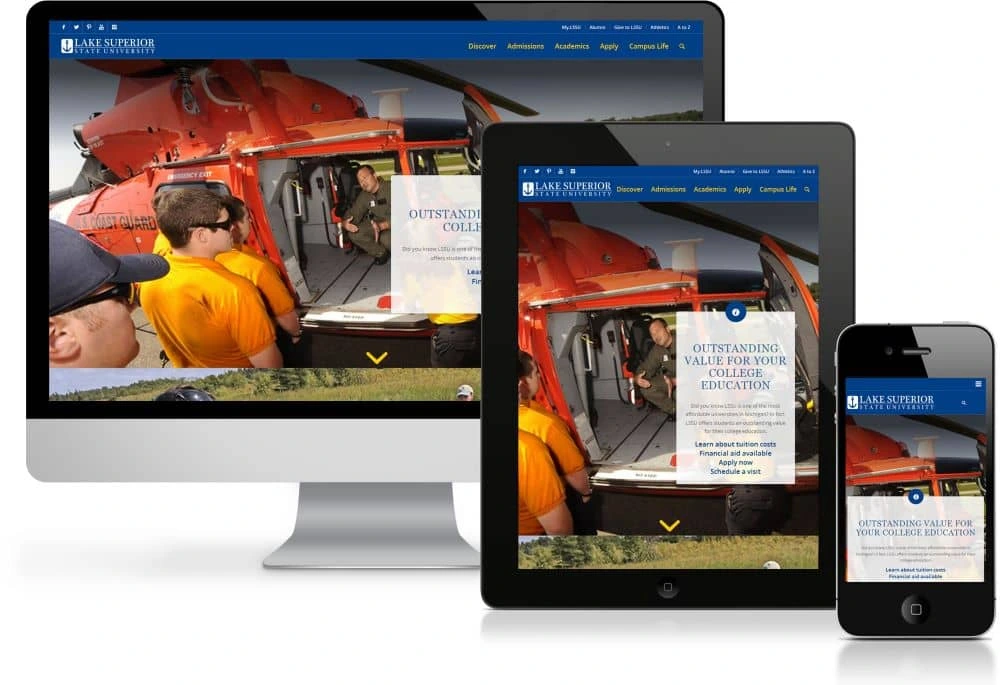
Source: Lake Superior State University
Responsive web design is no longer optional. But, you’ll stand out even more by offering mobile-friendly instruction and interactive pages.
For instance, students are wondering what they’ll learn on your campus. Why not show them instead of tell them?
Continuing education is common enough. But, standout institutions are experimenting with AR, game-based platforms and social learning models. Just one interactive feature on your site can put you ahead of the curve.
Even without all the technological bells and whistles, you can still provide value to new recruits.
Offer valuable resources
Don’t just throw a bunch of content on your website and call it good. Instead, create a user-friendly path that puts visitors at ease.
Which resources are clicked on the most? These might include:
- A catchy, above-the-fold video
- A listing of popular majors
- Programs and career opportunities
- Student and alumni testimonials
- Admissions deadlines
- Financial aid information
- Data-rich infographics
Simplify the application process
Of course, what you don’t include on your homepage can be equally important.
Generally, anything that simplifies your navigation and motivates would-be students to apply online is a good thing. Often, it means including more white space in your webpage design.
Face it—applying for college can be a daunting task even for the initiated. So, a user-friendly interface is essential.
Why not include a pithy video tutorial or a colorful step-by-step checklist to make the application process less painful?
Also, non-traditional students (e.g. adult learners, international students) generally want to know about credit transfers, flexible course listings, and financial aid options.
Build your blog
Most colleges today have a blog. What about your college?
More importantly, does your blog cover the topics your prospects care about most?
Boston University’s blog regularly shares pithy thoughts and videos by faculty members.
Likewise, Cornell University publishes “life on the hill” posts that help wannabes sample current students’ daily academic routines.

Source: Cornell
Your blog might also feature guest posts by alumni, video tours, listings of popular courses, and user-generated content.
And of course, the most popular blog posts should factor into your upcoming email campaigns.
Direct interaction with prospective students
As you can see, a successful recruiting strategy contains many moving parts. But, personal interactions (phone calls, campus visiting days, etc.) are still the most powerful of these.
According to Hanover Research:
“Despite increased digital activity, a recent survey found that the most effective marketing strategies for universities are nevertheless events‐based and involve direct interaction with potential students.”
After all, sometimes it really is about your newly upgraded facilities, swanky campus and student perks.
Most prospects who’ve gotten this far already know about your tuition costs, financial aid options, and faculty-to-student ratio. A successful campus visit just helps close the deal.
International student recruitment
Quick—what’s the Chinese version of Twitter?
If you’re recruiting students from China, you already know the answer to this question. (It’s Weibo, by the way.)

Source: Statista
As you can see, international student recruitment is alive and well at American colleges and universities.
As discussed earlier, your website needs to be user friendly and easy to navigate. This is particularly important if you’re appealing to international students.
Your site should help this target demographic understand the advantages of studying in America—and at your institution specifically.
Simple videos and infographics can also help smooth potential cultural barriers.
Do you already feature international students in your recruiting videos? If not, now’s the time to help them share their story—in their language.
As appropriate, include video links in your email campaigns. Share these on international social media channels.
Your website should also include pages dedicated to the specific needs of international students and recruits.

Source: Cornell
Reduce educational jargon
Higher education is adrift in educational jargon, which can be painful even to American-born students.
All those acronyms can be excruciating to international applicants. Whenever possible, cut them out and use a simpler description.
In the end, remember: Every positive interaction with a brand depends on clear communication.
Key takeaways
Now that you’re familiar with what it takes to build a successful recruiting strategy, let’s wrap things up by considering the real-life example of Western Colorado University. WCU’s creative team struggled to manage their recruiting strategy and materials, as they were too busy trying to keep their head above water.
Read Western Colorado University’s full case study here to learn how they dealt with their recruiting and marketing problem.
Is your school delivering a strong, consistent message with its brand marketing? Learn more in our free ebook: Branding in student recruitment
Last week I received a letter in my mailbox for the first time in a long time. It’s been ages since someone (even a company) sent me physical mail rather than going the easier route with email.
It really felt good to have something that I can touch and feel with my own hands.
Related: 11 best direct mail pieces to inspire your next campaign
Sometimes, the dull and boring side of advanced technology makes us realize we’ve come a long way. There was a time when people used to get a lot of mail in their mailboxes, especially in the form of promotional material.
Gradually, companies left that behind and considered it defunct. But in reality, direct mail is still a great way to engage with one’s audience.
Why? Because in our modern age, it provides a personal touch that email can never replicate. Data published by the Data & Marketing Association in 2016 showed that the response rate of direct mail increased 43% year-over-year. This is a huge leap from previous years.
Companies should know that it’s short-sighted to completely do away with direct mail. It’s still an effective and useful tool. To drive home the point, here are eleven reasons why every brand should (re-)consider direct mail.
1. You can achieve a higher ROI
Most companies set up online ads hoping to see better ROI because of the huge number of internet users.
But, direct mail can drive even better impact: a median ROI of 29% compared to online display at 16%.
When someone receives physical mail, it carries more weight (and not just literally). Customers are more likely to respond to communication that feels personal, and direct mail makes it easier to send that message.
2. Direct mail pairs well with digital marketing
If you want to build your own brand online or enhance the reputation of your company, digital marketing is usually the best place to start.
For many brands, this includes publishing SEO-optimized content and setting up Facebook ads. It usually doesn’t include direct mail… but maybe it should.
Direct mail can help you bridge the gap between the digital world and the real one. You can reach potential customers who might otherwise never hear about you—and you don’t always have to sacrifice data to do it.
For example, a digital marketing agency in our own state (Utah) included a scannable code on the back of one direct mail piece. They could track engagement with that code just like they would any other online campaign. They also included a Twitter hashtag that people could use to interact with the campaign. These techniques help to tie everything together, so their team got a holistic look at their campaign’s performance.
3. You can hold direct mail
This might seem obvious, but humans are sensory creatures. An email lives on your digital gadgets, where you’ll never be able to touch it. People can actually touch and feel the direct mail that a company sends to them, and because of that, it leaves a stronger impact.
This is especially valid for pieces that provide real-world value, like a free sample or discount coupon. Customers are more likely to remember and redeem those promotions than the ones they’re inundated with via email.
4. Attention, please!
When people check their mail, they take and go through everything they’ve received. It’s almost guaranteed that they will look at each and every piece, even if it’s only for a moment. Then they have to decide what to do with each piece—deciding which ones are worth saving and which ones are okay to throw away.
Conversely, when someone’s checking their email, they’re often engaged in other behaviors and environments that divide their attention. For example, they could be multi-tasking at work or watching TV on the couch. Since direct mail deals with fewer distractions, it benefits from better attention spans.
5. You can track direct mail
There are plenty of email & direct marketing tools to track the progress of your email campaigns. What about direct mail? Yes, it’s true that the process isn’t fully automated in the same way—but you can make them easier to track.
For example, you can designate a phone number or email address solely for the target audience of your direct mail campaigns. You can also create specialized landing pages with unique URLs. This will greatly improve the quality of your data and the accuracy of your success metrics.
6. All ages welcome
Any time you opt for a particular marketing strategy, it’s vital to understand which age groups that strategy serves.
In the case of email marketing campaigns or online advertisements, seniors are often left out because they adopt technology later than the younger generations. If seniors are a key demographic for you, you’re probably leaving money on the table.
Instead, consider reaching that audience with direct mail. And don’t assume seniors are the only ones—other audiences could benefit, too. Take a look at your audience and think about whether direct mail could extend your reach.
7. When others zig, you zag
Since digital marketing has so thoroughly transformed the landscape, many companies have quit using direct mail altogether. Just because fewer people are using it, however, doesn’t mean it’s an obsolete tool.
In fact, there’s a little bit of irony at play here: Your brand can stand out by reincorporating direct mail as part of your campaign. The high ROI speaks for its validity, and you can get the best of both worlds by adding physical mail to your digital campaign.
8. Direct mail can help you target specific audiences
We’re used to seeing the targeting capabilities of various social media platforms. But, did you know that direct mail can also target specific audiences?
For example, the USPS website has a tool called Every Door Direct Mail, which lets you send mail to addresses within a selected geographic area. This is the same system Lucidpress uses to send direct mail postcards from our platform to the local areas you want to target.
It’s not only about location, though. Address databases often contain other details you can use to target an audience: age, income, marital status & more. With these, you have granular control over who to send your direct mail to.
9. You can raise brand awareness
Are you trying to raise awareness of your brand? If you’re willing to build a campaign around that goal, direct mail can be a very effective way to achieve it.
As always, brand consistency is key, so keep your direct mail pieces consistent with overall branding.
You can earn extra points by including a coupon or another special offer, increasing the likelihood that your recipient will keep it around. The more times they view your direct mail piece, the more familiar your brand will feel to them.
10. Direct mail tickles the senses
Quick: name the five senses. Now, name the senses you can activate with a digital marketing campaign. Suddenly, your options are a lot more limited.
Sensory experience is a huge part of getting a response from an audience. If you’re only marketing online, you’re limiting yourself to sight and sound.
With direct mail, you can activate more senses like smell, taste and touch. (For example, think about those perfume ads you used to find in magazines.)
The more senses you can trigger, the more likely your customer will be moved by your message.
11. You can let your creative juices flow
In digital marketing, where best practices and A/B testing determine all, have you noticed that most company websites look… pretty similar?
Refreshingly, direct mail is a channel that brands can experiment with to create something new and innovative.
In fact, the more your mail stands out, the better. Take a look at some of the fun, creative ideas in this Pinterest board of direct mail marketing ideas:
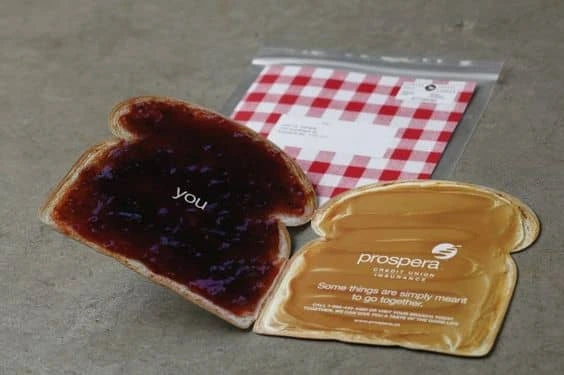
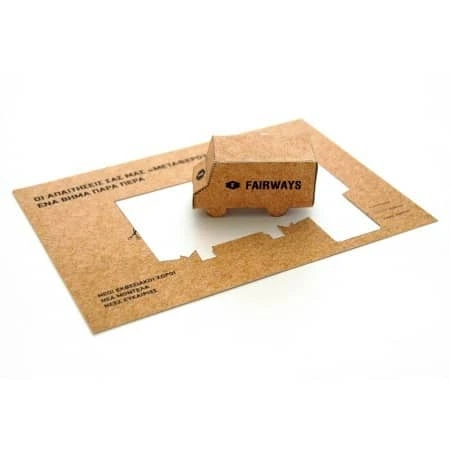
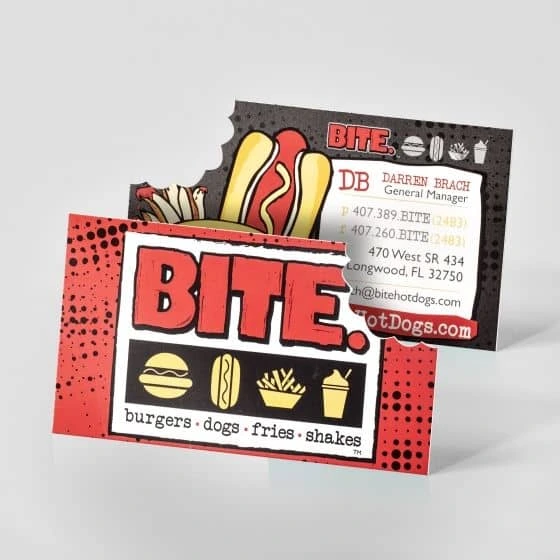
Key takeaway
Cutting direct mail from your marketing strategy because you assume it’s dead is misguided. Direct mail is still alive and well, and there are strong reasons to include it in a well-rounded campaign.
From higher ROI to stronger impact, brands are still reaping the benefits of direct mail today—and so can you. Bring these eleven reasons to your team the next time you’re planning a marketing campaign. They might just be surprised at the results.
Ready to build your own campaigns in minutes? Learn more about the direct mail features in Lucidpress, and give it a test drive.
When it comes to reaching your customers, one channel simply doesn’t cut it anymore. Consumers are researching brands through search, mobile, email, social media, in-store and a lot more, so it’s necessary for you to build an omnichannel marketing strategy that engages them across all platforms.
What is omnichannel marketing?
Omnichannel marketing is an extension of multichannel marketing. While multichannel marketing focuses on distributing content across various print and digital channels, omnichannel marketing focuses on creating a cohesive experience as a visitor moves from one channel to the next.
Benefits of omnichannel marketing
Not convinced? Here are more reasons to incorporate omnichannel marketing, both online and off, in your marketing plan.
1. Repetition reinforces your brand message
Imagine this:
A consumer sees an ad for your product on Facebook. She clicks it to visit your site but doesn’t make a purchase. She signs up for your emails while she’s there and clicks to follow your brand on Instagram.
In a few days, she gets an email inviting her to save 20% if she signs up for your text messages, so she does. Once she gets that offer via text, she makes her first purchase.
As you can see, the path to a sale isn’t always a straight line. If it had been, this person would have made a purchase at the first point of contact when she saw your ad. But, it took a few different messages on multiple channels to convince her to buy from you.
Being where your customers are online means you drive your marketing message home.
2. Creative consistency is key
You can’t simply plaster your message across a dozen marketing channels; you also have to be consistent in what you communicate. That means your brand logo and tone of voice need to be the same everywhere so that consumers recognize your brand and can let that message seep in.
There is one caveat: You don’t want to give identical offers or promotions on all marketing channels—it dilutes their effectiveness. You need to give people a reason to sign up for your emails, subscribe to text messages and follow you on social media, so make each offer exclusive to that channel.
3. All channels should lead back to your website
If you worry about confusing people with so many marketing channels, keep in mind your end goal: driving traffic back to your website so you can make a sale if you sell online. Your social media updates should include a link to the product that you’re promoting. Your emails should contain one link and one call-to-action each so that customers know exactly what you want them to do. Online ads should link back to your site.
The great thing about omnichannel marketing is that it’s so easily tracked, both online and off. You can look at your website analytics to see which channels sent traffic to your site and step up your investment on those channels or pull back from ones that aren’t getting results.
Offline, you can measure redemption of text message offers or coupons you post on coupon sites by using unique offer codes that you track through your point-of-sale system.
When you know what’s driving traffic and sales, you can tweak your marketing plan to give even better results with channels and types of offers that are appealing to your customers.
4. It’s great for new businesses
Omnichannel marketing isn’t just for well-established retail brands with giant marketing budgets. If you’re a new business, spreading the love across marketing channels can establish a foothold for your brand identity.
You may even get to know your customers better as you pay attention to how they respond to your messages on different marketing channels. Let’s say you start using Instagram to market your product, which is geared toward baby boomers. You might quickly learn that not many boomers use Instagram, and branded content targeting this demographic on Facebook gets you much better engagement.
5. You can reach different customer segments
You may market to different types of customers, who more than likely have different habits when it comes to interacting with brands online. The more channels you use to reach these disparate groups, the more successful you will be.
You can reach Gen Z through mobile and Gen X through social media at the same time. You can help boomers find you with print or online ads. You can appeal to moms, teens and outdoor types… all through slightly different marketing strategies that don’t exclude the others.
The more granular you are in marketing directly to a slice of a customer segment, the more successful you will be, because they feel like you are speaking directly to them with your message.
6. You get instant results
A few years ago, when print coupons were more popular, it would take you months to know whether a coupon campaign was successful or not. The same went for print advertising or TV spots.
But now, digital marketing has revolutionized the way we launch, modify and analyze marketing campaigns. You can see the results of your efforts in real time. If, after a few days, your social media ad isn’t moving the needle, you can easily modify the copy or the offer to see if you can improve results.
Mobile coupons are great for instant analysis, too. Your mobile marketing dashboard will inform you how many redemptions a given offer has had. You can use that data to decide whether you want to offer something similar in the future or test out a different offer.
The instantaneous benefit applies to connecting with customers in real time, too. If someone has a question about your brand, they can ask it on your Facebook page’s Messenger. You (or your handy chatbot) can answer the question immediately, delighting the customer with your prompt response.
7. You can build loyalty
One of the best ways to boost your business is by creating a loyalty program that encourages customers to shop with you more to earn points they can use on free products or get personalized discounts.
Omnichannel marketing works well with loyalty programs: Shoppers can sign up in seconds at the point-of-sale using their mobile wallet, get offers via push notifications or email, and check their balance online or on their phones.
Key takeaway
Marketing has certainly changed over the years. The key is rolling with those changes and diversifying where you try to connect with your audience. With so many wonderful channels to do so, you can customize your approach to maximize results.
Want to learn more about the power of consistent brand marketing? Download our free 32-page report, chock full of stats & great insights.
There’s more to crafting a memorable brand than putting together a quick logo and color palette. Instead of calling it a day there, successful brands take the time to design a well rounded brand identity – one that combines a strong purpose with intentional visual and written elements.
Here, you’ll learn the seven key elements of brand identity design, and how they work together to build a consistent brand your audience will love.
New to the branding game? Let’s go over some important context.
What is brand identity?
A brand is the sum of how a person, product, or business is viewed by its audience and/or customers.
Brand identity is how a business wants to be viewed.
These two ideas often go hand in hand, but can sometimes be at odds, depending on how well a brand is able to cultivate and maintain their brand identity.
If we zoom in a bit, brand identity design includes everything from logos, and typography to colors, packaging, and messaging. Ultimately, the goal here is to create an ecosystem of visual and written elements that complement and reinforce your brand’s ‘why’. Once established, your brand identity can both attract new customers and help your current customers feel at home.
That’s why It’s vital that your brand identity stays consistent. Because they represent and reinforce your brand’s purpose, your brand identity elements need to be clear and consistent wherever they might appear.
Why is brand identity important?
If you were about to interview for a big new job, you wouldn’t show up in sweatpants. You’d want to present yourself as a well put together, competent, and approachable candidate.
The same idea applies to your brand. Your brand identity is the face of your business, and you want to put your best face forward for your audience.
Along with building credibility and trust, a strong and consistent brand design should also give people insight into what your brand is all about. For example, do you use bright, pastel colors to convey a cheerful, playful tone, or do you employ detailed line art in your logo to imply an artisanal level of quality? When you’re thinking about what you want your brand identity design to look like, consider what it will feel like as well.
To give you a better idea of what we mean, take a look at these three brilliant examples of brand identity:
3 examples of strong brand identity design
When you’re designing your own brand identity, there’s no need to start from scratch. Here are just a few examples of great brand identity design to get some inspiration from.
And while it’s important to create something that’s uniquely your own, there’s nothing wrong with taking a note from some of the greats.
Hootsuite
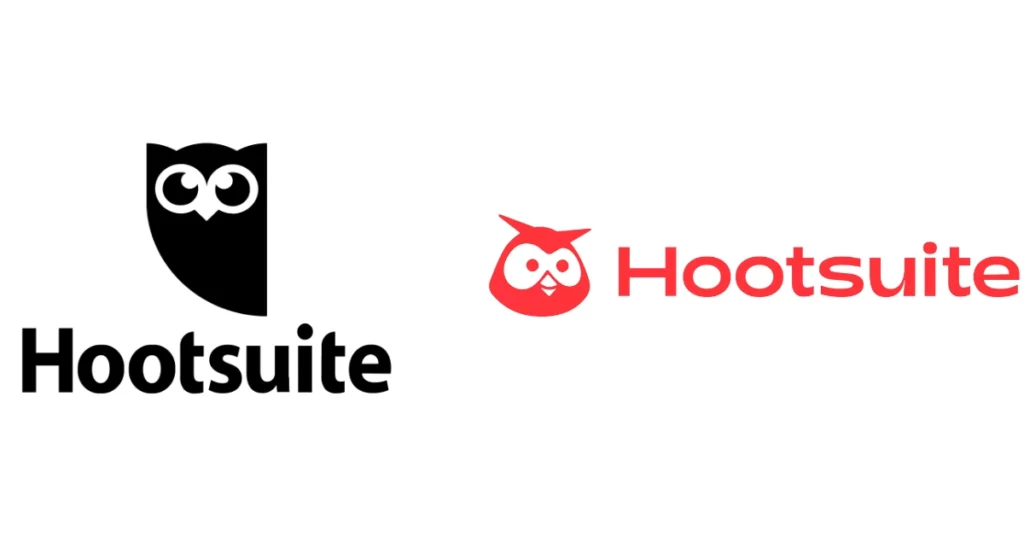
If you look at a lot of tech brands today, you’ll notice that many tend to use similar no-fluff, utilitarian branding principles. While there’s nothing inherently wrong with this, it can become hard to differentiate brands after a while.
We like how Hootsuite’s redesigned logo injects some new color and personality into the social media marketing platform. It’s friendlier, more approachable, and most importantly, more human.
Kodak
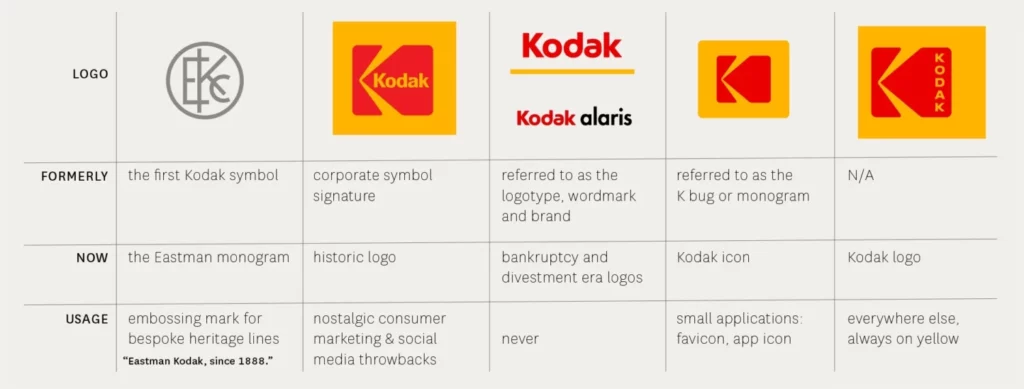
Sometimes, the best rebrands happen when you go back to your roots. In 2006, the company had already eliminated the big red “K” block in favor of a simpler wordmark, but then they decided to reverse the decision. Using a fresh sans-serif font, they were able to create a simple and fresh new take on their logo and typography. It just goes to show that sometimes the smallest of changes can have a big impact.
We love how easy these guidelines make it to view the history of Kodak’s branding, along with the when/how/why to use each design.
Burt’s Bees

In a beauty industry full of incredibly bright, futuristic, or luxurious branding, Burt’s Bees stands out for its humble, down-to-earth aesthetic. With muted colors and thoughtful artwork depicting the brand’s founder, the brand calls back to its purpose – to honor the natural world by creating environmentally-conscious products.
How to build a successful brand identity
Now that we’ve taken a closer look at some great examples of brand identity design, let’s dive into the seven elements you’ll need to build a brand identity your audience will love.
1. Establish a clear purpose and position
The first part of establishing a brand identity is determining your purpose and goals. Brand purpose is the ‘why?’ behind everything you do. Why does my brand exist? Why is my product or service better than the competition? Why does our brand look/feel/communicate the way it does?
According to Arielle Jackson, startup founder, and Google veteran: “Your purpose is how you want to change the world for the better.” Jackson also recommends this diagram as a guide for determining your purpose:
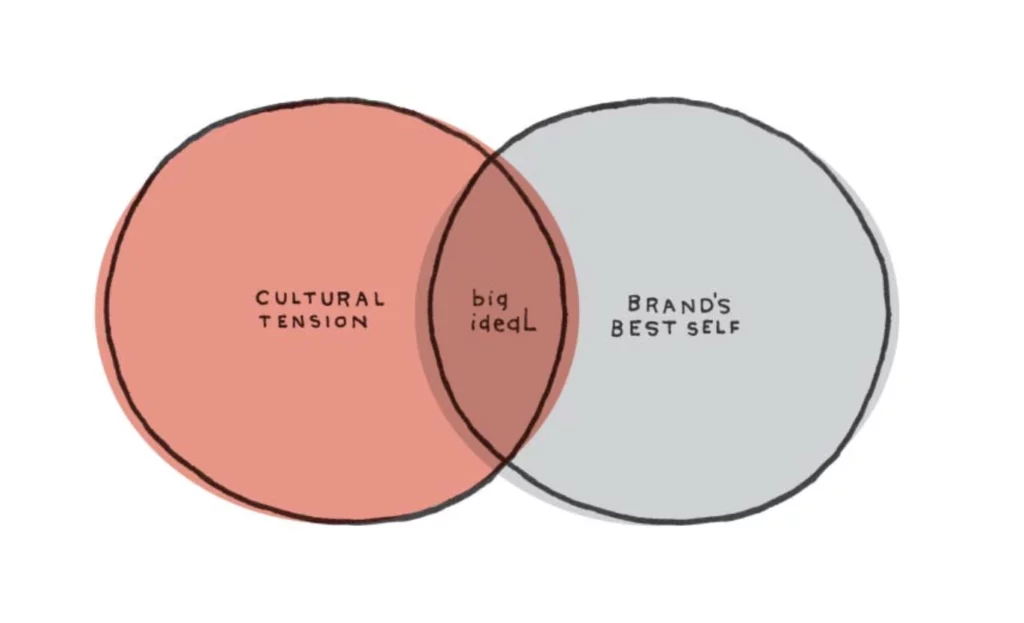
Jackson explains the diagram like this: “In one circle, you have cultural tension. This is what is happening in the world that’s relevant to you. In the other circle is your brand’s best self. This is what your company delivers at its prime,” says Jackson. “The intersection of these two areas is… ‘the big ideal’ — or your purpose.”
For a great example of a succinct, tangible corporate purpose, check out this statement from Apple:
“Apple’s 100,000 employees are dedicated to making the best products on earth, and to leaving the world better than we found it.”
Not too shabby, right?
You’ll also want to spend some time thinking about brand positioning, or the unique value that your brand brings your audience. Think of this as your brand’s ‘elevator pitch’. All the work done here will inform your strategy as you create a logo, decide on a color palette, etc.
Zooming out, brand positioning is the process of making your purpose actionable. By naming your target customer and differentiating yourself from the competition, you’ll lay the groundwork for your brand to accomplish your purpose.
2. Conduct thorough market research
A brand’s purpose and positioning can (and should be) informed, at least in part, by market and customer research. Research is crucial to understand the “cultural tension” described in the previous section. For beginners to market research, there’s a wealth of content online to help get you started.
Oftentimes, one of the best ways to conduct market research is to simply talk to a lot of people. For example, phone interviews allow your teams to have detailed, human-driven discussions with your customers – something that could be helpful if you want to appeal emotionally to your audience.
Beyond phone interviews, online survey tools, like Survey Monkey, are a fast way to gather a lot of information. Don’t forget to look into available government resources too, like this helpful toolkit from the US Small Business Association.
Good market research can also help you determine your main customer personas, a term that is a slightly different concept than “target customers.” Your customer persona(s) go beyond just defining what problem a customer has and gets into the nitty gritty details behind your focus customers’ professional and personal traits. Defining these traits will help you know what kind of personality your brand should have to appeal to customers, which brings us to our next point.
3. Craft a loveable brand personality
“If your brand were a person, what would they be like?” It might be a bit cliché, but this is a smart way to think about brand personality.
If you get your brand’s personality right, it will shine through in every part of your brand identity. Brand personality greatly impacts the voice and tone used in your marketing materials and other communications. Why is this important? Your customers will get mixed messages if your brand’s personality isn’t well established, and they may have trouble connecting emotionally with your brand.
If you’re having a hard time getting started, here’s an exercise to try: Which celebrities or fictional characters best represent your brand? Is there an actor or actress, musician, or public personality that embodies the same traits as your brand? This could be a good starting point for nailing down different aspects of your brand’s personality.
Once you’ve pictured the kind of person your brand would be and listed off a few attributes they have, it’s helpful to think about how your brand will come to life through your voice and tone.
Here is how we defined Marq’s brand personality.

How did we do?
4. Make a memorable logo
Your logo is central to your brand identity design. It’s the piece of your brand identity that most people will be exposed to. It needs to line up with all the other elements of your brand identity and the broader emotional appeal of your brand.
A few guidelines Marq CEO, Owen Fuller suggests on making a logo with an impact:
- Make it memorable. Are there unique elements/colors/etc that make it stand out?
- Make it simple. Can a 3rd grader draw it?
- Make it versatile. Can you apply it across multiple mediums and channels?
- Make it evocative. Does it make you something?
- Make it timeless. Will it work as your brand grows?
For example, we all know this logo:

Disney has built a brand that evokes nostalgia and magic. The playful script oozes creativity and fun, which tracks with the overall brand Disney has established over the decades.
A memorable brand is often the simplest brand. Take a look at the logos of the world’s top 3 brands (according to Kantar):


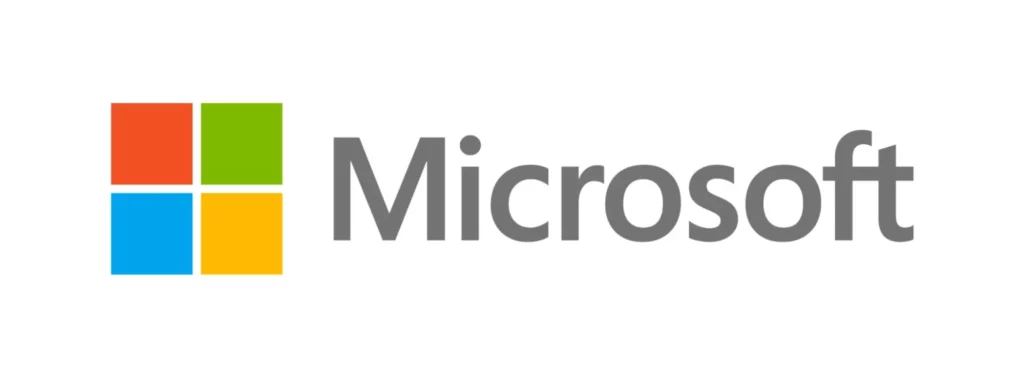
What do all three have in common? Intentionality in color, design, and simplicity.
Speaking of simplicity, choosing a simple logo makes it easier to apply to different mediums. Whether you’re designing for a product, digital marketing, or print, actively designing with every channel in mind will ensure a successful logo development from the very start.
5. Choose an attractive color palette
Evocative and full of emotional potential, your brand colors are often just as memorable as the logo design. Consider looking into the dynamics of color theory when choosing the palette that best represents your brand.
A lot of color psychology is intuitive, like blue expressing calm and red and yellow expressing passion and energy. Depending on the tint or shade of a color you use, that emotion can be adjusted. A tint is a color mixed with white, making it lighter, and a shade is a color mixed with black, making it darker. A lighter tint of blue conveys tranquility, while a darker shade of blue often conveys trust, an effect that many banks use in their color schemes.
Be aware though that color connotations can differ wildly between cultures. For example, while yellow is often seen as a bright, happy color in the US, it is linked with mourning and death in places like Latin America and Egypt. If your brand plans to do business internationally, it’s important to double check that the colors you want to use don’t have any unintended meanings.
When it comes to creating a workable color palette, designers should select a set of primary and secondary colors to be used for specific purposes. Staying consistent with this palette is key – the more you use it in the same way, the more you’ll be able to build brand equity over time.
A few more considerations on picking a great color scheme:
- Make sure your palette has enough contrast when paired with text. This ensures all your marketing materials are easy to read and accessible. Use this tool to double check your palette.
- Double check that your palette reinforces the emotions you want to evoke. If your brand is all about health and wellbeing, strong colors like burgundy or magenta might be at odds with your intended brand identity design.
6. Pick the right typography
Stressing about finding just the right font may lead others to brand you as a “typography nerd,” but you’ll come out ahead when you pick a font that works in harmony with your logo and colors.
Fonts are powerful. The most famous fonts are recognizable even when taken out of context. You’ll want a single primary typeface to lead your brand design, which should work well with your logo and color palette. It should also, like your logo and color palette, be simple.
Here are a few tips to keep in mind when choosing brand fonts:
- Don’t use overly intricate fonts that are hard to read.
- Provide font guidelines for headlines and body text.
- Don’t use more than two font families on a single document. (If it feels like it’s too much, it’s probably too much)
- Do mix contrasting fonts (such as a serif and a sans-serif).
- Give guidelines on font size and line length in your brand guide.
For example, here are several font pairings that work well together:
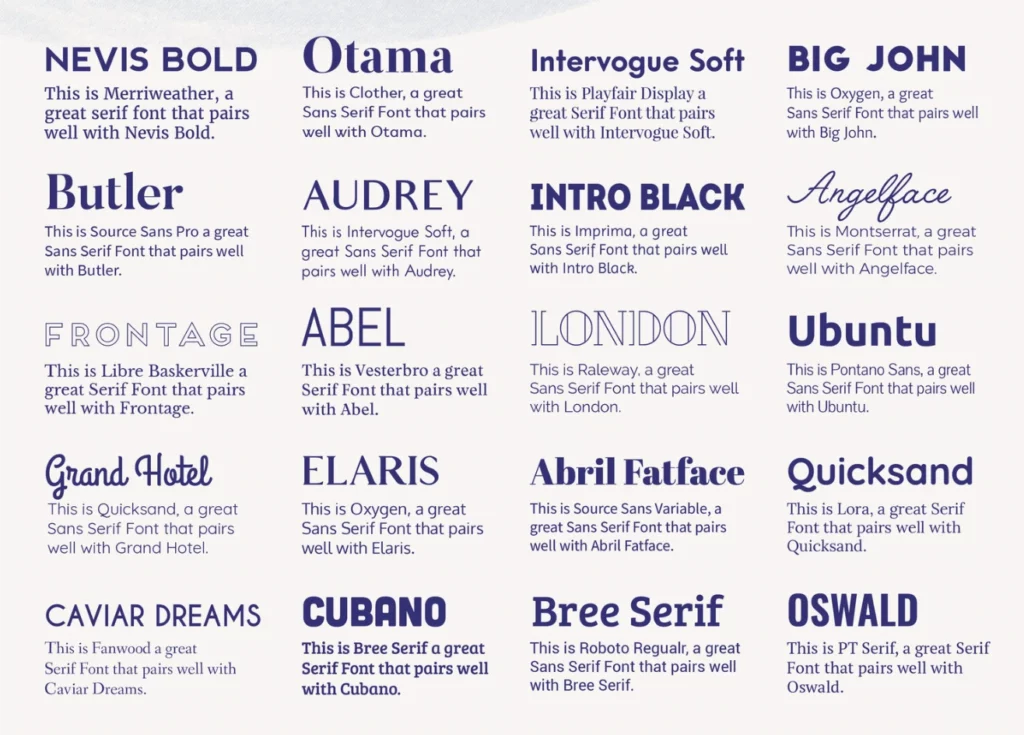
7. Leverage on-brand graphics and photography
The final step in creating a brand identity is to build an extended visual language with supporting graphics, design assets, iconography, and photographs.
Take a look at Google’s Visual Assets Guidelines to see how they carefully explain their take on icon design.
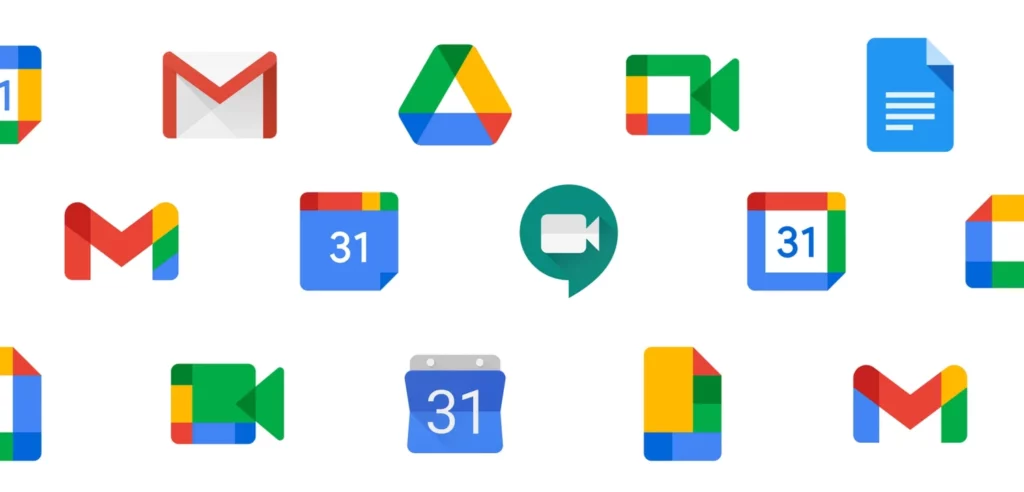
They cover a whole range of brand design considerations:
- A reductive (or “flat”) approach
- A preference for geometric shapes
- Icons always face front
- Straight, hard shadows as opposed to curved, soft ones
- Standard background colors
- Icons align to the pixel grid
- Icon padding according to shape
Because of Google’s close attention to their extended visual language, when you see a Google icon, you know it’s a Google icon.
Perusing other brand visual guides can help you get a better idea of what potential visual elements could work for your brand.
Maintaining a brand identity
Once you’ve got the perfect brand elements to work with, it’s time to secure your brand identity together with a comprehensive set of brand guidelines.
Brand guidelines offer an easily accessible playbook to educate your teams on how, when, where, and why to use each of your brand identity elements. With these guidelines, anyone from your company should be able to put your brand to work in a consistent way.
Once you have these guidelines in place, using customizable templates can help save your team valuable time. Instead of creating every piece of marketing collateral from scratch, leveraging custom templates makes it easy to quickly create on-brand materials, even if you’re not a graphic designer.
Key Takeaways
While there’s always the possibility of redesigns and re-evaluation ahead, starting off with a strong, confident brand design and unified brand identity will add clarity and consistency to everything you do. Over time, your unique brand identity will be the one that pops into people’s heads when they have a problem you can solve.
Ready to start building on brand? Sign up for free and explore our brand template library today.
Twitter began in 2006 as an online message board that was updated via text message. Since then, it’s grown into one of the largest social networks, boasting more than 300 million users who combine to produce 500 million tweets daily.
Related: How to drive traffic with social media
Marketers have been slow to catch on to Twitter, though. Recent reports estimate that only 65% of businesses use the platform for advertising, which gives you plenty of time to get ahead before the rest of the competition arrives and sets up shop.
In case you need more convincing, these 11 benefits of using Twitter for marketing can help you cross the divide.
1. Direct messaging creates genuine connections
Like its main competitors, Twitter has a direct messaging feature for private conversations between two users. However, the main difference is that the two accounts must mutually follow each other (unless one user has their inbox set to “open”) before they can contact one another.
This might seem like a hurdle for marketers who want to connect with influencers or other important industry players, but reserving direct messaging for mutuals ensures your conversations are worthwhile, engaging, personalized and authentic.
2. Tags encourage engagements
The @ symbol on Twitter goes a long way. It’s the key to sending other users a notification that almost guarantees your tweet, or the tweet you wanted the @ recipient to see, gets viewed. Also, it’s easy attribution for a quote or an article you share on the platform.
Twitter has branched into content discovery, so users now see occasional tweets from people they might not even follow. This is more likely if multiple users in a network like a tweet. The algorithm then guesses you might also want to see content similar to what’s already in your network. With this feature, your tweets with engagement can end up in front of new eyes, thus increasing reach and engagement.
3. Posting multiple times per day is expected, not annoying
According to data averaged from multiple studies, Twitter is the only social network where marketers are recommended to post up to 15 times per day. Unlike its main competitors, Facebook and Instagram, Twitter is still heavily chronological. Tweets have such a short lifespan in the ongoing feed of posts that regular updates are necessary to stay relevant.
Marketers should take this opportunity to integrate a varied mix of content that entertains and educates their Twitter following and keeps them engaged. The platform allows text, images, video, live video and polls that can all encourage conversation in different ways.
4. Twitter best showcases your brand voice
With a more robust posting schedule, Twitter is a network where a brand can develop its voice and public personality. Depending on the industry, tweets can have an authoritative voice or even a sassy tone.
Fast food companies have revolutionized branding with Twitter in an especially notable (and comedic) way, from the rap battle between Wendy’s and Wingstop to the clapbacks from Taco Bell. Even forgotten brands like MoonPie have been resurrected via Twitter; now MoonPie has a strong following of 279,000 that look forward to its self-deprecating humor on a daily basis.
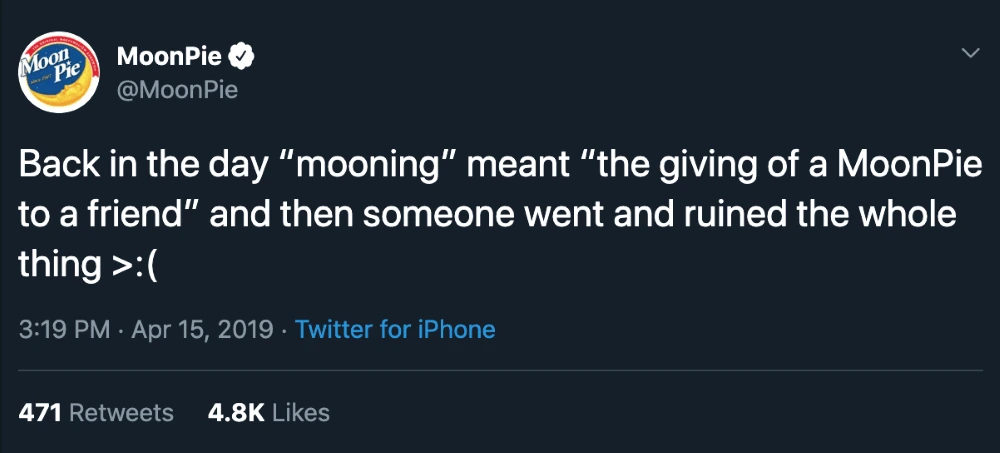
Source: Twitter
Your consistent brand voice is also archived for prospective customers who are using Twitter to research how you interact with your followers. Twitter’s open format leaves nothing to the imagination, and some have experienced the fallout when old, problematic tweets resurface at inopportune times.
5. TweetDeck lets your monitor Twitter for free
If you have a Twitter account, you also have access to TweetDeck. It’s a free tool that specializes in monitoring. Simply identify accounts, keywords or hashtags you want to follow, and watch as TweetDeck creates individual feeds for your selected parameters. This is an effective way to stay in the conversation, because you don’t have to use the main Twitter platform to search keywords one by one and possibly miss an important tweet.
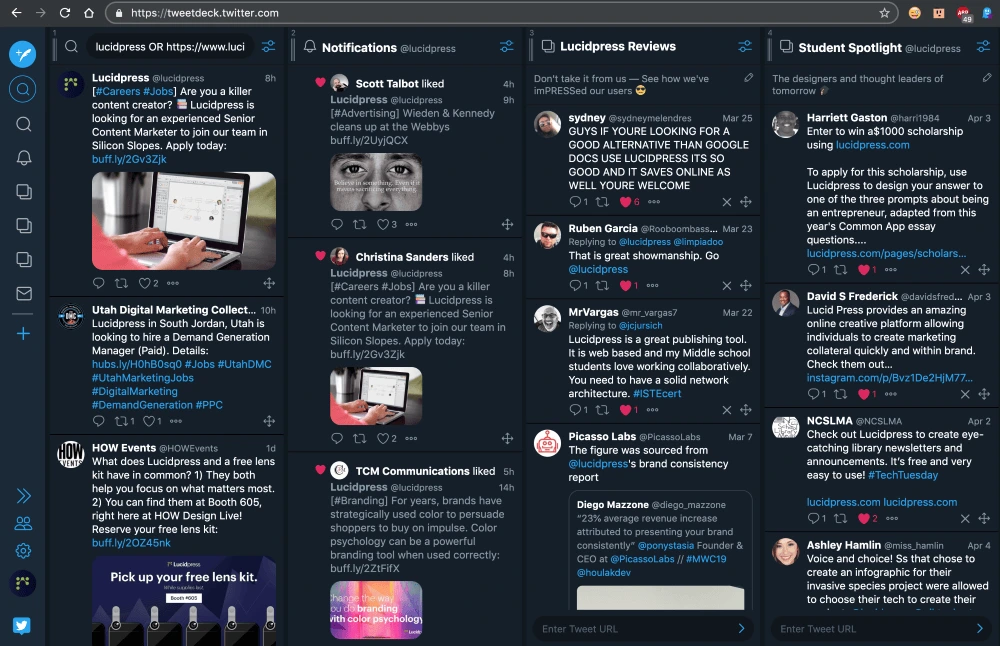
The Lucidpress TweetDeck
TweetDeck lets you watch your competitors’ activity and community all at once, which makes it an impactful tool for poaching customers. For example, if you see a user complain about a competing brand because you’re tracking their name as a keyword, you can reply and recommend your brand as a viable solution that addresses their pain points.
Keyword monitoring also keeps marketers in-tune with discussions about relevant industries, so future strategy can address industry topics. Rihanna’s company, Fenty Beauty, is popular for its vast array of makeup shades designed for all skin tones. By identifying a pain point—makeup is non-inclusive to people with darker skin tones—the company addressed it with real action and enjoys success because of it.
6. Influencers can boost your campaigns
In 2019, there’s no doubting the power of the influencer, a modern-day social media celebrity. Marketers have found that influencer campaigns yield an average return of around $7.65 for every $1 spent. However, Instagram is oversaturated with individuals pushing products, which makes influencer campaigns that much fresher on other social networking sites.
Twitter, in particular, has massive potential for marketers. That’s because there’s a 2x increase in purchase intent when consumers see tweets from both brands and influencers. Also, 49% of Twitter users responded that they rely on recommendations from influencers, and 40% have made a purchase solely based on a tweet from an influencer. The numbers don’t lie, and they show an opportunity marketers can’t find in many other places.
7. Your profile will drive traffic to your site
Social media profiles are the new homepage. [] As mentioned earlier, Twitter is the place to develop and showcase a brand voice, so users will often visit a brand’s Twitter profile to get a better feel for the brand. About half the time, that visit will inspire further research, namely due to the fact that 47% of the people who visit a Twitter profile also visit the website linked to that profile.
Marketers should keep in mind that brand voice should be consistent and seamless across channels, so a playful Twitter account shouldn’t lead to a landing page with overly serious language. Otherwise, consumers will end up confused and leave the page without converting.
8. Follower insights help you develop your follower persona
Twitter users are given native analytics within the platform, and they’re some of the best across social media sites. In particular, the Audiences tab helps marketers paint a picture of their average follower.
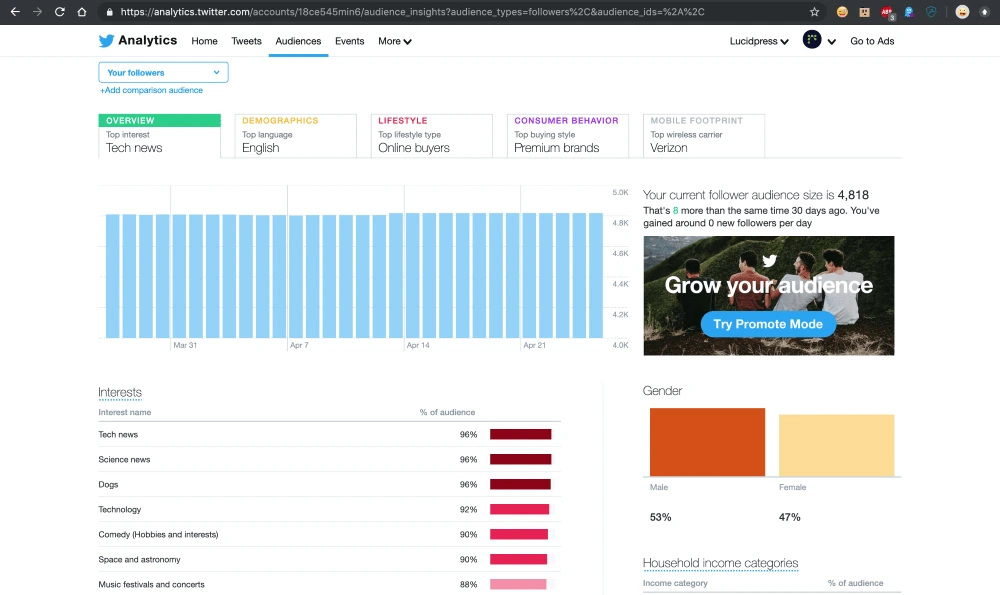
The Lucidpress Audiences tab
Audiences has four categories: Demographics, Lifestyle, Consumer Behavior and Mobile Footprint. The data delivers insight into your followers and their interests—as well as how they interact with brands, which is helpful to know before launching a campaign. With your follower persona in mind, you can aim directly for Twitter users who match the kind of people following you already.
9. Advertising spend is low & effective
Advertising on Twitter costs as little as one dollar per day, but its real strength is optimization. Twitter Ads guides marketers of all experience levels through the campaign creation process by suggesting parameters to maximize impact. Then, if the setting is selected, the platform will pace spending based on results to ensure marketers aren’t spending unnecessarily.
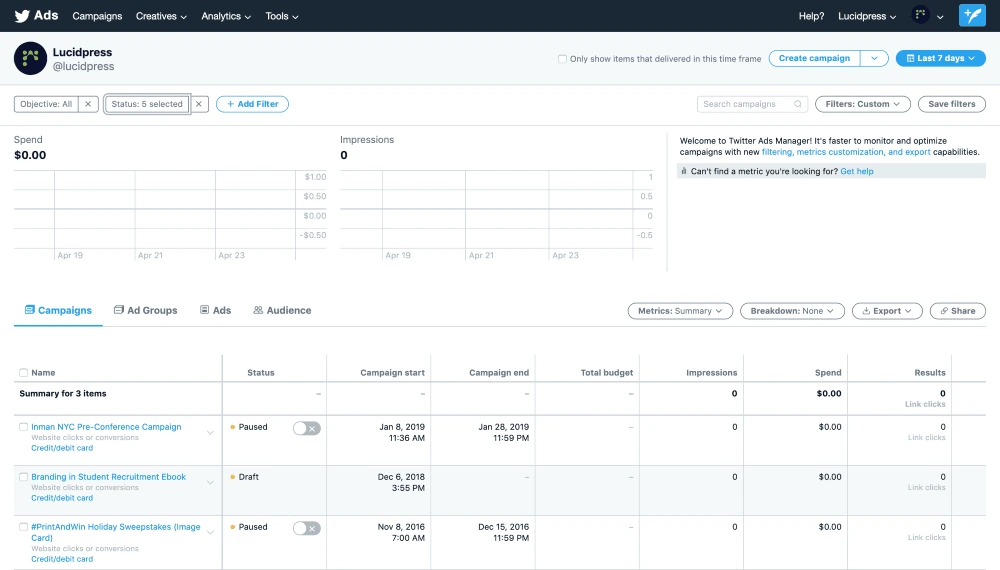
A heavily filtered version of Lucidpress Twitter ads (can’t give away all our secrets!)
As you gain experience, you can also experiment with A/B testing, using different campaign types or applying other settings. It’s customizable and incredibly user-friendly. The best part? Independent research shows that Twitter marketing campaigns can deliver 40% higher return on investment when compared to other media channels.
10. Community management is possible with branded hashtags
Hashtags are still the king of social media discovery tools, especially when marketers use branded hashtags. Created by brands to give consumers a way to share their experiences on social channels, branded hashtags comprise 70% of the total hashtag landscape.
Marketers can use these niche spaces to easily follow their brand communities online. Whether it’s to participate in a Twitter conversation or to find user-generated content for future tweets, there’s tremendous potential.
11. Anyone can go viral
One of the best parts of Twitter is its capability to spread a message like wildfire. Anyone who uses the platform regularly sees multiple tweets per day reach viral status because they’re funny, relatable or newsworthy. Those tweets can come from anyone, no matter how few followers they might have.
Brands can similarly go viral with a tweet, which immediately increases reach, traffic and conversions. All it takes is a well-timed post that resonates. The sky—or, should we say, the 280-character count—is the limit.
What are you waiting for?
Follow @lucidpress on Twitter today! Just kidding. …Mostly. Okay, here’s what we were actually going to say.
Twitter is a unique marketing channel with huge opportunities for brands looking for a new way to reach prospective customers. It’s not yet full of business accounts, and it has maintained the authenticity that’s lacking on other social media sites—which has resulted in a dedicated user base that’s tired of Instagram’s careful curation and Facebook’s fake news.
Marketers always need to have new tricks up their sleeve to adapt to the ever-changing landscape of digital advertising. They should not overlook Twitter if they want to make an impact. It’s perhaps one of the purest platforms left, and the possibilities are wide-open to incoming brands.
Ready to design your own branded Twitter content? Hop over to our free Twitter template gallery and get started!
Are you sitting at your desk waiting for that sweet, sweet logo inspiration to strike?
No matter whether you’re a consultant looking to brand your business or a designer looking for new ideas, this article will get you unstuck.
Related: 9 excellent logo redesigns for famous brands
Below, you’ll discover different types of consulting logo ideas from some of the biggest consulting brands in the world.
Whether you’re looking for designs with hidden meanings or something more traditional, the examples below are bound to stir up some creative juices.
Before diving into our pool of inspiration, though, let’s see what makes a good consulting logo and what mistakes you should avoid.
3 golden rules to create a modern consulting logo that stands out
Make sure your logo doesn’t misrepresent your business
The color, the weight of your fonts, the spacing between the letters—everything stirs an emotion.
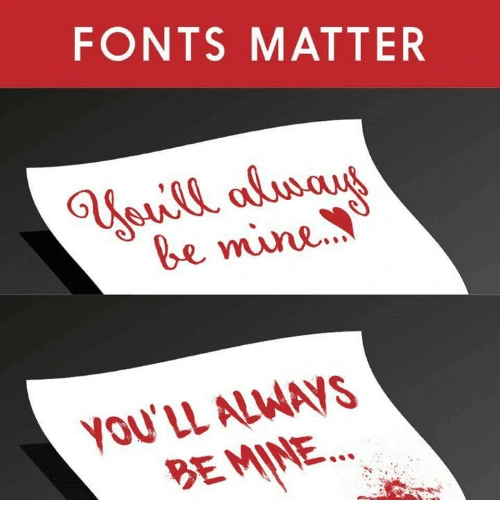
You have to make sure your logo conveys the right story, the right emotion and the right voice for your brand.
For instance, if you want to be perceived as an expert, you wouldn’t want an overly playful design.
Make sure your logo is clear and not too complicated
Yes, it’s true, your logo should tell a story. But, this doesn’t mean a person should figure it out in the blink of an eye.
Here’s what I mean. If you look carefully at Amazon’s logo, you’ll see an arrow pointing from A to Z. This is because they want to show people that they can find almost any product on their platform.
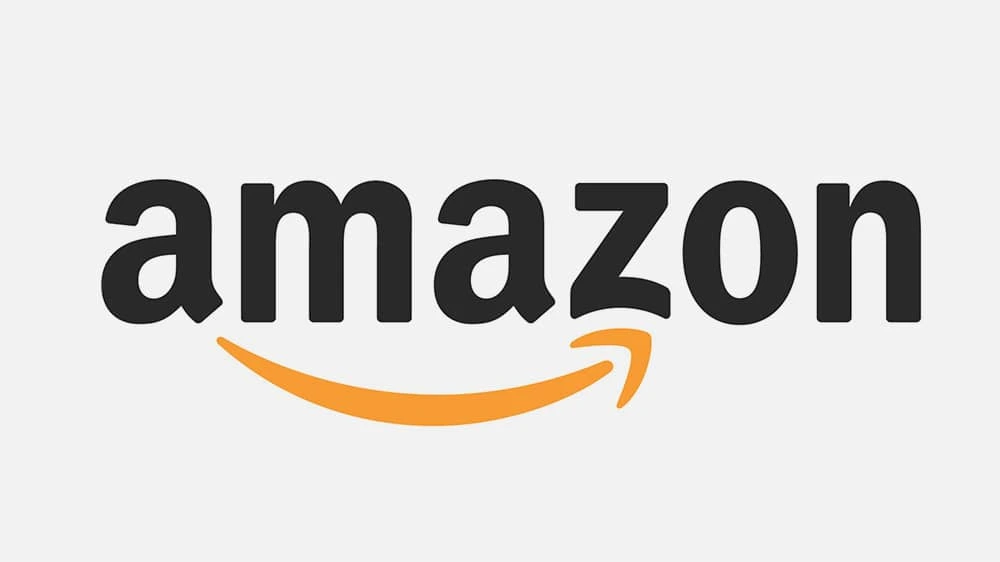
This story now makes sense because I’ve just told it to you. It only took a few seconds, and a logo which was already effective before now seems even more so. It goes to show that you don’t need to overcomplicate your logo to tell a story.
Make sure your logo doesn’t look old or outdated
What would be your first impression if you saw a consulting logo like this? (Yes, we know Hot Wheels is not particularly known for its consulting prowess, but please bear with us for the sake of example.)

A vintage font combined with a childish design… If this actually were a consulting company, you’d probably think they don’t care about how they look—and maybe they don’t care about their customers either, right? Not great.
Of course, this doesn’t mean you have to update your logo every year just to keep up with the trends. You just have to make sure you’re not hanging on to outdated design elements that were only trendy 20 years ago.
And with that, let’s move on to our round-up of consulting logo ideas.
Consulting logo idea #1: Accenture
Accenture is one of the biggest management consulting firms. The company offers strategy, consulting, digital, technology and operations services. Their revenue was around $40 billion in 2018, so we could definitely learn some design lessons from them.

The sign for “greater than” is placed above the letter t to represent the future—a future where you’ve ascended and grown to be greater (>) than (t) you (u) are (re).
As you can see, your next consulting logo can be clean & simple and still have a deeper message to communicate.
Consulting logo idea #2: Capgemini
Capgemini is another consulting giant that can teach us a valuable design lesson.

The key lesson here is that you can build a financial empire… even if your logo isn’t closely related to the services you’re selling.
The Ace of Spades has been present in their logo since its inception, but it has little to do with their business. In fact, it refers to bridge—a card game that the founder of the company, Serge Kampf, enjoys. In bridge, the Ace of Spades is the highest-value card.
It’s simple, it’s sweet, and it works. The lesson? You don’t necessarily need to hire an expensive designer to create a custom logo that’s meaningful to your brand. There are plenty of free logo makers out there that can help you get started.
Consulting logo idea #3: DLA Piper
If you’re offering legal consulting services, here’s what you can learn from one of the biggest global law firms. (How big? DLA Piper has lawyers in more than 40 countries and over $2 billion in revenue—that’s how big.)
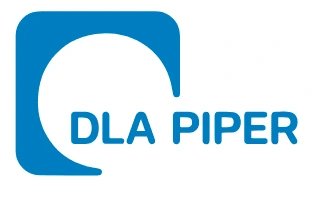
The open-ended shapes represent out-of-the-box thinking. Something you might actually want from a lawyer, right?
If you look at it from a different angle, the logo seems like a talking bubble, which shows they value the art of communication… or that they’re friendly. You decide.
Do you see how the story starts to make sense after you receive more information? And how quickly this story can change, depending on the interpretation?
The point is this: If you’re just starting out and you’re not a giant corporation, don’t fret too much on pinpointing the right story behind your logo. You can refresh the design and infuse more meaning as your brand grows and develops.
Consulting logo idea #4: Deloitte
Deloitte’s revenue was over $40 billion in 2018, and they use one of the most basic design elements in their logo: a dot.

What could we possibly learn from this? Actually, it makes a great point. (Ha!)
Timeless shapes (like the point) and simplicity will never go out of style. You don’t need an overwhelming design that distracts people from getting your message.
Plus, a simple logo will be much easier to integrate in almost any sales collateral or marketing material you develop later.
If you need further proof, just study the logos of some of the biggest brands out there: Nike, Apple, Adidas, Dell, Intel, etc. Enough said.
Consulting logo idea #5: McKinsey & Company
McKinsey & Company is undoubtedly one of the biggest consulting firms you can study and look to for inspiration.

And it can teach you two important lessons.
The first is that you don’t need a fancy or even a creative logo to express professionalism or extensive experience within a field.
In fact, quite the opposite is true. If you study successful companies, you’ll see that most of them refined their logos into simpler, cleaner versions as they matured.
The second lesson here is that even your choice of font can tell a story.
At its core, McKinsey & Company uses a classic custom font because experience, heritage and legacy are what represent them best.
Consulting logo idea #6: L.E.K. Consulting
Want to make your consulting logo stand out while still maintaining a professional, bold look?
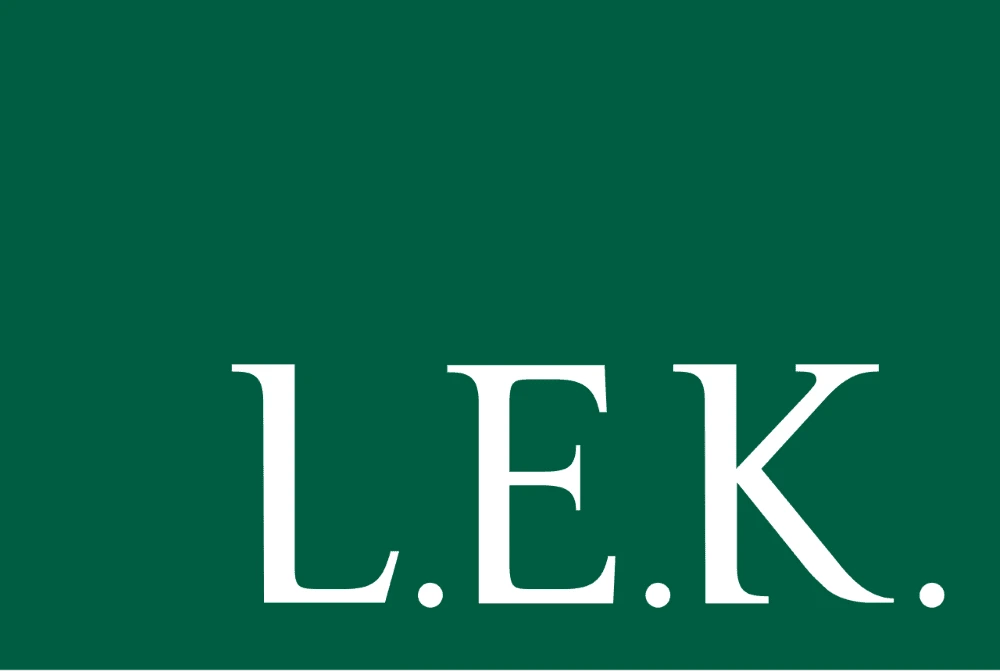
Here’s a key takeaway from L.E.K. Consulting, a global company established in 1983.
Their logo stands out because of some basic design elements and principles like composition, contrast and negative space.
For instance, they draw attention to their logo by using the contrast between the negative space in the top-left corner and the logo in the bottom-right corner.
They also give a bold look to the whole design by leveraging one of the most basic elements—the rectangle—all in combination with a deep-colored background.
Consulting logo idea #7: KPMG
If you’re afraid that your consulting logo won’t be perfect right away, don’t fret.
KPMG proves that no design should be set in stone, even if it’s a logo. You can always change it, and there’s no tragedy in doing that. It doesn’t mean you have to lose sales or credibility.
For instance, here’s how many iterations their logo’s had throughout the years:
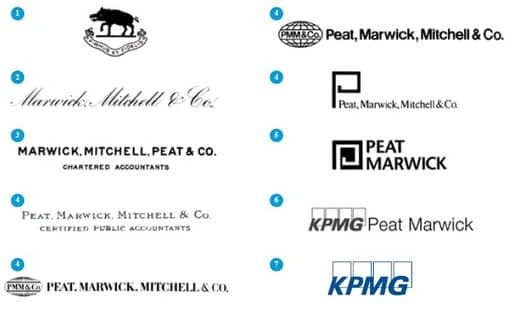
Source: KPMG
As you can see, these weren’t minor changes—in fact, many were radical redesigns. Even its name changed each time the company got a new partner or the shares were redistributed.
Still, the company is one of the largest professional services companies in the world with over $28 billion in revenue for 2018.
Consulting logo idea #8: FedEx
FedEx isn’t a consulting company, but if you want your consulting logo to be more creative and have a hidden meaning, it’s a good example to follow.
If you look carefully, there’s a hidden arrow that communicates speed and accuracy to those in-the-know.
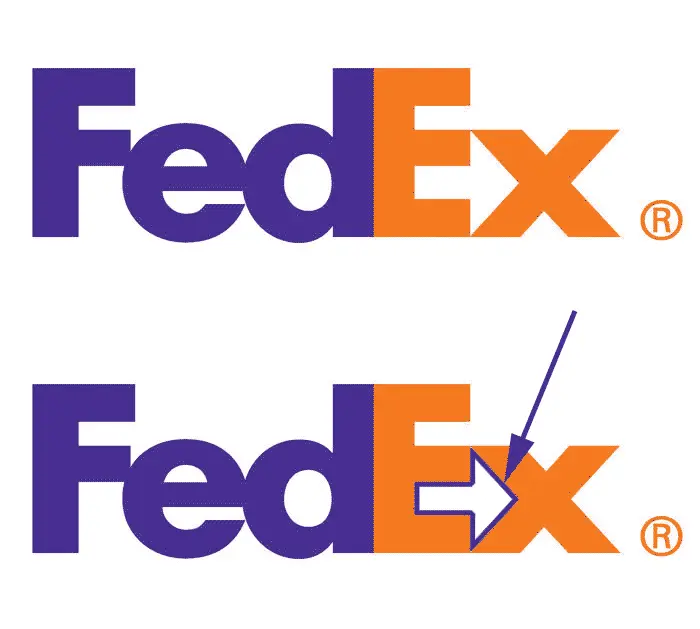
Of course, now the question is, how do you come up with such clever ideas?
It’s simple. It all starts with your unique value proposition, the core message you want to communicate.
Find out that one thing, that most important thing that makes people want to do business with you. Then, incorporate it in your design.
Consulting logo idea #9: Sony Vaio
Sometimes, the hidden meaning in a logo can come from the product itself.
Here’s a clever logo idea from Sony Vaio. Even though it’s not a consulting company, it’s worth mentioning because they managed to create such a simple logo with a hidden meaning behind it. Take a look:
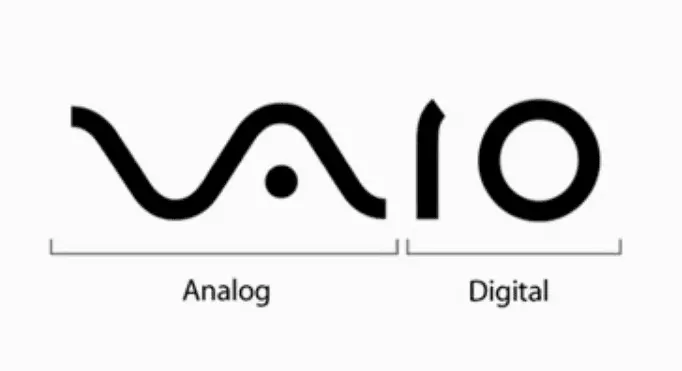
Consulting logo idea #10: Eighty20
If you’re looking for creative consulting logo ideas, Eighty20 is probably one of the best examples you can use for inspiration.
Eighty20 is a business consulting company that uses big data to inform its market research, then they use these insights to help marketers and companies better sell their services.
Their brand is a combination of geeky and creative, and they express that well in their logo. How? Each of the horizontal lines represents a binary sequence. The blue squares represent 1s, and the grey squares represent 0s.
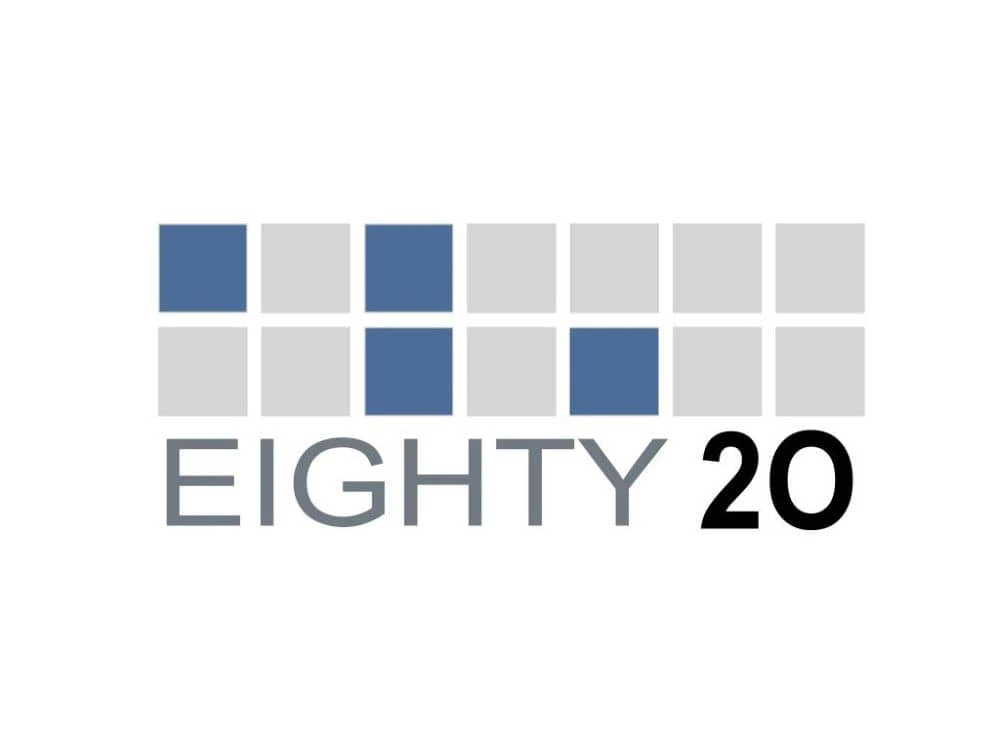
In binary sequence, the top row is 1010000, while the bottom one is 0010100. If you transform these numbers from binary to decimal, it reads… you guessed it: 80 and 20. Pretty clever, right?
Before designing your next consulting logo, do this
There are thousands of logo design ideas out there. The problem is, the more you see, the harder it is to choose one.
Here’s a method professional designers use to come up with great ideas quickly (and easily decide on the right one).
First, stop looking for ideas. Then, define the core message you want to communicate.
Are you fast and precise? Do you offer a complete range of services? Do you have the most innovative solutions or the most comprehensive research? Are you affordable for SMBs, or do you only serve large enterprises?
Only after you define your core message should you start looking for inspiration. Don’t worry—we’ll be right here when you come back.
Ready to start exploring your new brand identity? Try creating a few logo variations in Lucidpress, using your brand colors.
Not sure how your next fitness logo should look and want a few examples to get your imagination’s wheels in motion?
Maybe you want to see some design ideas from well-known brands in the fitness industry. Or, perhaps you’re looking for creative logo ideas that stand out from the crowd.
Related: Best logo design ideas for your inspiration
No matter whether you’re a fitness consultant, own a gym or have any other fitness business, by the end of this article, you’ll have plenty of ideas to get you started.
But, first, let’s see what makes a good fitness logo and what mistakes you should avoid.
3 fundamental rules to create a fitness logo people will remember
1. Make sure your logo doesn’t communicate the wrong message
Every aspect of your future fitness logo will evoke an emotion, from the colors to the fonts and shapes you choose.
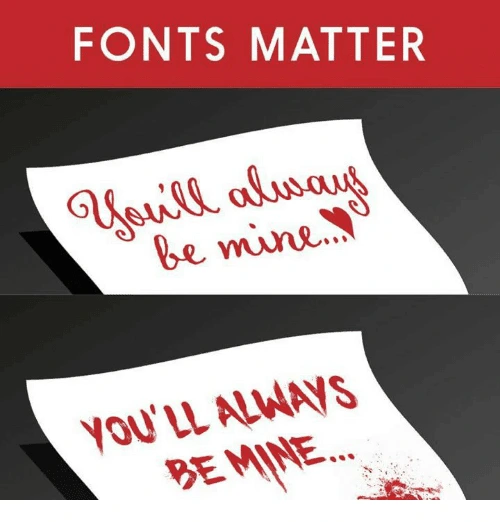
This is why you have to be careful about the first impression your visual identity makes.
For instance, a dark, sober color isn’t something you might want for a fitness logo if you’re also helping people keep a balanced, fresh and healthy diet.
2. Keep your logo simple and clean
Ideally, your logo should tell a story. Maybe the origins or the philosophy of your brand. Or, maybe just your unique selling proposition.
This doesn’t mean you have to overcrowd your logo with all kinds of elements in order for people to get your message. When you try to convey too much in a single logo, it comes overly complex and difficult to recognize and replicate.

3. Avoid using outdated design trends
Imagine someone hands you a business card with a logo that looks like this:

What’s your first impression? Other than nostalgia, probably not a good one, right?
Of course, you don’t have to update your logo every time a new design trend comes along. Just make sure your logo doesn’t look like it’s stuck in the ’90s.
These are three critical aspects you should take into account when creating a logo. Now, let’s dive into our pool of fitness logo ideas and see what you can learn from each one of them.
Fitness logo design ideas for your inspiration
When you have too many ideas, just stick to the basics, even if it’s cliché
Sometimes we spend too much time brainstorming and browsing through thousands of logo ideas just to find that “perfect one.”
And, too often, the result is a complicated design that few will remember.
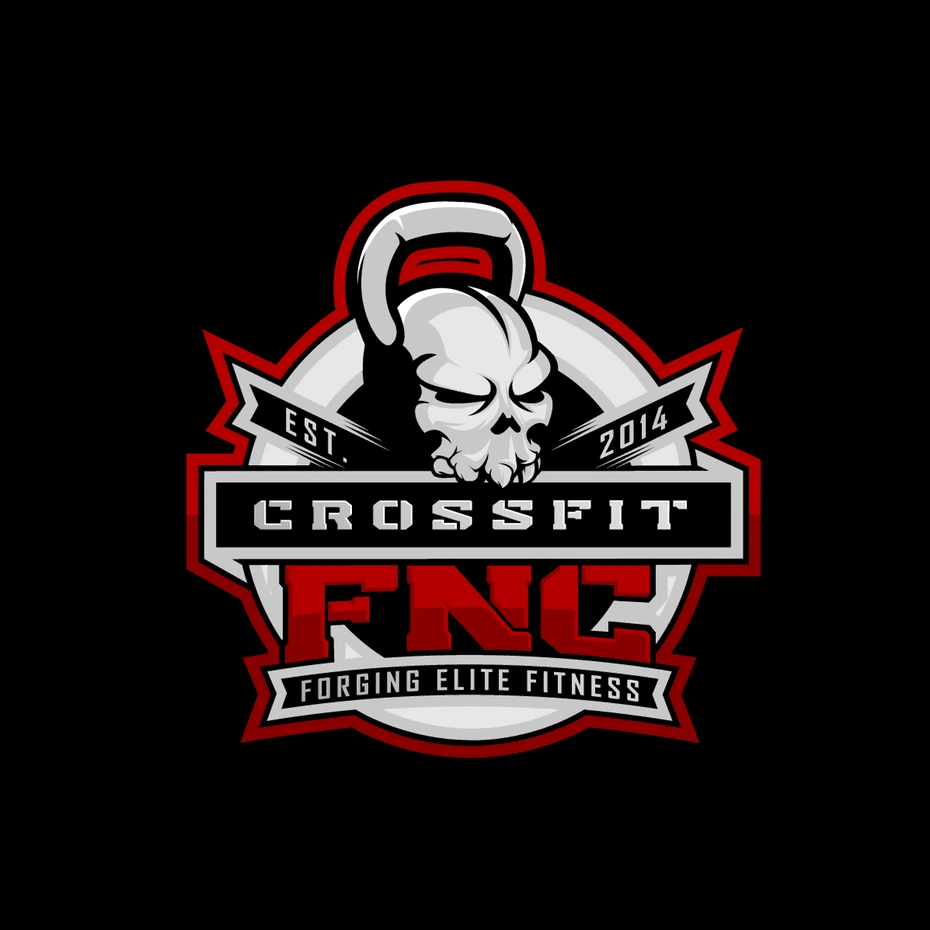
When this is the case, it’s better to stick to something classic that anyone can recognize as a fitness business.
Plus, you have the advantage that most free logo makers have these elements in their gallery so you won’t have to customize your design too much.
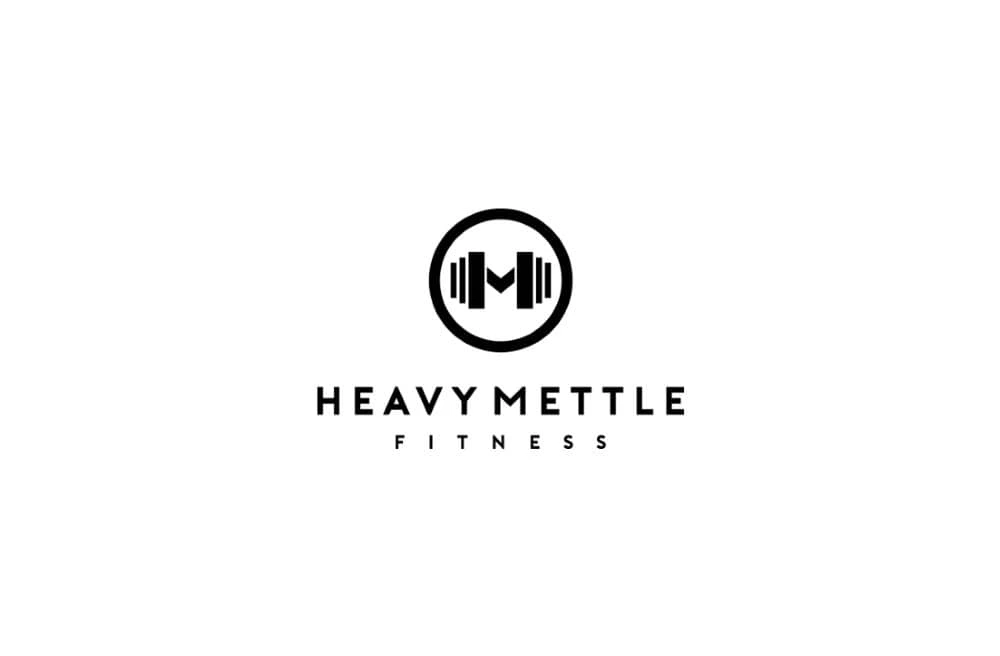
Source: GLDesigns
If you want to be compelling, point out something your audience wants
What’s that number-one thing your audience wants? Point it out, and people will remember you as that gym or that fitness instructor or that nutritionist who can help them get it.
Notice how, in a second, you know this fitness business can help you just by looking at their logo. Then, note how it brings us nicely to our next point…
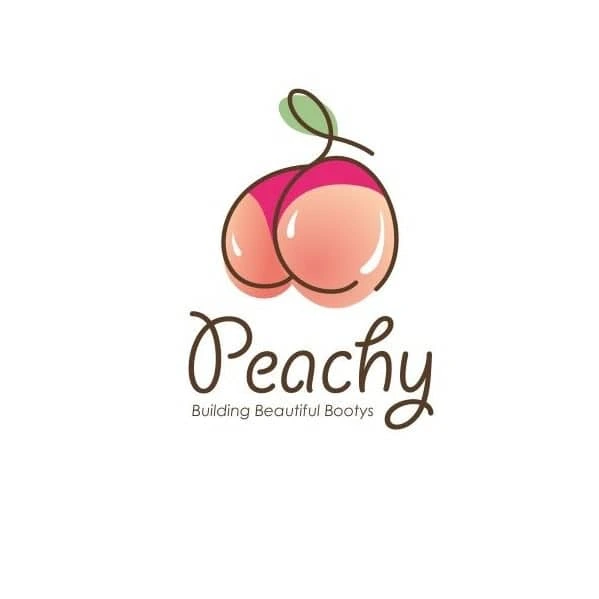
Source: 99designs
Make sure your fitness logo doesn’t drive away parts of your audience
Let’s say you’re a fitness trainer, and you chose the logo below to represent your business.
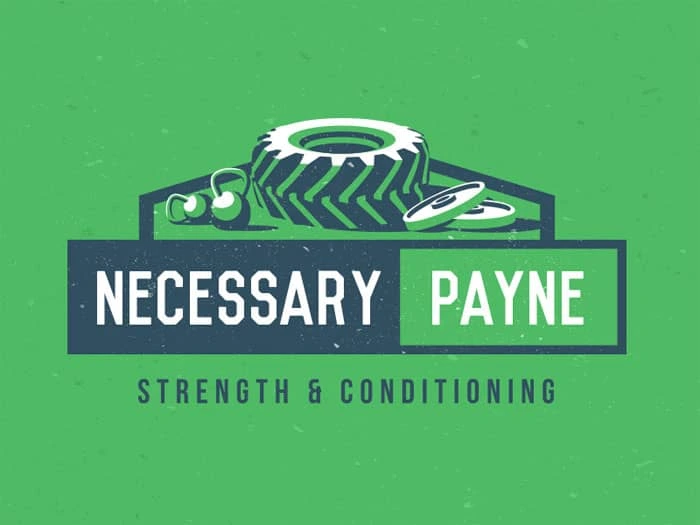
Source: Design your way
It’s great for people who are looking for hardcore training. But, there are lots of people who just want to stay in shape. Your logo might tell them that you’re not a good fit for them.
Of course, if your ideal audience is into hardcore training, this could be a great strategic move. What’s important is for you to think through these considerations before you make your final decision. For example, take a look at our next point.
Make sure your logo isn’t limiting future expansion of your fitness business
Let’s say that you start out as a yoga fitness trainer, but you plan to grow your business beyond the yoga niche.

Unless you go through a complete rebranding, your logo will limit the growth of your business.
When you’re looking for design inspiration for your logo, make sure you also take into account any future plans. If you can spot them now, ahead of time, you’ll save yourself an expensive and time-consuming rebrand in the future.
Use a well-known symbol
Sometimes keeping a logo simple and clean can be most effective at showing what your brand is about.

Source: Lucidpress
Incorporate a top benefit into a classic fitness logo design
In logo design, it’s efficient to incorporate an element that people can easily recognize, such as a gear or muscles if you’re in the fitness business.
But, these elements are also a bit overused, and you might want something more creative for your logo.
Well, why not incorporate additional benefits that your brand has to offer—such as good music, for example. Now people have two reasons to choose you over the competition instead of one.
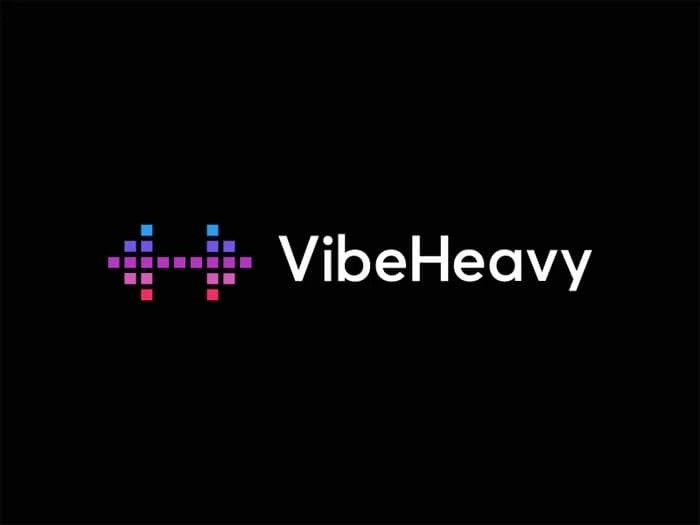
Source: Design your way
Your fitness logo doesn’t necessarily have to be related to fitness
Apple’s logo has nothing to do with phones. Nike’s logo doesn’t represent shoes, clothes or sports gear. Subway doesn’t have a sandwich in their logo.
Your fitness logo doesn’t have to be related to muscles, fit bodies or any kind of elements related to sports. It could be something as simple as two shapes that convey motion.

Source: Design your way
Use a color combination that stands out
Even if you don’t have a super creative logo layered with hidden meaning, you can still stand out from the crowd by using a powerful color combination.
Take Google, for example, or FedEx. Or, this fitness logo below.
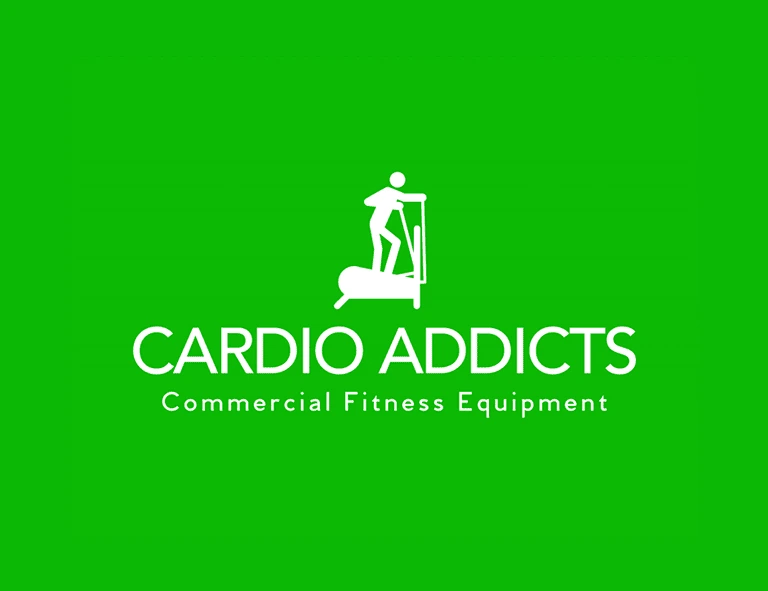
Source: Logojoy
Think about all the different ways you’ll use your logo
A highly detailed concept might look great on a large banner.
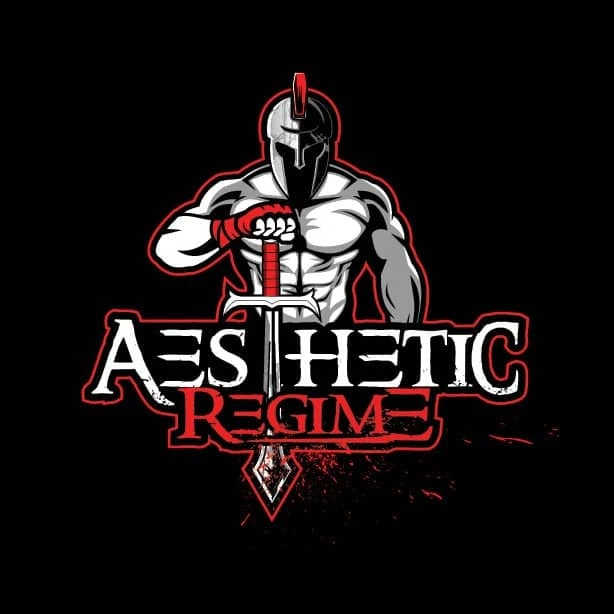
Source: 99designs
But, how would this logo look on a small business card? Would it be as effective?
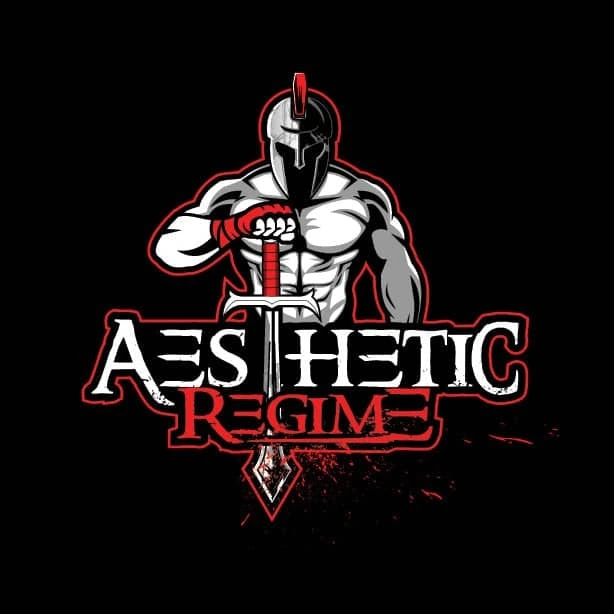
Suddenly, all those details become so small that people can’t recognize them.
Before you finalize your logo design, make sure you test it in all the different scenarios you know you’re going to use it.
Try to include a special meaning behind your logo
Let’s review a classic example for this one. FedEx uses negative space to hide an arrow that subliminally conveys speed and accuracy.
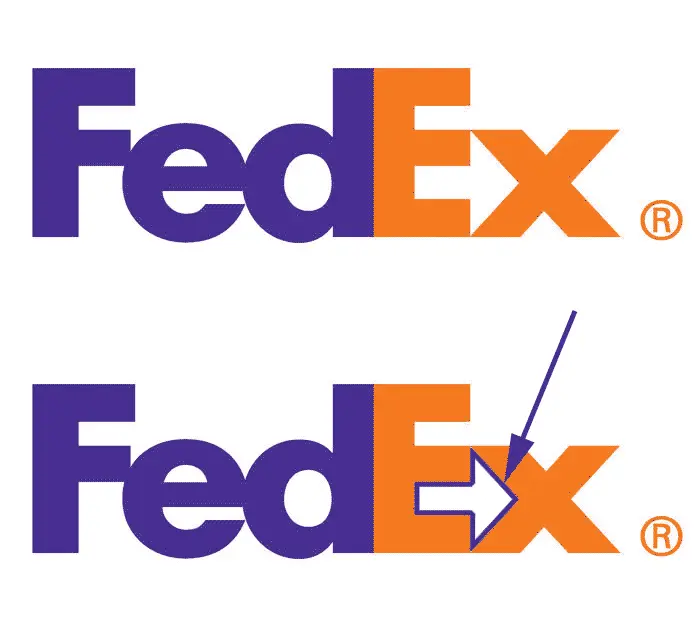
Source: Pixellogo
You, too, can use different elements in a clever way to give your logo a double meaning. For instance, here’s a clever way to incorporate the infinity symbol as a yoga fitness instructor.
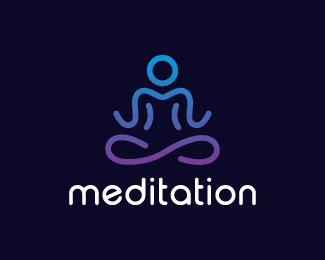
Source: BrandCrowd
Incorporate a sense of motion
As a species, we seem wired to detect motion, thanks to our neural underpinnings.
And since motion is a key aspect of your business, why not include it in your fitness logo? A dynamic design attracts attention and motivates people to get more active.

Source: Design your way
Before you create your next fitness logo, do this
If you want your next logo to be something creative or to have a special meaning, you first have to understand your brand’s identity. What is the most important message you want your business to communicate?
Only after you answer this crucial question can you start looking for ideas for your next fitness logo. Otherwise, you might find some good inspiration, but it won’t represent your business. So, take your time and do your research—then try out a few ideas.
Ready to start exploring your new brand identity? Try creating a few logo variations in Lucidpress, using your brand colors.
Starting a real estate business is an exciting step in any real estate agent’s career. However rewarding running your own real estate business may be, though, it’s not without its difficulties. Starting your new small business on the right foot will offer you a solid foundation to build upon and put you ahead of the game.
Related: Guide to an effective real estate listing marketing strategy
In this article, we’ll provide vital tips on how to expertly start your real estate business and set yourself up for success.
1. Complete requirements to become an agent
If you’re not already an active real estate agent, you will have to meet some requirements to become one. Start by following the qualifications to obtain a real estate license in your state. Your local real estate bureau will be able to provide you the information you will need. Also bear in mind, you may be required to work for a brokerage the first few years after obtaining your license. If you want to use the term REALTOR®, you will also need to join the National Association of Realtors. Members of NAR enjoy many benefits including access to their MLS and content and trainings relevant to the real estate industry.
2. Lay out your personal goals
Your new venture offers the perfect opportunity to reevaluate what you want from your real estate career. Perhaps you’re starting this new real estate company so that you can set your own hours or take time off at your discretion. Maybe you’re aiming to retire by 60 or pay for a family vacation each year. Defining your desires will help you stay focused and motivated as you work to expand your real estate business.

Source: Pikwizard
3. Determine your business objectives & values
Now is the time to set your business aspirations and define the ethos of your brand. Creating a business plan will double your chances of success. What are your financial goals, and what steps will you take to accomplish them? What are your values? What sets you apart from your competitors? Document these important cornerstones of your real estate business and use them to guide you in your future decision-making. Once you have these core decisions made, start creating visual identity for your real estate business. Create a logo, select brand colors and choose a font.

Source: Pikwizard
4. Find the right team
Starting a real estate business is rarely, if ever, a completely independent task. Even if you’re a solo operator, you may choose to enlist a marketer to increase your exposure, or a financial advisor to ensure your hard-earned money is invested wisely. Maybe you’re going into business with other real estate agents or have decided to hire an assistant for extra help around the office. Whatever your circumstances, ensure that the people you surround yourself with share your vision and will work hard to see it through. Visit this blog post for a more in-depth look at real estate recruiting.

Source: Pikwizard
5. Implement a comprehensive marketing strategy
A solid marketing strategy will spread the word about your new business and capture the attention of prospective clients. Keep your branding consistent across all marketing channels, and use messaging to communicate your brand values.
Consider using marketing automation software to bolster your efforts. After all, “67% of marketing leaders currently use a marketing automation platform” and “80% of marketers using automation software generate more leads.”

Source: Pikwizard
A thorough guide to marketing your real estate business can be found here, but here are some essential components to keep in mind.
- Create a website. In today’s digital age, it’s absolutely essential that your real estate business have a strong online presence—and this begins with a website. Your website will be used to introduce yourself and your business, post current listings, share client testimonials, provide contact details, direct visitors to your social media profiles and host your blog. It’s important that your website is professional and user-friendly, so work with a web designer if necessary.
- Social media. Social media is one of the greatest tools an agent has in their arsenal. Using outlets such as Facebook, Instagram, Twitter and LinkedIn will give you a direct link to prospective clients and the greater real estate community. Be sure to post engaging content regularly and keep your posts true to your brand. While it may be tempting to post a stream of real estate listings, provide other informational content as well such as information about the company you work in or advice for purchasing real estate for the first time. This post offers an in-depth guide of social media in real estate.
- Blogging. Having a blog is a great way to attract more visitors to your website and establish yourself as a thought leader in the field. Your blog posts will also give you interesting content to share across social media. The topics you choose to blog about should be relevant to potential real estate buyers and specific to your location when possible. Blogging frequently and using SEO-friendly titles & keywords will increase your exposure and result in more leads. In fact, a recent study showed that “companies that published 16+ blog posts per month got about 4.5 times more leads than companies that published zero to four monthly posts.” Learn more about content marketing in real estate.
- Paid advertising. Consider investing in paid advertising in order to target your prospects wisely. Google and Facebook ads are especially effective and there are options to suit every budget. On average, businesses make $2 in revenue for every $1 they spend on Google Ads.
- Email marketing. Now is the time to start building an email database and sending regular updates to your list. It’s been proven that “77% of people prefer to get permission-based promotional messages via email (versus direct mail, text, phone or social media),” making email one of your most valuable marketing tools. Learn more about real estate email marketing and grab a free template.
- Build your offline collateral. While online collateral is essential, so are your offline offerings. This includes things like business cards, stationery, brochures, flyers and signs. These are especially important for realtors, because they will be seen repeatedly by clients and prospective clients. As always, your branding should remain consistent across every outlet. It’s critical that you maintain a professional image at all times, and a brand templating platform can help you accomplish this.
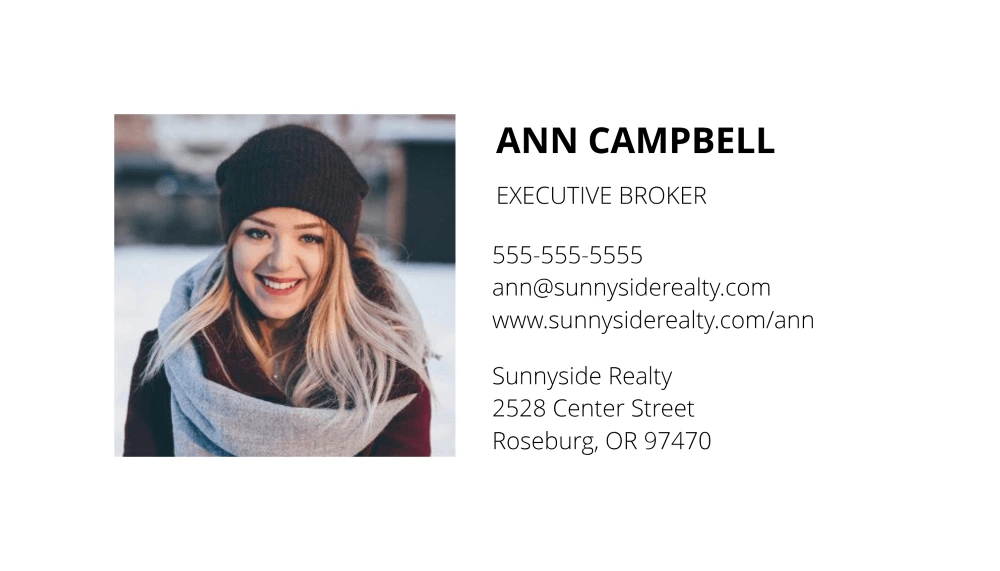
Source: Lucidpress
6. Host a launch event
Hosting a launch event for your new real estate business is an excellent way to introduce yourself to the community. According to Bizzabo, “Most (41%) marketers believe that events are the single-most effective marketing channel over digital advertising, email marketing and content marketing.”
A well-crafted event will create buzz around your real estate brand, allow you to reach a wider audience, and start your business off with a bang. Be sure to publicize your event across social media and ask your friends & family to help spread the word. Invite relevant business owners, influencers and news outlets.
An event also provides the perfect opportunity to meet and get to know your prospects. Real estate is a personal business, and connecting with potential leads face-to-face will set you apart from the competition.
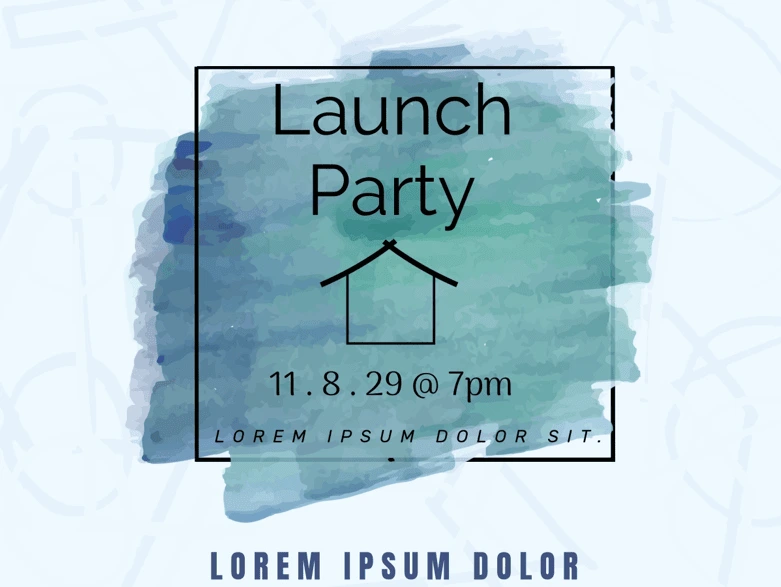
Source: Design Wizard
These tips will help launch your real estate business successfully and allow your new venture to flourish. Start your business on the right foot by following our advice, and turn to Lucidpress for all your custom marketing materials. We wish you the best of luck on your new & exciting journey.
Your brand matters. Learn how to protect and elevate your real estate brand in this branding essentials guidebook.
You likely already know that a logo is an important part of any business’s branding. Not only does it make your modern real estate company stand out from the competition, but a solid logo can attract and win over new customers. That’s what we’re always aiming for, right?
Related: Real estate branding—a comprehensive guide
But, it’s tricky to design a custom logo for your real estate firm. You’ll need to think about the colors, fonts and shapes you’re using—not to mention arranging each individual element to create an impressive design.
So, we collected eight of the best real estate logos to help inspire your own.
What makes a good real estate logo?
The logo you’re creating for your real estate agency is one of the first things you’ll need to nail. But before we share some of our favorite modern real estate logos, let’s chat about what makes a logo so great.
A strong logo usually is:
- bold
- unique
- easy to understand
Yet above all, the logo you’re creating for your real estate company needs to be on-brand. There’s no use in having a bright and colorful logo if your website, social media channels and letterheads are black and white.
Your audience won’t understand it, and you won’t see the 23% average revenue increase that businesses with consistent branding experience.
(Remember, that’s the aim of a logo: to make your business stand out.)
8 awesome real estate logos to inspire your own
You don’t have to start from scratch when you’re creating your own real estate logo. Take a look at these examples, pick out the ideas or concepts you like, and find a way to work them into your custom logo.
However, we’re coming at you with a word of warning: Please don’t directly copy these logo examples. The best logos are unique, innovative and stand out from the crowd, so take these ideas and try to put your own spin on them.
1. Smith Mountain Homes
First up is this beautiful logo from Smith Mountain Homes.
You can quickly understand the type of homes they sell, right? And it’s not just because the word “mountain” features in the brand name; they’ve used graphics to signal the type of property they sell.
Granted, the design and font choices are simple—but that’s often the best way to create a memorable logo.

2. Cabo Cribs
If you’re looking to buy property in Cabo, I’ll bet Cabo Cribs’ logo catches your attention.
Similar to the real estate logo above, this design is simplistic, but it doesn’t scrimp on the essentials of a good logo. It’s easy to understand, elegant, and has a small graphic that makes it obvious they’re selling homes.
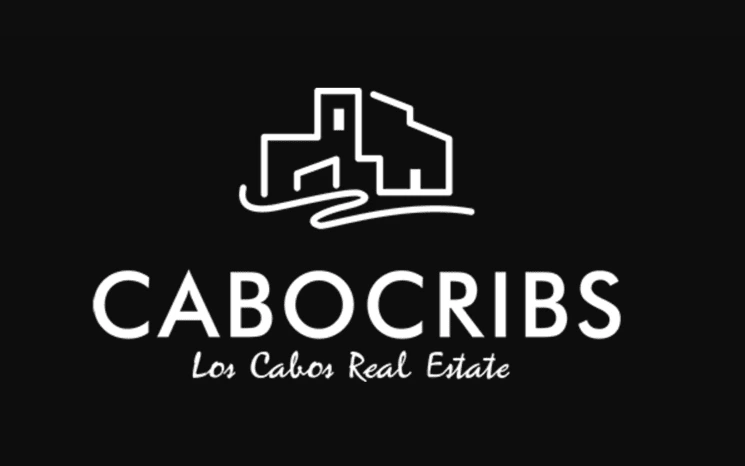
3. Williams & Williams
If you’re in the market for a luxury property, you’ll love Williams & Williams’ logo.
Take one glance at this logo and tell me what you interpret. It’s gold-themed, has elegant writing, and shows palm trees with the properties they’re managing. It ticks one huge element of a great logo: It’s perfectly on-brand for their commercial real estate company.

4. Compass
Who said a logo had to contain words?
Think of the world’s most recognizable logos. McDonald’s, Nike or Adidas will likely make their way onto that list—and none of them have a brand name in their logo.
Real estate firm Compass looks like they’ve drawn inspiration from those huge brands with their word-free logo. Although you can’t clearly see they’re selling properties, it’s a great way to make their audience stop and pay attention. After all, what are realtors for if not providing their clients with valuable guidance and direction?

5. Blue Key Property Management
I’ve included this logo concept for Blue Key Property Management here purely because it’s so simple, yet so effective.
You might’ve seen by now that many real estate logos contain property-related graphics. But instead of taking the standard route of a house, this firm opted to use keys—a factor that helps them stand out from the competition.
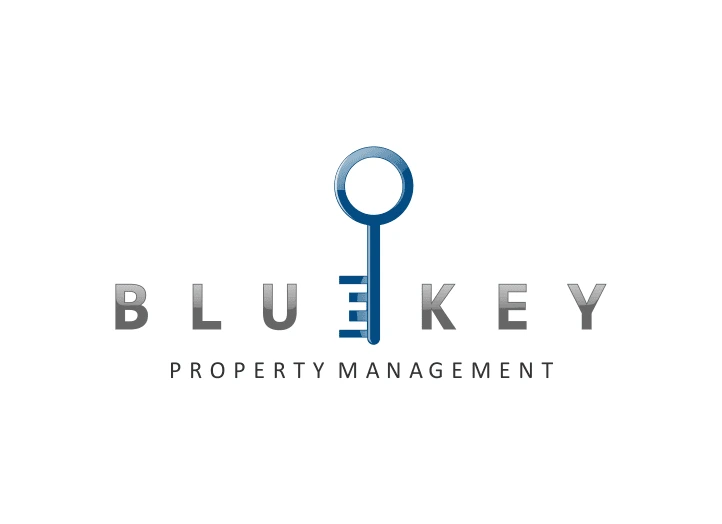
6. Delicious Real Estate
A simple—yet effective—way to build your real estate logo is to think about your buyer personas and their pain points. What are they looking for when they’re purchasing or renting a home from your firm?
It seems like Delicious Real Estate think it’s a reasonably-sized home. That’s why they’ve portrayed the situation their customers are usually stuck in through their logo.

7. Crown Real Estate
Remember how we mentioned real estate logos should be simple and easy to understand? Take a look at Crown Real Estate’s logo, which does exactly that while using simplistic fonts, a black-and-white color scheme, and a basic crown icon to match their brand name.

8. Live Dubai
The final logo on our list comes from Live Dubai.
Much like the other real estate logos we’ve listed, this one is simple. But, what we really love about this design is the way lettering is used to create an interesting logo that’s totally unique to their brand name.
This gives them two options: use the graphic & text together as their logo or crop the image just to use the lettered graphic.
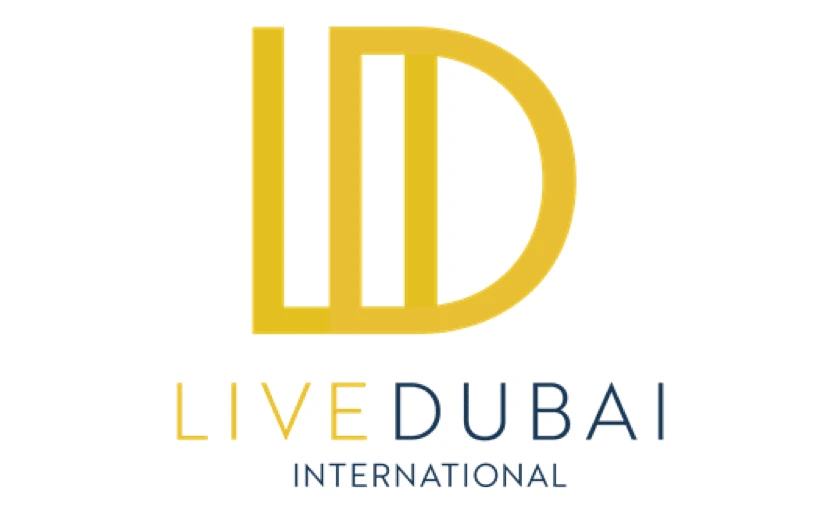
How to create your own real estate logo
Feeling inspired and ready to start designing a new logo for your real estate company?
You don’t have to hire an expensive graphic designer to create a custom logo design. There are thousands of templates you can customize, making a DIY logo the best way to create a professional brand for your real estate business—even if you’re on a tight budget.
However, if you do have some cash to splash on a fancy real estate agency logo, hiring a graphic designer is a great way to make sure your logo is unique. …Just make sure they’re sticking with your brand guidelines.
Key takeaways
As you can see, there are tons of incredible real estate logos that can inspire your own.
Remember, the most effective logos are unique, bold and easy to understand. And while each real estate logo design we’ve listed here ticks those boxes, you’ll need to add your own spin to each design when you’re creating your own.
Ready to start exploring your new brand identity? Try creating a few logo variations in Lucidpress, using your brand colors.
Color is a big part of our world.
The colors we surround ourselves with can impact our mood, change our energy levels, invoke memories, and even influence our decisions. As you can imagine, color is a powerful player in people’s perceptions of your brand as well.
A blog post on Elle & Co. says 60% of people decide whether they’re attracted to a message based on the color alone — and color reinforces brand recognition by up to 80%.
Point is, color makes a big impact on customers.
This is why Google has reportedly tested 41 different shades of blue in its logo to see which blue performed best. The winning color, according to dozens of charts and graphs, was not too green and not too red.
“It’s interesting to see how you can change the way that people respond to the Web in ways that are not intuitive,” Google executive Marissa Meyer explained.
Color branding is about your customers
Many brands have a signature color (or colors) that makes them easily recognizable.
In many cases, it would be odd to see their logo in a different color. Can you imagine McDonald’s golden arches in a bright purple instead? What if Starbucks’ logo wasn’t green & white, Pepsi’s logo wasn’t blue & red, and Target’s wasn’t red all around?
When we see that bubblegum-pink writing, we know it’s Barbie — and when we see the tiny blue f, we know it’s Facebook.
But, it’s not just the logo. As an article on SpellBrand suggests, there are many ways to incorporate color into your branding:
- advertising
- business cards
- employee uniforms
- interior design at retail locations (and in the office)
- letterhead
- marketing materials
- product packaging
- signage
- social media graphics
- website
According to Aprimo, marketing activities should focus on customers to create positive experiences each time they interact with your brand. Color will be part of those interactions, so deciding which color to use often comes down to who your customers are.
Emma Foley, design lead at Clique Studios, says, “As much as you might want them to, everyone is not going to be your audience. So, if you focus in and build a strong community of people you want to talk to, you can do a lot with using color as the first interaction with those people.”
For example, color has the power to make your website stand out among similar websites.
“One of your website visitors might think, ‘They are using this hot pink in a world of traditional blue and that’s really interesting. I want to learn more about this company’,” Emma explains.
She says there are really two schools of thought about how companies should manage color: 1) this is our brand color so we have to use it or 2) play around with colors because the rest of the brand is strong.
Before deciding which color makes sense for your brand, it’s important to take a step back and think about what colors mean.
What is color psychology?
Simply put, color psychology is the study of colors and their impact on human behavior. Sometimes color can influence unexpected things like our sense of taste. According to Neil Patel, “Color is 85% of the reason you purchased a specific product.” Sounds like good enough reason to implement a couple color psychology tricks into your own branding efforts.
However, keep in mind that our feelings about certain colors are personal and depend on both life experience and culture. For example, while the color white is used in the Western world to represent purity & innocence, in Eastern countries white is a symbol of death & mourning.
Types of colors and their impact on human behavior
The color wheel features two types of colors: warm tones & cool tones. Warm colors include red, orange & yellow and are associated with energy, passion & creativity. These tones are great for adding life to your designs. Cold colors include green, purple & blue and have a calming, soothing effect on people. (This is why you never see flashy colors in hospitals and waiting rooms.)
There’s another type of color which isn’t represented on the traditional color wheel: neutral tones. Neutral tones include white, grey & brown. In design, these colors are mostly used for backgrounds. To make those colors stand out more, you can add texture to your artwork.
Color psychology in branding
The concept of branding is based on the belief that colors (and other design choices) can evoke specific reactions & feelings. Despite the ubiquitous use of color in marketing, there’s not enough research to back up every assumption. However, over the years, marketers & designers have identified patterns that appear to influence customers’ purchase decisions.
If chosen correctly, your color palette can influence how customers feel about your brand.
Red

Source: Unsplash
The color red is associated with intensity, emotion, and a sense of urgency. It can invoke feelings of active energy, passion, trust, love, intensity, aggression, excitement and appetite.
McDonald’s uses red to provoke the appetite and a feeling of urgency. (Good move for a fast-food chain.)
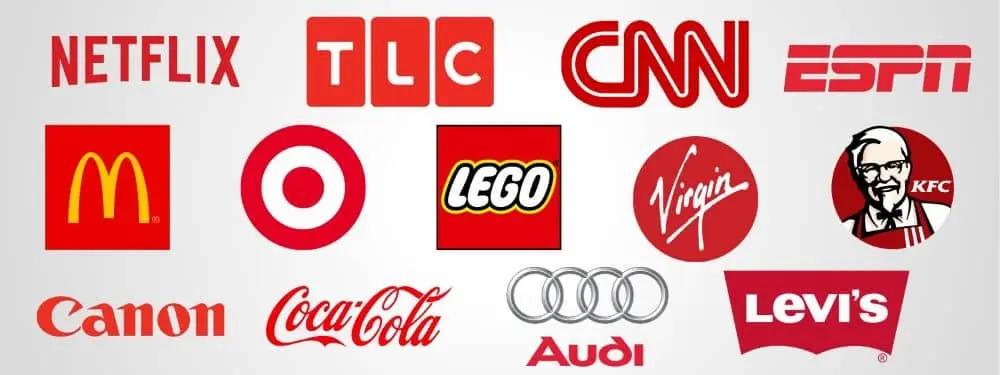
Made in Lucidpress
Brands that use red: McDonald’s, Audi, Coca-Cola, CNN, Lego, Canon, KFC, TLC, ESPN, Target, Levi’s, Virgin and Netflix.
Blue

Source: Unsplash
While there are many shades of blue that mean different things, blue is generally associated with depth and stability. It’s associated with conservative judgment, confidence, truth, order and understanding.
Invoking feelings of peacefulness & reliability, blue is the favorite color of tech & finance companies. For example, look at Facebook and Twitter. Those two companies use different shades of blue to portray trustworthiness & authority.
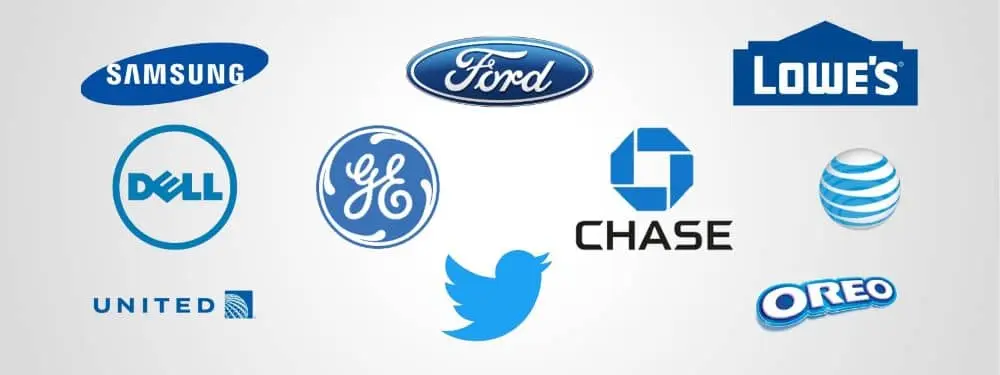
Made in Lucidpress
Brands that use blue: United Airlines, Chase Bank, Dell, Ford, General Electric, Twitter, Oreo, Lowe’s, AT&T and Samsung.
Yellow

Source: Unsplash
Yellow is a bright & vivid color associated with positive energy, sunshine and freshness. It can make people feel alive, energetic, cheerful and optimistic. In branding, yellow tends to grab attention as a very bright color that stands out. Snapchat uses yellow to appeal to younger generations and make their experience light & fun.
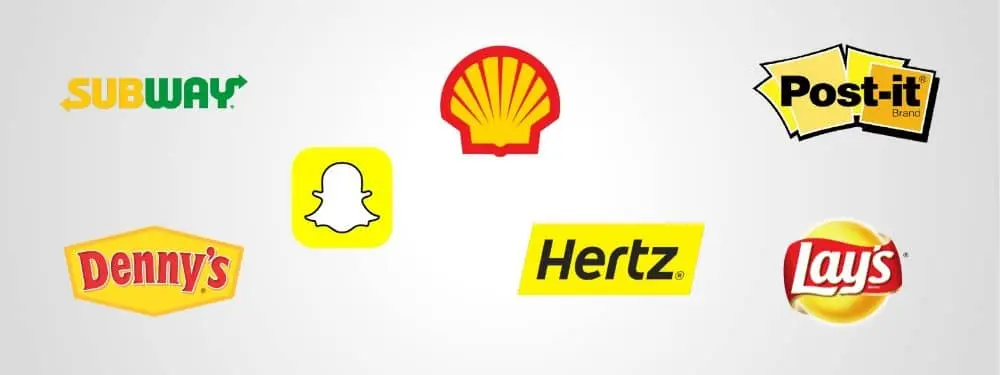
Made in Lucidpress
Brands that use yellow: Subway, Shell, Post-it, Lay’s, Denny’s, Hertz and Snapchat.
Beige & ivory

Source: Unsplash
While it’s not used too often, beige and ivory can invoke a feeling of simplicity, calm and pleasant stability.
Tilemark is a great example of a brand that uses beige & ivory.
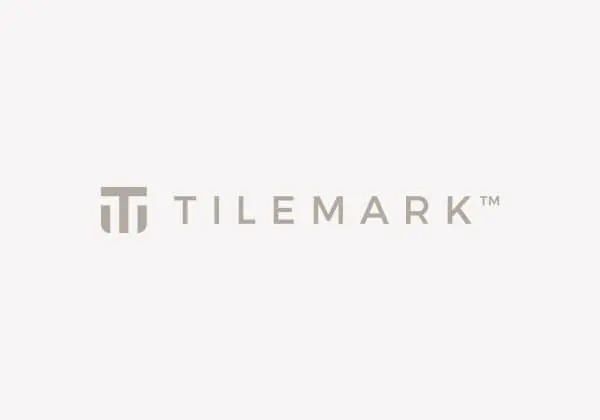
Source: Tilemark
Gray

Source: Unsplash
Gray is associated with security, reliability, dignity, practicality, conservative judgment, calm and intelligence.
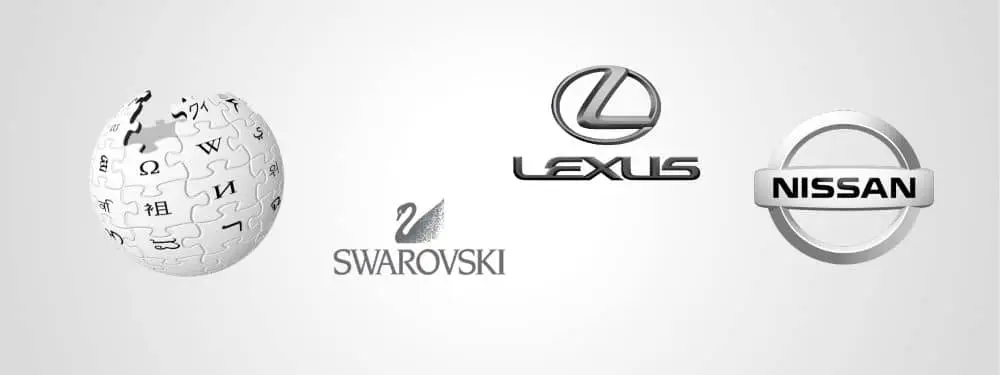
Made in Lucidpress
Brands that use gray: Wikipedia, Swarovski, Lexus and Nissan.
Green

Source: Unsplash
The color green is associated with the harmony of nature, the environment and renewal. When looking at green, people often feel calm, relaxed, trusting, peaceful, hopeful and healthy.
Green is all about nature and is used by bio-friendly, organic and sustainable brands. If you want to portray your services as environmentally safe, green is your color of choice.
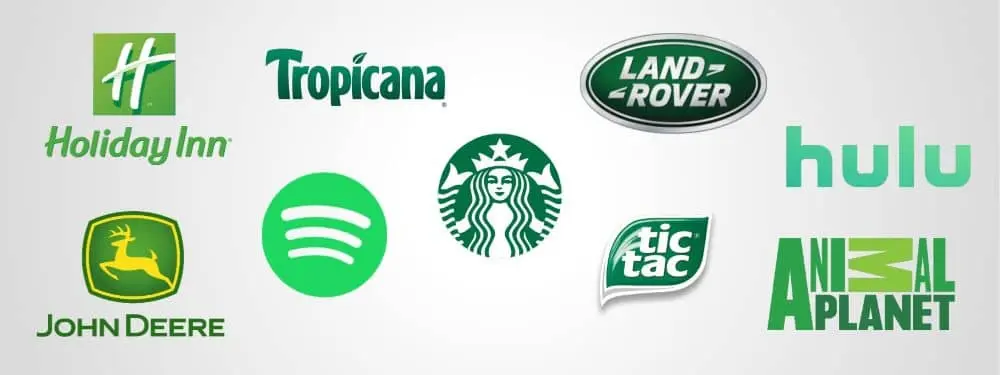
Made in Lucidpress
Brands that use green: Holiday Inn, Starbucks, Animal Planet, Spotify, Land Rover, John Deere, Tropicana, Tic Tac and Hulu.
Purple

Source: Unsplash
Purple is symbolic of luxury, royalty, glamour, power, nostalgia, romance, introspection, nobility, spirituality and wisdom. It also stimulates creativity and problem-solving.
For centuries, purple has been the color of royalty. (Before the modern age, purple dyes and fabrics were both expensive and rare.) With its history, it’s not surprising that companies use purple to portray their brands as expensive & luxurious.
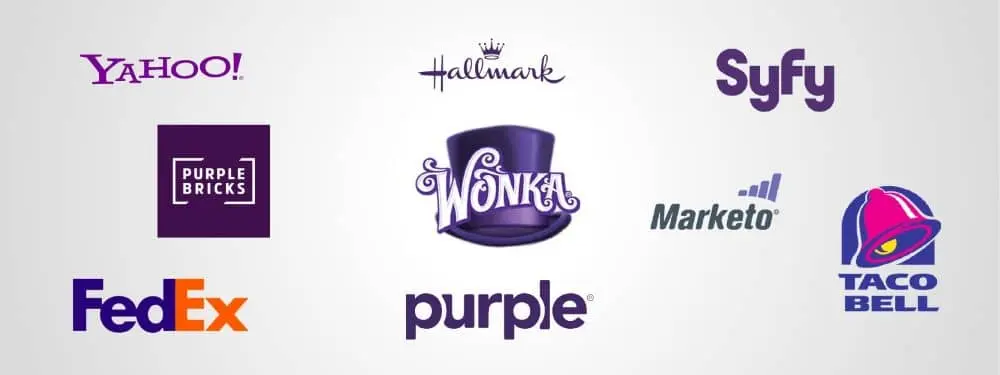
Made in Lucidpress
Brands that use purple: Yahoo, Marketo, FedEx, Syfy, Taco Bell, Purplebricks, Purple, Hallmark and Wonka.
Orange

Source: Unsplash
The color orange is associated with happiness, sunshine, citrus and the tropics. Orange is a playful color that makes people feel enthusiastic, creative and determined. It stimulates mental activity and supports energy, vibrancy and warmth.
Orange can be also associated with fire, combining the warmth of red with the happy brilliance of yellow. Orange tends to communicate energy & optimism. Usually, orange is associated with youth and creativity. If you want to look adventurous & competitive, orange is your color!
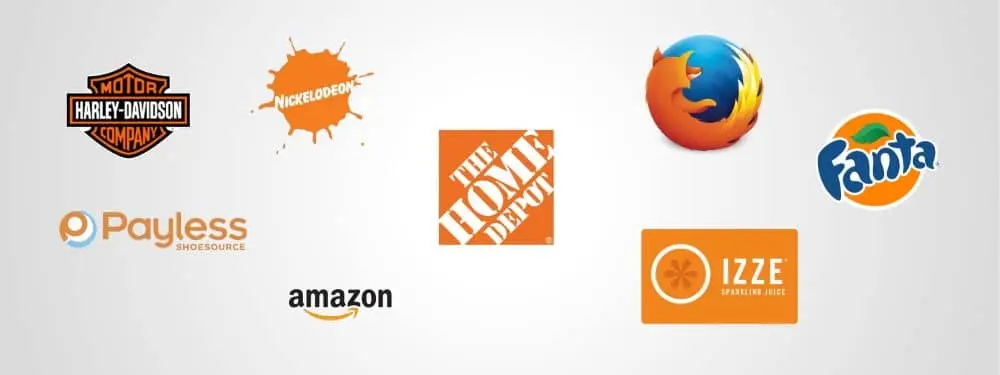
Made in Lucidpress
Brands that use orange: The Home Depot, Nickelodeon, Firefox, Izze, Amazon, Fanta, Payless and Harley Davidson.
White

Source: Unsplash
White symbolizes cleanliness, peace, innocence, youth, simplicity, purity and safety. As a reminder that colors mean different things in different cultures, it’s interesting to note that white carries connotations of death and mourning in many Asian cultures.
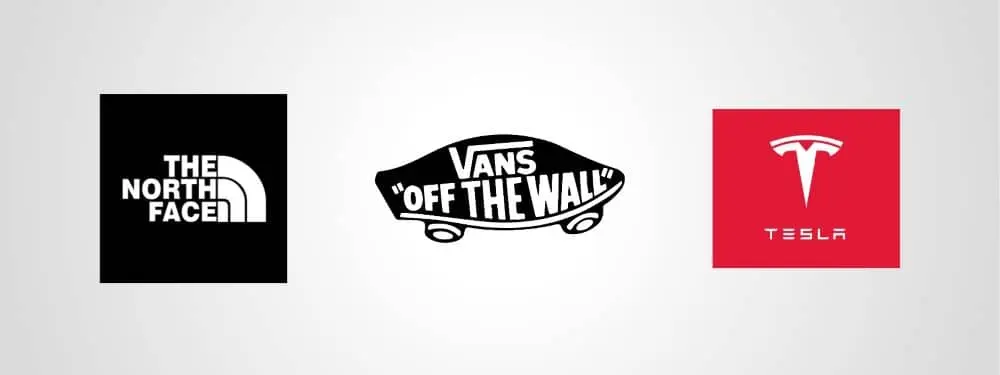
Made in Lucidpress
Brands that use white: The North Face, Tesla and Vans.
Black

Source: Unsplash
Black symbolizes luxury and the mystery of the night. It’s bold, serious, powerful, elegant, wealthy, stylish and sophisticated.
Like red, black can convey both positive & negative emotions. It can invoke associations of power & minimalism, or on the other hand, it can portray something dangerous or gloomy. Depending on the context, its meaning can differ. In branding, however, black usually comes across as exclusive & luxurious.
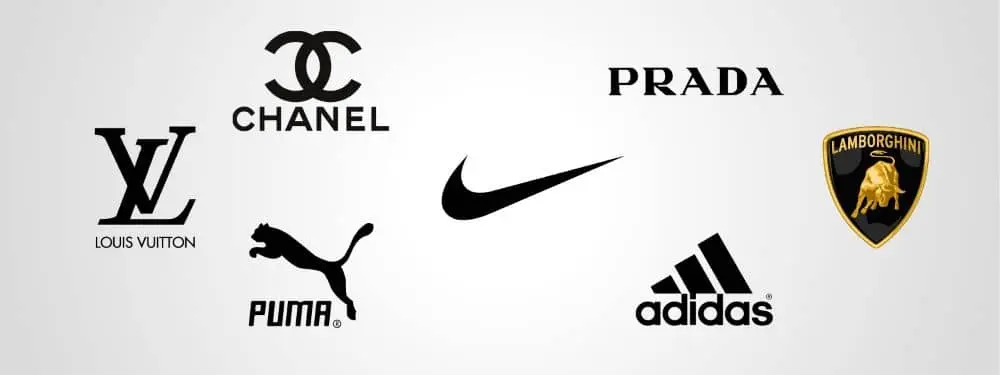
Made in Lucidpress
Brands that use black: Chanel, Nike, Adidas, Louis Vuitton, Prada, Puma and Lamborghini.
Pink

Source: Unsplash
Pink symbolizes love, romance, tenderness, caring, sweetness, warmth and youthful fun.
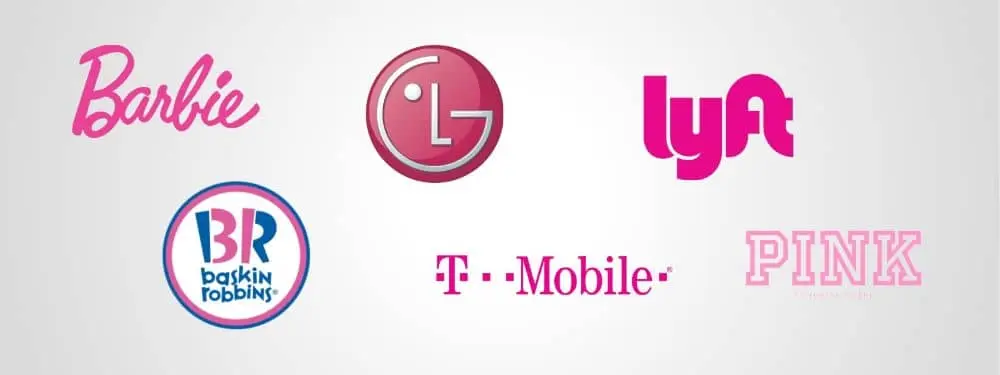
Made in Lucidpress
Brands that use pink: Barbie, Baskin Robbins, T-Mobile, Lyft, LG and PINK.
Brown

Source: Unsplash
Brown is associated with the earth, reliability, support, dependability, the outdoors, simplicity, endurance and support.
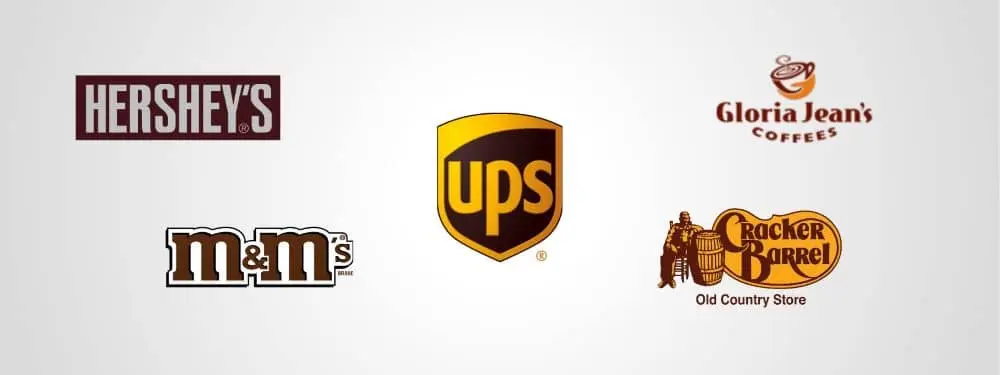
Made in Lucidpress
Brands that use brown: UPS, Hershey’s, M&Ms, Gloria Jean’s Coffee and Cracker Barrel.
Key takeaway
While color has the power to affect people’s moods, choosing your brand colors shouldn’t be based on emotional response alone. As Emma Foley of Clinique says, “There’s so much more that goes into a brand than a logo and color.” Once you understand your brand’s customers and values, you can create a brand color palette that speaks to them.
Ready to start testing your new brand identity? Try creating a few logo variations in Lucidpress, using your brand colors.
Someone who cares.
When it comes down to life essentials, that’s all us humans need besides food, water, and shelter.
Our need for connection is wired into our brain because our own survival depends on it. As a result, we respond to and connect with other people who satisfy this fundamental need of ours.
Related: Brand archetypes — Which of these 12 brand archetypes fit your brand?
There’s a big opportunity for brands to differentiate themselves not by being “the best” or “the first”, but the ones who care the most.
Is your company’s mission driven by the desire to help and support others?
If this your dominant characteristic, consider embracing the caregiver brand archetype. As the examples below reveal, there’s a lot you can achieve by growing into this narrative.
Does your brand fit the caregiver archetype?
As customers, we have an inevitable tendency to personify brands. This goes to show just how strong our need for emotional connection is.
If your brand personality already favors building relationships instead of coldly communicating product features, then you are already on track to become a caregiver.
Specifically, the characteristics of the caregiver archetype include:
- Sustained focus on the customers’ needs that’s visible throughout the company
- A proclivity for volunteering time, energy, and resources to assisting customers
- The ability to notice when someone needs help and the ability to provide it
- A responsible and benevolent way of conducting business
- A constructive approach to community involvement
- A track record of dependability and being supportive of others.
Traditionally, these traits have been associated with NGOs, but there are several commercial brands that are true caregivers too.
In recent years, an increasing number of companies have grown based on these exact features. This strong foundation allowed them to develop a strong, recognizable brand with clarity and confidence.
The caregiver archetype examples below show exactly how they achieved this.
Truthful brand positioning has a ripple effect
We long for loving, secure relationships not only with people, but with other entities we interact. The more we depend on a company — for our water, safe travels or most sensitive data, the more we need to be able to trust it.
Organisations that embrace the caregiver archetype inspire trust due to their brand mission to help, protect, and care for others in ways they cannot do so themselves.
For example, Johnson & Johnson articulate mission clearly on their about page: “130 Years of Caring”.
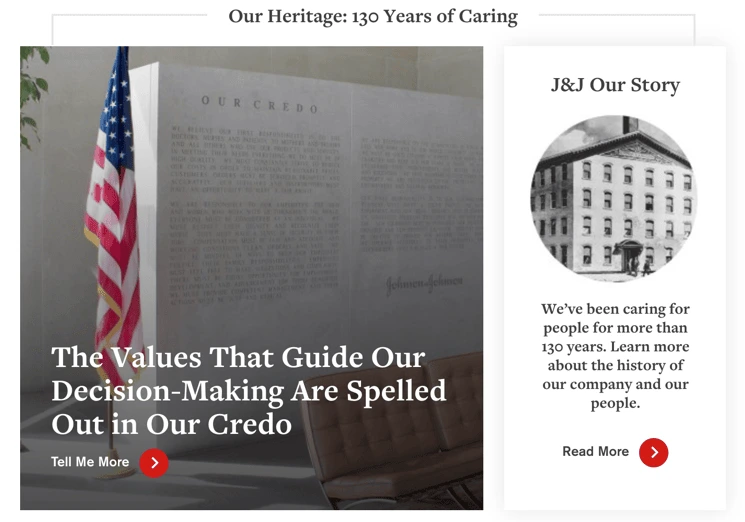
In 2018, Johnson’s Baby (no affiliation with J&J) launched a campaign called “Choose gentle” that states their commitment to a similar idea:
“We believe in the immense, transformative power of gentle. Gentle is something the world can’t ever have too much of. #ChooseGentle”
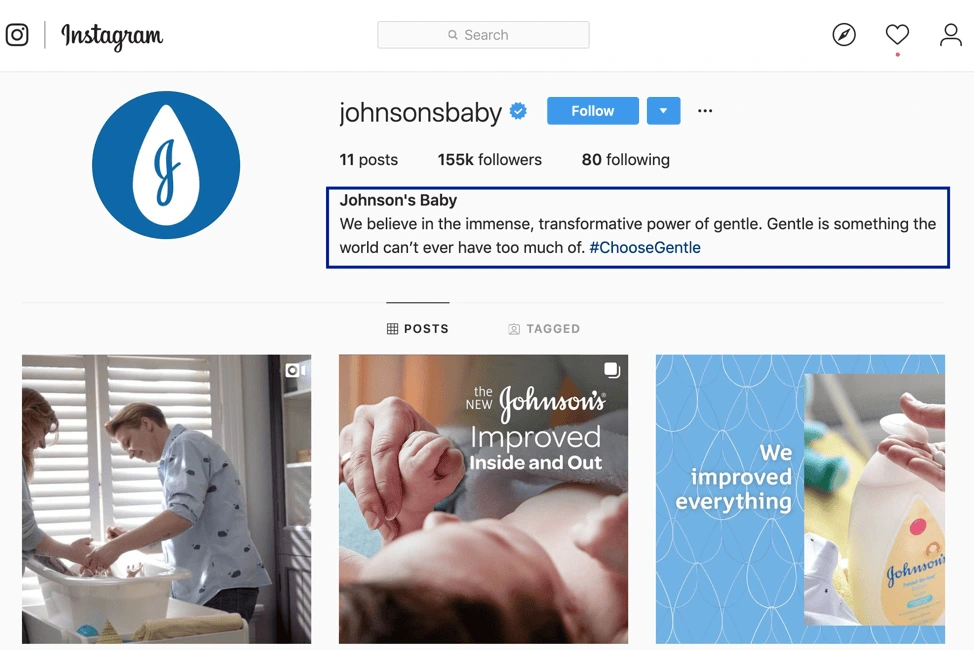
P&G taps into similar values to articulate their mission:
“We will provide branded products and services of superior quality and value that improve the lives of the world’s consumers, now and for generations to come.”
Another brand from the same industry, Honest, tells their story along the same lines:
“Our story began with a simple desire: to make the right choices for our families. We were parents in search of safe options, but unsure of where to turn. We needed one brand that we could go to for trusted products and information. And when we couldn’t find what we were looking for — and realized we weren’t alone — the idea for Honest was born.”
As you can notice, brands that fit the caregiver archetype seek to inspire others to act on the same nurturing tendencies. They do so by acting on their brand values and operating from a posture of:
- Generosity
- Humility
- Empathy
- Compassion
- Trust
- Kindness
- Openness
- Optimism
- Transparency
- Integrity
NGOs are the best equipped to harness the power of this brand archetype in a significant, impactful way.
Unicef’s USP — “For every child” — speaks to their dedication of working to improve the wellbeing of children around the world.
“We campaign for a world where human rights are enjoyed by all” states Amnesty International, pointing to the bigger picture and inspiring others to join their pursuit.
The Bill & Melinda Gates Foundation has a similar position dedicated to selfless service:
“All Lives Have Equal Valuewe are impatient optimists working to reduce inequity”
For a caregiving brand, the core strategy is to do things for others. This can mean facilitating shared experiences or aligning people around common ideals. Also, this brand archetype excels at creating a feeling of belonging to something greater than oneself.
In this context, you can also achieve more clarity by assign a role for your brand to play in the market or in the community. You can be:
- An altruist
- A nurturer
- An advocate
- A helper
- A supporter
- Or even a mentor.
Developing your caregiver features can prove especially powerful for new brands seeking to build a recognizable personality. It can be equally helpful to companies trying to break out of their industry and reach a wider audience.
Being a constantly nurturing, supportive company creates a strong, consistent brand that customers are excited to endorse. That’s because these characteristics appeal to the universal values deeply embedded into our humanity.
Caregiver brands are good for everyone
When your company embodies the caregiver archetype, it:
- Fosters authentic connections between the brand and its customers and partners
- Builds loyalty among customers, reducing churn, and cultivating a constant interest in your products and services
- Empowers vocal advocates that carry your message forward and generates word-of-mouth promotion
- Lowers your cost of acquisition based on empathy and affinity for your brand
- Creates long-term value by helping people make better choices and care about others.
To achieve these goals, pay attention to your brand voice. The caregiver is usually considerate, thoughtful, kind, positive, calm, and supportive. Can you identify these features in your communication?
Next, evaluate your visual identity. Do your color scheme, font choices, and layouts create experiences that reflect kindness and gentle understanding?
For example, Headspace — “Your guide to health and happiness” — breathes positivity into their users’ lives through their website, app, and all channels they use for communication.
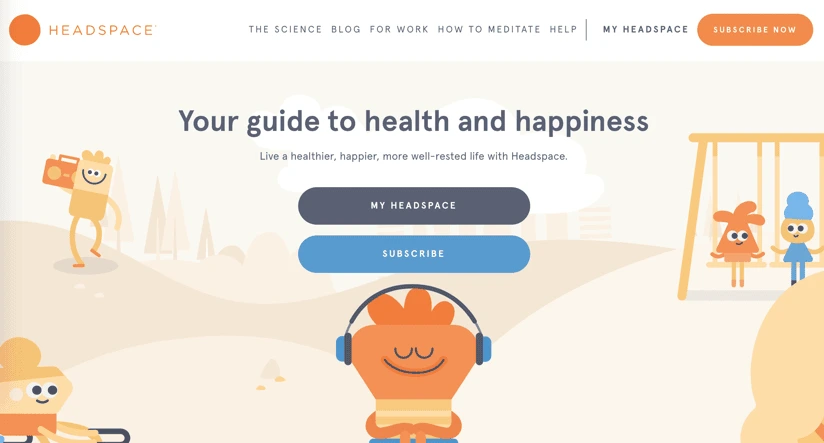
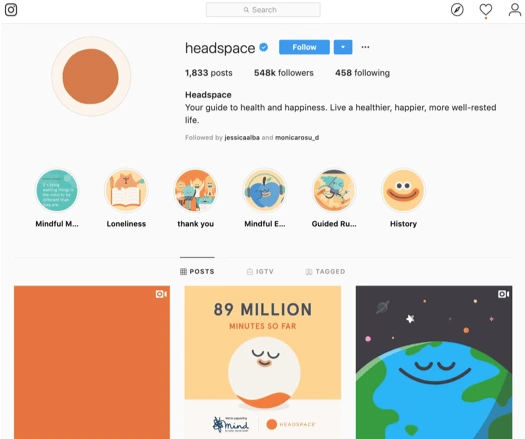
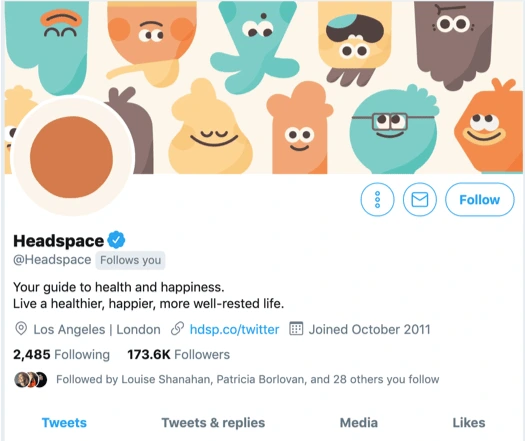
As you can see, their branding is remarkably consistent, albeit adapted to each channel’s specific communication style.
Another equally captivating example is Wistia, whose brand positioning empowers their customers to thrive: “Create, host, share, and measure your videos like the human you are. ?”.
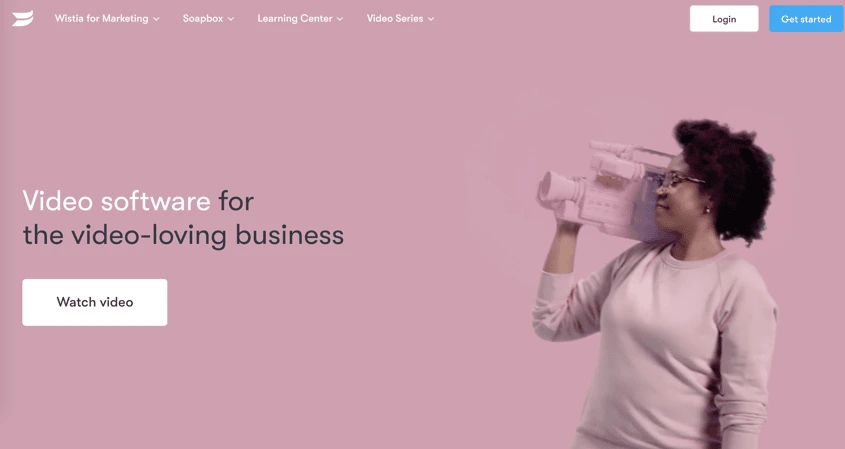
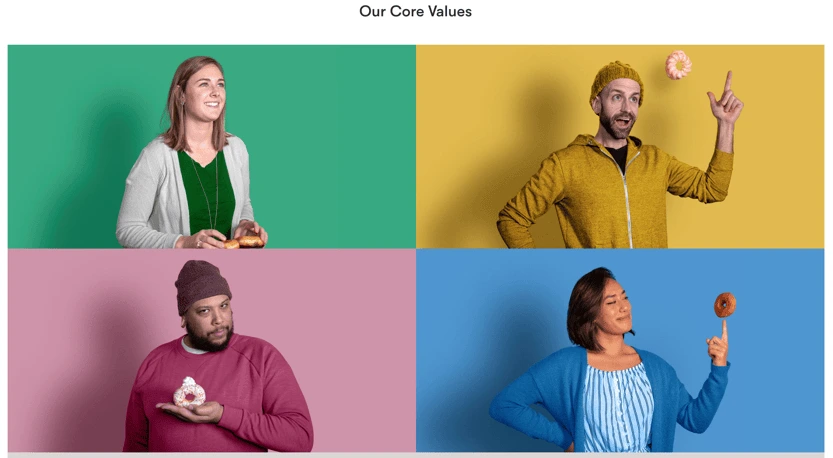
Their branding is colorful but in a gentle, inviting way that combines feelings of calm and excitement in a way that feels healthy and balanced.
Wistia has also been recognized for their exceptional customer service which goes to strengthen their brand’s focus on helping others succeed.
Loyal followers will amplify your mission
Being a caregiver brand gives your customers a competitive advantage that’s associated with a powerful positive message.
Whether through shows kindness or empowering people to care for themselves, you will most likely attract people who value connection.
Those who have a lot of responsibility will naturally gravitate towards your brand as their tendency to look after other people is stronger.
If you make these customers feel loved, safe, taken care of, they will soon become thankful for your support. Nurturing that feeling of “we’re in this together” can lead to them becoming strong advocates for your mission who carry your message to their own circles of influence.
For example, The Salvation Army is top of mind for those who want to extend a helping hand to people across the world. When it comes to donations, they are also the first to come to mind.
Volvo launched in early 2019 the E.V.A. initiative which entailed sharing over 40 years of their own safety research so other car manufacturers can provide an equal level of safety for both men and women (who are at a disadvantage).
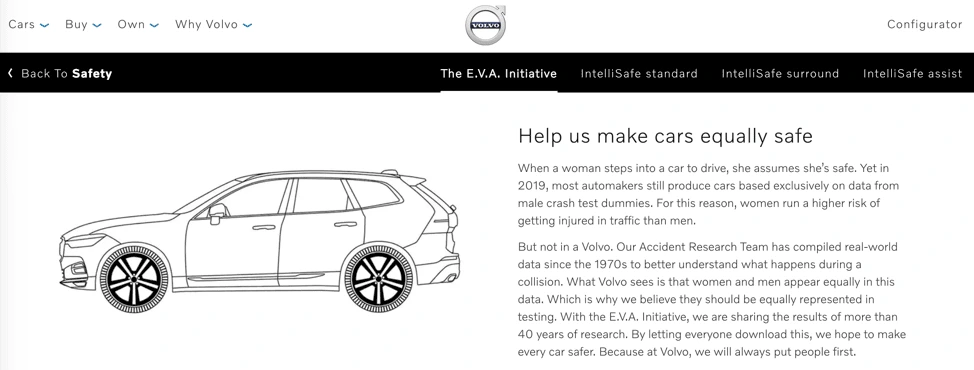
To make it easier for your followers to share your call to action, make sure you provide them with up to date, eye-catching brand assets they can use on their own channels.
Visuals always work best, especially when you combine them with a clear and compelling message. AVAAZ does a great job at this:
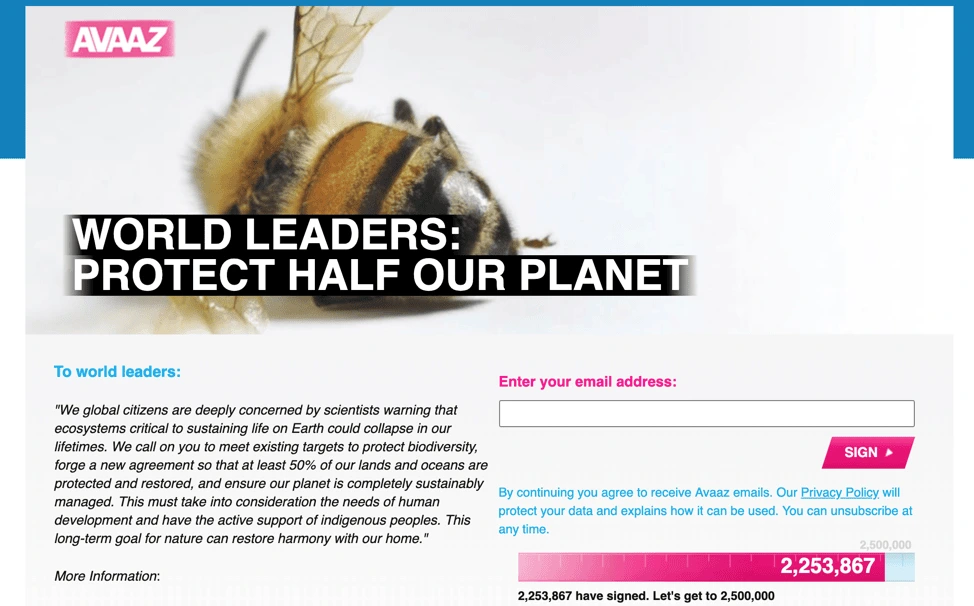
Ready to embrace the caregiver brand archetype and make the most of your resources to help others?
Start by unifying your communication around a clear set of values that will guide your strategy. Choose the role you want your brand to play in your community. Give it a voice, using words, visual assets, text and/or audio, and start attracting more loyal customers and supporters.
Strengthening your relationship with them puts you on a growth path that greatly benefits from the compound effect these acts of kindness have on everyone’s lives.
Is it time to update or refresh your brand’s identity? Learn more in our free ebook: How and why to rebrand your company
The main goal of your brand, as it is of any brand, is to make a profit and perhaps change some lives in the process.
But what if we said that every brand – whether intentional or not – has an underlying brand personality? And that this personality, sometimes referred to as a brand archetype, can actually be used to build deeper connections and drive more sales?
Related: Brand archetypes — Which of these 12 brand archetypes fit your brand?
In this post, we’ll discuss the concept of brand archetypes. We’ll then highlight one archetype in particular – the magician.
Finally, we’ll show you how Lucidpress can help you to maintain a consistent brand personality across all of your campaigns and platforms. Let’s begin!
Why your brand archetype matters
The personality traits and characteristics of the magician archetype are well and good, but what does this matter to your brand?
It helps if you think of your brand as your company’s personality.
How do you want customers, potential customers, investors, and competitors to see you?
This is where the brand archetype comes in.
Humans like to connect with other humans. An archetype, then, helps your brand to appear more human. And this connection can lead to deeper, more fulfilling relationships.
Even further, this humanness can lead to more sales and higher profits.
The magician brand archetype
As the name suggests, the magician archetype is mysterious and somewhat elusive. They’re also incredibly persuasive and driven by the need to make positive change.
The magician archetype is far from the only one that exists, though. There are twelve brand archetypes in total. They are the:
1. Caregiver.
2. Creator.
3. Entertainer.
4. Explorer.
5. Girl/guy next door.
6. Hero.
7. Innocent.
8. Lover.
9. Magician.
10. Maverick.
11. Royalty.
12. Sage.
And while we’d love to dig deep into each one, we’ll be focusing on just one of these today: the magician.
A brand with the magician archetype is one that has lofty goals, but that also has the power and drive to attain those goals.
There are those who may say that the magician can even be a manipulator, but as with all things, balance is key.
Are you in need of brand inspiration? Let’s take a look at just three of popular brands with the magician archetype.
Example: Tesla
When you think of mystery and innovation, which brand comes to mind? For us, it’s Tesla.
Tesla is the American automotive and energy company owned by Elon Musk. Their goal? To change the world.
In fact, innovation and positive change seems to drive everything they do.
From mock-ups of their next vehicle model to their Instagram feed, Tesla is all about making an impact.
Example: Disney
When it comes to creating magical moments, who does it better than Disney?
Whether you’re watching their movies, cruising the seven seas on their liners, or strolling through their parks and chatting with your favorite characters come to life — Disney makes the impossible, possible.
Example: Red Bull
The owner of Red Bull doesn’t have plans to go to Mars (that we know of, anyway!), and they don’t own and operate the happiest place on Earth. But where Red Bull gets it right is in it’s lofty approach to brand marketing.
The brand’s slogan is simple, but explicit: “Red Bull gives you wings!”
In essence, they claim their drink is the magic potion that will help you to achieve your goals and even make a dream come true.
Which businesses would benefit from the archetype
You may have aggressive goals, and perhaps you even hope to change the world. But that’s not all it takes to become a standout brand that falls under the magician archetype.
Just as with the other archetypes, there are those that would benefit more from this angle. They include brands that:
- Create/promote a transformative experience.
- Offers clarity and knowledge.
- Design and sell contemporary, new-age products.
- Have a spiritual or conciousness-expanding angle.
That’s not to say that you can’t incorporate bits of the magician archetype into your overall brand strategy. But this is definitely not an archetype for the weak at heart!
How Lucidpress can help you to design your brand
A consistent brand design is crucial, but also difficult to achieve in reality.
That’s where Lucidpress can help.
Lucidpress is an online print and digital software program that helps you achieve your brand goals. How? Well, one way is with our brand management software.
As a brand templating platform, Lucidpress is a great way to help your marketing team stay on brand and generate the exact marketing content you need.
First and foremost, Lucidpress offers you one centralized location to store and manage all of your digital brand files. From anywhere in the world, your team members can access anything they need.
But Lucidpress is also a secure place to store your brand assets, including logos, fonts, and templates.
With Lucidpress, you don’t have to worry about finding the latest version of a logo on your computer, or uploading your brand-approved font for each digital design task. Just upload them once, and you’re all set!
And finally, Lucidpress enables you to design and distribute your branded content across numerous channels.
The drag-and-drop editor makes it easy to build brand templates, and you can then share with your team – or the world – with just a few clicks.
So, what are you waiting for? It’s time to bring your brand to life with the help of Lucidpress.
Your brand is one of your company’s most powerful assets. It encapsulates everything you want people to know about the business—what you value, what you stand for, and what you’re trying to do.
Related: 6 important branding tips to keep in mind when going global
Which is why brand extension can be such a stressful process. Using the strength of your brand to enter a new market gives you a headstart that new companies can’t match.
Understanding how to extend your brand is crucial for engaging markets. Before you launch a new product or adopt a new strategy, you’ll need to think about a few things.
Before we get into those things, though, let’s agree on a brand extension definition.
What is brand extension?
Brand extension is the use of an existing brand name and logo on a new product. The original brand identity is called the parent brand, and the new products are called spin-offs. Companies use this strategy to capitalize on the brand equity of their existing brand to launch new products and enter new markets.
Let’s look at Apple. For 25 years, the company built personal computers. And they were good at it. That’s what they were known for—powerful, attractive computers that were easy to use.
And then they entered an entirely new industry: personal music devices. The iPod was an immediate and immense success. We’ll talk about how Apple pulled this off in a bit. First, let’s talk about why it was a good idea.
Why brand extension is so powerful
Apple had built a very strong brand over 25 years of making personal computers. Why would they risk diluting that brand by entering a new industry? The stakes are high, and the chance of failure keeps many business owners from even considering a big move like this one.
But Apple knew that building on their brand would be immeasurably valuable if they did it right.
Companies spend years and millions of dollars solidifying their brand. Marketing campaigns, social media interactions, advertising, public relations, and product development all contribute to a brand’s strength.
Why? Because consumers recognize and value brands. People are more likely to buy products from brands they know, whether they feel explicit brand loyalty or not.
This type of brand recognition means that the presence of a strong parent brand—like Apple—can significantly boost the sales of new products. Introducing a completely new product is hard. It’s much easier when that product is backed by a recognizable brand.
But sometimes his type of thinking can get companies into trouble.
Where brand extension goes wrong
Not every brand extension builds on a strong brand to create huge sales. Let’s look at an entertaining brand extension failure: Zippo Fragrances.
Zippo is a very strong brand in the world of cigarette lighters. Their name, design, and even the sound of the product is very distinctive. If you see a Zippo, you know it. Can you name another brand of non-disposable lighter? Probably not.
This is a strong brand. Zippo wanted to use their brand equity to enter a new field.
Why they picked perfumery is anyone’s guess.
The company actually used some good brand extension tactics. They kept the brand name and even used their distinctive lighter design for the perfume and cologne bottles.
But absolutely no one thinks of Zippo when they think of perfumery. Instead of seeing the brand and thinking, “I trust Zippo,” people think “Why would Zippo make a cologne?” That’s a failed brand extension.
Zippo missed a crucial ingredient of the brand extension recipe.
How to get it right
If you’re thinking about extending your brand, it’s worth looking at some recent successes. Look at Tesla’s expansion into trucking, for example. O, Oprah Winfrey’s magazine. Tootsie Pops. Virgin Airlines (and dozens of other Virgin-branded forays).
What do these brand extensions have in common? Above all, they play to the parent brand’s strengths. Tesla already knows how to build great vehicles. Oprah knows how to tell stories that capture the hearts and minds of her audience. Tootsie Roll knows how to make a candy that people love. Virgin knows customer service better than almost anyone.
Successful brand extension strategies place the new product as a logical extension of previous ones. That’s why Zippo perfume isn’t a household name. Everyone knows Zippo for their lighters. Their brand equity didn’t transfer to their beauty products.
Apple knew their brand equity would transfer to the iPod because their brand was already adjacent to the music device industry.
Be careful with brand extensions to reap their rewards
Brand extensions can be hugely valuable. But when used without enough forethought, they can also be disastrous.
It’s crucial to give any potential brand extension a great deal of thought. If you do decide to extend your brand, make sure to apply your branding consistently to take advantage of the loyalty that you’ve been building for years.
Don’t be like Zippo. Be like Apple.
How can brands stay competitive in today’s design-centric world? Explore the rise of the design democracy, then learn how your organization can ride it to the top.
Here’s a promise: by the end of this article you’ll know exactly what a brand promise is and you’ll have plenty of examples that will help you have your own in a matter of minutes.
And there’s something more.
Related: An 8-step brand development strategy
Are you ever a bit confused about some of the marketing jargon out there?
Maybe you’re wondering:
- Is a brand promise the same thing as a tagline?
- Is it a word? Is it a phrase? Is it a 30-second pitch?
- Is there a difference between a brand promise and a unique value proposition?
I understand—everyone is using these terms with their own interpretation, right?
Fortunately, by the end of this article, everything will be clear. Promise.
Ready? Let’s dive right in!
What is a brand promise?
What’s the first thing that comes to your mind when I say Las Vegas? Was it something related to gambling, poker, blackjack, casinos or nightlife?
What’s the first thing you think about when I say Volvo? Was it something related to safety?
What’s the first thought you have when I say Mercedes? Was it something about quality and luxury?
You see, a brand promise is your perception of how you feel about a brand.
A brand promise is not a tagline.
Do you know the tagline of Mercedes or Volvo?
Probably not, right? But you know what their promise is.
You know that they promise you a luxury car (Mercedes) or a safe car (Volvo).
And there’s one more important thing. You know that they can keep their promises.
But, this is starting to sound like a unique value proposition, right? You promise something that only you have, and people will remember you. Or… is it?
Let’s see.
A brand promise is not a unique value proposition (but it incorporates one).
A unique value proposition (or a unique selling point) basically says:
- What you do
- Who you serve (or sell to)
- How you solve your customer’s needs
- And how you’re different.
Here are a couple of examples:
For {target} who {statement of the need or opportunity}, {Name} is {product category} that {statement of benefit}.
For content marketing companies who always have tight deadlines, ContentBoost is the content creation software which helps teams produce long-form articles, blog posts and ebooks on high-speed because it lets you build on each other’s ideas.
We help X do Y doing Z
We help content creation teams write better and faster by dragging and dropping research into documents.
We do X, but the difference is {primary differentiator}
We help content teams put all their content together, but the difference is that writers are also able to pull from that database and add to a library of bite-sized research.
Is this enough to have a strong brand promise? Let’s do a quick imagination exercise.
You and I don’t know each other.
But let’s say we randomly meet at an event, and I tell you I recently started a company that creates the safest cars on the road ever — even better than Volvo.
Basically, let’s say I just tell you my unique value proposition. A simple statement that says what my company does for who and how we’re different.
Would you believe me? Probably not, right? You’ve just met me.
And if someone asked you half a year later what the top 3 safest car brands are, would you mention my company?
There’s probably 0 chance you have that instant association between my company and your safety. This is why a unique selling point is different than a brand promise.
So what is, in fact, a brand promise?
There are two kinds of brand promises: an implied one and an explicit one
For instance, an element of every airline company’s brand promise is that they will get you to your destination safely. You don’t have to promise that any more. It’s an obvious (implied) brand promise.
Let’s take another example.
A restaurant’s implied brand promise will be that they provide great food with great service. No one comes to a restaurant expecting an awful customer experience, right?
But, there are also other elements that are explicitly stated.
For instance, when FedEx first started out, they promised you that they “will get your package to you by 10:30 am the next day.”
This is a promise that 1) was different from what everyone else had, and 2) was also something people might not expect, so they stated it explicitly.
Here’s the most simple, short and down-to-earth brand promise definition:
A brand promise is what you instantly KNOW and FEEL about a brand.
But how do you create such a lasting brand purpose or promise? How do you get people to instantly associate your brand with a certain quality like safety, quality, luxury, or whatever you want?
How do you move people from being total strangers to trusting your brand?
You will see that a brand promise is, in fact, more like a process — and it’s part of the whole branding strategy and brand identity.
Let’s see what the essential elements you should take into consideration are if you want to create an effective brand purpose that people will remember.
1) Start with a promise that you would tell a friend
If you want people to remember something about your brand, it first must be clear for you what that something is.
And the way you do that is by actually telling it to a friend or an ideal customer.
Let’s do a short exercise that will help you create a first draft of your brand promise.
Imagine you’re drinking a coffee with your core customer. He is right in front of you, and he’s the best buyer in the world:
- He’s already researching the kind of products/services you sell
- He has the money
- He’s willing to spend it
- He isn’t overly skeptic
- He’s already made similar purchases in the past
And now, he is just waiting for a reason to buy something from you.
What do you promise him in exchange for his hard-earned money?
It all boils down to this:
If you give me X amount of money I PROMISE I will give you _____ {this product / service} which will help you do / achieve / become _____ {introduce benefits} better than ____ {other services/products} because ____ {why you’re unique}.
Let’s say you’re the marketing manager or the CMO of an electronic e-commerce business.
Here’s an example of what your brand promise can be:
If you give me $1000, I promise I will give you this super-fast, octa-core laptop which will help you simultaneously work on however many engineering programs you want (without buffering or crashing).
What makes us unique is that we’re the only ones who use quantum computing, and we’re also the only ones who offer 10 years’ guarantee on every single product you buy from us.
You see, the brand promise isn’t a tagline. It isn’t “Just do it” or “Think different.” Because that’s not what you would say to a person face-to-face.
And this doesn’t have to be limited to a single product or service. It can be also adapted to a more general promise.
Let’s take the example above and apply it to the company level.
If you choose to do business with us, I promise you’ll never have to suffer from having a dysfunctional device, whether it’s a phone, laptop or any other electronic device.
This is because we’re the only ones who have developed special partnerships with all our suppliers, and we’re giving you not just a 10-year guarantee for almost any product you get from us, but free full service and support for the period your device isn’t functioning properly.
But is that all? This is the brand promise?
What if someone else comes along and says the same thing — or what if you don’t have something so unique to begin with?
What if, for instance, you want to create a brand promise for a restaurant, but you don’t have any special dishes?
This is how you start developing a more effective brand promise.
If you want people to remember it and instantly associate the quality you want — like great customer service, for instance — you also need the next elements.
2) Create a mental movie in people’s minds by making everything ultra-specific
One day, a friend of mine decided to do a little experiment:
He randomly called about 10 local pizza shops. He said something like: “Hello, I want to come to your place with 10 friends, but one of the guys insists on going to another restaurant. I need your help to convince him: why is your pizza better?”
Here are just some of the responses he got.
Response #1: (Annoyed) “Hmm… Not sure. It’s your call.”
That’s how not to make a promise…
Response #2: “We use high-quality ingredients.”
This sounds good, but what does quality mean? Plus, do you know anyone who says they don’t use high-quality materials, no matter what they’re selling?
You see, this is an implied brand promise. Quality, great customer service, great food, etc.
You don’t go to a restaurant and expect bad food, right?
So, there must be a better way to make a brand promise. Let’s look at another response my friend got.
(Full disclosure: the person who answered this time was actually the owner of the restaurant.)
Response #3: “Oh, well, we use high-quality ingredients. For instance, our sauce and flour are made with true Italian ingredients.
Take the cheese, too. It’s not just cow-milk mozzarella. Instead, we use a buffalo-milk mozzarella.
And there’s also the sauce. Sir, we don’t use pre-prepared sauce. We use genuine San Marzano tomatoes right from Italy!
We’ve been handcrafting pizza for 5 generations. With every crispy bite you take, you taste 90 years of pizza-baking mastery!”
You see, the promise is really simple: You get tasty, Italian pizza with high-quality, authentic ingredients, and you can be sure it’s good because they’ve been perfecting it for generations.
See how it all changes when you actually put a picture in people’s heads about what those high-quality ingredients mean or what experience means?
Now, is this enough to earn a special place in people’s minds?
Well, it is a good start. But if you really want to get people to remember your brand promise, you need to apply element number three from our list.
3) Repeat it over and over again. Across all the channels.
By now, you’ve created the first draft of your brand promise.
You know what to promise if you’re face-to-face with your ideal client.
You also made it ultra-specific, and you can give people all the details on how you’re different and why they should choose you.
But, there are so many other brands that try to do the same. How do you get through the noise and get people to remember you?
Here is the simplest but most powerful thing you can do:
Repeat it as many times as you can. And keep it consistent across every communication channel you use.
Why is this so efficient?
Well, because each time you repeat your brand promise, you deliver it to people who might not have noticed it previously.
There’s more.
With each repetition of your core message, your audience gets more familiar with your brand, products & services, and company.
This leads to familiarity, to that feeling of acceptance.
Once people begin to accept your brand, and your promise, they also begin trusting you.
Ultimately, this opens the door to more sales with less resistance.
The bottom line is this: no matter how strong, unique or specific your brand promise might be, people won’t remember it unless you repeat it often.
How do you repeat a brand promise without annoying people? Here’s how.
4) Use the power of suggestion to make your brand promise memorable
How do you suggest to people what you want them to remember?
Metaphors, comparisons, analogies and stories are some of the most powerful persuasion techniques you can use. They’re like a backdoor to the human mind (see what I did here?), which make your ideas stick faster and longer than a rational explanation or affirmation.
By employing these little techniques, you can repeat your brand promise without annoying your audience.
For instance, here’s a visual metaphor used by Viagra when it began selling on Amazon.

As… bold as that was, you can still go a step further. Here’s a mind-blowing example.
Red Bull’s promise is that it gives you the energy to achieve whatever you want. It will help you do extraordinary stuff because it increases your performance, concentration, reaction speed, vigilance, etc. It empowers you to go beyond limits, right?
So, how could they express this better than a jump from the stratosphere?
During a 9-minute fall, Felix Baumgartner set records for both the height of the jump and the speed of descent (830 mph!).
Who gave wings to Felix? Red Bull — the event organizer and company that made all this possible.
The bottom line is this: let people get the moral of the story. This is how you build that instant association between a certain attribute and a brand.
5) Keep your promises. Even in the little details.
You know what they say: trust takes years to build, seconds to break, and forever to repair.
It’s true for human relationships, and it’s true for brands, too.
You spend a lot of money to get people to finally believe in your promise, but if you don’t pay attention to the little details, it can all fall apart.
Here are some photos I’ve taken over the years that perfectly illustrate brand promise misalignments.
For instance, let’s say you’re boarding a plane and you see this:

The implied brand promise — that they will get you safely to your destination — is gone. In an instant.
It’s possible the plane was perfectly safe and the window wasn’t a threat to anyone’s safety, but the message communicated by this photo screams anything but.
Or, here’s a sign that I saw posted by the side of the road:

They might have a class “A” office, but they definitely get an F for design.
Based on this sign, would you truly believe they have an impressive office?
Or, let’s say you’re waiting in a doctor’s examining room and you see this:

Is this where a doctor should keep his thermometer sleeves?
I’m pretty sure that wasn’t a used cup — but if you think about it, the implied brand promise of any company is (or should be) attention to detail, clean supplies, etc. By failing to pick up on that, you could be sending harmful messages about your brand promise without even knowing it.
Now, let’s see a positive example of a brand promise.
FedEx’s core promise is that they will go to great lengths to deliver your package on time. And they have stories to prove that. For instance, a driver called Mike O’Donal single-handedly salvaged Christmas for one of his customers.
The customer found out just a few days before the holiday that he sent the package to the wrong address, and it didn’t reach its destination.
The package contained the only Christmas gift the customer could afford to give her daughter, and now it was in someone else’s hands.
So, the driver tried to retrieve the package. When the person at that address denied receiving it, O’Donal decided to play Santa Claus.

He purchased a duplicate gift out of his own pocket in time for Christmas Eve.
Through his actions, O’Donal did more than just replace a gift — he earned the customer’s gratitude and loyalty.
A quick recap on how to create a brand promise that sticks in people’s minds
A brand promise is like the moral of the story. Just like in the fairy tales, the moral was rarely directly stated or called out, but it’s implied through every aspect of the story.
For instance, nowhere in Pinocchio does it say that lying makes you look bad — but in the end, that’s the message we take with us.
So, here are the most important elements of a successful brand promise:
- Tell your brand promise as you would tell it to your ideal customer face-to-face.
- Describe your promise in detail. What does “quality” actually mean?
- Repeat it across all the channels. Repetition works.
- Use the power of suggestion: start with analogies, comparisons & metaphors.
- Make sure you keep your promises, even when it comes to the little things.
Ready to start building your brand? Learn about the 10 assets you need to effectively manage a brand online in our free ebook.
According to Bain and Company, the luxury goods market is set to double in size from 2020 to 2030, reaching over $617 billion by 2030.
From watches to condos, business is booming. Even discount retailers like Target partner with designers like RHODE to attract customers shopping for high fashion at affordable prices.
But what does it take to build a luxury brand? What makes good luxury branding stand out? Here you’ll find everything you need to know about building a luxury brand from the ground up.
Let’s get started, shall we?
What is a luxury brand?
The definition of a luxury brand can change depending on the type of brand you’re describing.
In consumer goods, it’s Louis Vuitton and expensive couture fashion. In hospitality, bespoke travel experiences in exclusive or boutique locations would be considered luxury.
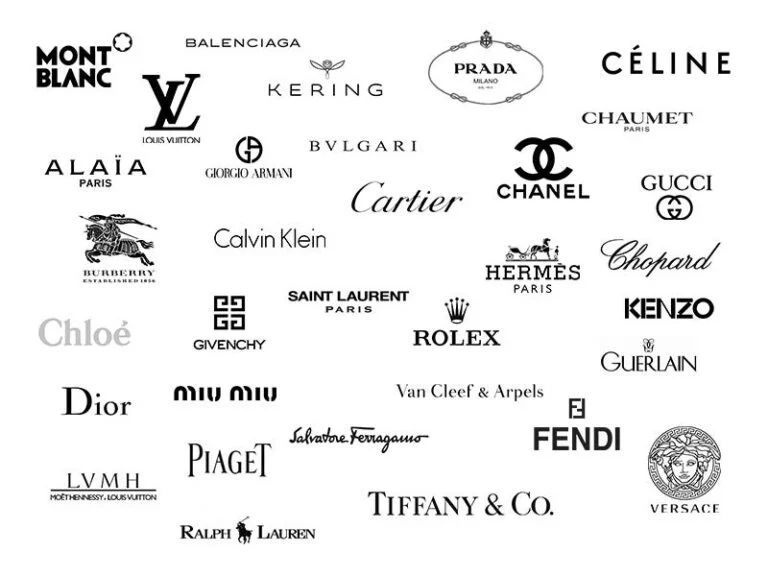
[Some of today’s most recognizeable luxury brands]
According to THAT Agency, five factors clearly define a luxury brand:
- Price
- Quality
- Design
- Meaning
- Rarity
- Service
Ultimately, consumer perception plays a huge role in elevating luxury brands above others. People associate luxury brands with higher prices, higher quality, rarity, and a sense of exclusivity.
Take Louis Vuitton, for example. Since 1854, the French brand has consistently worked to perfect their luxury brand. Today, they stand out for several reasons:

- The company invests in collaborations with a variety of artists, influencers, and celebrities without diluting the brand – like the above collab with Japanese artist Yayoi Kusama.
- Regardless of the artist collaboration or Creative Director at the helm, LV maintains a consistent brand identity.
- The parent company of Louis Vuitton, LVMH, also owns a slew of other luxury brands, giving them a ton of experience in the art of luxury branding.
How to build a luxury brand
Ready to learn how to build a luxury brand from scratch? We’ve got you covered.
The brand leadership experts at Martin Roll suggest a five-step framework to build a strong luxury brand:
Get specific about who you’re targeting.
There’s a niche audience out there that cares about your brand/product/mission. Figure out exactly who they are, and focus on one audience persona when you’re getting started. After your brand is well-established, broaden your definition of an ideal customer.
Do things differently.
Differentiation is a key focus for emerging brands. Narrow down what makes your luxury brand unique? Do you specialize in custom made, bespoke products or services? Are your items handmade? Highlighting what makes you unique is essential to standing out.
Become a status symbol.
Focus on how influencers in a specific niche are using your product or service. By creating the perception that only the most discerning buy into your brand, everyone in your target market will too.
Create exclusivity.
New luxury brands can tap into exclusivity by offering special perks to existing customers. High price tags and scarcity are other ways to employ this strategy. For example, Aston Martin combined a high price tag with scarcity when it created the Aston Martin One-77. The British car maker made a whopping total of 77 cars and sold them at $1.8M dollars each.
Consistently delivery on your brand promises
The bar for luxury brands is high. You’ll need to raise your game and keep your brand promises in every single customer interaction. Never compromise on your mission, purpose, and commitment to quality.
How to market your luxury brand
Once your luxury brand is established, it’s important to maintain a consistent brand identity through marketing.
Create a consistent brand from day one.
Start with a company style guide that gives your marketing team technical details about your brand’s look, including appropriate colors, fonts and styles. Keep in mind this is a living document that will evolve with your brand.
Make branded templates to protect brand identity.
Avoid a brand identity crisis by using brand management software like Marq. Create locked templates that keep logos from getting stretched and colors from being changed, no matter who’s working on your materials.
Engage in cause marketing and brand activism.
Cause marketing (aka brand activism) is a great way to get customers to connect to you on an emotional level. Consider your brand’s purpose and what it stands for. Are there any nonprofits or groups you can collaborate with or donate to to raise awareness?
Go all-in on SEO.
No matter how luxurious your brand is, no one will know about it if they can’t find it on Google. Invest in SEO strategies to increase visibility for your brand in the long-term.
Key takeaway
Building a strong luxury brand isn’t for the faint-hearted. With a detailed strategy and proper brand building techniques, you’re well on your way to becoming the next big thing on the luxury scene.
Need help keeping your luxury brand identity consistent? Marq has a template for that. Browse our brand template library here.
Making sure every touchpoint — from content to sales — remains on-brand is essential. But when you have seemingly limitless decisions to make regarding a new product, marketing campaign, or anything else related to your business, it can be difficult to keep all the moving parts properly aligned.
Related: Elements of an effective brand promise
That’s where a brand positioning statement comes into play. A brand positioning statement is a helpful point of reference whenever you need to make decisions about strategy, marketing campaigns or products.
What is a positioning statement?
A brand positioning statement is a short and concise description that sums up your brand. It includes:
- Your brand promise
- Your category or market
- Your customer base (and their pain points)
- A high-level description of benefits
- Who you are
A brand positioning statement is designed to be used internally. That said, it can provide helpful context for any content being created by in-house writers, freelancers or creative agencies. And while a brand positioning statement isn’t necessarily very long, you should still dedicate a solid block of time to crafting it.
In addition to creating a positioning statement, you should also write a value proposition. A value proposition should describe the beneficial features of your product, services, strategy, or approach. It includes:
- The main benefit of your products & services
- How you resolve customer pain points
The difference between a positioning statement & value proposition
The key difference between a brand positioning statement and a value proposition lay within the who, what, when, where, how and why. In theory, each statement should answer the following questions.
Brand positioning****Value proposition Who is your brand? What are the benefits of your products and services? Who is your target audience, and what are their pain points? How does your company plan to solve (or resolve) your customers’ pain points? Which category or market does your brand fit in? How does your company benefit the customer?
In other words, a value proposition illustrates a brief overview of the benefits that the product or service provides. A positioning statement focuses more on what your brand delivers to customers and how it’s differentiated from your competition.
The importance of a positioning statement
A brand positioning statement is an internal aspect of your overall brand strategy as it defines your brand’s identity and personality. It also doubles as a guardrail to help test any potential business decisions. Some businesses choose to have more than one positioning statement, perhaps addressing different market statements or brand personas.
Ultimately, a brand positioning statement is important because it helps you keep everything consistent and in line with your brand — no matter what you’re doing. Every creative asset will be measured against your brand positioning statement, so it’s essential to take time to craft it.
How to write a brand positioning statement
If you’re ready to write a brand positioning statement, there are some essential elements for it to include. For example:
- Personality — what is your brand personality and how do you want to depict it?
- Audience — who are your audience and what are their pain points?
- Market — which market category does your brand fit into?
- Brand promise — what does your brand promise to provide customers with? What are the benefits that your brand offers?
- Evidence — what efforts do you have that you can deliver on your brand’s promise?
If you’re ready to start writing your brand positioning statement, feel free to use the following template:
For [your target market] who [the primary need of your target market], [brand name] provides [the main benefit that sets your brand apart from competitors] because [the evidence that you can deliver on your brand promise].
Most brands will adjust the template to fit their taste, like in these two examples:
- “For upscale American families, Volvo is the family automobile that offers maximum safety.”
- “Harley Davidson is the only motorcycle manufacturer that makes big, loud motorcycles for macho guys mostly in the United States who want to join a gang of cowboys in an era of decreasing personal freedom.”
The result may be short, but you can easily spend days or even weeks getting this short statement to feel just right. And remember — while your value proposition focuses on the specific benefits your customers will receive from your products, your positioning statement is about why your brand is the right one for your audience. Be sure to include the unique value you provide and how that differentiates you from your competitors.
Tips & tricks to writing a brand positioning statement
When writing and evaluating your brand positioning statement, you need to double-check to make sure the statement is going to serve its purpose.
- Will this statement inform your future marketing decisions?
- How does this statement differentiate my brand against the competition?
- Will I want to change this statement as my brand grows and changes? How often?
- Is my statement unique, yet easy to understand?
By asking yourself these important questions ahead of time, you gain the clarity and groundwork needed to write a concise, compelling statement.
Keep in mind that you won’t necessarily hit the nail directly on the head with your first draft. Once you’ve written it, go over it with a fine-tooth comb and ask yourself whether it answers all the questions mentioned above. Should you find glaring errors or gaps, you can edit and rewrite it as you see fit.
If ¬— or, rather, when — elements of your advertising & marketing change, your brand positioning statement will still inform them. You might have a new tagline or different messaging, but the same guiding principle is behind these decisions.
4 brands with strong positioning strategies
When you look at how some companies handle their branding, you can also clearly see the brand positioning statements that stand behind their advertising and creative assets. Here are some of the top brands that have strong branding – and even stronger brand positioning behind them.
Amazon
Amazon rapidly grew into an online retail brand that now dominates virtually all sectors. You can get just about everything you want from Amazon. Their audience is broad, with services offered to anyone who wants access to a large range of products all in one place — along with convenient delivery. Amazon differentiates itself from other e-commerce brands by putting its customers first, as well as being innovative and committed to operational excellence.
McDonald’s
McDonald’s offers affordable, quality food choices for families who want fast food paired with efficient customer service. They provide a consistent experience across thousands of locations worldwide, following tight standards at every location. They’re set apart from other fast food restaurants because of their determination to continually improve both service and operations.
Walt Disney World
Walt Disney World is for families (and adults!) seeking unforgettable, magical experiences. Their goal is to help people of all ages make their dreams come true, and they work hard to create and promote a fun, exciting environment. As a company, Disney has been around long enough that it now inspires nostalgia in multiple generations. There’s only one Walt Disney World, and many people have come to associate it with their childhood.
Whole Foods
Whole Foods was created and inspired by people who care about their health, as well as the environment. They provide healthy, sustainable food products, using ingredients that are closely connected to those who grow them — and to the earth. Whole Foods sets itself apart from competitors by holding itself and the food they sell to high standards so that they can always deliver on their brand promise to their customers.
Key takeaway
At the end of the day, your brand positioning statement should inform your business decisions for at least a couple years. It’s worth taking some time to write it — instead of rushing it — so you have a statement that truly sums up your brand and what it has to offer. Once you’ve written it, make sure everyone at your company can access it, use it, and find creative ways to elevate your brand.
Ready to start building your brand? Learn about the must-have templates and assets to build your brand
_
Originally published in 2018 and 2019 and updated in 2021 to reflect updated data.
_
Brand consistency is the key to earning customer trust and elevating your ROI. And alternatively, inconsistent branding dampens brand status and creates confusion in the marketplace.
In an effort to better understand how exactly brand consistency drives revenue and growth, Lucidpress surveyed over 400 brand management experts to ascertain the analytical impact of brand consistency.
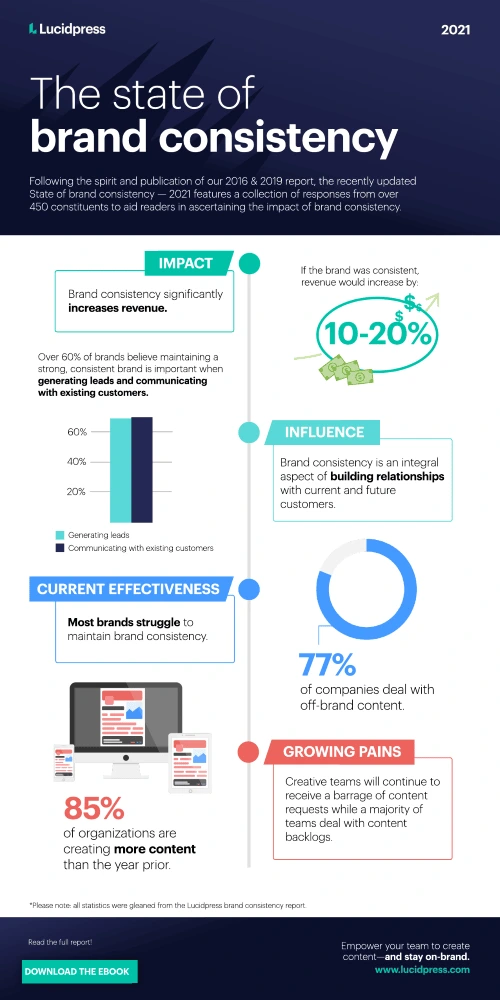
Branding is crucial to every business, but it’s so much more than a few colors, nice fonts and a fancy logo. It tells people that you care about what you deliver, that you live up to what you promise, and it shows off a glimmer of your personality — after all, it’s the make-up for your public image; an identity that people can relate to.
Managed well, branding can meet customers’ expectations and drive your authority through the roof. You’ll see a surge in new customers, leads, and conversions if you do one thing to your entire brand: make it consistent.
Here’s why brand consistency is important, and four ways you can put your business in the hall of fame for excellent brands.
What is brand consistency?
To be consistent is to be reliable — and when you’re reliable, you’re also recognizable and more likely to earn new customers or repeat ones because you’re front and center.
Brand consistency is the act of delivering the same brand messaging, voice and visual elements in every graphic, and piece of content. This ensures visibility and recognition within your target audience groups, so you stay top of mind, especially when they need you most.
Why is brand consistency important?
Think about one of the world’s largest sportswear brands. You see a check and instantly think of Nike, right?
You associate Nike and their logo because they’ve been consistent with it. After all, you’ve seen their signature tick on every piece of clothing they produce.
A brand is what people will remember most about your company, so it needs to be representative, strong, consistent and instantly memorable if you want to make a lasting impression.
You want to be their go-to company: customers should feel as though they could recommend you to friends and family, or call on you when they need additional products or services. Plus, your customers expect great design and consistent branding. For today’s customers, consistent branding and good design are key components when evaluating whether or not they do business with you.
Overall, constituents from our survey estimated that if their brand was consistently maintained, they would expect to have a 10-20% increase in overall growth, which in turn offers companies the additional revenue required to hire much-needed staff members or access to technology or software they otherwise might not have.
Ultimately, brand consistency has an extensive trickle-down effect that, when implemented correctly, can boost your bottom line, brand status, and employee morale. But unfortunately, inconsistent branding jeopardizes all that.
Impact of inconsistent brand usage
When you’re building a brand, the last thing you want to do is confuse the market. Those people could be your perfect customers: ones that drive your business’s bottom line and deliver great ROI on your branding efforts.
However, not using a consistent approach to your brand could limit your chances to generate leads or sales. That’s because people buy from brands they connect with, and brands which feel authentic. It’s hard to connect with a brand that doesn’t have a consistent appearance.
Advice from brand managers on maintaining brand consistency
How to maintain brand consistency
So, you’re looking to keep your branding consistent at every stage in your customer’s journey. But how do you do that, and which elements should you focus on?
1. Set branding guidelines for your company
Branding guidelines include details about your tone of voice, preferred professional terms and general code of conduct. Every business should have one, no matter their stage in the journey to perfect branding.
But once you’ve created them, don’t let them slip.
While 85% of organizations have brand guidelines, only30% are consistently enforced… hence why these companies aren’t seeing results. [] Not only does this mean time creating them is wasted, but staff might not understand your true brand, which will make it hard to stick to.
Treat these guidelines like the core of your entire branding activity. It’s a central document that all members of staff should use when creating marketing materials or representing your company.
2. Give staff a branding masterclass
We can all relate to the feeling of sitting in an hour-long meeting which could’ve been a 15-minute email conversation. That’s the beauty of office life, right?
However, as soon as you’ve created your branding guidelines, you’ll need all members of staff to be onboard. You can do this by giving them a brand masterclass meeting, detailing everything they need to know about the business’ history, core values and tone of voice.
Once this masterclass is over, everyone will be on the same page. Store your brand guidelines centrally and remind staff to check back on this document if they’re unsure about how to represent your brand.
Say goodbye to a mismatch of marketing messages that confuse potential customers, and hello to consistent branding. Whether staff are speaking with a customer or crafting a blog post, each stage in a customer’s journey will be perfectly branded when staff understand what you’re trying to achieve.
3. Provide staff with branding resources
All staff have been given a branding masterclass and understand what your brand is about… but how can they maintain consistency if they need to create things for external use?
The answer: provide them with branding resources.
Think about the marketing material that your customers will see. Whether it’s social media graphics or whitepapers, branding resources can keep these consistent and avoid confusing potential customers.
In the same folder as your branding guidelines, provide staff with:
- Font names
- Logo variations
- Graphics
- Color palettes
You can also create branded templates to save time and keep a high level of consistency. Lucidpress offers a large assortment of free brochure templates, social media templates and more.
4. Think wider than your website
Did you know that the average revenue increase attributed to always presenting the brand consistently is 10-20%? You could see a huge uplift in revenue if you’re always referring back to brand guidelines—not just for your website.
Many businesses assume that a logo and a website are enough to put the cherry on the branding cake. They think a simple website theme is enough to give a great customer experience, but that couldn’t be further than the truth.
That’s because every stage in your customer experience should be branded in order to maintain consistency. So, think about the typical journey that your customer has. That might be:
- Found your site on social media
- Visited your website
- Subscribed to your email list
- Purchased from you
…But if your branding isn’t consistent across the first three platforms, a purchase is unlikely to happen. Remember how we said people buy from brands they feel connected with?
On social media, it’s easy to just rattle off a series of posts to make it look like you’ve been doing it for years. But remember: all communications need to be consistent. Consumers are savvy—if there’s an out-of-place tweet that doesn’t fit your brand, it’ll stand out like a sore thumb.
People will wonder what is going on if you don’t have a consistent voice. They won’t know the team behind your company (or trust them), leading to asked questions and cash spent elsewhere.
Key takeaway
Once you’ve implemented these five steps into your branding efforts, you’ll soon see a surge of results. From paying customers to feedback like, “I love everything about your brand!”, remember that consistency is key.
Stop changing your message repeatedly and losing your customers’ interest. You want them to remember your brand—not forget it.
For a real-life example of a company mastering their brand consistency, read about Club Pilates and their experience using brand templates here.
Want to know more about the power of brand consistency and the impact it has on your creative teams, brand reputation, and more? Download our 2021 state of brand consistency report and gain insight into helpful analytics and key takeaways to ensure your brand stays consistent and visible.
*Please note that while we provide insights and tangible takeaways, this survey and corresponding ebook are designed to shed light on the intricacies, theory, and data science behind brand consistency rather than provide hard-and-fast facts. Each company, and therefore branding, is bound to encounter unique obstacles relative to consistency.
CMO’s are in a unique position to own, understand, and implement customer experience not just as a marketing function but as a fundamental component of every aspect of a business. As a CMO you’ve known for years the importance of cultivating customer relationships and building a brand customers trust. Now, with customers demanding an even more consistent and comprehensive customer experience, you can connect marketing and branding activities not just to leads generated but also to higher sales conversion rates, greater customer retention and higher numbers of brand advocates.
Start at the beginning of this post for CX beginners and go to the end for specific CX measurement and implementation strategies.
What is the customer experience?
The customer experience is the summation of every interaction a customer has with an organization. These interactions span well beyond a conversation with a customer support rep or account manager. Every interaction with your company from the website to the product to your employees impacts a customer’s experience with and perception of your company.
Your product or services should inspire or wow your customers. And then, should issues or questions arise, you should feel confident in your customer support representatives to offer applicable solutions, and provide a memorable customer experience.
Why customer experience matters
Today’s customers expect a personalized customer experience — 33% of consumers who abandoned a business last year left because their experience wasn’t personalized. Another survey found 81% of marketers expect to be competing mostly on the basis of CX within the next two years.
CMOs who focus on developing a comprehensive customer experience program now will find themselves at a significant strategic advantage over those who wait to recognize the importance of delivering an exceptional customer experience.
Customer experience vs customer service
A customer considers the whole picture when thinking about what your business offers and so should you.
Both customer service and customer experience are important pieces in making your business a success. But you shouldn’t draw a hard line between the two. There’s quite a bit of overlap between how a customer uses a product or service and how they interact with the people supporting it. So, you’ll want to approach customer experience strategy and customer support as mostly one-in-the-same.
Customer experience
Customer experience (also known as CX), encapsulates the broader customer journey that people have across your organization, involving every interaction with your customers and your business including customer-facing services.
However, more importantly, it highlights and showcases how the customer experiences your product or service, their interactions with self-service support, their experience in-store, customer service and much more.
Customer service
Customer service is the human part of the customer journey — it’s the assistance and advice given to a customer regarding any of your products or services.
It requires your customer-facing team to have a unique set of skills including patience, product knowledge, and perseverance so they can give the assistance any and all customers need, regardless of where they’re at in the customer journey.
So, what’s the difference between the two?
Customer experience involves the entire journey — from initial queries to purchase, as well as customer service. Customer service offers limited insight into what the customer wants and needs, whereas the customer experience covers a holistic overview. Keep in mind, understanding customer experience often involves analyzing data from teams who aren’t customer-facing but do contribute to a customer’s experience with your product or service.
How to measure customer experience
Customer experience is very important for sustained growth. You need to provide a positive customer experience in order to:
- Build brand loyalty
- Establish brand authority via recommendations
- Gather customer reviews to ensure a solid customer experience
- Retain revenue
- Attract new customers
In today’s market, the customer (not the seller or service provider) is the one with the power. Thanks in part to the rise of the internet, your customers have more options than ever before and it’s very easy to switch their loyalty to a competitor.
Customers also have a great deal of power when it comes to influencing your business’ reputation through online reviews and social media. For that reason, customers are your best resource for growing brand awareness in a positive way if you’re delivering a great customer experience.
To that end, you’ll want to measure the customer experience via the following metrics:
- Customer happiness — Are they happy? Leverage NPS testing strategies or other means of customer satisfaction survey results.
- Customer churn — What’s your customer churn rate and why do they leave? Compare and contrast why certain customers leave and why others stay.
- Customer preferences — What features do they like? What features do they wish your product or service had? Get their buy-in through surveys or personalized nurture campaigns.
- Customer support — What issues or trends are popping up when support is contacted? Sit down with your customer support team. Probe for frequently experienced issues. And while you’re at it, take a good hard (re: analytical) look at the support tickets.
What is customer experience management?
Customer experience management, or CEM, is a strategy used to track, oversee and organize all customer interactions. CEM helps a business focus on the needs of its customers, so your business can connect the dots within the customer experience — and give folks the customer experience they expect, want and deserve.
CEM software can be easily leveraged to bridge the gap between touchpoints or journey steps. And it can be used to automatically collect and analyze customer feedback for you to use, so you can easily and tactfully improve your client experience. A good CEM system delivers deep insights replete with an analytical dashboard, reporting options and other specialized integrations with your customer relationship management software.
11 customer experience strategies
To help you get on your way to creating and nurturing an effective and successful consumer experience strategy, we compiled eleven of the most important and relevant tactics.
So, what are you waiting for?
1.) Understand your audience and create buyer personas
In order to offer a great customer experience, you need to know a lot about your customers. You should know who they are, and what their motivations are — which is where creating buyer personas comes into play. Work hand-in-hand with your support and sales teams to identify customer personas as well as personality attributes.
From there, you can utilize these personas within your marketing and creative efforts, in turn empowering you to cast a wider, more accurate net. Plus it helps you gain a clearer understanding of your customers’ needs and enables your outreach efforts to be personalized to real people with relatable hurdles or experiences.
Spotify is a great example of using data to create a memorable customer experience with their clever, tongue-in-cheek marketing that draws from their users more unusual listening habits. Check out their 2018 advertising campaign — Spotify leveraged metrics and user statistics to create compelling marketing copy that represented actual Spotify users, cultivating a sense of familiarity and building rapport.
2.) Evaluate CX based on your brand’s mission and values
A successful CX strategy starts with creating alignment between your company’s stated value proposition and values and the customer’s perception of your business based on their experience with your company. What gaps are there between customer expectations and experience in your business? Are your internal processes doing a good enough job at supporting your customers? What tools could you use to improve the customer experience?
3.) Use CX-centric tools to help you
Creating seamless customer experiences can feel overwhelming. To get started, you’ll need to understand how customers interact with your product and what they expect from it. Using CX tools can simplify this process for you by capturing relevant customer data and offering actionable insights. Tools like this are equipped with various capabilities such as content management, customer analytics, and customer feedback. For example, try using:
- NPS surveys
- CSAT surveys
- Customer product reviews
- Site analytics (e.g. Google)
- Website heat map
- Churn rate
- Average resolution time (for customer support)
- Social media listening
4.) Work backward to create the ideal consumer experience
Start with the end, ideal experience and work backward toward the technology and processes you’ll need in order to create the ideal consumer experience. Unsure what it is? Start by mapping the customer journey. Doing so helps you identify opportunities where you can make a lasting impression and avoid CX failure as a customer moves between touchpoints. Remember to focus on practical issues too, like autofill on forms to save your users’ time.
5.) Hire team players and get the team invested in customer experience
You can’t deliver a great customer experience without the right employees. You should train your team to pay keen attention to customers — no detail should be spared. This can be as simple as noticing that a customer mentions a birthday and making the effort to give them birthday wishes when they come in. Doing so empowers your team to create a personalized customer experience. So, when you’re hiring, be sure to look for strong interpersonal skills, a solid ability to connect with a wide variety of people and patience.
6.) Eliminate bad or rogue design early on
User experience, or UX, is critical. Customers arrive at your site through a variety of mediums, but your brand needs to remain consistent no matter how a customer gets there. One bad or inconsistent experience could be enough to put them off, sending them to a competitor never to return. To avoid this, create a branded style guide and empower your teams with a brand templating platform, so they can create on-brand content whenever, wherever. Ultimately, you want your content to be easy to consume and even easier for customers to find the information they need from you.
7.) Pay attention to customer needs and use feedback loops
If you’re going to provide an experience your customer truly finds helpful, you need to know what your customer expects, wants and needs. To do this, create a feedback loop — post-interaction and real-time feedback surveys are a good start. From there, support staff can easily follow up over the phone and ask about their experience. Use social media and other means of customer interaction touchpoints to keep tabs on your reputation amongst your existing customer base — and prospective ones, too.
8.) Research your competitors
Take the time to analyze competitors and market trends to build a clear picture of who the competition is and what they’re doing in contrast to your organization. If you know your business needs to improve, use this market research to help you bridge the gap between where you’re currently at and where you want to be. Do this by creating strategic goals and objectives that help you implement a successful CX strategy.
9.) Building systems for effective resolutions
Customer feedback requires a company response. Implement an unobtrusive support system for every stage of the customer lifecycle. Make it easy for your customers to find the support solutions they need — whether it’s a live chat option, text messaging, webinars, social media, self-service solutions, email, or phone calls — you must make yourself available. Be sure to keep your response time promise relative to what’s realistic.
10.) Dial-in your brand personality
Make your brand personality and presence something that customers want to be a part of. A strong personality helps to build a large, loyal customer base. To get started, think about who your brand would be if it was a person. Then, define it relative to your brand mission and values. For example, are you:
- Inspiring, clever and approachable
- Reliable, influential, and authoritative
- Sincere, kind, and compassionate
- Charming, magical, and spirited
Alternatively, check out our brand archetype quiz jump start your brand personality efforts.
11.) Use machine learning or AI to deliver a seamless end-to-end experience
With artificial intelligence, you can set up auto-responses to routine customer queries and guide your customers with curated content. AI customer service interactions reduce the need for staff to attend to every customer query, enabling them to focus on more complicated, high-visibility problems. You could also use AI to segment your customer base and provide a more personalized experience. AI can use information from browsing data, pages visited and past interactions to send targeted messages automatically.
A seamless end-to-end customer experience provides your company a lot more than initial earned revenue — in exchange for going the extra 1% for your customers, you gain brand loyalty and authority within your industry. And in turn, you gain customers for life.
Few things are more stressful than trying to navigate the healthcare system, and if patients have a bad experience on top of that, it adds to their stress and can even slow the healing process. While providers are primarily focused on health outcomes, a focus on improving patient experience is equally important.
Why patient experience is so important in healthcare
Research shows that high rates of patient satisfaction correlate directly with good patient outcomes. The bottom line is that patient experience is inextricable from the quality of care.
Aside from quality of care, patient experience is a huge factor in your reputation as a healthcare provider, and it influences whether your organization is recommended and well-reviewed (or not) by patients. If a patient has a bad experience with a physician and goes on to leave a bad review online, this could dissuade a lot of future potential patients from visiting your clinic. To put it another way, patient experience has a direct effect on your financial success — and in the highly competitive world of healthcare, that really matters.
How does patient experience influence patient outcomes?
A patient’s experience will have a great effect on how they’re feeling emotionally, and a person’s mental and emotional health affects their physical health. Simply put, if someone is stressed out and unhappy with the care they’re receiving, they’re less likely to get better quickly.
Imagine yourself in a less-than-ideal patient experience scenario: You don’t feel well and you’re waiting for test results while you lie in a hospital bed under a scratchy blanket. The doctor mispronounced your name, didn’t go into much detail about possible diagnoses and didn’t have time to answer your questions. You can hear another patient moaning out in the hallway, unattended. You’re scared, uncomfortable and unsure if you’re getting quality care. What you need to do is get some rest, but sleep feels impossible.
Good patient experience is about giving people the support they need to improve health outcomes — whether that support is attentive staff or a quiet, comfortable space.
We’ve pulled together five tips to get you thinking about how to improve patient experience at your organization.
5 ways to improve patient experience
1. Take a holistic healthcare approach
Borrowing a page from holistic healthcare’s book can create immediate, positive changes in patient satisfaction. Holistic health considers mental, spiritual and emotional health, as well as a patient’s physical health. Offering resources that support a person’s whole health can create the groundwork for healing.
Provide patients access to counselors and mental healthcare professionals if needed. Working with a therapist through a difficult time like a cancer diagnosis can be essential in helping patients cope and follow a treatment plan. Encourage regular visits from friends, family and church leaders to boost patients’ spirits. Put resources toward maintaining calm and inviting prayer and meditation spaces.
Keeping patients connected and engaged in other aspects of their health will help them deal with their illness and make them feel that they’re receiving good care.
2. Make the most of patient experience surveys
Getting feedback straight from the horse’s mouth, so to speak, is the easiest way to learn how your organization can improve patient experience. Gathering data can show you your organization’s weakest areas and potentially give you insight into creative ways to increase patient satisfaction. Consider customizing the standard HCAHPS survey to include questions about areas you’re particularly interested in.
If you’re seeing multiple responses about one department always running behind schedule or a certain physician with a cold bedside manner, you’ll have a pretty clear idea of where to focus your improvement efforts.
Don’t discount the true experts on patient experience — the patients themselves. Regularly surveying patients will let you evaluate individual staff, as well as teams, departments and facilities as a whole.
3. Create personalized patient experiences
Uncertainty causes stress. The uncertainty of what’s going to happen at the hospital and what a diagnosis means for your health is a big factor in the stress associated with health problems. Do what you can to eliminate uncertainty by making sure your organization offers consistent, personalized communication for patients every step of the way.
Here are a few ways you can use personalized communication to improve patient experience:
- Simple, printed handouts that are personalized with a diagnosis and contact information for their doctor can make patients feel at ease.
- Provide patient education brochures that include information about a patient’s specific condition, next steps in their treatment plan, future appointment times and locations, medication instructions, tips to alleviate symptoms, etc.
- Even things like doctors’ emails, notices on research studies, and flyers for hospital events and education programs can all be customized to give a cohesive look and feel to every department in your hospital.
Providing customized patient communication across your entire organization will let patients and their families know they’re in good, organized hands. They’ll be properly informed and know what to expect while receiving care at your hospital.
4. Foster employee engagement
A surefire way to increase patient satisfaction is to make sure patients are cared for by focused, committed employees. Staff who feel engaged at work are much more likely to be happy with their job and pass that on to the patient.
Employee engagement surveys are right up there with patient experience surveys in indicating the health of your organization. Soliciting employee feedback, and then listening and responding to it, is an important step in making your staff feel heard and valued. Take steps to offer regular, clear views into how employees contribute to your hospital’s mission. Give managers the training they need to create open, trusting relationships with their staff.
Focusing on employee engagement will pay off double in that you’ll end up with happier employees and happier patients.
5. Emphasize emotional intelligence
Feeling dismissed by staff or a physician is a common complaint among patients. Teaching your staff to provide kind, calm, compassionate care is one of the best ways to improve the patient experience.
Healthcare providers experience more than their fair share of stress, being subject to long shifts, unexpected events and life-and-death situations. Learning to manage their own stress and emotions can help your staff be better in tune with patients’ nonphysical needs. That way doctors and nurses will be able to accommodate and support patients as they deal with health problems.
Company-wide training for emotional intelligence can benefit every single person at your organization and make for an all-around more compassionate environment.
Improving the patient experience will take a comprehensive effort. Thomas H. Lee, MD, a primary care provider at Boston’s Brigham and Women’s Hospital, put it well when he said, “The real goal has to be cultural change.”
Not too long ago, universities didn’t have much need for a strong brand. But as the market for funding, recognition, academic talent and even student recruitment has started to heat up, the need has become critical.
A survey by Inside Higher Ed and Gallup showed that in 2017, only 34% of schools polled had met their enrollment targets for the fall term on May 1, which marked a decline from 37% in 2016 and 42% in 2015. With recent setbacks like Covid-19 affecting enrollment, more universities have begun to focus on branding. At the moment, 85% of university leaders are concerned with accelerated rates of student attrition in the short term and 88% are concerned about a decline in overall future student enrollment due to Covid-19.
A strong brand and message can easily convert to higher enrollment, but with the current approach to education branding, it’s easy to see where many universities fall short. To build a stronger brand and improve student retention, follow these steps to develop a stronger brand and message.
How to develop stronger university branding and messaging
1. Collect brand perception data from every group
Universities have a lot of different stakeholders from every corner of campus. If you focus on only one group, it’s easy to miss out on some great university marketing opportunities. In order to solidify your brand and make it accessible to the majority, you need to collect brand perception data from every facet of your campus.
Most universities can be broken down into the following groups:
- Current and prospective students (and their parents)
- Alumni
- Faculty (current and retired)
- Administrative staff
- Corporate partners
- Research funding sources
- Community members and leaders
- Local media, nonprofits and businesses
- University vendors
2. Identify student personas
Once you’ve collected perception data surrounding your university’s brand, you can begin identifying student personas. Developing these personas is a key part of your university branding strategy because it will prevent you from generalizing your brand decisions.
Your established personas will help you recognize the specific attitudes, concerns and criteria that drive prospective students toward you or your competitors.
Follow these steps to build the right personas:
- Divide your student population into groupsE.g., divide returning adult students from recent high school grads.
- Identify similarities for each groupFocus on what their motivations, goals and concerns are.
- Confirm your assumptionsStart surveying your groups to get insight into their wants and needs. For example, you may learn that returning adult students are interested in social connections just like recent high school grands.
By building these personas, it can give you insight into current trends other competitors may be using for recruitment.
3. Identify unique traits
Once you’ve created your student personas, you can start to identify unique traits among them. Begin by considering student niches, your location and your history.
- Student niches: If your university caters to a specific student niche, this can become a strong focal point for your brand identity. For example, a disproportionately high number of part-time students, mature students or international students can potentially attract students in a similar situation.
- Location: Along with student niches, your location is another big part of your university’s appeal. You don’t need to put a huge focus on this, but it can help promote a general atmosphere for your university’s brand.
- History: For most universities, history is an important part of their identities. Even if your university is on the younger side, it can still play a vital role in your brand identity.
How to maintain your university branding
Follow these steps to maintain your university’s brand:
1. Keep brand assets in one place
A critical part of university branding is consistency. If your staff or faculty can’t access your brand assets easily, you run the risk of having marketing items developed that don’t follow your brand. This in turn can undermine all the research and work you’ve put into building a brand that drives enrollment. To avoid this, keep your brand assets in one place.
2. Use lockable templates
Lockable templates will also help keep things consistent across campus. By providing lockable templates, you can put a stop to any rogue designers and ensure that everyone is using your brand assets correctly. Lockable templates don’t have to be rigid — you can provide templates that different departments can personalize.
3. Share templates with faculty and staff
Finally, be sure to share your templates with all faculty and staff. With lockable, easy-to-use templates, anyone can quickly create posters, brochures, flyers and more that can be used throughout your university.
A university’s brand is key to driving enrollment. Your brand is what draws in students, and during a time where enrollment is dropping, it’s more important than ever that your university’s brand is solid and enticing. To get better insight into attracting the modern student, check out our free ebook that will teach you how to evaluate your brand and also offers tips for delivering a consistent recruitment experience.
Financial institutions face their fair share of challenges when it comes to growing and retaining a happy, loyal customer base. People have any number of choices of where to bank, and to consumers it can feel like there’s not much difference between banks and other companies offering financial services. Plus, financial institutions all comply with the same government regulations, which can make it seem like most banking services are all the same.
When it comes down to it, this is what will really set your bank apart from the next: the seamlessness with which customers can interact with your services and the quality of service offered — i.e., the customer experience.
Why customer experience is so important for banking
Competition in the industry is fierce. It’s estimated that tech companies will swallow up 40% of the $1.35 trillion in financial services revenue from banks. Tech giants like Google, Amazon and Apple already have a huge base of loyal customers and they’re transitioning their success to financial services. A survey from Bain shows that consumers from the US and UK trust PayPal and Amazon nearly as much as they trust banks.
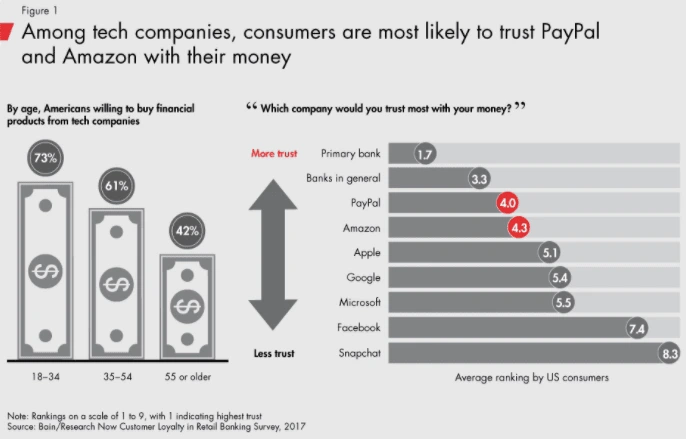
(Source: Bain & Company)
These companies are highly skilled at providing a level of fast, easy service that’s hard for regular banks to match. Tech companies have been honing their customer experience skills for years, and now they can apply it to financial services. Banks are being held to those standards and it’s getting tougher and tougher to keep up. You’re not only competing with the myriad of other banks — now you’re competing with tech giants too.
That’s why focusing on CX and providing a superior banking experience is so crucial for financial institutions, big or small. CX is often one of the few ways you can differentiate yourself from competitors. Even if your product can’t quite compete with other companies, offering a seamless and supportive experience can keep customers happy and coming back.
8 ways to improve CX in banking
Improving the customer experience will take persistence and a multipronged approach. Here are eight things you can focus on to improve customer experience in banking.
1. Look at it from the customer’s point of view
This probably seems obvious, but it can’t be overstated. Often what companies think they need to do to improve customer experience is quite different from what their own customers would actually like to see improved.
Instead of looking internally to better your CX, dig in to your customers’ opinions. This can take a few different forms, the best one being talking directly to customers.
- Consider setting up a customer advisory board. A CAB will give you consistent access to a set of voices that can provide the external insight you need.
- Regularly employ customer surveys after various transactions to get a sense of how seamless (or not) each transaction or service is.
- Map your customer journeys. Financial institutions will have a lot of different customer journeys to account for, but give each one the time it deserves. Walking the path that your customers take is the only way to really understand their pain points.
2. Get the C-suite to commit
In order to find success with your CX initiatives, you’ll need full buy-in from the higher-ups. Improving customer experience at your financial institution will likely lead to big changes in your current system, products and processes. Without support from senior leaders, it will be hard to see true change in your organization.
Make sure leadership is involved in CX improvement plans from the very beginning. When your executives participate, lead by example and show that it’s a priority, the rest of your organization will start to embrace the new changes.
3. Establish a dedicated CX team
Rather than having one simple plan to improve CX, you’ll need a variety of strategies that involve people from all departments of your bank. Pull together a team of stakeholders from across your business to help manage customer experience improvement.
You’ll need their insight into their specialties, and they’ll operate as the point person for CX efforts in their department. A diverse team can bridge the gap between the different services your bank offers as well as silos that can arise from having multiple locations, possibly spread across the country. Depending on the scale of your customer experience initiatives, it may even make sense for your bank to bring in a dedicated CX role to head up this team.
4. Offer unique services
While this is arguably one of the more difficult aspects of providing an exceptional customer experience, having a product or service that truly sets you apart from competitors can be invaluable.
Look to leaders in the industry for ideas on innovative digital services. Bank of America attracts customers with access to its free virtual financial assistant, Erica, that helps people with everything from checking credit scores to bill payment reminders. Spanish bank BBVA’s app offers Bconomy, which helps customers track their finances and work toward a savings goal.
All banks have apps, but going above and beyond the basics to identify tools that really help people will make for a meaningful customer experience. Evaluate how your bank can address customers’ financial health holistically, rather than focusing on a single service at a time.
5. Balance digital and human service
While it is true that consumers now expect effortless digital services from their bank, you can’t rule out the importance of having humans readily available for customer support. You’ll need to find the right balance of the two.
Balance your digital initiatives with a strong commitment to personal customer service. People love to do things online, but if they hit a snag or have a complex problem and there’s no phone number where they can easily reach someone for help, it makes your organization seem untrustworthy. Being able to quickly get through to a friendly, helpful representative will be a huge boost to your customers’ banking experience.
6. Scale your efforts
One of the hardest parts of customer experience is getting your entire organization — every location — to deliver on new CX efforts in a consistent, sustainable way. Being able to successfully scale your customer experience is key for the health of your bank.
With your dedicated CX team, you’ll want to create a plan of attack for business-wide adoption. Look at which initiatives are doing well in which departments and analyze how you can apply or translate those successes to other departments. Learning from specific failures and successes, you can begin to apply changes to larger parts of your organization until the bank as a whole is compliant with updated customer experience standards.
7. Keep your brand consistent
Brand consistency bolsters CX efforts by guaranteeing your customers are always interacting with a familiar company. When your brand always looks and sounds the same — e.g., your design, voice, tone and messaging is consistent — your customers know what to expect. They’ll be comfortable with your brand, and you’ll see brand loyalty from them in return.
Brand templating will help keep your brand consistent across departments and locations. Making customizable design templates available to your company will ensure that each branch stays on-brand and uses approved logos, colors, assets, etc. It also cuts down on off-brand and one-off creations that don’t reflect your organization’s brand style. Templates can range from flyers and brochures to social media posts, emails, presentations and more.
Presenting a unified front to your customers will both bolster CX efforts and help strengthen your brand.
8. Follow up
Customer experience is something you’ll have to continually revisit. What customers want and expect from a financial institution will evolve over time. And once you improve one thing, something else will pop up that could be better too — that’s just the nature of business. Plus, CX improvement often isn’t a straightforward, linear process. There’s going to be trial and error, and you’ll need to keep at it to find the right solutions for your bank.
Just like you set goals and OKRs for each quarter and year, you’ll want to do the same for customer experience. Make CX a focus in all of your strategy plans and hold people accountable in the same way you do for financial goals.
Dedication to leveling-up your customer experience will pay off in happy customers who are more likely to stick with your bank and recommend your services to friends. For more tips on improving CX and creating personalized experiences for your customers, check out our free guide How to avoid CX failure and empower your team to become your greatest CX asset.
As a non-profit organization, your brand isn’t just a logo or text. It’s a symbol and a feeling — one that resembles hope, inspiration or kindness.
For your program participants, non-profit branding is often associated with the experiences they have while enrolled in your program. For your volunteers and donors, your brand is deeply connected to the feeling they get from giving back to the community and to others in need.
To that end, non-profit branding and its image are synonymous with a mission and message because the brand doesn’t just serve the non-profit — it serves communities, too.
For instance, when people see your logo or branding, whether you’re a YMCA or a garden project non-profit, you want them to remember what you’re working towards and call on you to help or be helped.
Why does non-profit branding matter?
Just as financial or food insecurity can prohibit growth, brand insecurity can have a similar impact. Writing grants and fundraising takes time, money and energy. Not only that, but it also requires you to tell a story, one of which you may not have the luxury of iterating again and again. But, if you find yourself worried that your non-profit is missing critical (and digital) fundraising opportunities, you’re not alone — 66% percent of charities share that concern.
However, a strong brand helps tell a non-profit’s story.
To quote the folks of Stanford Social Innovation Review, “a brand is a psychological construct held in the minds of all those aware of the branded product, person, organization, or movement. Brand management is the work of managing these psychological associations. In the for-profit world, marketing professionals talk of creating ‘a total brand experience.’ In the non-profit world, executives talk more about their ‘global identity’ and the ‘what and why’ of their organizations. But the point in both cases is to take branding far beyond the logo.”
So in sum, there are two core components a strong non-profit brand can lend a hand in:
- Fundraising
- Identity
For many non-profits, these two components are inextricably linked. The stronger presence and identity you possess, the more likely people are to donate money. And the more money you can accrue, the more you can build your brand presence.
By building a brand, you extend your capacity and reach. But, how do you do that when you’re already strapped for resources and time?
How to build your non-profit brand
First, let’s address the elephant in the room.
The work you’re about to do (i.e., brand building) might sound counterintuitive, but it’s not. Take a minute and remember that your non-profit brand experience contributes to your collective community effort, which in turn empowers you to build a brand that lasts.
Maintain long-term brand authenticity
Whether your non-profit is well-established or relatively new, you must maintain long-term authenticity for branding to be effective.
Authenticity, while a relatively played out terminology, is a critical component to ensuring your non-profit messaging can stand the test of time and resonates with donors, program participants and volunteers. Authenticity can manifest itself in many forms, for example:
- Embracing your non-profit’s uniqueness.
- Transparent communications about fundraising and other processes.
- The act of gathering feedback from donors, constituents and community members.
- Owning up to mistakes or shortcomings.
Evaluate your current impact
Having a clear, measurable impact translates into a clear, memorable experience, as well as more donations or grant opportunities. So, start building your brand strategy by evaluating your impact effectiveness.
To do so, ask yourself, board members and core staff:
- Is our impact claim clear?
- Is it easy to understand why my non-profit matters? Do donors, program participants or volunteers clearly understand what we’re working toward?
- Or is it something that’s hard to define or articulate?
- Are our brand values well defined?
- Do our brand values reflect our mission?
- Do we properly understand our target demographics?
- Have we created personas that articulate our target audiences?
- Are our current donors and volunteers a reflection of our target audiences?
- Are we appropriately tracking existing marketing strategies?
- Do we use software and tech platforms that empower us or prohibit us from measuring our impact?
While this might be a time-consuming task at first glance, answering each of these questions ensures your organization has an appropriate and solid foundation from which to build your brand strategy from. To learn more about basic marketing strategies for non-profit organizations, check out our comprehensive (but approachable, we swear) blog post.
Make a statement
There are two statements worth making — a brand positioning statement and a value statement.
As we mentioned in one of our previous blog posts, “a brand positioning statement is a short and concise description that sums up your brand. It includes:
- Your brand promise
- Your category or market
- Your customer base
- A high-level description of benefits
- Who you are”
Whereas a value statement (or proposition) “should describe beneficial features of your product, services, strategy or approach.”
Keep in mind, both your brand positioning statement and value proposition are not intended to be used or seen by folks outside of your immediate organization. Both are intended to serve as a north star for branded content creation. Whether you’re writing a grant or creating new program collateral, leveraging these two statements can help content stay on-mission and helpful.
Be consistent
We can’t stress this one enough. Being consistent is your key to unlocking access to new donors, volunteers and program participants. To be consistent is to be recognized. Because being consistent not only helps set the stage for future content creation, but it also helps ensure your message is understood loud and clear.
Consistency can mean a lot of things. For example, consistency is:
- Making sure your logo isn’t pixelated, warped or distorted and is always used correctly.
- Ensuring that your marketing materials are written in the same voice and tone.
- The use of on-brand, professional stock photos that reflect your mission and target audience.
Streamline and templatize
Making do with very little is the M.O. for most in the non-profit sector, so it makes sense to streamline, templatize and craft easy-to-duplicate (or copy and paste) content wherever possible. While it might feel redundant, empowering colleagues with cut-and-paste (with some customizable flair) content ensures that collateral and messaging stays true to your north star mission.


(Screenshots are from the Philanthropy report template found in the Lucidpress gallery)
Do your non-profit branding justice
Your brand, and more importantly your community, deserves a proper foundation from which you — and your colleagues — can build out from. Doing so not only ensures your ability to successfully create content in the future but it also ensures you remain visible, consistent and memorable to your target audiences. Regardless of whether or not these folks are donors, volunteers or program participants. To learn more about how to specifically create a consistent brand story from touchpoint to touchpoint, check out our ebook on nonprofit messaging and how to make do with very little.
Editor’s note: Originally, the Lucidpress blog featured two different blog posts that highlighted two eras — past and present — of Black graphic designers. In an effort to ensure the post accurately reflects the folks featured in it and to honor the need for diverse representation in graphic design, we have combined the two blog posts into one and audited them with up-to-date information.
At Lucidpress, we’re passionate about great design and inspiring everyone to create beautiful things. So we’re delighted to bring you this list of influential Black designers, reaching back to the beginning of the 1900s and continuing up to the present day. Let’s dive in!
Charles Dawson
We start with Charles Dawson, who was born in 1899. He became well-known in the 1920s-30s for his illustrated advertisements, especially for beauty products and Black artists. Unsurprisingly, his journey includes many firsts which paved the way for students after him to pursue their passions.
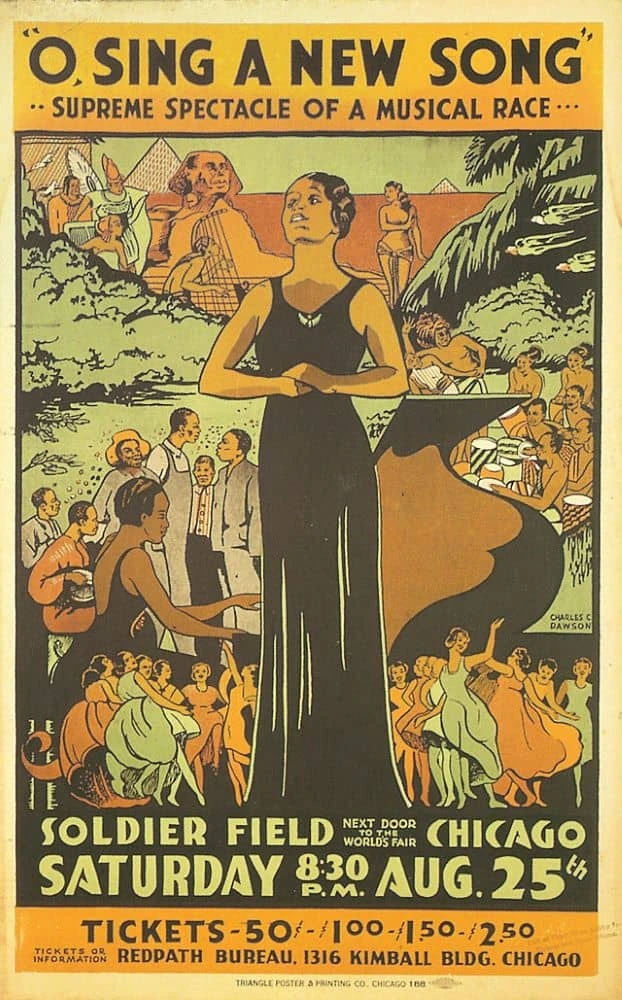
“O Sing A New Song” musical poster
In 1907, Dawson was the first Black student admitted to the Art Students League in New York. It was a challenging environment where he faced many instances of bias and discrimination. In 1912, he took the summer to work in a buffet car and save tuition for the Art Institute of Chicago, which he observed was “bias-free.” An active student, Dawson was involved in several jobs and student organizations. He was a founding member of the Arts and Letters Society, the first Black artist collective in Chicago.
Dawson started working for Chicago Engravers in 1919 and departed three years later to become a freelance designer. With fellow alumni from the Institute, he established the Chicago Art League, an exhibit group for Black artists. Throughout his career, he would break more barriers:
- In 1927, his Negro in Art Week exhibition at the Art Institute of Chicago was the first show of African-American art at a major American museum.
- In 1934, he was the only Black artist with a substantial role in the Century of Progress Fair. His illustrated mural of the Great Migration was displayed by the National Urban League in the Hall of Social Science.
For much of the 1930s, Dawson worked for Valmour Products. In 1944, he became the curator for both the Museum of Negro Art & Culture and the George Washington Carver Museum, where he served until his retirement in 1951.
Learn more about Charles Dawson at AIGA.org.
Aaron Douglas
Aaron Douglas was also born in 1899, but his contributions to the Harlem Renaissance (then called the “New Negro Movement”) helped to propel the art style forward. He blended the geometric shapes of Art Deco, the linear rhythm of Art Nouveau, and the rich traditions of African art to create something entirely new.

“Aspects of Negro Life” mural
Graduating with a BFA from the University of Nebraska in 1922, Douglas taught art in Nebraska and Missouri high schools. In 1924, he moved to New York to apprentice for Winold Reiss. After designing magazine covers for Opportunity, The Crisis, FIRE!!, and Harlem, he became a highly sought-after cover illustrator, especially among Black writers.
Douglas continued to shape the Harlem community, crafting several murals including the famous Aspects of Negro Life. In 1938, he moved to Nashville, Tennessee, to found the art department at Fisk University—a department he chaired for nearly three decades before retiring in 1966.
Learn more about Aaron Douglas at AIGA.org.
LeRoy Winbush
We jump forward a few years to LeRoy Winbush, who was born in 1915. His ambition might be summarized best this way: though it took him 11 years to be accepted as the first Black member of the Art Directors Club of Chicago, it took him only five more to become its president.
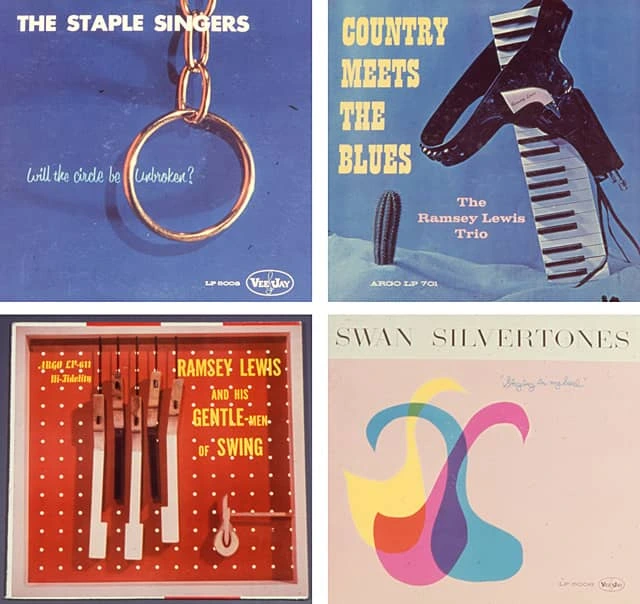
Album cover designs
Winbush started designing in 1936, merely one year after high school. He apprenticed making signage, murals and flyers. When he joined the sign shop at Goldblatt’s department store, he was the only Black employee. Seven years later, he was the company’s Art Director, overseeing a staff of 60 people.
In 1945, he founded Winbush Associates, his own design firm. Colleagues say he split his day between art-directing for Consolidated Manufacturing Company and for Johnson Publishing (Ebony, Jet). His career spanned many highlights:
- In 1959, he was the chairman for the International Design Conference in Aspen.
- In 1964, he helped design Illinois’ exhibit for the World’s Fair, including an animatronic Abe Lincoln that became the prototype for Disney’s Hall of Presidents.
- In 1985, he helped design an underwater coral reef in the Living Seas pavilion at EPCOT.
Winbush also gave back to his community through education. Despite having no formal education himself, he taught visual communication at School of the Art Institute of Chicago. He also developed a long-term exhibit about sickle-cell anemia for Chicago’s Museum of Science.
Learn more about LeRoy Winbush at AIGA.org.
Thomas Miller
Thomas Miller was born in 1920. When he graduated from the Ray-Vogue College of Design in 1950, he was the institution’s only Black student. Soon afterwards, he was one of two to be accepted into the Society of Typographic Art.

Founder’s mosaic at DuSable Museum of African American History
Miller enjoyed decades as a successful commercial designer. After working for Gerstel/Loeff, he joined the international design firm Morton Goldsholl Associates, where he worked for 35 years on large ad campaigns, such as 7-Up’s major redesign in the 1970s.
When he wasn’t working, Miller still followed his own artistic passions, creating oil paintings and monotypes in his signature style. One of his most well-known projects can be seen today in the DuSable Museum of African American History: he created mosaic portraits of the museum’s eight founders.
Learn more about Thomas Miller at The History Makers and Wikipedia.
Emmett McBain
A graduate of the Illinois Institute of Technology, Emmett McBain (born in 1935) also studied at the Ray-Vogue College of Design as well as the American Academy of Art. He became a designer for Vince Cullers and Associates, the first Black-owned ad agency. But that wouldn’t be the last time he was a pioneer in African-American advertising.
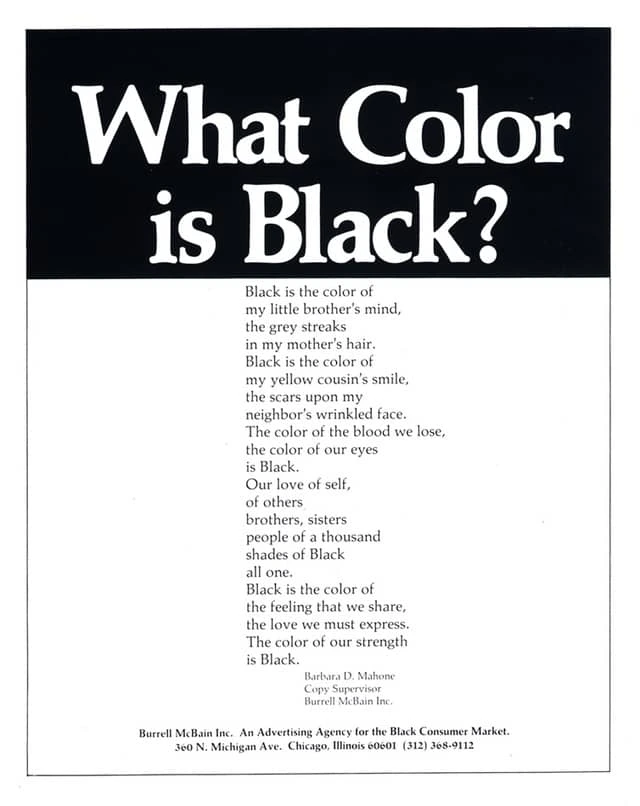
“What Color is Black?” poem advertisement
McBain enjoyed a varied design career, from being Playboy’s promotional art director to designing album covers for Mercury Records. He worked for J. Walter Thompson and Associates, where he took part in Ford’s 1964 campaign to introduce the Mustang.
In 1971, McBain partnered with Tom Burrell to form Burrell McBain Inc. This ad agency pioneered advertising to African-American markets and introduced corporations to the concept that “Black people are not dark-skinned white people.” Their campaigns recognized and emphasized the demographic and cultural differences that had been previously ignored in mass media. Though the agency is still around today as Burrell Communications Group, McBain left in 1974 to pursue art and support Black artistry.
Learn more about Emmett McBain in this NewCity article.
Archie Boston
In one of his most famous ads, Archie Boston leans over a table of pens and eyes the camera. “I told Pentel what to do with their pens,” the headline declares. “And they did it.” It’s a single example plucked from Boston’s long career of self-aware, provocative work.
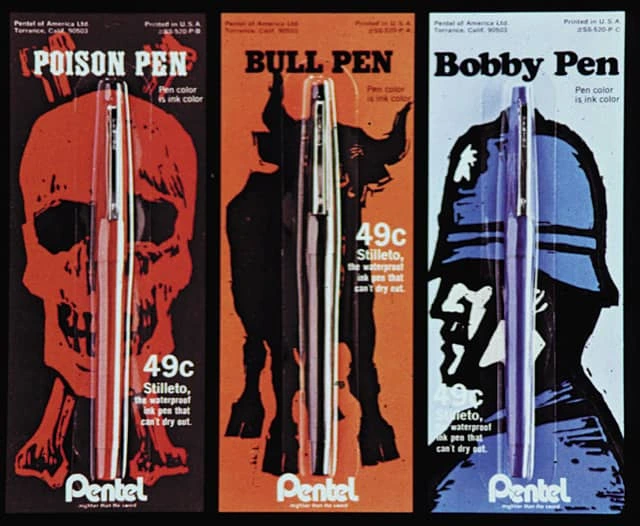
Pentel packaging designs
Born in 1943, Boston attended Chouinard Art Institute (later called CalArts) in 1961—and nearly dropped out to take a job in advertising. Instead, he took an internship at Carson/Roberts during his senior year. After working with his brother Brad on a variety of projects, the two founded Boston & Boston design in 1967. They never shied away from race in their work, opting instead to acknowledge it directly and challenge audiences to rethink their assumptions and prejudices.
In 1969, Archie joined Botsford Constantine and McCarthy for eight years. During his time there, he also founded Archie Boston Graphic Design and began taking clients in 1973. Later he became the first Black president of the Los Angeles Art Directors Club.
From his 20s onward, Archie has been a teacher. He started at Chouinard, and currently he’s a professor at California State University Long Beach (CSULB), where he’s taught for nearly 40 years.
Learn more about Archie Boston at AIGA.org.
Sylvia Harris
The first female designer on our list, Sylvia Harris was born in 1953. She earned her BFA in communication arts and design from Virginia Commonwealth University, and her MFA in graphic design from Yale University.

Exhibit design for The Women’s Museum
Harris spent much of her career in the public sector, planning and improving the communities around her. She started as a designer for WGBH, Boston’s public TV station. From there she moved on to The Architects Collaborative (TAC) headed by Walter Gropius, and then the prestigious Skidmore, Owings and Merrill (SOM). It was at SOM that Harris got involved in environmental urban planning; her clients there included the Massachusetts Bay Transit Authority and the U.S. Department of Transportation.
In 1980, along with two partners, Harris founded Two Twelve Associates, a graphic design consulting firm. She worked on projects for many clients, including the New York State Council of the Arts, Port Authority of New York and New Jersey, and the Central Park Zoo. She also taught design students at Purchase College State University and at Yale.
Learn more about Sylvia Harris at AIGA.org.
Gail Anderson
Gail Anderson was born in 1962 and studied at the School of Visual Arts in New York. The art of words and letters have played a major role in her design career, starting from the beginning when she worked at Vintage Books and The Boston Globe Sunday Magazine. As an expert in conceptual typography, she works with all sorts of materials—traditional and non-traditional—to create eclectic expressions of style.
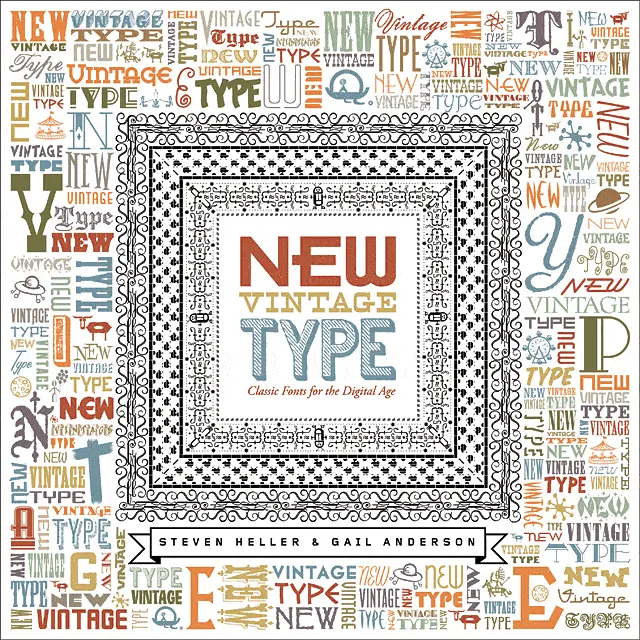
“New Vintage Type” book cover
Anderson was an impressive fixture at Rolling Stone Magazine for 15 years. Starting as an associate in 1987, she rose to become its Senior Art Director before departing in 2002. From there, she joined SpotCo, one of New York’s largest entertainment design agencies. Again, she rose to the top to become its Creative Director before departing in 2010.
Residents of New York City are likely familiar with Anderson’s work without even realizing it. Her poster designs for Broadway and off-Broadway plays have been hung all around the city and featured in outdoor transit advertising.
Currently, Anderson is a partner at Anderson Newton Design with Joe Newton. She’s also a faculty member at the School of Visual Arts, and she’s co-published several books on typography and graphic design.
Learn more about Gail Anderson at AIGA.org.
Eddie Opara
Born in England in 1972, Eddie Opara studied at the London College of Printing and at Yale University. After earning his MFA in 1997, he moved to New York City to work for Imaginary Forces.
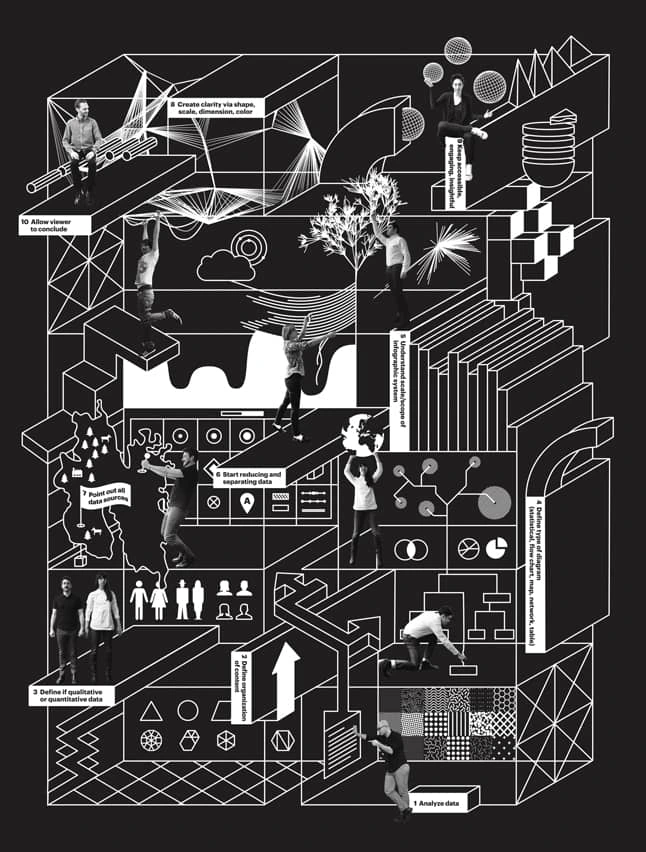
Infographic about infographics for Fast Co.
It wasn’t too long after that when Opara became the Art Director for 2 x 4, the influential design studio. In 2005, he founded his own interactive design studio, The Map Office, in New York and began work for clients such as the Studio Museum in Harlem, the Architecture Research Office, the Queen Museum of Art, and New York University. In 2010, Opara joined Pentagram as a partner.
Opara’s work sits at the intersection of design and technology. He has earned numerous awards in his career, including a Gold Cube from the Art Directors Club. His work is the permanent collection of the Museum of Modern Art (MoMA). In 2012 and 2014, he was named one of Fast Company‘s 100 Most Creative People in Business. Today, he’s also a senior critic at Yale.
Learn more about Eddie Opara at Famous Graphic Designers.
Michele Washington
Michele Washington, who studied at the School of Visual Arts and Brooklyn’s Pratt Institute before working for Vogue Butterick Patterns. Her career in media is wide-ranging, from newspaper design at the Chicago Tribune and The New York Times to editorial art direction at Essence and Self magazines.
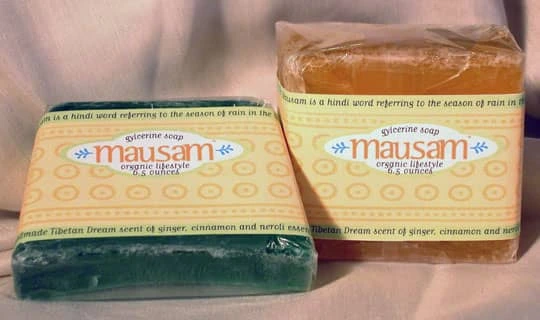
Mausam product packaging designs
Washington has taught a grad-level exhibition class at New York’s Fashion Institute of Technology (FIT). She founded and leads her own design firm, Washington Design, in Brooklyn’s DUMBO neighborhood. Today she also provides creative direction for Cox Matthews Associates and user research for Cerebral Design.
Multi-cultural influences abound in Washington’s work, as her colorful designs often incorporate language, patterns, and textures from many cultures around the world. One example is the bright and earthy product packaging for her line of natural home & body products. Many of her design influences are featured in articles she’s written for her website, CulturalBoundaries.com.
Learn more about Michele Washington at AIGA.org.
Dana James Mwangi
“Creatives can do good business.” That’s the headline on Mwangi’s website , and this mantra captures her holistic approach to web design, branding & entrepreneurship.
If you’re worried you’re not creative enough, or your ideas are just too far-fetched to work, Mwangi has something to say about that — her words are inspiring and certainly ring true if you work in design or any creative field.
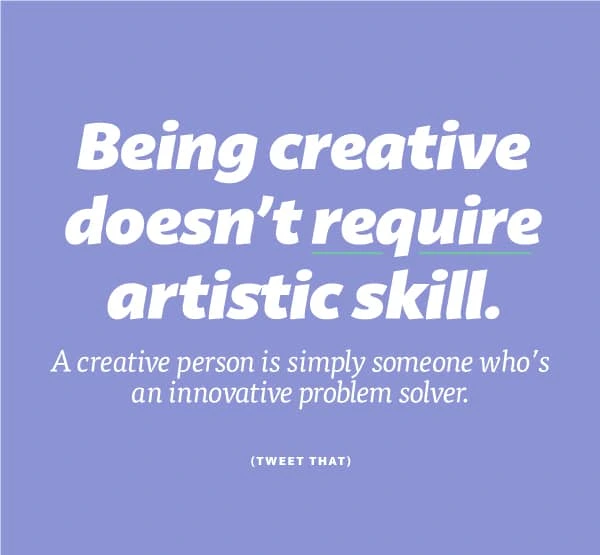
@danajamesmwangi | @cheerscreative
Timothy J. Hykes
Tim Hykes is a UX consultant and frequent speaker at design conferences including Adobe Max, Design + Diversity, and AIGA. In fact, he’s become a leader in AIGA, the largest community of design advocates in the nation.
He’s also a co-founder of the Design + Diversity conference. “The Design + Diversity conference explores proactive ways to make the design industry more diverse…This is the only conference that focuses on diversity issues in the design field. This event provides a platform for constructive conversation among those who design, innovate, and lead.”
@timothyhykes | @plusdiversity
Hassan Rahim
A self-taught artist and designer, Hassan Rahim has developed an enigmatic style and dark sensibility that’s landed him work with clients like Nike, Urban Outfitters, Warp Records, and Marilyn Manson. According to an interview with Eye on Design, his big break came when a skate brand noticed his designs on MySpace and reached out to offer him work. He was 17 years old.
Antionette Carroll
Antionette Carroll sees design differently. In a world where everything has been designed—including systems of inequality—we can use design as a system to create a more equitable world. In her powerful TEDx talk (Carroll is a 2018 TED fellow), she introduces this concept and challenges us to find ways to intentionally redesign our communities.
In line with this mission, Carroll founded the Creative Reaction Lab, a nonprofit that “educates, trains, and challenges cities to co-create solutions with Black and Latinx populations to design healthy and racially equitable communities.” She calls this new form of creative problem-solving Equity-Centered Community Design.
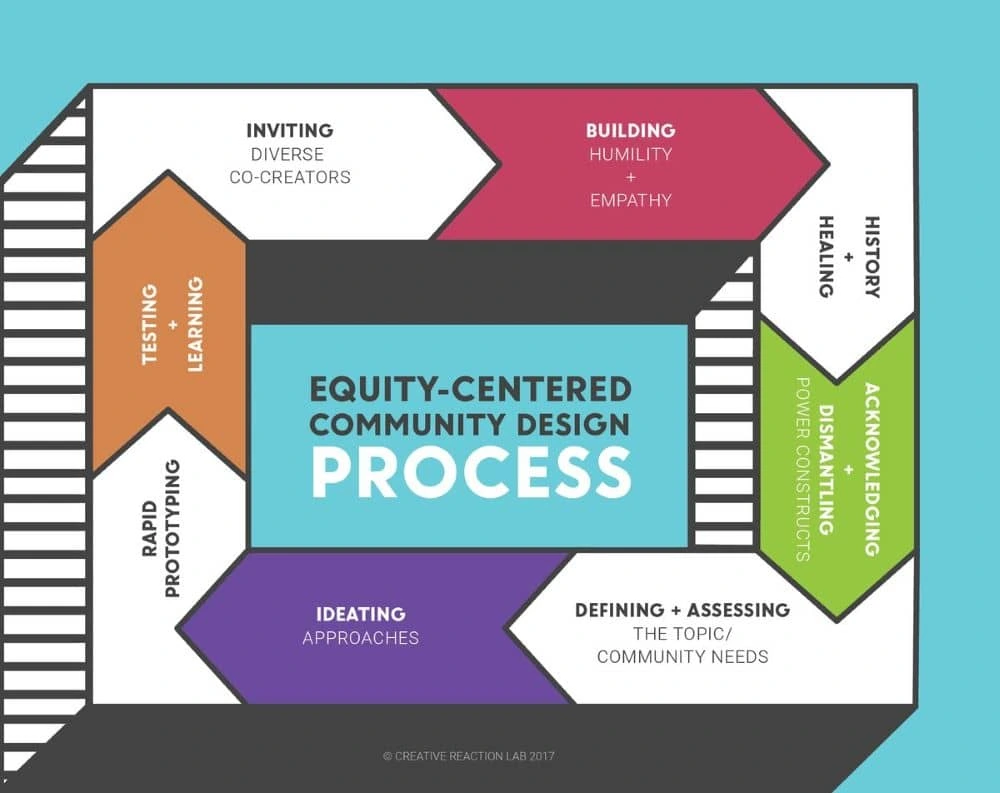
Currently, Carroll is an AIGA National Board Member. Along with Timothy J. Hykes (who we introduced earlier in this list), she’s also a co-founder of the Design + Diversity Conference.
Jewel Burks
Jewel Burks has the distinction of working for and partnering with some of the biggest brands in the tech industry, from Google and Amazon to Collab Capital. Even more impressive is the fact that she founded and sold a tech startup called Partpic, a program that uses visual search algorithms to streamline the purchasing of manufacturing parts.
Burks is currently a board member for Goodie Nation, a nonprofit that supports innovative problem-solving in underserved communities. “The big thing I want in starting a business is to make a difference in my community,” she says on her website. As one of Forbes’ 30 Under 30, she’s off to an incredible start.
Nakita M. Pope
Nakita M. Pope is an experienced branding strategist with nearly 20 years in the industry. She holds the fabulous title of Chief Chick at Branding Chicks, her boutique branding agency. Branding Chicks specializes in women-owned businesses and female-centric brands. She works with them to narrow their focus, boost their confidence, and clarify their messaging so it resonates with their audience.
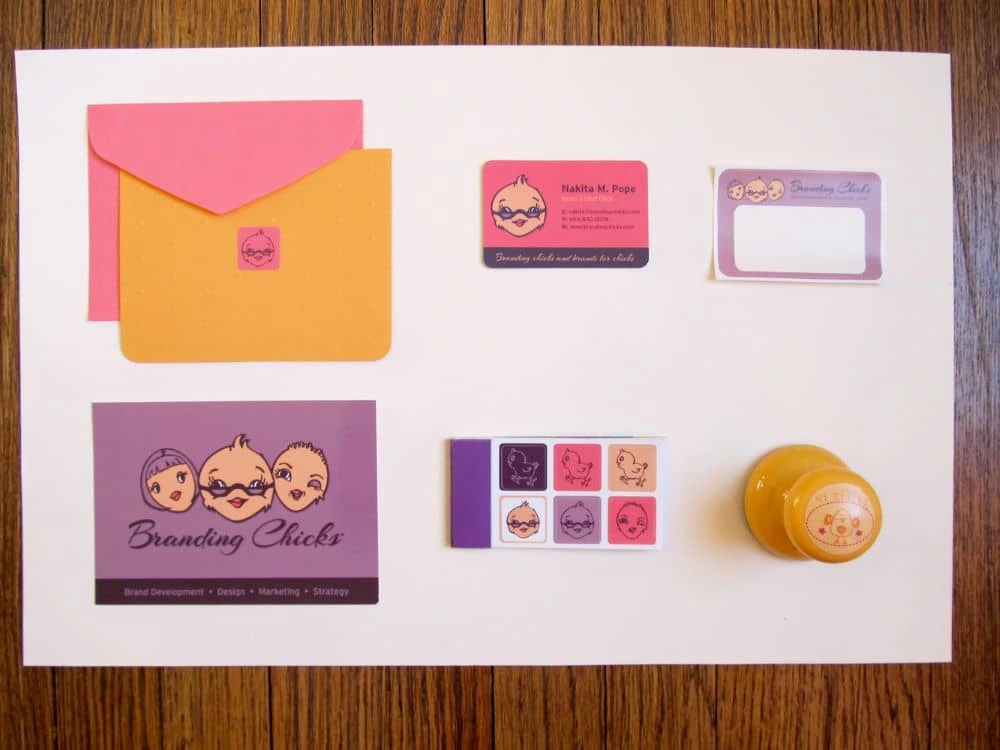
Pope is currently a diversity and inclusion officer for The Creative Circus, an advertising school where students can build their portfolios. She’s also a board member of AIGA Atlanta and a member of the AIGA National Diversity & Inclusion Task Force.
“I love the strategy of design. I love how designers think and solve problems visually,” she says in an interview with 28 black Designers. “As I’ve morphed into a brand strategist, I realize just how much strategy I was already doing as a designer and how that is what makes the difference between design that is simply aesthetically pleasing and design that is smart and achieves an objective.”
@brandingchicks | @realbrandingchicks
Dian Holton
Dian Holton is the Deputy Art Director for AARP. When she isn’t designing and overseeing creative work there—such as AARP’s The Magazine and TheGirlfriend—she also creates compelling window displays and mannequin styles for The Gap. Her vibrant, fresh design sensibility makes her portfolio (and her social media feeds) a visual delight.
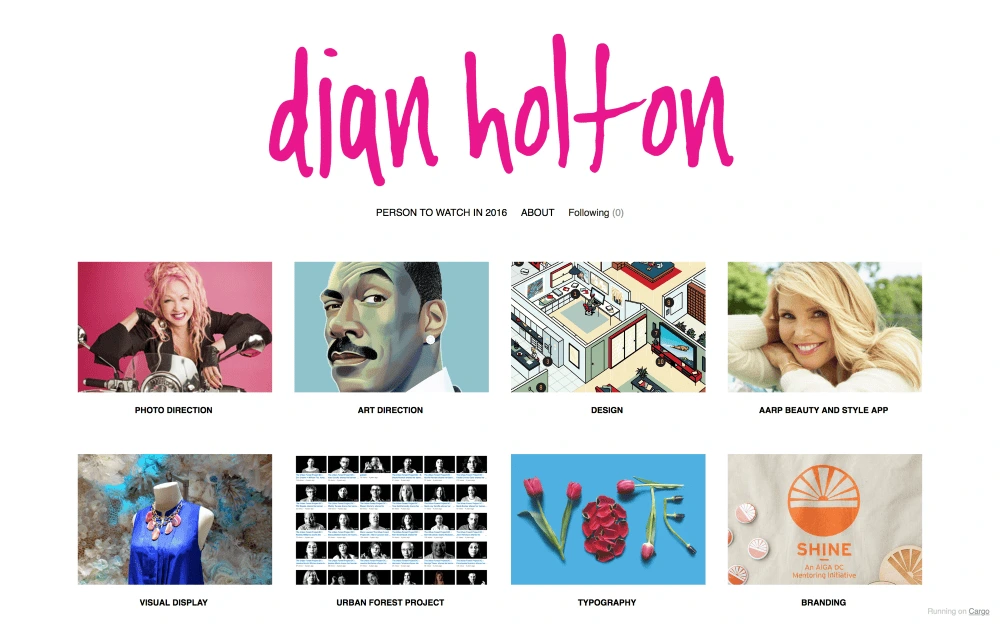
A graduate of the Yale School of Management, Holton serves as the Mentoring Director for AIGA’s Washington, D.C. chapter, where she oversees a mentoring speaker series with a local high school.

A post shared by Dian Holton (@dianholton) on Feb 1, 2018 at 8:52pm PST
Check out Holton’s awesome Daily Digits series, where she photographs numbers made of daily objects (like flowers, hairpins and gummy worms). The project just surpassed 1,000 posts, and we can’t wait to see what’s next.
Wrap-up
This is only a handful of the incredible Black designers who’ve shaped our visual culture and continue to influence it today. It’s important to recognize not only their talent but their determination to overcome any obstacles and pave the way for future designers. Major thanks to the AIGA for being an invaluable resource in researching this post. Another round of gratitude for the African American Graphic Designers group on Facebook for being a constant source of inspiration and for introducing me to many of the folks on this list.
Advertising is more than just a brand function—it’s a valuable skill. Not all people have the talent, timing and savvy to speak to people in a way that influences their lifestyle. Fortunately, the knack for advertising and marketing can be learned.
There are many different forms of advertising that brands can use to reach their target markets. However, not all forms of advertising will have the same impact. Technology trends have shifted the game. Today, brand managers can drive tremendous impact by prioritizing social media.
But before you get into the specifics of social media marketing, you must first learn the basics of advertising. Here are some advertising do’s and don’ts for beginners.
The do’s: Helpful advertising tips to help you connect with an audience
Get to know your target customers
Many companies only have a big-picture view of the target market they want to reach. While this is a good starting point, it pays to refine your understanding of prospective customers. What is the age bracket of the people you want to reach? Are your prospects still studying, seeking career opportunities, employed or retired? What types of entertainment do they usually spend their time and money on? These aspects are vital if you want to make an impact that will truly resonate with your desired audience.
By knowing what makes your customers tick, you have leverage to connect with them and understand how to best fulfill their needs.
Strive to have a consistent voice & message
While it’s true you can have an impact by being unpredictable, you build up a stronger following by being consistent. By having a singular purpose and consistent voice, you increase brand recognition and loyalty. Stick to the vision and mission of your business, and soon, people will recognize your brand across every advertising channel you use.
Be accessible & proactive
People are more likely to trust a brand if they’re confident they can reach you whenever they need to. No wonder nearly every business has social media profiles now. Through sites like Facebook, Twitter and Pinterest, you have a direct line to your customers.
The question is: will people hear back from your company when they tag, message or tweet you?
If you’re strapped for resources, hire a virtual assistant to help your brand stay accessible and proactive not just on social media but also through email and comments on your blog or website.
The don’ts: Pitfalls your brand should avoid
Failing to craft a call-to-action
Share this message if you agree. Email this tip to a friend. Tap ‘like’ if you enjoyed this video. These are just a few of the calls-to-action that social media users have grown familiar with, and that’s because they work. Each communication you share with your audience should be geared towards building your relationship and, ultimately, moving them down the conversion funnel. At the end of any ad campaign, make sure your audience knows what to do next.
Jumping on every advertising fad that comes along
Many advertising gimmicks have come and gone, but how many of these have really helped the brands who tried them? Just because a tool, fad or practice is creating some noise doesn’t mean you should immediately jump in. When a new trendy tactic tempts you, scrutinize how it will genuinely reach your customers and build your brand. This goes back to the principle of knowing your target audience better. If you truly know what makes them tick, you won’t be jumping on every bandwagon that rolls by. Just the ones that matter.
Making an impact isn’t exclusively for big brands. Keep in mind these advertising dos and don’ts for beginners, and you will soon carve out your own niche.
How to use PPC to amplify your brand
As you know, effective branding amplifies brand awareness and recognition. It builds trust. It helps generate new customers. Best of all, it increases sales and revenue.
But, did you know that even the briefest exposure to a brand can affect a customer’s behavior? It’s true. You have the opportunity to shape customers’ opinions of your brand in every interaction—even if that interaction only lasts a couple of seconds, like a pay-per-click ad.
Why branding is important
To set the scene, let’s take a look at why branding matters in the first place.
Researchers at Duke University determined how powerful brands can be. In one of their tests, a group of university students was exposed to the Apple logo. It was flashed so quickly that respondents weren’t even aware they were exposed to it. Another group was exposed to the IBM logo in the same manner.
Both groups were asked to list down all of the possible uses for a brick. Here’s where it gets fascinating: Participants who had a brief glimpse of the Apple logo were found to be more creative when compared to the IBM group.
Here’s another one. Researchers wanted to know how brands affect respondents’ honesty. In the next experiment, two separate groups were exposed to the Disney and E! logos, respectively. They found that participants who saw the Disney logo behaved more honestly compared to those who saw the E! logo.
What does this tell marketers? Brands are deeply influential. For established brands (like Apple and Disney), it could mean investing more in product placement and other methods of exposure. For growing brands, it means paying attention to every touchpoint, no matter how brief.
For example, your PPC campaigns.
How to use pay-per-click to enhance your brand
Known as PPC, pay-per-click campaigns are a great way to amplify your product or service. But, when done deliberately, PPC can also help you amplify your brand message. Here are a few techniques you can use to optimize your PPC campaigns for brand awareness.
Optimizing your ad’s exposure
- Use location targeting
Personalization refers to the process of adjusting content to match customers’ needs and preferences. More brands are putting extra effort into their personalization efforts, and chances are, your brand is already implementing a similar strategy. But, have you considered adding some personalization to your PPC ad copy?
For instance, you can customize ad copy and sitelinks based on your customers’ geographical locations. Let’s say you’re trying to make an ad for New York shoppers. In the ad, you can place sitelinks like the address of your store or products that are popular in New York. (Don’t forget to add call and location extensions—they shorten the conversion cycle.)
Divide target audience into groups you want to personalize. Next, create ads based on those groups’ preferences. Since the ads are location-based, consumers from other parts of the country or the world will not see the same content as those from New York. It’s an easy way to make your ad appear more relevant to the user.
- Select specific sitelinks
Which sitelinks do you often use in your ads? What you choose to promote can either benefit your campaign or hurt it. If you plan on advertising to a specific audience, don’t give them a general sitelink that isn’t relevant or interesting to them.
For example, Clinique organizes their ads according to the different stages of the buying cycle. This way, each ad caters to more specific needs.
Clinique used “Shop Makeup” on their ad for customers who only intend to buy makeup. They added “New Arrivals” for visitors who might be interested in more products. For prospective buyers, the brand offered a “Top Selling Skincare” sitelink, making it easier for visitors to evaluate their products. They then offered a discount on first purchases to sweeten the deal.
Building trust in your brand
Most of the time, PPC marketers create ads that are designed for conversion. But, what about visitors who aren’t ready to buy? What about consumers who want to know more about the brand before supporting it? Content marketing is great at building trust—and PPC campaigns are fantastic at delivering that content to target audiences.
- Use long-tail keywords
The long-tail keywords you use in your content marketing can also be used in your PPC campaigns. You can promote high-value content by using them as ads that match consumers’ search queries.
For instance, if you have makeup tutorials, you can create ads for queries like “how to apply foundation.” L’Oréal is one brand that practices this.
Googling “how to apply foundation” leads to a L’Oréal ad with the same keyword phrase. By providing content that consumers need, the company builds a reputation as an expert in the field. Consequently, they gain the consumers’ trust, which will lead to conversions down the road.
- Keep track of your reputation
Customers seek out the pros and cons of different brands before supporting them. Though your efforts to gain their trust are strong, a few negative remarks could be enough to drive them away.
So, what can you do about it?
Through your PPC campaigns, you can protect and maintain your brand’s reputation. By keeping track of search query reports (SQR), you can identify a rise in negative trends. You can then share this information with the marketing team and devise a strategy to deal with negative reviews and comments.
Key takeaway
PPC is a great platform for brand-building. Not only does it empower you to shape your brand’s story, it exposes large audiences to your message on-demand. [] Take advantage of this powerful medium and show the world what your brand is made of.
5 design bottlenecks in PPC advertising & how to prevent them
If you’re like most PPC advertisers, you’d rather not touch Adobe Photoshop with a ten-foot pole. There is a good chance that slaving away in Google AdWords or figuring out multi-touch attribution models sounds like more fun. But graphic design? No way.
In my younger PPC days when search campaigns were my only concern, I was the same way. I never expected that designing a marketing graphic would be an appropriate use of my time. That’s why we hire graphic designers, right?
Related: 4 ways to increase conversions with visual content
But PPC is much more than standard text ads showing up on a search engine results page. There are paid-social ads on Facebook and LinkedIn, display campaigns, native, remarketing, landing page creative, banner templates, etc. The list goes on.
But here’s the kicker: they all require graphic design assets.
And when your graphic designer is too busy to get the job done, you’re on your own. I know. That’s a scary thought. You might be thinking about how your next ad campaign should have launched yesterday… but first you need to hack your way through Photoshop?
There is a better way.
Here are 5 design bottlenecks that eat up a PPC manager’s time and how they can be avoided.
1. Getting a designer to make after-the-fact tweaks
Whether you outsource your graphic design or have in-house help, accessing a designer’s busy schedule is a struggle. But imagine that your designer just delivered a long-awaited piece of creative for a new Facebook ad campaign. You upload the content and launch the campaign. A week later however, ad fatigue sets in. Engagement and ROI are dropping fast. Since you’ve seen this before, you know what needs to be done—a simple tweak to the copy contained within the image. But when you ask the designer to make the change, you are asked to wait three weeks!
Solution: This sort of design bottleneck should not happen, but it does. You can prevent this by asking your designer to provide you with templates. With a templatized Facebook ad, you can use a simple graphic design software like Lucidpress to make the necessary tweaks. This will protect the integrity of the creative, while providing you with flexibility and independence. It is crucial for PPC advertisers to make tweaks frequently and quickly—whether it’s for your next A/B test or a fatigued paid-social ad. Making these tweaks should take minutes, not weeks.
2. Seeking approval at creative review for edits to a landing page
Nothing is more frustrating than sitting through a creative review while crossing your fingers that the creative director approves the concept for new hero images on your landing pages. Even worse, you may have to wait a week for the next meeting to roll around. Either way, your campaign’s launch date is probably getting pushed back.
Solution: First, work with your team to establish brand guidelines and a library of pre-approved images and copy. Sticking to these may grant you permission to skip creative review altogether. If that fails and you must still attend creative review, try petitioning your management team to hold the review process after the change has been A/B tested. If you’re not A/B testing every step of the PPC process, start now. Hard data will give you a strong voice at creative review. Lastly, plan ahead for projects that will require creative approval.
3. Endlessly searching for images to use on display campaigns
What should you do when your display campaign needs a refreshed set of images, but you’re not satisfied with Google’s display ad-builder? You may find yourself struggling to navigate the design team’s cluttered Dropbox folder. Or even worse, you might resort to copying & pasting from Google Images.
Solution: Recommend a Digital Asset Management software to your marketing team. There are several affordable options out there for DAM software. The goal is to quickly store, organize, retrieve and deploy your digital assets from a central location.
4. Your designer never has time for your projects and you don’t know Photoshop.
This is the obvious one. And yet so many PPC marketers do nothing about it.
Solution: There are cloud-based design tools for almost every situation, no matter your design experience. Need to make heavy edits to a photo? Try Pixlr. For infographics, check out Visme. Want to add pretty text to your marketing graphics? Lucidpress was built to do just that, and much more.
In recent years, graphic design has been democratized. For anything less than a complicated design project, you shouldn’t need a degree or expensive software. []
5. Cracking down on an affiliate or channel partner using rogue content
Have you ever had a VP or director ask why they stumbled onto one of your display ads and saw misspelled words or blurry images? I have. First, you panic. Then you search for the source and discover that it was actually one of your affiliates! Now you must spend valuable time working with the partner to correct the mistake.
Solution: This calls for a combination of some solutions listed above. Start with templatizing your partners’ ad campaigns. Then, provide them with the brand style guide and access to the appropriate folders in your Digital Asset Management tool.
Lastly, use these tools to empower your partners. Rather than just giving them constraints, teach them the principles that your marketing approach is founded upon. (Use your brand guidelines to accomplish this in a time-effective manner.) Because you hired these affiliates to provide additional volume to your marketing, consider crafting them into thought partners. Have them A/B test the newer, riskier ideas that you don’t have time for. In short, be proactive instead of reactive.
To conclude, design bottlenecks eat up the time that should belong to you and your designers. With the right tools and strategies, you can avoid these bottlenecks. Your designers will love you, and you can focus on making more money.
IWant It Now GIF from Iwantit GIFshttps://tenor.com/embed.js
Welcome to a gluttonous world of instant gratification, one-day shipping, streaming on demand and fast fashion. Thanks to technology, we want what we want right now, and we can usually get it that fast.
Product development is no different. The quicker we can get a new product to market, the faster we can entice buyers and make that money. Speed to market, a clunky phrase that is just what it sounds like, means how fast you can get your product or service on the market — from inception to an actual, purchasable good.
With so much innovation and competition in the marketplace today, being the first to debut a new product or feature has its advantages. Namely, increased revenue. If you can get a product to market before your competitors and you’re the only person offering it, you’ll be snapping up a much larger percentage of consumers.
So, the faster your speed to market, the more successful your company is. Let’s get cracking.
7 ways to improve speed to market
While you want to move fast, you don’t want to cut corners. Here’s what you need to do to get a quality product on the market quickly.
1. Create a solid strategy
The first step of embarking on any new product launch is to preplan the hell out of it. You want to have a plan in place that’s been carefully thought out and thoroughly vetted by your key stakeholders. It also needs to be feasible and reasonable — double-check that it’s actually possible to get everything done in the time allotted.
This will require having a deep understanding of each team’s and contributor’s process, so make sure you’re talking to everyone involved and communicating like an important deadline depends on it.
2. Embrace cross-functional communication
Improving speed to market won’t happen in a silo. You’re going to need a lot of clear, cross-team communication. Good communication — period — is pretty much the name of the game for any successful team effort. Get everyone in the habit of updating each other regularly, whether this looks like scheduled weekly syncs or daily updates in Slack each morning.
It’s easy to get hyper-focused on your own product development tasks and your own team. Encouraging different teams and different roles to communicate more openly will help everyone take a bird’s eye view and work toward your end goal.
3. Hire the best project manager you can afford
These people are worth their weight in gold. A good project manager will keep everyone informed and make cross-functional communication feel easy. They’ll schedule your meetings, take notes, set deadlines and follow up to make sure people are completing things when they say they will. They’ll keep you on budget, on track and on time.
The best project managers will even keep things upbeat and boost morale. When you find a good project manager, hold them close and never let them go.
4. Sniff out the bottlenecks
Once product development is underway, you can start to take a look at the processes you’ve put in place. What’s working well? What’s not? Identify where work is slowing down, so you can figure out how to correct it.
Many teams use a retrospective meeting every two or four weeks to talk about successes and failures in their work process. Schedule something similar at a cadence that makes sense for your speed-to-market plan. This will provide a place to get into the nitty-gritty of your process, make adjustments as needed and eliminate bottlenecks.
5. Consider outsourcing — or don’t
When you’re trying to accelerate your speed to market, it can be tempting to outsource some parts of your process. Outsourcing will save on labor and it can often cut costs. On the other hand, you won’t have the same control as you do with things kept in house, and contracting with another company can lengthen timelines with all the back-and-forth communication that’s needed.
Weigh your options beforehand. Do your internal teams have the capability to produce everything themselves? Do they need training? Consider the cost and time required for outsourcing versus doing things on site.
6. Stay on message
When you’ve got a new and exciting project, it’s only natural to want to make it the best it can possibly be. But when you’re on a serious deadline, you can’t get distracted by extras. Make sure that everything you’re planning for your new product is absolutely essential. Improving speed to market is a time to focus only on have-to-haves rather than nice-to-haves.
7. Set weekly goals
With longer projects like launching a new product, it’s easy to get lost in the enormousness of what lies ahead. Your team needs bite-size milestones they can hit each week to keep them anchored.
Break the project up into smaller and smaller segments until everyone has tasks they can reasonably accomplish each week. This will keep people motivated and give you a clear idea of where you’re at in your trajectory.
How to develop greater go-to-market agility
So you’ve got this great new product — now you need to create a foolproof sales plan. You want the right sales strategy so you can reach the people you need to and lure them in with your shiny, new offer.
When you’re working on your go-to-market strategy, the first thing you want to ask is if your sales team can get the content they want when they need it. For your sales reps to move quickly, they need to have access to the sales collateral that will help them appeal to leads.
Next, take a look at whether this sales content can be customized for the customer. Content that’s been customized to be industry- or role-specific for your prospect is much more persuasive and effective than something that’s been watered down to speak to a broad audience.
How can you improve sales acceleration and make sure your sales team has access to customized content?
- Create a centralized content hub where everyone can quickly get what they need. Organize it in a way that’s easy to navigate for your sales team.
- Supply your content hub with customizable pieces of collateral so anyone can go in, grab a piece of content and personalize it for their prospect.
A system like this will ensure that your sales reps never have to wait for materials they need. Sales enablement collateral often comes into play near the end of the sales cycle, meaning your reps need to be able to move quickly — they don’t have time to wait. If they can make their own content right when they need it, your go-to-market agility (and by extension, speed to market) is that much better.
But how exactly do you come up with easily customizable content? That’s where templates come in. Create a few standard templates with customizable elements that can be adapted as messaging and market circumstances change. Templatized content means your sales reps will never go without a convincing piece of material, and you’ll be looking at that many more successful deals.
Equip your sales team with the right content
Preparing your sales reps to move fast is the final stage of a solid speed-to-market strategy. And effective sales content will help your team do what they’re best at. It just so happens that we have an entire guide about creating a sales enablement program using customized content. Check it out if you want to learn more: How to achieve consistent storytelling across your sales org.
Measuring marketing effectiveness and performance are the keys to your brand’s success. As tempting as it might be to chalk up the effectiveness of your marketing campaigns to pure luck — bookended by witty headlines, captivating CTAs, strong visuals and magnetic content — you don’t want to do that.
Why?
Well, to start, measuring marketing performance tells you a good deal about the health of your brand — not measuring does the opposite.
Second, it puts unnecessary pressure on you and your team to magically market instead of nurturing a consistent, memorable brand experience.
And third, it also makes it incredibly difficult to internally self-market and get sales reps, channel partners and others to use the content you create.
Marketing is only as effective as the measurements you take and make. And the longer you hold off on measuring marketing effectiveness, the longer it will take you to get beyond the “Huh, Well That’s a Good Idea” phase and step into the “Well-Oiled Marketing Machine” segment of your brand potential.
So, if you’ve been using the “I-Don’t-Know-What-Exactly-I-Should-Measure-So-I’m-Just-Not-Going-To-Do-It” excuse, well, then this blog post is for you. Also, for what it’s worth, it’s totally okay if you didn’t know what exactly was worth measuring, because, one simply can not know everything.
Marketing effectiveness: Metrics you want to track
Measuring marketing performance is quite straightforward. To help you get the ball rolling, we’ve compiled a list of metrics you want to track and keep in mind as you concoct strategies, create content and more.
Marketing contribution to revenue — Can you tie your marketing team’s efforts to company revenue? To measure this, create and track key performance indicators, also known as KPIs. KPIs are a great way to manage your team, priorities and new projects. And more importantly, they provide insight into your team’s contributions.
Marketing contribution to pipeline — Can you tie your marketing team’s efforts to current leads or pipeline activity? Or are your leads trapped in Marketing Strategy Pipeline Purgatory, unable to move down the funnel? Be sure to track and evaluate funnel effectiveness, as well as lead growth and acceleration, as a means of identifying marketing health.
Customer lifetime value (CLV) — Do you know your customer lifetime value (also known as CLV)? As in, do you know how much net profit you can expect to gain from your customers? Your customer lifetime value provides solid insight into whether or not your marketing strategies are effective — and furthermore, it’s directly connected to your current customer experience. You can’t have a positive CLV without good customer experiences.
Unfamiliar with the term? Customer lifetime value is the net profit your company earns from a customer. To calculate CLV, take the average, annual profit contribution per customer and multiply it by the average years customers buy from you. Then, from this number, subtract your customer acquisition costs. And there you have your CLV.
If you’re not sure how to calculate your customer acquisition costs (CAC), don’t stress. Start reading the next section… ready, set — now!
Customer acquisition cost (CAC) — Do you know how much your customers cost you? Meaning, do you know how much it takes to get customers to purchase a product or service? Compiling the calculations is pretty simple. Take the total marketing spend on customer acquisition (also known as MCC) and divide it by total customers acquired (CA). The result is your customer acquisition cost.
ROI of creative services — Realistically speaking, do you know your current ROI of creative services? We’re talking about an ROI specifically on the content you and your team produce for sales reps, channel partners and so forth. Connecting the ROI of client creative services helps improve other ROI metrics and also strengthens marketing contribution to the pipeline (e.g., close rates, pipeline acceleration and so forth).
If you’re not sure, ask yourself and your team:
- How many folks (i.e., sales reps, channel partners, etc.,) use your internal design or creative services team?
- How much of your content is actually used by these people?
If your gut tells you that your ROI is pretty small, you’re not alone. Most organizations face similar challenges. For example:
- Most teams struggle with content adoption — 80% of companies feel like cross-functional team collaboration is ad hoc or non-existent.
- Creative time and energy is going to waste — 65% of content goes completely unused by sales reps.
To avoid the two statistics mentioned above, we suggest measuring marketing effectiveness through traditional brand equity measurements. Additionally, your organization could stand to benefit from periodic internal surveys or a brand templating tool.
Market share — How much of your market do you control? The numerical result of this is what you’d call “market share.” To calculate your market share, take the total amount of your company revenue during a specific time period, and then divide that by the industry revenue from the same time period.
Evaluating your current market share empowers you to see how you stack up against competitors and helps you leverage your unique selling points in emerging or even current markets. From there, your market share insights can be used throughout content creation and can be customized per target audience vertical.
Metrics that influence your market share are as follows:
- Brand awareness — Your brand is how people recognize you. To that end, are you telling a consistent brand story across all platforms? Keep in mind, in order to be recognizable, you need to be consistent across every touchpoint and on every piece of content that’s created. Rogue content or off-brand collateral hurts your image, reputation and conversion rate.
- Market appeal — You don’t have to be the most innovative in order to maintain market appeal. You do, however, need to be prepared to shift gears or update your appeal when needed. As fetch as it is to be unconventional and alternative, it’s worth staying in-step with the rest of your industry to prevent your brand from being perceived as outdated and irrelevant.
- Customer engagement and retention — Whether or not you show up and engage with your customers says a lot about your business. So, yes, your customers want you to engage with them. But, no, they may or may not want you to hit them over the head with a bazillion emails a day.
- Delightful content — This is a chicken and/or the egg scenario: you can’t really have one without the other. For the chicken — does your content delight your customers? Do they interact with it and enjoy it? It’s a yes or no question, really. And the egg — do you have enough resources in place to scale content creation? Furthermore, are you empowering your reps and channel partners to create personalized content?
Measuring marketing effectiveness for the long-term
It’s worth noting that while you can track these metrics all day, you need to maintain a holistic perspective on your marketing strategy. Should your numbers or measurements be low, take the time to evaluate your content and customer experience. Consistency between touchpoints and brand storytelling is a critical component in evaluating your brand health and marketing effectiveness. For many companies, achieving consistency is a struggle. If you find your organization is having difficulty iterating a consistent content story or is falling victim to rogue content, we’d recommend reading our ebook (The extra 1%: Delivering a memorable content experience) to learn more about scaling production relative to your customers’ expectations.
We love a good yarn — and it turns out, consumers do too. The popularity of brands telling their stories continues to grow and grow. It’s a win-win marketing strategy when you can give your audience engaging content and tell the story of your brand’s history, vision, values and goals.
The bar for good content marketing is certainly high these days, with some brands, like Mailchimp, expanding into podcasts and even streaming video series. But you don’t have to be a huge brand with a big budget to tell your story. We talked to brands large and small to see what they’re doing to connect with customers.
Read on to see how brands including Zendesk, Buffy, and Chanty are finding success in their approach to brand storytelling.
Be authentic
For content to really connect with customers, it needs to be authentic and true to what your brand is all about. We interviewed Suzanne Barnecut, Group Manager of Content Marketing at Zendesk to find out how her team takes on brand storytelling.
Suzanne is the editor of Zendesk’s multifaceted content venture, Relate, and spoke to us about creating content that’s people-focused, sales-free, research-based and, above all, authentic.
How do you strike a balance between being personable, maintaining brand voice and inspiring your target audience?
“Relate is focused on where technology meets the human experience. It’s our space to focus less on the tools and more on the people using technology to build better customer experiences and relationships. Our audience may be business leaders, but at the root of it, we’re all just people trying to be effective and more empathic with our teams and customers. So, in a way, our mission as a publication makes it easy to hew to our brand voice — which is that we’re trying to write toward human experiences in an honest, straightforward and personable way.”
Relate incorporates content, a podcast and an annual event. How do the three work together and relate to one another?
“The Relate subbrand has undergone a pretty significant transformation as we’ve grown as a company over the past 4-5 years. What began as a small, intimate event series and storytelling podcast grew into our annual flagship user conference and a customer experience podcast called Repeat Customer. The relationships are dynamic (as relationships naturally are), but the publication and event overlap to provide thought leadership and insight from our leaders and other experts in our space, to examine the wider trends that impact our customers, and to share content that reflects our brand values and point of view. And in all cases, we love to tell stories about the cool things our customers are doing, both with their customers and in the world.”
How does Relate complement the Zendesk product and website?
“The Relate publication is more focused on brand journalism and storytelling, so it’s a relatively sales-free zone. In that way, it functions as a nice complement to the product site and our more traditional corporate blog, which we call the Zendesk Library, where we publish more product- or operations-focused content and customer use cases.”
What research influences your content strategy? Is one source of data prioritized over another?
“We do always try and leverage our own data whenever possible. Our customers can opt-in to anonymously share data so that we can, in turn, share back industry benchmarks and trends with our customers. For example, we have been analyzing data from the Zendesk Benchmark to understand the impact of COVID-19 on customer experience and engagement.
Our content strategy is built around trying to provide useful content that addresses the questions or pain points that people actually have, and we believe that all our content should be informed by research — both our own and that of vetted experts and industry analysts — and by interviewing subject matter experts first-hand.”
How does your team measure success?
“We’re a data-driven marketing org, so we track our analytics pretty closely. Brand awareness efforts, like Relate, always have that hard-to-put-your-finger-on anecdotal value, but that can lead to tangible things like someone deciding to apply to your company over going somewhere else, for example. At large, though, we’re looking at some traditional consumption metrics — average monthly unique users, page views, organic growth — as well as some business metrics to understand our contribution to the pipeline (we have a multi-attribution model) and the opportunities we impact. This also helps us to know which content is resonating with our audience.”
What advice would you give to marketers trying to tell their brand story?
“Brand storytelling has to be authentic, so it’s never going to work to tell someone else’s story. Think about what your company is trying to do at its highest, most aspirational level. How and why did that journey begin — and where did it lead to next? Under that umbrella — whatever it is — there’s a wealth of stories waiting to be uncovered and brought to life.”
Start with a mission
Brand storytelling can make a brand bigger than just any one product. Buffy — a company that sells earth-friendly bedding and is on a mission to build sustainable business practices — benefited from starting with its mission first and its product development second.
We talked to Matt Breuer, Buffy’s VP of Marketing, and Blair Pfander, Buffy’s Creative Director, to see how doubling down on your mission can result in serious customer engagement.
Matt explained the company’s values-centered philosophy: “Buffy has been a mission-driven company from the start. We set out to create an earth-friendly, cruelty-free comforter and our product assortment has expanded pretty organically from that cornerstone idea. Our mission is to help our customers live comfortably without making the planet uncomfortable. The tough reality is that any company manufacturing new things today is by definition unsustainable; closing the loop on our supply chain by 2030 (an undertaking we’ve dubbed Closed Loop Comfort) is really the only way to show up for our values and take seriously our commitment to the planet.”
The brand shares its plan to achieve its mission openly — complete with a timeline and commitment to how the company will make itself even more earth-friendly.
Blair talked more about the impact of the brand’s environmental commitment: “We were thrilled by the level of engagement and excitement around our Closed Loop Comfort supply chain commitment back in April. It was the first time — at least in my memory — that we sent emails without any products on them — and customers were still opening, asking follow up questions, and reflecting deeply on the content. The world is a pretty scary place right now, and people have a lot of options when it comes to home goods and bedding, so the fact that they’re coming to us not only for marshmallow-soft comforters and sheets but for important conversations is meaningful to me.”
Buffy’s creative team turned to Instagram to develop a community around their focus on comfy, earth-friendly products with a notion they call “comfy content.” We were curious — how does the team come up with a steady stream of ideas?
According to Blair, “We find a lot of inspiration just from deep Googling and feed scrolling — artists we’re excited about, memes that make us laugh. The occasional 1970s gardening book scavenged on Etsy.”
The team meets once a month to chart a storytelling course both for product stories and culture stories. Blair continued, “It’s important to us that our community has a reason to return to the feed other than learning about what we make. Making sustainable education accessible and fun is something we’re dialing into more and more.”
We asked how the Buffy marketing team approaches keeping a consistent brand identity. Blair’s advice was to use your brand system as a starting point but then deliberately break the rules every once in a while. “We have a saying on the creative team: ‘Keep Buffy Weird.’ So just as often as we dial into our systems — scannable type hierarchy, saturated color, playful information design — we break it by adding an element that feels a little off, or even slightly surreal. The surreal factor is a critical differentiator for Buffy.”
Blair pointed to the brand’s “squishies” — videos showing hands mashing soft materials, like jello or brioche buns — as one example of Buffy’s weird, surreal and fun style.
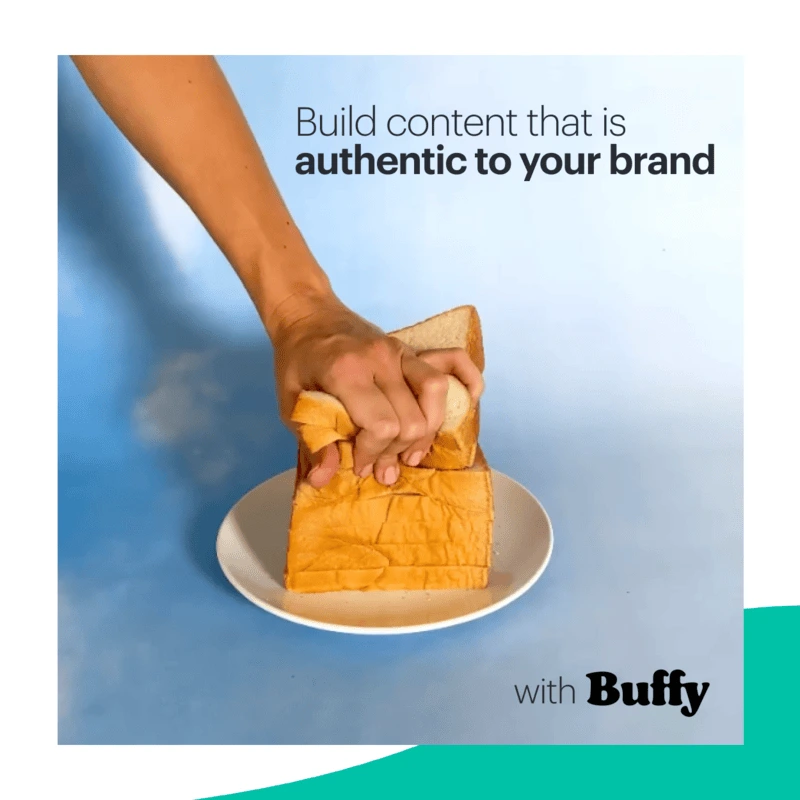
Embrace (and review) the competition
Making your story stand out from the competition in a saturated market is one of the hardest parts of brand storytelling. Chanty, a team communication and collaboration software and Slack alternative, knows this all too well.
But the brand decided to embrace the confusion (and search volume) that comes with many products, multiple solutions and no clear answer on which to choose. Chanty built out comprehensive comparisons of other apps in their niche in the “Team Chat Wars” section of its blog.
We spoke to Jane Kovalkova, Chanty’s CMO, who told us the brand’s Team Chat Wars has built up their brand as the number-one resource for app comparison in their product category.
“This way, visitors come to our website not only to find out more about what we do, but to get an objective comparison of different team chat apps and how they help meet their needs. For example, we’re currently covering an article on Skype alternatives since we know that the topic gets quite a few searches, so we’re reviewing all of Skype’s competitors now. By reviewing, I mean actually testing them and writing down our experience.”
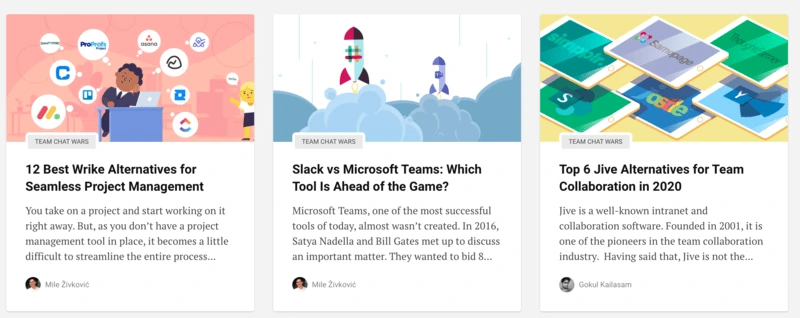
If you’re interested in doing product comparisons, Jane recommends preparing to put time and some money into it. “There are lots of ‘reviews’ out there by affiliate marketers that never even tried the products they review. Make sure to get some hands-on experience with the products you cover and do your best to give your personal impression. Of course, no opinion is objective (that’s why it’s an opinion), but people don’t want to read facts — they want actual experiences with a product, from a real live human being.”
SEO is (still) king
For businesses with fewer resources and a smaller budget, going beyond your product keywords and embracing your industry to produce educational content around search terms can build your brand in an affordable and sustainable way.
Online Degree — a company that offers free introductory college courses — has built out huge research libraries providing information on careers in multiple industries, types of college degrees and universities in every state in the U.S.
The founder and CEO of Online Degree, Grant Aldrich, told us “Brand journalism goes beyond a corporate blog. It provides the latest news updates and informational trends in your industry. It’s also a way to reinforce your mission and values to attract your target audience. In our case, we try to make higher education more accessible and affordable. Our goal is to help people find the best, most affordable educational resources with this kind of content. Not necessarily to drive people to use our services.“
Build community relationships
Natalya Bucuy, Content Marketing Writer at HelpSquad (a U.S.-based live chat service), takes an approach similar to Online Degree with her company’s B2B brand. “We believe that brand journalism that delivers useful content not only to current customers but to the small business community in general is an effective marketing strategy. Even if a piece of content doesn’t immediately bring measurable results, such as converted leads and new customers, it helps build meaningful relationships with the community. That, in turn, builds a strong brand presence that contributes to a company’s success in the long run.”
She pointed to an example of a recent post on Reddit her team created to drive discussion around behaviour psychology and the reasons behind procrastination that linked to a HelpSquad blog post that discussed the topic further. Reddit is notorious for being very picky about content quality and will sniff out any sales pitch, but this post hit mark with 99% upvotes and 73 comments.
Expert content can work in a variety of venues and help your brand increase its reach. It’s worth brainstorming where you can go outside of your own site and social media platforms to tell your brand’s story.
These inspiring strategies and brand story examples are proof that useful content with some outside-the-box thinking can lead to success. Your brand story, told consistently and creatively, could be just what your marketing plan needs. We’ve got some tips on how to get your whole organization on board for consistent storytelling: Check out our ebook The rise of the design democracy: How to maintain a consistent brand story.
When you think about Coca-Cola, what pops into your head — is it the taste? The fizziness? The dark caramel color? Maybe you think of a classic ad. If you’re like me, it’s the vivid red-and-white logo adorning the label.
Related: Is your brand outdated? When to do a brand refresh
When you think of all of these things, you’re thinking of Coca-Cola’s brand as a whole. If lots of different Coke-related images popped into your head just now, then Coca-Cola’s marketing team has done its job.
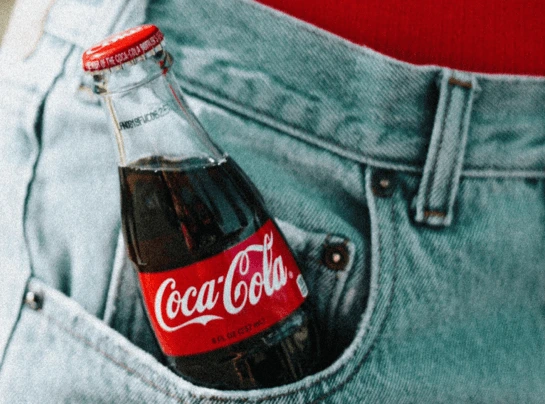
Too many people think branding begins with choosing a name and ends with picking a logo — but it’s much more than that. It affects everything.
So, when a company wants to rebrand, it’s not about just changing the logo. It’s also about changing goals, messaging, tone, voice, style and anything else that contributes to your image. It can be a tricky thing to get right, because ultimately, you can’t control what people think. But a well thought-out and defined brand is the backbone of many successful companies.
If there’s so much to it, why would anyone dream of rebranding? When is rebranding the best option?
Well, you could have gotten it wrong the first time. Many businesses overlook branding when they’re starting out and later find they need to rethink it. For some, they need to appeal to a broader audience. Others need to change tack when they decide to expand into other markets.
Long-established companies aren’t immune to the need to rebrand, either. It might be necessary after an acquisition or merger. Changing industries, attitudes and new competitors can also ignite the need for a fresh image. When a company needs to reposition or rejuvenate itself, rebranding makes sense.
Deeper issues, like an antiquated image or a negative reputation, can spur a rebrand. Sometimes, it can even come down to involvement in a damaging public scandal.
When you face challenges like these, you have two options. You can cling to the old branding that you had, or you can put together a rebranding strategy and work towards a new image.
Whatever the reason, make sure you have a strong case for the rebrand. Though there’s a lot to it, rebranding is part of the life cycle for many growing companies. Very few of us wear the same clothes now as we did in high school — so why wouldn’t a brand evolve as well?
Reasons to do a rebrand:
- You need to completely reposition your brand
- You merged with another company
- You significantly changed your product offerings
- You have a negative reputation
Reasons to do a brand refresh instead:
- You want to attract a new audience
- Your messaging is inconsistent
- Your company has evolved
- You don’t stand out from competitors
Considering the points above, it may be that you don’t need to go through an entire rebrand: Your current brand may just need some polish, also known as a brand refresh. A refresh is a much lighter version of a rebrand, and though they both entail a lot of the same work, a refresh simply updates your current brand instead of making the sweeping changes that a rebrand does.
If you’re still not sure if rebranding is right for your company, check out our rebranding questionnaire.
Rebranding strategy
Rebranding a company doesn’t happen overnight. You need a solid rebranding strategy, testing and approval, and then you need to roll it out internally before your big debut with your customers.
Here’s our advice on the five steps to follow to get rebranding strategies right.
1. Research before you rebrand
Before making any changes, you’ve got to do research to find out how your brand can improve. What do people like about your brand? How can it connect with modern consumers? There are endless questions to ask when building a new identity. The more knowledge you have, the more effective your rebranding strategy will be.
During this process, find out what attracted customers to your brand initially … or why they went to a competitor instead. Figure out the problems you need to address with the rebrand.
Coca-Cola once decided to rebrand, but its New Coke campaign flopped. Coca-Cola didn’t have any issues with its product’s taste or image, but it decided to change both. The result wasn’t an energized image but confused loyal customers. So, make sure to do your research.
Burberry’s rebranding strategy is a great example of how to strike this balance. After a century-and-a-half of success, Burberry’s image started to suffer when — through no efforts of its own — the brand became associated with gang wear and fashion for older generations. Thanks to this double punch, clubs in the U.K. wouldn’t allow entry to anyone wearing the brand’s iconic plaid.

Faced with this unsavory situation, Burberry decided to rebrand, but it did its research first. The company hired an anthropologist to rediscover its roots so that Burberry could highlight its heritage in a way that would appeal to younger audiences (while also disassociating its name from gang wear).
2. Set out clear goals
From your research, you’ll know what’s wrong, and this should help you figure out what you want to achieve. Burberry needed to disassociate its brand from gangs and build a modern youthful image.
Knowing it needed to appeal to younger audiences, the label added more modern styles to its line and recruited well-known celebrities like Emma Watson to promote them. This led to a boost in sales and an image readjustment for the brand, which once again became a luxury name.
There’s no point rebranding a business if all you change is the name. When it became The Shack, RadioShack did exactly this. The business wanted to stem the flow of losses, but a name change just didn’t cut it. Maybe if it had gotten to the root of the problem and set out more strategic goals, the brand wouldn’t continue to close its doors.
With thorough research and clear goals, your rebranding strategy will be well-informed and should make an impact.
3. Get all company stakeholders on-board
To get customers on-board with a rebrand, you’ll need to get all stakeholders involved first. Your employees are the main touchpoint between your brand and the outside world, so they need to understand the importance of your new brand. You want to make sure what they say and do is in keeping with your new image.
The CEO who led Burberry’s turnaround, Angela Ahrendts, knew there was a problem when she saw that none of the company’s managers wore the brand. How can expect your customers to love your brand when your own staff doesn’t?
If your rebranding strategy aims to address a bad rep for customer care, you’ll have to invest in training and resources to deliver better customer experiences. In situations like these, it can be a good idea to rebrand internally first.
When setting out a rebranding strategy for a client in the financial sector, consultants Spyglass Creative decided to do just this. To convince the board of management of the importance of stellar customer service, waiters with silver platters served lunch to the members and introduced the idea of “sterling service.” With a clear view of the vision for the rebrand, they supported the new approach.
4. Have a process planned out
Once you’ve got stakeholders on your side and know exactly what needs to be achieved, you can put together a plan of action. In the case of Burberry, the company was active on many fronts. It introduced new designs and bought back licenses for its classic plaid pattern, so it could protect the brand’s image and make it exclusive once again. The company also created a brand story, which it told through videos and in-store displays.
Your rebranding strategy might require you to take up social media. Or, it could impact the networks you already advertise on.
Prior to 2010, Old Spice was seen as a retro brand for older men. While its reputation was sound, it simply didn’t appeal to younger audiences. It decided to change this.
The brand set up a YouTube channel and posted dozens of fun, humorous videos featuring actor and former athlete Isaiah Mustafa.
The rebrand was a massive success, opening up the traditional product to a new demographic by making the most of new trends. Old Spice did its research, rebranded for sensible reasons and set out clear goals.
5. Build trust for your new brand
Once you’ve rebranded, don’t slip backwards. Familiarize your audience with your new brand personality by staying consistent and building trust around it.
If you have a new name or logo, don’t leave a trace of the old one around. Create new brand guidelines and make it easy for staff to implement them. A brand templating platform like Lucidpress can help by making brand assets easily accessible during the content creation process. When any files are updated, everyone will automatically have access to them, too.
Use your new brand in all your communications to build awareness of it. Use a link shortener like Rebrandly to create branded links for your emails and social media posts. This will build brand visibility and trust. Content marketing and native advertising can also build familiarity and trust in your new image. Be consistent with your new tone, and don’t flip-flop between your old brand and the new one.
Branding is an important company asset, and it can leave a lasting image in consumers’ minds. Make sure your rebranding strategy sticks, because it can rejuvenate a business and even turn it around when the chips are down.
How to rebrand a company
Follow these steps and plan how to successfully rebrand your business.
1. Define your audience
If your audience is 70-year-old retirees, you probably don’t want to alienate them with something that feels so modern it’s out of their reach. The same goes for a millennial audience. If you’re rebranding, it might be because you’re redefining your niche and ideal customer. Make sure your branding speaks as much to that ideal audience as your sales copy does.
2. Stay true to your mission
A rebrand should be a makeover, not a botched surgery. Before you begin, go over your mission and value statements. Come up with an idea of where you are now and where you want to go — without losing sight of who you are and what your customers have come to love. Project your mission and personality in your new branding so you feel like a refreshed company, not an unrecognizable one. If you’re having trouble finding your brand’s voice, try this tool.
3. Rethink your name
Name is the first and most recognizable brand element. Rebranding doesn’t always involve a name change, but it can be a powerful strategy — especially if the company is looking for a fresh start. Did you know that the infamous Philip Morris company changed its name to Altria to disassociate itself from bad press and controversy? Considering how a number of journalists reported on the obvious change, it’s hard to say whether it was successful, but only time will tell.
One more thing to consider is the possibility of alienating or losing older clients with a name change. A fresh start is a double-edged sword, so make sure you’re ready to give up your established legacy in favor of a new brand identity.
4. Revamp your tagline
Slogans and taglines often go hand-in-hand with a brand’s name. Usually, a tagline is a catchy sentence that summarizes your business and is easy to remember. If you decide to change your name, you should do the same with your tagline — especially if the business has changed. Over the years, FedEx has had several long and unmemorable taglines, so it changed to “Relax, It’s FedEx” in 2004 and “The World on Time” in 2009, both of which are simple and effective.
Rebuild your brand identity
Your brand identity is how you present your company to the world. It’s everything that customers recognize your brand for, from visual style to voice and personality. Be sure to include these key elements of brand identity in your rebranding strategy.
Logo
Since people are visual thinkers, updating your logo is the easiest way to demonstrate change to your audience. As for the logo design, you have to follow (and subvert) trends if you want to appear fresh. But, be careful with it. You don’t want to drift too far away from the original logo unless you’re trying to conceal your past. You want people to acknowledge the change but also recognize the company’s continuity.
Color palette
Color psychology is real — and different colors make people feel different things, so consider how you want your brand to make people feel. Blue is a calming color, pink is soft and romantic, black is bold and sophisticated, etc.
It’s best to go for a simple color palette with no more than 3 primary colors. You can also choose secondary colors to create your brand palette. You’ll be experimenting with tint, shade and saturation to get the look and feel of your brand just right.
Typography
Typography is truly an art, and choosing the right fonts for your brand can help you stand out and be easily recognizable. Just like colors, font styles can make people feel a certain way. You want to find a pair of complementary fonts that reflect your brand’s personality, whether that’s modern and youthful, bold and innovative, or however else you’d describe your brand. You’ll need to consider things like font size, kerning and line height, readability and licensing requirements.
Shapes and imagery
Along with colors and fonts, your other visual assets communicate who you are to your customers. Again, think about what visuals will communicate your brand’s identity, personality and feeling. Is your brand angular, rounded, flat, soft, natural, futuristic? Are you using animations, photographs, GIFs, videos? All design elements come into play here and there’s a lot to explore.
Brand guidelines
Once you have your new brand identity outlined, the best thing you can do for your rebranding efforts is create a clear and easy-to-access set of brand guidelines. This will ensure that your team can reference the new guidelines and keep your rebrand looking consistent. Without full compliance from your internal teams, it can be hard to have a successful rebrand.
Tips and tricks for a successful rebrand launch
1. Know your limit — err, budget
Creating content, running tests and paying for ads all costs money. Around 10-20% of your annual marketing budget can be spent just on rebranding efforts. Developing a well-designed content calendar will help identify where most of your money will be spent and give you an idea of when you’ll need to be prepared for these expenses.
2. Testing: 1, 2, 3
Taking the time to run tests on your content will help to solidify your marketing strategy. It’s not always a guarantee that a rebranding effort is going to be successful. The best way to prevent a failed rebranding is to test your assets before releasing them to the public. Study groups and A/B testing can uncover and strengthen any weak points in your rebranding strategy.
3. Demand consistency
Branding should be synonymous with “consistent messaging.” When you rebrand, you need to go back through every webpage, design element and evergreen brochure to update it with your fresh look, tone and feel. Don’t dilute your new branding by confusing it with the old. Get everything polished in one fell swoop. Brand consistency was important before the rebrand, and it’s even more important now. Consistency establishes company-client trust, which leads to higher revenues.
A platform like Lucidpress can be a huge help in your rebranding and consistency efforts. It gives a central place to put all your brand assets and files, providing easy access for anyone who needs them. You can put all your new colors and logos in the brand assets hub, so when people are creating content, there’s no chance of them using an old logo or font, etc.
You can create a template library with all of your rebranded and updated materials, so spanking-new content is right at everyone’s fingertips. Plus, when you decide to refresh your brand again down the road, all the content will be in one easy-to-update location. A centralized platform for branded content creation will make it easier to roll out your rebrand to internal teams, so can ensure that everyone’s up to speed before your public debut.
Is it time to rebrand your business or organization? Learn more in our free ebook: How and why to rebrand your company
The best storytellers know that a good story is more than telling romanticized tales about a life lived. Good storytelling knits together polarity — people, spaces, emotions, conflict and impact — and transforms it into something visible and tangible. While there is a time and a space for waxing poetic, truly compelling storytelling is defined by authenticity and the sum of many parts.
Furthermore, let’s be honest: Try as we might, we can’t all be like Walt Disney. Sometimes we simply can’t feign magic when it’s not there, or perhaps the nature of our work prevents it. Alternatively, we have to practice active listening and cobble together stories from there — because your audience is people too.
To help dispel the myth that we can or must all be like Walt Disney (someday when we grow up), we reached out to the best storytellers we know and asked them to tell us their secret storytelling recipe. Naturally, they delivered.
So without further ado, we’re bringing the TLDR, best-of-the-best storytelling tips to you, so hopefully, you can take something from them and apply it to your stories.
Storytellers featured in this article
- Hanna Reichel — Outdoor industry Brand Strategist, Vermont based
- Jon Carter — Campaign Director for Utah Rivers Council
- Leidy Wagener — Corporate and Foundation Relations Manager at Montana Food Bank Network
- Matt Halpin — Copywriter at Black Rifle Coffee Company
- Natalie Ipson — Media Relations Manager with BYU
How to create compelling stories
Some stories come to life quicker or easier than others. However, regardless of the speed with which you create stories, our blog post participants recommended the following initial tips to nurture an evocative storytelling experience:
Nurture a human connection
“We look for the human element in every piece. Every person has different experiences, but we can connect so quickly through shared emotions. Heartache, love, failure and triumph all feel the same regardless of the circumstances that cause those feelings.”
Natalie Ipson
Remember to center the storyteller’s voice, not your own
“I think that good storytelling from a nonprofit, or even journalistic, standpoint has to be unselfish. When crafting a client story, you are merely a conduit to someone’s story, giving them a voice and platform to be heard. When presenting an organization’s story, you are offering someone an opportunity to support something they are passionate about and believe in. While it certainly doesn’t hurt if you are also passionate about and believe in that work, YOU as an individual aren’t a part of that relationship except as a conveyor of information.”
Leidy Wagener
Leverage technicalities and data when it works
“Everything I write comes back to two questions: How can I most effectively resonate with our customers, and how can I best embody our company mission? We can track the former through analytics. We use all the fancy metrics like click-through rate, ROAS for paid media and so forth. On a technical level, I know what keywords tend to convert better than others when describing our coffee, or which value propositions to use when targeting a higher funnel audience. And I know which CTAs will lead to the most sales. It’s mad science.”
Matt Halpin
Validate passion through messaging
“Especially on the product side, we normally come to stories with a lot of passion, and I do believe that this is an important component of the story: We care. It’s our legacy. Our innovations show that. But passion needs to be validated through straightforward messaging (there’s room for clever, too); it’s easy to forget that not everyone lives and breathes this stuff. I’ve found that one of the most effective ways to demonstrate this is by articulating Problem — Solved.”
Hanna Reichel
The storytelling production process
Jumpstarting the storytelling process can be trying, but our storytellers brought to life their go-to approaches to the storytelling production process without fail. We’ve inverted these suggestions to be reflected as questions for you, the reader, to leverage as an internal checklist as you create stories yourself.
Do I know my audience?
“Every piece of content I create starts with first understanding who my audience is and what that audience needs and wants from me. It’s Communication 101 (so basic!), but so many of us often skip right past that step.”
Natalie Ipson
Do I understand my audience’s triggers or stressors? What can I share that relieves that stress?
People consume content because they want to obtain something. This “something” can be educational, informative, or offer reinforcement for what they already know. Understanding the so-called turning point that pushed your audience into the content consumption phase of their experience is critical. In other words, good storytellers comprehend people’s stressors or triggers, and these folks know how to share information that offers relief or a solution.
What does my audience care about, and am I connected with that passion?
Intersectionality is a critical concept when exploring what your audience cares about and is passionate about. Because for every general group of people, there will be smaller subsets of audiences who experience impact differently. By knowing what your audience cares about (or is impacted by), you can create stories that reflect that passion. Be wary of falling victim to disingenuous gestures or stories — i.e., avoid performative activism, allyship, or storytelling to get content out there.
What is the medium or format I’ll be telling the story from?
“The format in which a story’s told is critical to how you structure your story. A 30-minute speech means you might have a 5-minute intro, 15 minutes for the core content, 5 minutes for a conclusion, and 5 minutes for Q&A. Suppose you are writing a letter to the editor for a newspaper. In that case, you may only have 300 words to tell a story, meaning you are likely limited to focus on just one theme, for a general audience, who you are trying to sway with emotion rather than facts. Facts require lengthy data points. Emotive content requires relatable and experiential content.”
Jon Carter
Do I have a conscious audience, and does my audience care about the story? Why or why not?
“I got the chance to participate in a brand overhaul — we realized that on top of needing a new look and feel, we had to build a conscious audience. We didn’t lack a following, but it wasn’t cohesive or aligned along a particular plotline. This [the overhaul] was cathartic: it was almost as if the audience motivated us to build the product — and the story resonated with our heritage and our audience’s ethos. They inspired us as much as we inspired them. I think being open to what the audience has to teach you is a critical part of storytelling.”
Hanna Reichel
Have I answered key questions? Do I need to explain the basics?
Avoid making assumptions about what your audience knows or doesn’t know. Complicated issues, or uncomplicated ones, can take time to understand, and everyone processes information differently. Guide people through the story with kindness, compassion and attention to detail. Unpack whether or not you need to approach the subject or story from different perspectives or angles. Knowing your audience will help with this part of the storytelling process.
Have I created a “before” and “after” for the story?
“What distinguishes good brands is their ability to deliver common-sense solutions to common problems. So with my product development and marketing teams, I always ask them to do the “Before” and “After” to distill what the design impetus was and what they were able to resolve through innovation. Often this looks like a bulleted list, and honestly, that’s the scaffolding for a good story. The narrative comes alive with human touchpoints: testimonials, personal anecdotes, etc.”
Hanna Reichel
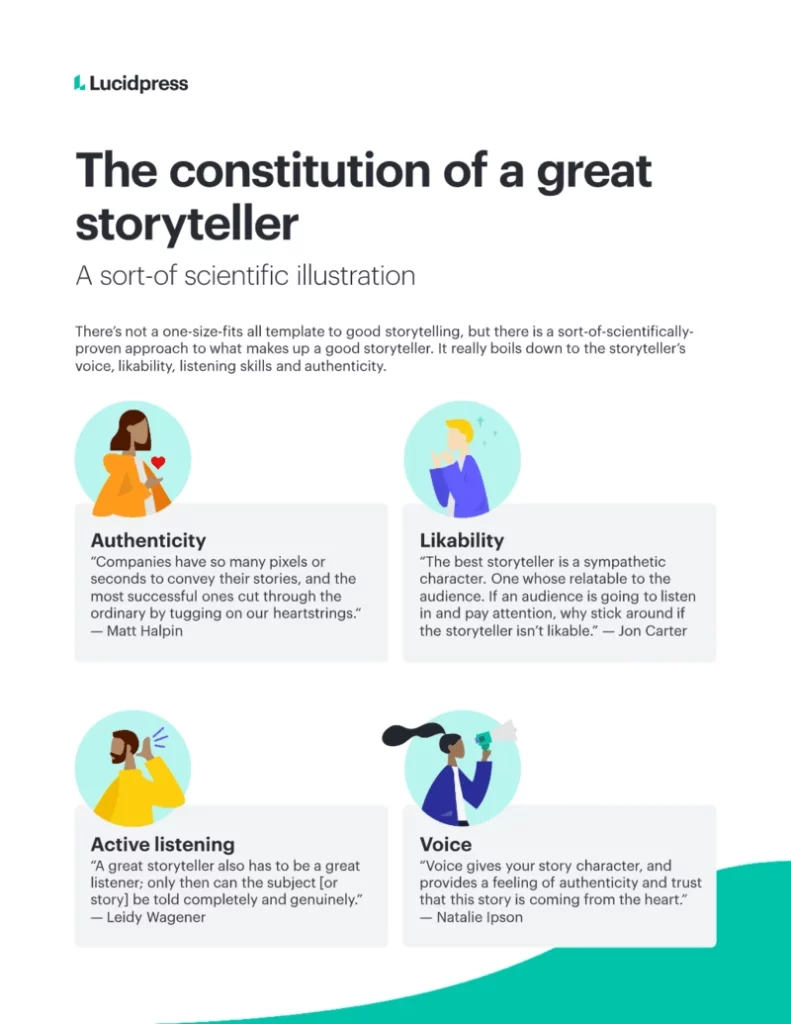
What makes the best stories?
The best stories are immersive ones — the ones people read until the very last sentence. But what exactly goes into making good and great stories? According to our proverbial “Storytellers Board,” it lay in your ability to:
Illustrate relatability and human emotion
“The anecdote of Ernest Hemmingway winning a bet by writing a compelling story in six words is a perfect example of this: “For Sale: Baby shoes, never worn.” Though the attribution to Hemmingway has never been substantiated, the point remains the same: you leave a lasting impression on your audience by connecting with their emotions as quickly as you can (e.g., the initial eight minutes of Pixar’s Up).”
Natalie Ipson
Use conflict as your aid
“The best story has conflict. It gets your attention, it’s entertaining and simply put, it’s like life. Life is full of setbacks and challenges and obstacles. Conflict.”
Jon Carter
Show what’s at stake
“The higher the stakes, the higher the suspense. Great conflict without great stakes, the audience is wondering why they should care.”
Jon Carter
Illuminate all aspects of the story
“A story is great when it is whole, which is a little hard to explain, I suppose. When I think of a great storyteller or story, I think of Chimamanda Ngozi Adichie’s TED talk “The Danger of the Single Story” and how she explains all that we are missing out on when only one aspect of a story or person is told. She is a great storyteller herself, but I think a great storyteller doesn’t fall into the trap of the Single Story and works a subject until it’s illuminated in entirety — even if all of the components aren’t necessarily part of the final result.”
Leidy Wagner
Connect with the audience’s values
“Not all stories we tell in the brand space are emotive at first glance, but we know that purchases — and brand loyalty — are ultimately emotional decisions, so it’s important to connect with the audience’s values. Speak their language, but also stay fluent in yours.”
Hanna Reichel
Related: Brand storytelling examples
What makes the best storytellers?
Every storyteller has their unique approach to pulling threads in a story and experience. However, what it boils down to is your capability to demonstrate voice, likability, active listening and authenticity.
Voice
“Voice gives your story character, and provides a feeling of authenticity and trust that this story is coming from the heart.”
Natalie Ipson
Likability
“The best storyteller is a sympathetic character. One whose relatable to the audience. If an audience is going to listen in and pay attention, why stick around if the storyteller isn’t likable. Why are your friends your friends? Same concept here. If the storyteller can also provide character change through experience, that goes even further in keeping your audience entertained and ready to act.”
Jon Carter
Active listening
“A great storyteller also has to be a great listener; only then can the subject [or story] be told completely and genuinely.”
Leidy Wagener
Authenticity
“Companies have so many pixels or seconds to convey their stories, and the most successful ones cut through the ordinary by tugging on our heartstrings. That could come through humor, a connection over a shared value or experience, or anything else that resonates with us [as humans] more than consumers.”
Matt Halpin
The best storytellers are all around you
The reality is we all have the capability of being storytellers.
However, the best storytellers are the folks who see the heart of a story, do the research and imbue words with rapt attention, tenor and authenticity. Good storytelling, and thus good stories, requires patience and the use of active listening. Keep in mind not all stories resonate with everyone, but (in part) that is the key to creating and nurturing a story — imparting education, conflict, development and relief.
Magic, try as we might, is not always given, but it is earned.